

Kenya Packing List: What to Wear and What Not to Bring
This post may contain affiliate links which means we may get a commission if you make a purchase at no additional cost to you. As an Amazon Associate we earn from qualifying purchases. Please read our disclosure for details.
"Each product we feature has been independently selected and reviewed by our editorial team. If you make a purchase using the links included, we may earn a commission."
Are you heading to the upcountry? Masaai Mara? Nairobi? The coast? The different parts of the country can wildly vary in a climate, so it’s important to note the exact place you’ll be staying before you start packing. Our Kenya packing list will give you everything you need to know for a trip to Kenya.
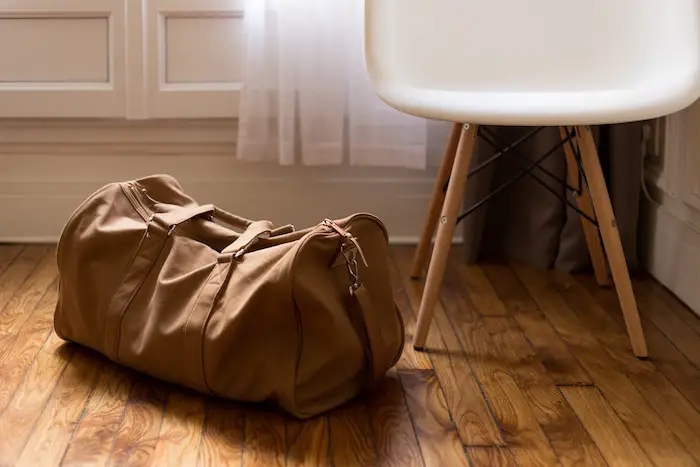
Kenya is an incredible country with breath-taking scenery, sunny beaches, and lush mountains. Being one of the best safari destinations in Africa is an added reason to visit Kenya.
The country is considerably diverse, so your Kenya packing list will depend on which part of the country you intend to visit and the type of activities you will take part in.
Before we dive into what to pack for your Kenya trip, let us talk briefly about the weather.
Weather in Kenya
One of the most critical factors you will want to consider when crafting the perfect Kenya packing list is the weather and the season at the time of your visit.
Kenya typically has a dry and rainy season. The dry season runs from mid-December to March, and the rainy season usually starts from late April through to July and early August.
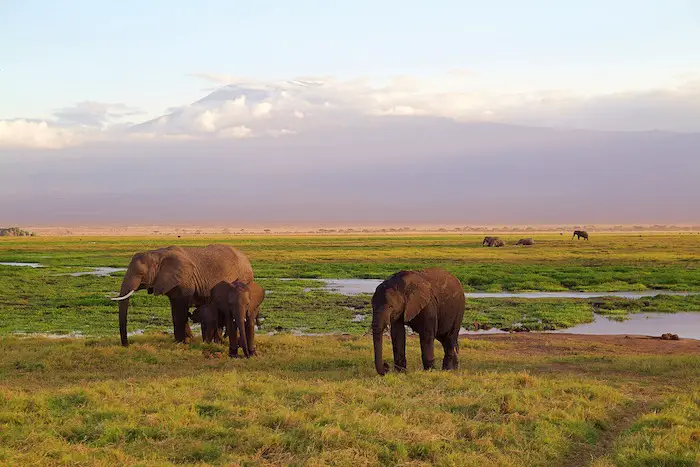
The country also experiences short rains from time to time. However, since the equator runs through the country, the climate is temperate, so even on the rainy season, it never gets too cold.
Assuming you’ll take part in different top excursions and adventures if you visit Kenya, here is a list of recommended items plus tons of good ideas.
21 Top Kenya Packing List Items
The coastal part of the country offers fantastic pearly beaches, so make sure you pack smart-casual in case an opportunity for a romantic dinner date arises.
For safari trips, you’ll need to wear loose and comfortable clothing.
Remember, avoid wearing brightly-colored clothes on a safari – one reason being you need to camouflage with the surroundings as much as possible lest you miss a chance to spot lions.
The second reason is a safari in Africa can be pretty dusty since the roads in Animal National Parks are not tarmacked.
For beach and other activities; however, your preference should guide you best.
Shirt or Blouse
If you’re headed to the Kenyan coast lightweight button-up shirt/blouse are great whether you’re strolling along the white sandy beaches or you’re out for nightlife.
Great Rift Valley and the western part of the country can get a little bit cold at night so be sure to pack a few warm clothes and cozy nightwear .
A pair or two of comfortable pants would be great for early morning excursions like morning or dusk safari walk.
Even in the dry season, the bushes will be full of morning dew enough to make your legs wet, so shorts may not be the best option.
Cargo pants , for instance, are a great alternative as they’re comfortable and can be used for adventurous activities like hiking or rock-climbing.
Hiking Shoes
Pack footwear best suited for the purpose of your trip. If you plan to have an adventure in the mountains, be sure to get a good pair of grip boots.
A smart traveler travels light, so it’s vital to pack multi-purpose clothing and footwear is no exception. Make sure your hiking boots can serve you well if you decide to go on walking safaris.
Ideally, they should be lightweight with at least ankle support, which will perfect for the bush since the terrain can be uneven and rocky. They should also be comfortable to avoid blisters.
Make sure you wear the boots a couple of times before you travel to break them in. You can get some from here .
Casual Shoes
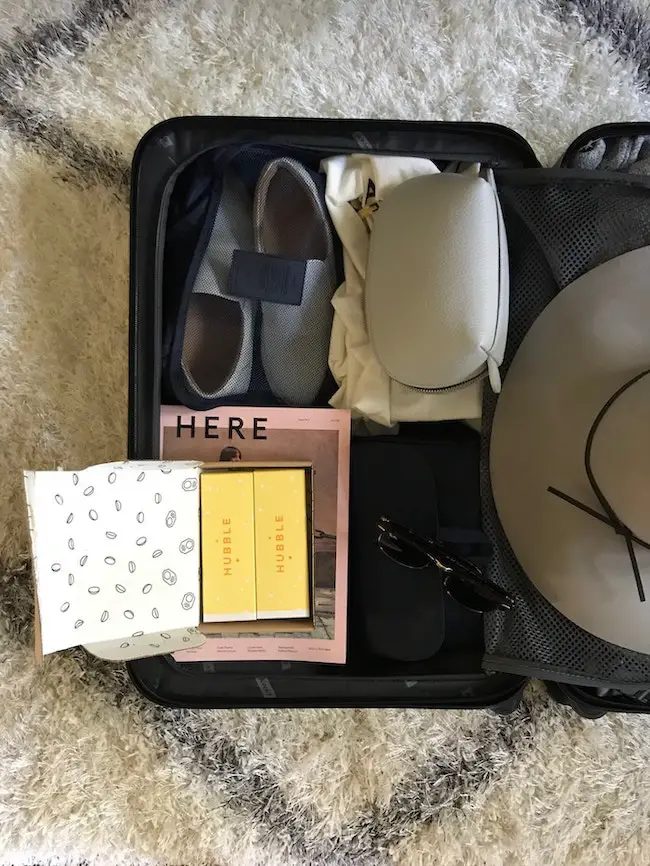
Pack a casual pair of shoes for city strolls or night dates. Sturdy sandals are fantastic, especially if you’re going to explore the charming streets of the coastal part of Kenya.
Most high-end accommodations usually provide their guests with room slippers, but it’s always a good idea to carry flip flops just in case.
Rain Jacket
A rain jacket will be necessary if you’re visiting towards the end of the rainy season. One minute could be all bright and shiny, but the next could be gloomy and raining. You can get one from here .
Kenya is blessed with a lot of sunshine, but too much of anything will definitely make you uncomfortable.
Whether you’ll be going on a safari, a hiking tour, or lying lazily on the beach, a hat is a must-pack item when visiting Kenya. You can get one here .
If you wear contact lenses and you intend to go on a safari, you may want to wear some sunglasses to prevent your eyes from drying out in the heat.
But if you do not wear contact lenses, you should plan on having sunglasses, so you do not have to squint on those sunny days.
Tech and Gear
This is an obvious item for any avid traveler, but there is a need to remind you that Kenya is full of picturesque locations. Make sure you invest in a good camera to capture those unforgettable memories.
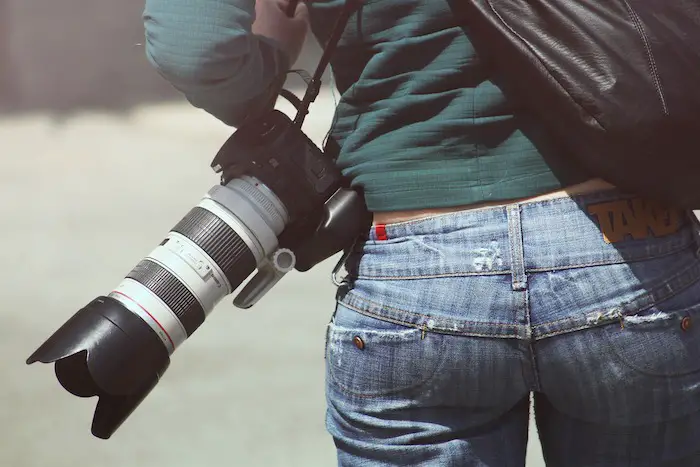
Plug Adapter
If you’re traveling from anywhere else apart from the UK, make sure you pack a plug adapter. A universal plug adaptor would be great, especially if you have any layovers in destinations that use a different type of plug.
Also, invest in proper power converters as Kenyan electric switches supply between 220 and 240 volts.
Portable Charger
This is one of the most essential gadgets as you’ll need to recharge your camera or phone if they run low on battery. Seriously, you can’t afford to miss a moment in Kenya. You can buy one here.
Binoculars
Binoculars are especially crucial for hiking and safaris, where you’ll have the Big Five to spot plus lots of birdwatching opportunities. If you’ll take part in nocturnal game drives, be sure to park night vision equipment .
Power isn’t exactly reliable in Kenya or the capital. Although many high-end hotels have a back-up in case of a blackout, you may want to have a small flashlight just in case. It also helps a lot if you’re camping.
Wet Wipes and Hand Sanitizer
Trust me, wet wipes and sanitizers are not among the most common items in Africa. Kenya is not any different, especially if you are traveling to rural areas.
These items are widely available in Nairobi and other major cities, but you may not have the extra time to run to the store.
Plan to pack a few hand sanitizer bottles/ wet pipes or both. Some parts of the country are short of running water and hand wash so you’ll need a lot of hand wipes so you can stay healthy.
Bug and Insect Repellent
The coast and the western part of the country are famous for having bugs and malaria-causing mosquitos.
Be sure to pack an ample amount of bug and mosquito repellent spray . If you are going on a safari, beware of the tsetse flies, blood-sucking insects that transmit sleeping sickness in humans. A good bug repellent should keep them away.
This is yet another safari essential and, obviously, a must-pack for a beach getaway in Kenya. You can get one here .
Documents and Details
Have your passport plus your stamped visa ready for inspection at the customs offices. You might also need to provide your itinerary as well as travel insurance papers.
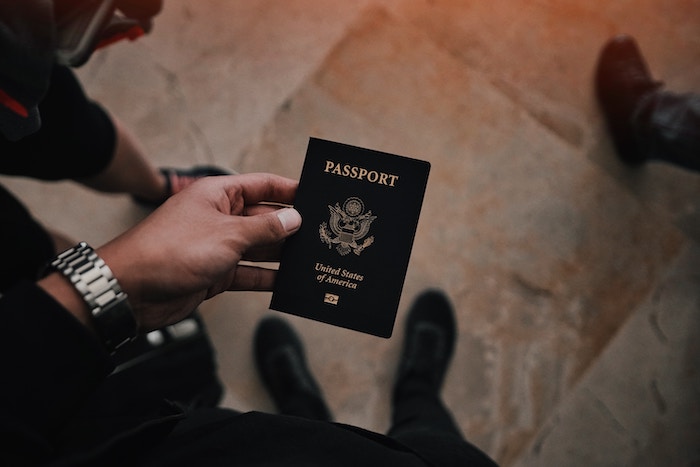
You should also have a list of contacts that can be used in case of an emergency.
Travel Insurance
It is essential to get travel insurance no matter where you are traveling to.
It’s mainly a requirement that is helpful when traveling to Kenya and East Africa in general, where treatment in an excellent health facility can be costly.
Passport Holder
You’ll need a passport holder that can withstand both dusty and wet environments.
A Swahili Phrasebook
This is not a necessity. Swahili is a fun language to learn, and locals appreciate any tourist that attempts to communicate in their native language. Even a simple ‘Hi’ or a ‘Thank you’ will earn you brownie points.
Medications and Vaccination
Before you travel, be sure to pay your doctor a visit so that they can advise on the recommended vaccines.
Most African countries require proof of Yellow Fever vaccination prior to entry. Check the CDC website to confirm if up to date information on whether or not you will need a yellow fever vaccination.
Anti-malaria drugs are essentials, especially if you’re traveling to the western or coastal parts of the country.
You will find all over-the-counter medications in the larger cities, especially in the capital but not in rural areas or in the game reserves. For this reason, it’s advisable to shop in major cities for prescribed or other drugs you might need.
First-Aid Kit
A first-aid kit is essential, particularly if you are planning to take part in adventurous excursions.
What Do People Wear in Kenya?
Women in kenya .
Kenya is one of the most modernized countries in Africa, according to the World Population Re view. So as long as you dress appropriately, you should not encounter any problems. Wearing clothes that are at least knee-length is the standard dress code.
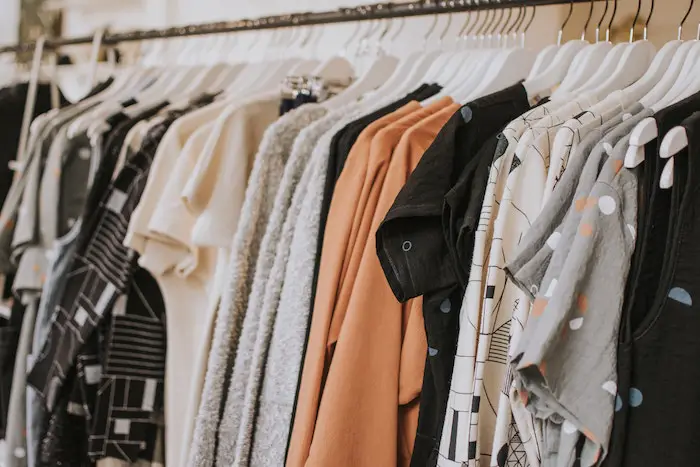
You might be barred from entering spiritual places like temples, mosques, and churches if you are dressed inappropriately.
Ideally, if you will be visiting any religious institution, maxi dresses will be perfect. When you’re visiting malls or other public places, knee-length skirts or shorts will do.
Men in Kenya
There is no particular dress cord, although if you visit rural areas like the Maasai villages, you might see some men dressed in traditional sheets.
Feel free to dress in traditional sheets if you like, but it is not a requirement. When you’re visiting religious institutions, wear trousers and long-sleeved shirts.
Other Commonly-forgotten Items for a Trip to Kenya
Jeans Sandals Heels Headphones Aloe Vera Mosquito repellant Backpack Travel sheet Travel pillow Kindle/Kindle cover Memory card Headphones Headphone splitter GorillaPod Lightweight scarf
Vitamins/Supplements Dramamine Lip balm Contact lens solution Hairbrush/Comb Loofah glove Underpants/Bras Feminine products Toiletry bag Headlamp Umbrella Journal Small lock Swimsuit
Swimsuit cover-up Hats/Caps Jacket: Women’s & Men’s Luggage/Packing cubes Steamer Razor Immunization Records Drivers License/Photo ID Credit Card and Cash Money Belt Neck Pillow Eye Mask Water Bottle Towels
Packing List for Kenya: What Not to Bring
It’s important to note that plastic bags are not allowed in Kenya. This includes:
- Ziploc bags
- Grocery bags
- Garbage bags
- Duty-free bags
When traveling in Kenya, it’s advisable to use woven reusable bags instead.
Concluding the Kenya Packing List
The above list contains all the essential items that you’ll need on your Kenyan visit. Most of the items listed are lightweight to help you travel as light as possible.
This post helps you pack everything you need to be comfortable when you are away. But at the same time, not pack too much where it becomes a burden; this Kenya packing list provides precisely that.
You should use this packing list as a checklist to make sure you don’t leave anything behind on your getaway to Kenya.
If you plan on visiting multiple African countries on your trip, our travel guide , destinations , African national park pages will provide some inspiration. Happy Traveling!
21 Kenya Packing List Items
Tech and Gear
Shirt or Blouse Hiking Shoes Casual Shoes Rain Jacket Hat Sunglasses
Camera Plug Adapter Portable Charger Binoculars Flashlight
Wet Wipes Hand Sanitizer Insect Repellent Sunscreen Medications
Passport Travel Insurance Passport Holder Phrasebook Vaccination First-Aid Kit
Love it? Share and Pin it!

You may also enjoy:
Ultimate mozambique packing list: your mozambique travel ….
I may contradict with you on power…. Power in Kenya is reliable.. Though the article is great.. ?????❤️
Thanks, Cyprian! We appreciate you sharing your honest feedback.
xo ~ Louisa
Great Article, One day i will like to visit Kenya and have some good time in the country, I hope the have good Livescore sporting activities.
Follow Us Around the World
Our next destination.
Fez, Morocco

What to Wear on Safari in Kenya | An Essentials Packing List
You’ve watched Lion King as a kid and your favorite party trick is impersonating Sir David Attenborough because you watch a lot of National Geographic. But, are you ready for a Kenyan safari?
Kenya is more than just a safari game drive. This country offers a vast array of experiences, from wildlife-filled savannas to dancing alongside the people of the Masai tribe. So, it’s understandable that you may be a little stressed about what to pack for this trip.
In this guide, we’ve put together a safari packing list that will help you be prepared and feel comfortable. We’ll make packing for safari less of a logistical nightmare and more like a sunset ending from your wildest dreams.
What to Wear on Safari
As a general rule of thumb, it is imperative to bring comfortable and casual clothing that you can wash and wear while on safari. Good safari clothes should protect you from the sun, the dusty fields, and the bitter cold of the mornings and evenings.
Your Kenya safari clothing must have muted colors, as this is best for game viewing. If you plan to stay inside of your camp or resort, focus on the light-colored fabrics so as not to attract mosquitoes.
Your Kenya Packing List

Pack light
Once you land in Kenya, getting into the wilderness generally requires transit via a jet plane. The weight restrictions are to be taken seriously. On safari, your limit is a 15kg bag (33 lbs), and that includes both your checked bag and your hand luggage. The ideal checked bag is a soft-sided duffel that can fit into the luggage hold of the plane and can be transported in open safari vehicles on the ground.
Long-sleeved Shirts
Long-sleeved shirts are the best items to wear on safari. They should be light and airy so that they can protect you from the sun but are also easy to layer when the sun begins to set.
T-shirts are great on safari to protect your shoulders from the rays of the sun. A great t-shirt option to consider is a button-down that is made from breathable material. Try microfiber or linen.

Convertible Trousers
In the early mornings out in the wilderness, it can be quite cold. However, as the sun rises it will start to heat up. That’s why convertible trousers are best. These keep you warm in the mornings and allow you the flexibility to ‘change’ speedily while you are out exploring.
Jackets and Sweaters
It might shock a few people but it does get cold in Kenya , in the evenings and early mornings at least. If you were stumped on what to pack for safari, a light jacket and sweaters are essentials you shouldn’t leave at home.
Sunglasses
Protect your eyes with a pair of UV protected polarized sunglasses. A good idea is to take two pairs, in case one of them breaks. Polarized sunglasses reduce bright reflection and unwanted glare from looking at a lake, for instance, where the sunshine tends to bounce off. Polarized lenses also help improve vision clarity in bright situations.
Wide-brim Hat
Even though you spend most of the safari in the vehicle, the sun is powerful enough to shoot through the roof and shine directly on you. A wide-brim hat is perfect to protect you from the sun and to cover your neck in order to prevent sun damage to your skin. It’s also a necessity for any walking safaris you partake in.

Sunscreen
This should already be in your arsenal at home but it is definitely a safari essential – especially on the savanna . It is also important to note that the roofs of the safari jeeps are open, there is no shade to protect you from the sun, so be protected.
We recommend that you purchase a sunscreen that has a high enough SPF that can target both face and body. But, be sure it is only 100ml, if not checked in.
Comfortable Walking Shoes
Trainers or hiking boots are the perfect safari shoes for Kenya. But if you want to let your feet breathe on a hot African day, you can also bring sport sandals along. The best are the ones with a supportive sole. These can be useful for bushwalks.
Mosquito Repellent
Kenya is a Malaria zone, so it is very important to prevent mosquito bites. Mosquito biting is dependent on where you stay, the time of year and the weather. But of course, it is better to be safe than sorry. A good idea is to bring along an insect treatment for gear and clothing as well. You can spray it on your shoes or around the ankles, hands or neck to protect them from bites.

Binoculars and Camera Equipment
It would be remiss not to add a camera or binoculars on your safari gear list. We all want to have beautiful photos that will keep our memories alive. A packing list for African safari would be incomplete without them. In the safari vehicle , there isn’t a lot of space to get the perfect angles, especially if you are sharing with other people.
Cameras with zoom lenses are a necessity because even though you get pretty close to the animals, there are still several meters between you and them. Binoculars are equally important for spotting events like the Great Migration or when you’re in a hot air balloon and you’re dying to get a little closer to the action.
Final Thoughts on What to Wear in Kenya
A safari is definitely a grand adventure. But dressing for this adventure requires a good bit of thought and practicality. Hopefully, when you go on your wildlife safari, you’ll not only look good but feel great and protected from the elements. Follow these rules and you’ll be a certified Dora the Explorer .

Best Time for Safari in Kenya | Top Months, Seasons & Weather

Amboseli National Park Kenya | A Total Guide
Tags: Safari

Top Animals in Amboseli National Park | Mammals, Birds & More

Top Animals in Masai Mara National Reserve | Mammals & More

Kenya Vacation | What to Know Before Booking a Safari
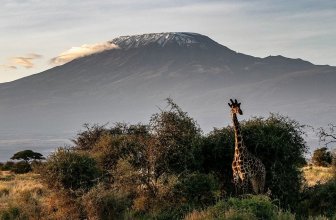
Leave a reply Cancel reply
Save my name, email, and website in this browser for the next time I comment.

Compare items
- Total ( 0 )
Shopping cart

- Client Reviews
- Safari Blog
- Send an Inquiry
- Map of Africa
- Contact Details
- African Safari Cost
- Travel Insurance
- You are here
- The Budget Safari Blog
- What to Wear on a Safari…

What to Wear on a Safari in Kenya? (best African safari clothing)
Posted by Stephanie Parker on January 11 2023 in Travel Tips & Planning Enquire Now!
Planning a trip of a lifetime to East Africa and wondering what to wear on safari in Kenya? We’ve got you covered!
African safaris are truly life-changing experiences - you will create memories you’ll treasure forever - and brilliantly, East Africa has some of the continent’s most legendary wildlife-spotting destinations, so you won’t regret booking a Kenya safari for a minute!
In order to get the most from your safari in Kenya, however, you’ll want to make sure you come prepared with the right gear, and if there’s one thing our African travel experts know about, it is safari gear!
So look no further for your complete guide on how to dress perfectly for your Kenya safari with this helpful article…
Practical comfy clothing for African safaris
For starters, you want to make sure you’re comfortable during your safari in Kenya.

As a result, choosing thin, loose clothing is a must.
Cotton can often be the best choice, as it’s a breathable natural fabric that helps you stay cool.
Garments with pockets are also a good idea when it comes to what to wear on your Kenya safari.
You’ll probably have a lot of things that you’ll want in easy reach during your trips in the park, including your camera at the ready, along with spare lenses and lens cleaning equipment; not to mention your hand sanitiser, sunglasses, and hat!
Having pockets makes keeping things close at hand a lot easier!
Neutral colours in the bush
There’s a reason you so often see people wearing khaki on safari - it blends in with the surrounding habitat! You don’t want to be spotted by the wildlife before you spot them, so the rule to dressing for a safari in Kenya is to try to stay camouflaged!
With this in mind, you’ll want to choose clothes in neutral earthy tones that match the surroundings - beige, brown and grey are perfect choices.

You can get pretty dusty and dirty on game drives and walking safaris too, so it’s sensible to avoid white and cream.
And a top insider tip from our African travel experts is to avoid wearing blue and black as well, as these colours can attract tsetse flies.
Warm safari clothing
You may not realize, but it actually can get very chilly on safari in Kenya!
Despite the glaring heat of the midday sun in this country, many game drives take place at dawn or dusk, when it can be pretty fresh to say the least!
With this in mind, you’ll definitely want to bring a warm sweater or fleece, as well as a thin windproof jacket and a warm hat with you.

A top tip from our African travel experts is to also pack a buff (a round scarf, also sometimes known as a snood). These are handy and versatile as they can be pulled right up over your neck and chin and up to your nose on chilly mornings!
Long sleeves and trousers
There are lots of reasons it makes sense to cover up while on safari in Kenya and not least to help keep you warm.
In addition, you’ll want to stay protected from the strong sun, as well as limit your exposure to any mosquitos, insects, and thorny brambles.
Coming prepared with long-sleeved tops and trousers is, therefore, a great way to do this.

Mosquitos are prevalent in Kenya and malaria is present in some areas of the country, so you will want to protect yourself.
Mozzies can be a particular problem at dawn and dusk - when game drives often happen - so wear long trousers and sleeves to prevent them from biting.
Another top tip is to tuck your trousers into your socks so the cheeky insects can’t bite your ankles!
And no packing list for a safari in Kenya would be complete without insect repellant. Ones that contain at least 40% DEET are recommended when travelling in areas where malaria is found.
Closed-toe footwear
Covering up from mosquitos and insects is one reason closed-toe shoes are also strongly advised when it comes to what to wear on safari in Kenya.
It’s also more practical and safe, protecting your feet from thorny plants, and when walking in rough or rocky terrain.
For this reason, do not bring your sandals on a Kenya safari!
Trainers are fine if it’s the dry season and it’s not too cold.
If you are going in Kenya’s wet season, however, which runs from March to May, you’ll need boots as it can get muddy in some places, as well as a good waterproof jacket.
Boots may also be a better choice for chilly morning game drives.
Protection from the sun
The equator runs right through Kenya, so the sun in this country is strong!
Make sure you take proper precautions, therefore, including packing a good sunhat and sunscreen. Game drives can often happen in open-top vehicles, and you may also leave the vehicle for lunch breaks and walking safaris.
Also, don’t forget your sunglasses - you won't want to miss that once-in-a-lifetime wildlife spot because the sun’s glare is blinding you!

Take a day pack
You’ll be out in the bush for at least 4 hours on a half-day safari so you’ll need to take plenty of provisions with you!
Choose a day pack big enough to hold all the things you need - a bottle of water, your camera, spare lenses, cleaning equipment, binoculars, insect repellant, and a warm layer of clothing.
Extra considerations for walking and cycling safaris
Some reserves in Kenya - such as Hell’s Gate National Park - allow you to enjoy walking and cycling safaris because there are very few large predators around.

If you are thinking about including one of these magical safari experiences in your trip, you’ll want to bring some practical activewear that works well for these activities, along with layers you can easily take on and off.
Trainers will also almost certainly work better than boots for this type of safari.
This should give you a good idea of what to wear on your safari in Kenya.
Our team of helpful African travel experts is available for advice on all safari matters, including which of the legendary national parks in Kenya are best to visit and why, so speak to us today to plan an unforgettable trip.

If you liked this post, these trips cover similar ground…
- 10 Day Kenya Safari - Masai Mara & Samburu Senior Trip
- Budget Kenya Safari - African Bush & Beach Tour
- Kenya Budget Safari - Masai Mara & Best Parks Lodge Tour
- Lake Turkana & Northern Kenya Camping Safari
- Fly & Drive Amboseli & Ol Pejeta Kenya Safari
- Budget Kenya Safari - Masai Mara & Beyond
About the Author
Stephanie parker.

Similar & Related Blog Posts
Below you’ll find further reading and articles related or similar to this post.
5 Kenya National Parks You Need to Visit on Your African Safari
Stephanie Parker | December 30 2022

What to wear on safari in Africa? The best African safari clothes
Kate Explorer | November 11 2022

How Much Does an African Safari Cost? Your Best Budget Africa Safari Guide
Luke Hardiman | August 28 2023
When is the best time to take a budget Serengeti Safari in Tanzania?
Landia Davies | December 18 2020
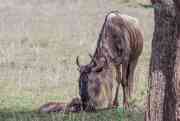
1 of the best safari companies for epic Kenya Safaris with African Budget Safaris
Landia Davies | January 24 2022

5 Remote places for crowd-free Tanzania & Kenya Safaris
Landia Davies | May 03 2021

Is the best African country for safaris Kenya or Tanzania?
Andrew Hofmeyr | May 22 2019

Kenya’s Ol Pejeta Conservancy: one of the most special places in Africa!
Landia Davies | June 08 2018
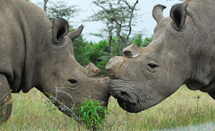
The Best Places to See the Birds of Kenya (Birding Safari Guide)
Andrew Hofmeyr | December 20 2022

The Best Time to Visit Kenya? How to Time Your Kenya Safari
Andrew Hofmeyr | January 28 2023

Come hang out with giraffes at Giraffe Manor in Nairobi, Kenya
Briony Chisholm | January 25 2019

13 Best Things to do in Nairobi, before & after your Kenya Safari
Briony Chisholm | August 03 2018

Private Group?
A private, tailor-made safari is within your reach. Experience all of your bucket-list safari related items on a budget now.
- Czech Republic
- Falkland Islands
- Latin America
- New Zealand
- North America
- South Georgia
- Kilimanjaro
- Adventure Travel
- Archaeology
- City Guides
- Itineraries
- Portrait Photography
- Tips and Advice
- Travel Photography
- Travel Stories
- Unhelpful Guides
- Wildlife Photography
- Work With Me
What To Wear On Safari: My Detailed Safari Packing List With Photos
You’ve all seen the brochure photos: a smiling family is sitting at a camping table in the middle of the African bush. Behind them, the sun is setting, and perhaps a giraffe is crossing the savanna landscape.
Contents (click to view)
What are they wearing? I’m sure you can picture it: lightweight designer safari gear, all matching, in indistinguishable shades of beige, taupe and camel. Maybe the dad is wearing khaki chinos and the mum has a floppy-brimmed hat (colour: putty) on her head. They all have sand-coloured lace-up boots on, and from head to toe all their clothes are pristine, clean, and crease-free.
If it’s your first time figuring out what to wear on safari, it might feel like this is the model you have to follow. Like, having booked the blindingly expensive trip of a lifetime, you now have to go out and splurge hundreds more on the ‘proper’ kit, otherwise people will laugh at you and you may even get into trouble for not doing it right.
Well I’m here to reassure you: that’s rubbish.
What should you wear on safari?
I’ve been on five safaris (to Kenya , Botswana , Tanzania , Uganda and South Africa) and I still don’t own any ‘official’ safari clothes. I’ve always worn stuff I already own and been just fine.
That said, there are some dos and don’ts about packing for a safari, some things it’s a good idea to make sure you bring with you, and some stuff you should definitely leave at home.
So welcome to my complete safari packing guide. I’m going to go through a few points and FAQs, and then make a handy list at the end. Scroll down if you just want to skip ahead to that.
What happens on a safari?
Days on safari follow a similar schedule. You wake early and head out shortly after sunrise for a morning activity – usually a game drive but sometimes a boat cruise, guided walk, or scenic flight.
You return to the camp mid-morning for brunch and have some hours to relax in the heat of the day before heading out again for another activity later in the afternoon. Your afternoon game drive or boat cruise normally ends with sunset drinks in a beautiful location, before you head back to the camp for dinner.
After dinner you might sit round the campfire or boma enjoying a few drinks with your fellow guests, but most people go to bed fairly early, ready for another dawn start the next day.
Read more: Top 50 African Birds: A Safari Photo Guide
What to wear on safari during the day
The most important thing to note is that a safari is not a fashion show. It can be hot and dusty, or rainy and muddy, so it’s important to dress for comfort and practicality, so leave the designer gear, luxury fabrics and bling jewellery at home. Instead, bring stuff that washes easily, dries quickly and hides the dirt well!
You’ll also be coating yourself daily in suncream and insect repellent, so don’t bring anything that won’t mix well with those!
When I was in Botswana in December, some days reached 40 degrees C (104 F) with high humidity, so think lightweight breathable fabrics like cotton, viscose or sweat-wicking sportswear, or even linen if you don’t mind the creases).
T-shirts and shorts are your friends, but I’d avoid strappy vests for two reasons:
- Many African countries are quite conservative, and it doesn’t do to flash a lot of skin.
- The sun is extremely strong and the more skin you show, the more of you there is to get burned, even in a shaded safari car.
What to wear on a game drive or boat cruise
On wildlife viewing trips you’ll be sitting in a car for several hours, so it’s important to be comfortable. T-shirts and shorts are a great option.
Early mornings in Africa can be chilly, so bring a long-sleeved shirt, light sweater or jacket just in case.
Don’t forget your hat and sunglasses. Safari cars have roofs, but sometimes the roof rolls back so you can stand up, and when the sun is low in the sky it can shine in from the side very strongly. I was surprised by how much I ended up needing my hat.
Since you won’t be walking around much, light sneakers or sandals are fine.
Safari cars are open-sided, so if it rains you may get a bit wet. Most safari companies carry ponchos in the car, to hand out to guests when it rains, but you might want to bring your own light waterproof raincoat just in case.
What to wear on a walking safari
For a walking safari the principles are the same, but you should wear long trousers to prevent your legs being cut or scratched by branches, and closed-toed shoes to protect you from biting or stinging animals or insects.
Although walking safaris can sometimes last for three or four hours, you don’t actually walk that far because there’s a lot of stopping and looking at stuff. So you don’t need hiking boots; comfortable trainers or walking shoes are fine. If you’re travelling in rainy season you might want to bring waterproof or Gore-Tex ones.
Read more: 46 Amazing African Safari Animals – A Photo Guide
Do I need warm clothes on safari?
We think of Africa as being hot, and it is, but it can also be extremely cold. If you travel during the northern hemisphere summer, that’s winter in most of Africa, and temperatures can drop below freezing especially in desert areas, if you’re at altitude, and the further south you go.
In Botswana and South Africa during the winter, average nighttime temperatures can be 0 or even -2 degrees C (28-32 F), and remember that most safari cabins and tents are not heated!
Even in Kenya, which is much closer to the equator and therefore not as cold, nights and early mornings can definitely be chilly.
Staff in camps will provide you with hot water bottles and blankets both in your tent and on game drives, but you still need to bring warm clothes with you as well.
If you’re travelling to the southern African countries between April and October, I’d recommend bringing at least one pair of long trousers, one long-sleeved top, one jumper, and a packable down jacket.
But remember to dress in layers, as the day quickly warms once the sun’s up, and even if it’s close to freezing during the night, afternoon temperatures can ramp up to high 20s (70+ F) or more.
It’s very important to check the weather forecast before you travel, as different regions’ climates can vary.
What colour should you wear on safari?
It’s recommended that you wear plain designs in neutral, earthy or natural colours, such as shades of beige, grey, brown or natural greens.
Avoid vibrant, bright colours like orange, red and yellow, or vivid patterns. This is for two reasons:
- It helps to make you less noticeable to animals.
- You can get pretty dusty on safari, and natural shades don’t show the dirt so much!
Bright white and full black are also not recommended. This is not only because they show the dust really badly, but because many animals actually only see in black and white, and large gleaming white shapes or dark black ones are very noticeable to them.
With that all said, I wouldn’t worry about it too much, and you certainly don’t need to rush out and buy an entire new wardrobe full of khaki and beige. As I just mentioned, many animals only see in black and white, and when you’re inside the car, most only see the car as one large object, and not the people inside.
It’s more important to stick to the rules when you’re on a walking safari and don’t have the protection of the car.
But in general, if you pack plain, neutral-ish colours, you’ll be fine.
Why not wear blue on safari?
Some people recommend not wearing blue on safari. Apart from being a pretty noticeable bright colour, it’s said to attract tsetse flies, which are prevalent in some areas of southern Africa and can deliver a nasty bite and spread disease. They are also thought to prefer black (another reason not to wear it).
That said, my light down jacket is bright blue, and I also took a blue t-shirt and a pale blue cardigan to Kenya, and I wore all three with no problems.
Read more: An Epic Uganda Itinerary In 2 Weeks
What to wear on safari evenings
Most people like to dress up when they go on holiday, so you might think about throwing a few glamorous dresses, high heels or some party shirts into your suitcase.
But you probably won’t wear them. Even in the luxury camps, most people really don’t dress up for dinner, for four main reasons:
- At night it’s a good idea to cover your arms and legs to avoid insect bites, so floaty skirts and strappy tops are a bad idea.
- It can get quite chilly at night, so you’ll probably be more comfortable in trousers and a fleece anyway.
- You’ll be tired after a long day and an early start; you’ll probably find you can’t be bothered to dress for dinner as you’ll be going to bed soon afterwards anyway.
- Walking round camp after dark you may run into snakes or spiders, and paths can be muddy and uneven, so high-heels are a definite no-no.
When I was in Botswana in December (the height of their summer) it was still 30+ degrees (86 F) in the evening, so I wore lightweight trousers or a long casual dress and then liberally coated myself with insect repellent. In Kenya in September it was a bit cooler, around low 20s (70 F), so I wore trousers, a t-shirt and a light cardigan, and had my jacket handy for later in the evening as the temperature dropped.
Is it OK to wear jeans on safari?
It’s perfectly fine to bring a pair of jeans for the cooler evenings, especially if you’re travelling in winter when you know it will be chilly at night.
However jeans aren’t recommended for game drives as you’ll probably be too hot in them during the day, and if you need to wash them they’ll take ages to dry.
As a general rule I wouldn’t take jeans on safari but instead bring lightweight trousers. The convertible zip-off ones that turn into shorts are especially good as you can have long pants for cold mornings and safari walks, and convert them into shorts once the day’s warmed up.
Pro tip: Whatever you choose to bring, make sure you have some ‘room to grow’! The food on safari is usually really good and you won’t be doing much exercise, so stretchy waistbands are a good idea!
Can you wear leggings on safari?
Yes, absolutely. Leggings are a great thing to bring on safari because they’re lightweight, wash and dry easily, are comfortable, and protect you from bugs and the sun. Just stick to neutral colours and leave the snazzy activewear designs at home!
I always pack a pair of leggings for safari – and if there’s a gym in the hotel then I can also use them for a workout!
What are the best shoes to wear on safari?
As I mentioned above, high heels and smart shoes are definitely not the thing to bring on safari. For game drives it’s fine to wear sandals or light sneakers, and for safari walks you want closed-toed comfortable walking shoes. You definitely don’t need to buy special safari boots, no matter what the sales people might say.
If your lodge or hotel has a pool, you might want to bring some flipflops (also handy to have for walking around in your tent at night, or for nipping to the bathroom block if you’re staying in a campsite).
Can you wear trainers on safari?
Yes, absolutely. I always pack a pair of Asics Gore-Tex trail trainers that I wear for exercise, when it’s muddy or raining, and for walking or hiking. On game drives and boat cruises, and for walking around the camp in the evening, I have a pair of Skechers Go-Walk sneakers that are super comfortable and easy to slip on and off.
Read more: Kenya Vs Tanzania: Travel Experts Decide
What to pack for the beach in Kenya or Tanzania
Many people like to combine their safari with a few days on the beach, perhaps in Zanzibar in Tanzania, or at Diani or Vipingo in Kenya .
Here’s where you will get the chance to dress up a bit – as if you’re staying in a nice hotel or beach resort destination, there will definitely be opportunities to put on a strappy dress, holiday shirt, or some sparkly sandals.
If you’re planning to hit the beach for a few days at the end of your trip, you’ll definitely want to throw in one or two nice evening outfits. And don’t forget swimwear and a beach cover-up too!
Can you wash clothes on safari?
This is a very important question, and the answer is yes! Almost all safari lodges and camps offer a laundry service and most of the time it’s included in the price of your stay. So you can wash your clothes as often as you like at no extra cost – which means you really don’t need to bring huge amounts of luggage as you can wash and re-wear your clothes several times.
Note that in many places the laundry is done by hand by the hotel staff, dried out in the sun, and ironed using an old-fashioned coal iron. This is yet another reason not to bring anything too delicate or precious, as there’s a small chance it may get damaged during the laundry process.
What sort of underwear should I bring for safari?
Ladies: remember that you may spend many hours bouncing around over unsealed and bumpy roads in the back of a safari car. Being quite an athletic build, this is not something that’s ever bothered me, but I’ve been reliably informed by more curvy girls that a sports bra can be a life-saver in this situation. So if you’re particularly susceptible to bouncing, bring sports bras!
It’s also important to note that the people who handwash your clothes are usually male, and for cultural and hygiene reasons they won’t wash women’s underwear. Ladies will need to bring a small amount of hand wash (though sometimes laundry soap is provided) and wash your own pants and bras in the basin. For this reason it’s a good idea not to bring anything too fancy or delicate: lightweight, quick-drying microfibre underwear is best.
Read more: Chimpanzee Trekking In Uganda: A Breathtaking Wildlife Adventure
Other things to pack for safari
Of course, packing is not all about clothes. Here are a few other things you won’t want to forget (more in the complete packing list below):
Camera, spare batteries, chargers, plug adapters
Can you imagine going all that way on safari on the trip of a lifetime and then forgetting your phone charger or camera? I know, I’d die!
So definitely make sure you pack all your gadgets, and all the cables and plugs you’ll need to make them work! And then bring spares!
Often hotel rooms and safari tents only have a limited number of plug sockets, so if you have loads of gadgets, it’s a good idea to bring a multi-socket splitter. I recommend one with surge protection : power cuts can happen frequently and if there’s a surge when the power comes back, your devices can get fried. This happened to me the night before my Tanzania safari , so now I’m extra careful!
Medication and toiletries
Most of the places you’ll be staying will be out in the bush, with limited access to shops. Make sure you bring all the toiletries, medicines and personal items you’ll need, as once you leave the airport, opportunities to replace anything that’s missing will be very limited.
Do you need malaria tablets for safari?
Large parts of Africa have malaria, including popular safari countries like Kenya, Tanzania, Uganda and Zimbabwe, so it’s very likely that you may need to take malaria tables on safari. I usually take doxycycline which is cheaper than malarone, but may not be suitable for everyone so speak to your pharmacist or travel clinic.
You can check the malaria risk for the country you’re visiting, as well as any other vaccine requirements at the Travel Health Pro website here .
Some countries also require you to have a proof of yellow fever vaccination – you can check if this is needed on the website above as well. For example, places like Kenya and Tanzania won’t let you in without proof of vaccination if you’ve spent time in a yellow-fever-risk country before arriving. If you have already had your yellow fever jab, make sure you pack the certificate!
What to wear for safari in Tanzania
If you’re planning your safari in Tanzania or Kenya as part of a trip that also involves climbing Kilimanjaro (or any other mountain), then check out my essential Kilimanjaro packing list here .
Best suitcase for safari
This is important, so pay attention! Many safaris involve internal transfers by tiny plane or even helicopter. They all have pretty strict packing rules, with a maximum of 15 kg weight per person and no hard-shelled suitcases allowed. Luggage must be soft sided, and don’t overpack! You shouldn’t need to anyway, since you can wash everything when you’re there.
Wheels are OK as long as it’s a soft bag, so I recommend a soft holdall with or without wheels, or a wheely backpack like the one I have and love . This one came to Kenya and Botswana with me with no trouble at all.
Read more: Nature Vacations: 25 Amazing Places For An Outdoors Adventure
Packing for safari for photographers
If, like me, you’re travelling with 15 kg of camera gear, don’t stress. The little internal plane operators are used to photographers and will let you put your backpack of gear at the back of the plane. I travelled with 15 kg of hold luggage and another 15 kg of camera gear around Botswana and Kenya, and it was never an issue.
There’ll be more on safari camera gear in a separate post, coming soon!
Meanwhile, for safari photography tips, check out 40 Safari Photography Tips For Stunning Wildlife Photos .
What should you NOT take on safari?
Now I’ve told you all the things you should bring on safari, here are a few things it’s a good idea to leave at home.
Perfume: No one in your safari car will thank you for dosing yourself liberally with Eau de Whatever, and if you wear a very strong scent it may even allow animals to detect you sooner and run away faster.
Hairdryer: Many safari camps run on solar power and cannot support a hairdryer. Those that can (if they’re on the grid, or running off a generator), will usually provide one that’s suited to the electricity supply. As I said, no one really worries too much about their appearance or cares about what your hair looks like on safari anyway.
Camouflage clothing: This might surprise you, but wearing military-style camo print clothing is a no-no in many African countries, where it’s associated with the military. It’s actually illegal to wear camo gear in Ghana, Uganda, Zimbabwe and Zambia.
Plastic bags: Disposable plastic bags are banned in Kenya, Uganda, and Rwanda. You should be fine with the little zip-lock one for your liquids on the plane, and I’ve used reusable plastic packing bags many times with no problems, but try to keep plastic bags to a minimum or you may get a fine.
A drone: Unless you have special permission, drones are not allowed in most lodges and African National Parks.
Expensive watches, jewellery, and other valuable items: This doesn’t just apply to African safaris but to all travel. Jewellery can easily get lost, damaged or stolen, so if you care about it, leave it at home.
A hard-shelled suitcase: As mentioned above, all safari companies ask you to bring a soft bag or at most a wheeled soft holdall , as these are much easier to pack into the small luggage spaces on planes and in cars. You will not be thanked if you bring rigid-sided luggage.
Where to buy safari clothing
For the most part, you don’t need any specialist clothing for safari. You can wear your own normal clothes. However, there are some great companies that do excellent clothes for travel, in suitable colours, and made from practical fabrics that are sweat-wicking, comfortable and don’t crease.
My favourite brands for travel clothes are The North Face , Patagonia , Rab , Mountain Equipment , Arc’teryx and Craghoppers , and my favourite places to shop in the UK are Ellis Brigham and Cotswold Outdoor , which stock all these brands at competitive prices, have high-street stores where you can get advice and try stuff on, and often have good end-of-season sales too.
What to wear on safari: my Africa packing list
So now we’ve gone through the details, here’s what I would pack for a 10-day or two-week safari in Africa.
What to wear on safari: Clothes
- T-shirts in neutral or earthy colours x 5. The green t-shirt in the photo above is by Mountain Equipment . I love it so much I bought three!
- Long trousers x 1 pair. I really like my lightweight ones from The North Face .
- Shorts x 1 pair.
- Convertible trousers that zip-off into shorts, or a second pair of shorts . North Face and Craghoppers both do good convertible trousers for men and women .
- Leggings . I’m a big fan of Sweaty Betty.
- Long-sleeved shirt for covering up in bright sunshine.
- Lightweight jumper or cardigan for chilly evenings.
- Lightweight jacket , fleece or mid layer for cold nights. I have a fleece from Arc’teryx and a mine is a Nano puff from Patagonia .
- Waterproof jacket . I have two, a lovely Zeta LT by Arc’teryx and a packable Meridien jacket by Rab .
- Dress or smart shirt for the evening if you’re going to a city or the beach (x2). For packable jersey or lightweight viscose dresses I love Boden , Sugarhill Brighton and Joanie Clothing .
- Gym kit – if you think you’ll need or use it. But many safari camps don’t have fitness equipment and you can’t go for a run in the bush or you might get chased by a predator!
- Sports bras or comfortable wireless bralettes x 3.
- Underwear x 7. If you’re staying for longer you’ll need to handwash. I recommend something quick-drying and non-delicate like these microfibre ones from M&S .
- Swimwear . I get cute bikinis and swimwear from M&S , Next , or Pour Moi .
- Sarong or cover up (if you’re spending time on the beach)
- Sandals or flip flops . I love my walking sandals by Teva .
- Trainers or walking shoes for exercise and walking safaris. Mine are Gore-Tex trail trainers from Asics .
- Soft sneakers for walking round the camp, game drives and boat cruises. I’m a big fan of Skechers Go Walks .
Pro tip: if you’re going to the beach and plan to do a lot of snorkelling, pack a rash vest or t-shirt to swim in. The sun is super strong and we all got very burnt even though we were wearing Factor 50!
What to pack for safari in winter
If the forecast is for cold weather, I would add:
- Another long-sleeved top or baselayer .
- A warmer, packable insulated jacket .
- A pair of jeans.
- Beanie hat.
What to pack for safari: Accessories
- Baseball cap or hat. My cap is this one this one by Buff and I really like it.
- Scarf or buff to keep dust off (and you can dip it in water to cool you down on very hot days)
- Headphones or ear buds (for the plane), you won’t need them on the actual safari! I have these ones which are pretty good and much cheaper than Apple ones.
- Eye mask and ear plugs (if you’re a light sleeper).
- Camera, batteries, memory cards and charger
- Charger cables for all your devices
- Portable phone charger. Mine is this one from Anker .
- Plug adapter for the country you’re going to, or a universal plug adapter
- Plug splitter or 3-way adapter with surge protection
- Refillable water bottle (though some safari companies provide them, so check). An insulated water bottle will keep your water colder for longer on hot days.
- A padlock for your luggage to protect you from airport thieves
Safari packing list: Toiletries
As well as all your usual toiletries and medications, don’t forget:
- Suncream. I swear by Riemann P20 because it’s hard wearing and you only need to apply it once a day. Or for the best face SPF you will ever find, that’s non-greasy and non-orange (!), I love this one from the Body Shop .
- Insect repellant (though this is often provided in camp).
- Malaria tablets ( check to see if these are required in your destination )
Pro tip: Luggage goes missing more and more frequently these days, so pack your medication or anything else vital in your hand luggage.
Where to next?
If you liked this post, why not try some of my other safari and Africa posts?
- Leroo La Tau In Botswana: See The Incredible Zebra Migration
- Uganda Animals: The Amazing Wildlife of Uganda
- Ol Doinyo Lengai Tanzania – Climb the Terrifying Mountain of God
- Entebbe Zoo – Uganda’s Wildlife Education Centre
- An Epic Uganda Itinerary In 2 Weeks
Liked this post?
Social shares help support my hard work! You can share via the buttons at the bottom, or pin this handy Pinterest Pin. Thank you!
Bella is a multi-award-winning travel writer, wildlife photographer and science and history documentary director from London. Among many awards and nominations she won Blogger of the Year at the British Guild of Travel Writers’ Awards 2023 and Best Photography at the Travel Media Awards 2020. Her work has been published by National Geographic, Wanderlust, and BBC Travel among others. Her films have been shown around the world including on the BBC, Discovery and PBS.
Further Reading...
A Safari In Tanzania: A Sneaky Peek Behind The Scenes
Entebbe Zoo: Visiting The Uganda Wildlife Sanctuary
Kilimanjaro Lava Tower: Lemosho Route Day 4
46 amazing african safari animals - a photo guide, is cardamom house in vipingo the best beach hotel in kenya.
Some of the links on this site are affiliate links. This means that if you click through and make a purchase, I will earn a small commission at no additional cost to you. Passport & Pixels is a participant in the Amazon Services LLC Associates Program. As an Amazon Associate I earn from qualifying purchases.
Detailed Kenya Safari Packing List (+ Free NO BS PDF)
An African Safari is one of those things that is in many peoples bucket list. Kenya, being one of the most popular safari destinations, may be the destination you have settled on for your African safari and you may be asking yourself what you should take with you.
Having lived in Kenya all my life and visited all of the most popular national parks in Kenya, I thought it would be helpful to write a comprehensive Kenya Safari Packing list that has packing suggestions broken down by month. This guide will help you plan what you should carry when coming to Kenya for your Safari.
In addition to this, I have also prepared a free printable packing list in a PDF with all of the items I have indicated below. Download it for FREE below
This post is long so here is a summary to help you jump to the parts of the article that interest you:
Clothing General Clothes for Adults Beachwear Shoes Clothing Tips Gadgets Gadget Tips Accessories & Miscellaneous items Toiletries Packing Suggestions Month By Month Plastic Bags are Banned
General Clothes for Adults
Pants (4 pieces ).
Your best option when choosing trousers for your Kenya Safari is either brown, green or grey khaki pants. The reason why these colors are the best because they are neutral and do not attract animals attention.
Avoid black, and blue trousers. They attract tsetse flies and also can easily draw the attention of the wild animals you will be viewing.
You can reduce your load if find pants whose legs can be unzipped into a short.
Shorts (3 pieces)
You are likely to visit the beach as you conclude your safari and Mombasa is unbearably hot and humid for most of the year. Shorts will help you stay cool there. Please read about some of the places that it’s inappropriate to wear shorts in Kenya in this article I wrote .
Underwear (Enough for the length of your Stay)
Kenyan laundry services do not wash underwear. It’s actually a cultural taboo to wash someone else’s undergarments. You will either have to wash it yourself or have enough to last you the entirety of your safari in Kenya.
Your underwear needs to be light and be able to breathe in hot and humid environments. They also need to absorb sweat well since you will be in the sun and hot environments for most of your day.
Sports Bras: Kenyan roads can get really bumpy and these will help you stay comfortable. All the roads on Kenyan Game parks are dirt roads and many get potholes in the rainy season.
Polo Shirts/ Tshirts (8 Pieces)
These need to be light and sweat absorbent due to the heat. You will also need to avoid choosing bright shouting colors like red, blue and black and white. Go for neutral colors that blend in with the environment you will be in. Those are Forest green, Gray, brown, etc.
Avoid wearing camouflage or military fatigue-like clothing. It might get you in trouble with the authorities. African governments have a phobia for anything that looks military being worn by the general public. To avoid getting harassed by the Kenyan Police, stay clear of any camo clothes
Socks (7 Pairs)
Get a good comfortable pair that you would wear during the summer. They need to breathe and absorb sweat well.
Fleece Jacket (1 Piece)
This will come in handy in the cold evenings and early mornings. With morning and night temperatures reaching in the 59°F range, you will need to keep warm for those few hours. The heat picks up quickly so make sure the jacket is light enough to carry around when you have removed it.
Instead of a jacket, the ladies can carry a shawl. It will be useful on many other occasions other than the cold mornings so this is the better option for the ladies.
Long Sleeve shirt/ blouse
This will be useful in the evenings when you are outside. Mosquito bites are really itchy and you can protect your arms by putting on a long sleeve shirt in the evenings.
Kenyans are generally more liberal than those of some of our neighbors like Tanzania but we still hold very conservative views towards dressing. You can wear your regular swimsuit to the beach but keep in mind that topless swimming is not allowed in any of the beaches in Kenya. So in choosing your beachwear, you will want to carry the following:
- Your swimsuit
- Swimwear coverup
- Flipflops that you’re ok with getting wet
Comfortable shoes (not Boots) plus Sandals (one pair of each)
Don’t carry boots.
You will spend a lot of time seated. Either in the car or at the hotel. You will occasionally be standing in your car to view the animals but the rest of the time will be spent on your seat. Therefore, when choosing your footwear, you will need to pick a comfortable flat pair of shoes.
Avoid carrying hiking boots unless you are going to be doing some outdoor adventure stuff like hiking in Hells Gate or climbing up Kilimanjaro . Its overkill and you will be really uncomfortable if this is the only pair of shoes you carried.
Pick a sturdy pair
One thing you will need to pay attention to is how well built your shoe is. When out on safari, the nearest place you can buy a quality pair of shoes if the ones you were wearing get torn may be several hundred miles away. You need to have a shoe that will be strong enough to endure several hard trippings on a rock .
Pair of sandals or flipflops
These will come in handy if your hotel or camp doesn’t provide any. You will need them when going to shower. Some camps have showers that separate from where you will be sleeping and it would not be advisable to go there barefoot.
Waterproof raincoat or umbrella
This can be a light jacket to cover you up on the off chance you might be caught in the rain. You might have to walk from your car to the hotel building with the rain pouring hard and you will want to keep yourself and your equipment dry.
Clothing Tips
Safari clothes.
- Choose neutral colors that blend in with the bush environment. This will allow you to come up close to the wild animals without spooking them.
- Wear full-length pants on a safari drive. This will help you keep mosquitoes and other bugs from biting your legs when out on a game drive.
- Temperatures change within minutes in the morning and evenings. Layer up your clothes to keep warm in the morning but stay cool when it gets hot.
Avoid revealing clothing
Kenyans are pretty liberal when it comes to dressing. However, these are usually city dwellers and you will find that the people in the villages are more conservative with what they wear. I would advise you to pack clothes that are not very revealing when going for your safari. It would also be a good idea for the ladies to pack one set of clothes that cover up your knees, shoulders, and torso for when you will be out and about in busy markets and the streets.
Laundry services in Kenya
- Leave an allowance: Most laundry in Kenya is sun-dried and so you need to have an allowance of extra clothes just in case the load you gave takes time to dry. This can happen in the colder months of June and July.
- Kenyan Laundry doesn’t wash underwear: Most of the hotel staff dealing with laundry are male and it’s considered a cultural taboo for a man to wash ladies undergarments. For this reason, almost all the hotels you will visit in Kenya do not wash undergarments.
Camera with Zoom Lens
Your camera needs to zoom in to animals that may be at a distance. Some animals are either shy or rare you may not be able to get a good shot if you have the regular kit lens. Shop around for a good lens for the safari.
Extra Memory cards
If you are anything like me, you get trigger happy with your camera when you see something you like. To make sure that you don’t run out of memory space, have a number of extra memory cards for your camera. Expect to take about 1000 photos per day if you are very trigger happy and this can add up if you are shooting at high resolutions.
If you decide to carry your cellphone with you, make sure it’s unlocked for international use. When you arrive in Kenya, you can get a Kenyan sim card and get connected.
The challenge with carrying your phone with you is that you will have signal issues when out in the bush and the phone might not serve its purpose.
This is one of the things that can easily get forgotten if you are carrying a large number of devices. One trick that I saw is plugging in all your chargers into an extension cable and packing the extension cable into your luggage. When charging your devices, you will just need to plug in that one extension cable and it will charge all your devices.
Power Adapter
Kenya uses 220-240 Volts electricity and this is different from the USA which uses 110V electricity. To ensure that you do not damage your devices, you need to use a power Adapter that converts the power to a voltage that is compatible with your devices.
Extension cable
Useful when you have a number of devices that need charging all together but only one power outlet.
When you have a number of devices, you may need to leave your things for safekeeping at the hotel reception. Having a lockable safety bag will help keep your things safe.
Gadget Tips
Carry old devices except camera.
To reduce the risk of losing a new device that you paid heftily for, carry an older phone and tablet. You will feel less afraid of losing your gadgets and
The phone needs to be unlocked
If you intend to use your phone or tablet to make a call or receive messages from home, you need to ensure that your phone is unlocked to be used internationally.
Accessories & Miscellaneous items
Bright sunny days can be a bit too much on your eyes and a good pair of sunglasses come in handy then. Sunglasses will especially be useful on the beach.
Notebook and pen
When going through immigration, you will need to write a number of things down and having your pen beats asking a fellow traveler for one. You may also occasionally need to write something like directions down and the notebook will help here.
Wide-brimmed Hat
You will, on several occasions, be out in the sun and there is no greater reprieve than getting your hat out. It will get really hot at midday and your hat will prove invaluable at that time.
Beanbag Cushion
As I mentioned earlier, the roads in the National Parks are not paved and are very bumpy. To get that crisp shot and reduce blurry photos, a beanbag will be of great use in keeping your camera steady.
First Aid Kit
You hope for the best but plan for the worst. Have a small first aid kit that has all the items that can help you in case of an incident when you’re out on safari.
Try to find a flashlight that you can strap on your head. You will find it useful when walking in the dark as you often will especially if you are in a camp that does not have indoor plumbing within your tent.
Portable Powerbank
When out on Safari, You will spend many hours away from a charging station and your power bank will be useful when you’re trying to keep that gadget running and you don’t have an immediate source of electricity.
Portable Packs Wet Wipes (1 for every day)
Sanitation is, at times is not taken as seriously as it should in some places in Kenya. You will need to take charge of your own hygiene by carrying a pack of kleenex that you will use whenever you are about to eat anything and after you leave a toilet.
You will find that some places do not have access to running water and this makes the hygiene issue much bigger.
You will be out in the sun a lot and you need to use a good sunscreen to keep you from getting sunburnt. I found the following article by WebMD on how to find a good brand of sunscreen. You might want to read it before making your purchase.
Bug Repellent
Africa has a lot of bugs. Some look scary and others are so small you might fail to notice them. The one insect you need to worry about is the Mosquito since it can give you malaria. Their bite is also really itchy and can a rash when scratched for long. Use bug repellent on your hands, feet and other exposed parts of your body when going outside at night and on your game drives.
Your full Prescription
If you are on any prescription medicine, make sure you carry enough to last you the entirety of your stay and a few additional days in case you have delays when going back home. I would also advisable for you to carry a written prescription from your doctor so that you can buy your medicine here in Kenya if you run out.
Toothbrush & toothpaste
Your hotel will not be providing these and you might not find your favorite brand if you plan on buying these over here. In addition to this, you might be several hours away from the nearest convenient shop when you are out on safari. For this reason, you will want to come prepared with everything you will need for the entirety of your stay.
Soap, Shampoo & conditioner
Your hotel will provide you with this but the brand and quality of soap may not be what you are used to.
Packing Suggestions Month By Month
The packing list I have described above would work for all parts of the year. However, below are suggestions of what you should pack if you are coming on any of the following months:
Kenya Safari Packing List January
January is sometimes a rainy month. If you will be coming in this month, carry a raincoat and a few sets of warm clothing in addition to the packing list I have described above. The shawl or fleece jacket will be important as well. Especially for the cold evenings. It doesn’t get very cold in the evenings so your fleece need not be very heavy.
Kenya Safari Packing List February
February is usually a dry month with hardly any rainfall in the whole month. The temperatures are usually high during the day and it will get slightly chilly in the evenings but not so so much that you would need a heavy fleece. You can probably survive on just a shirt in the evenings this month.
Kenya Safari Packing List March
The end of March is when the rains start in Kenya. This is the month you need a small portable umbrella and a raincoat. It does not get very cold during the day and the nights are also not very chilly. You will be ok if you carry a light fleece or shawl for the evenings but you may not need it since even the evenings are not very cold.
Kenya Safari Packing List April
This month is a lot like March in terms of rainfall. However, it starts getting colder in the evenings and this means that your shawl or fleece will be more important in this month. At the same time, mosquito populations are at their peak due to the puddles made by all the rain and the thick bushes where mosquito love to hide. Carry a lot of long-sleeved shirts and pants to keep your hands and feet from being bitten by the mosquitoes. Also, remember to carry your bug spray and ensure you have taken your anti-malarial medication before you come here.
Kenya Safari Packing List May
The month of experiences lower levels of rainfall compared to the previous months but the temperatures are now dropping. Your shawl and fleece will help with this. At the same time, there will be a lot of bugs, especially at night. If you can carry a can of bug spray, it will help clear them from your room. Sometimes, bugs enter your room if you leave the lights on in the evening and they can be difficult to remove if you don’t have bug spray.
The rainfall will not be high so you may not need to carry your umbrella if it’s too heavy but carry a light raincoat just in case it rains.
Kenya Safari Packing List June
June is the start of the cold season that lasts two months. You will typically need to wear something warm in most parts of the country both in the mornings and at night. The days are not typically sunny but the temperatures normally rise enough for you to be ok without a shawl or jacket.
In the month of June, you want to wear warm clothing in layers that you can take off as it gets warmer.
Kenya Safari Packing List July
July is the coldest month in Kenya. With temperatures going as low as 63 °F, you will need to carry heavier clothing and plan to dress in layers to allow you to shed off some of the clothing if it gets a bit warm. At the same time, have a fleece jacket or shawl for extra warmth in case it gets colder than you anticipated.
It does not usually rain but you can expect a drizzle that can get you wet if you are in it for a while. An umbrella will help with this.
Kenya Safari Packing List August
The month of August warms up and it gets dryer. Expect a lot of sun and mild to warm temperatures. You will not need to carry warm clothing but you can throw in a fleece jacket or shawl for the evenings and cold mornings that can get a bit chilly.
Kenya Safari Packing List September
September is also not a cold month. Apart from the evenings, and early mornings, you will be ok wearing light clothing. The day may get hot so carry light clothing so that you don’t get uncomfortable in the heat.
Kenya Safari Packing List October
We normally experience the short rainy season starting in the month of October. Carry something to protect you and your equipment from the rain like a light raincoat or small portable umbrella.
The rains are not accompanied by very low temperatures so all you need to keep you warm is your fleece jacket or shawl.
Kenya Safari Packing List November
The short rains end in November and the conditions are similar to those of October. Have your umbrella handy and your jacket or shawl to keep you warm in the evenings.
Kenya Safari Packing List December
We sometimes experience a few showers and thunderstorms in December so carrying your umbrella may be a good idea.
The nights will be chilly and there will be mosquito so plan to have something warm to cover yourself and pack some long sleeve shirts and pants to reduce the severity of the mosquito bites.
Plastic bags are banned
As a final word for this article, remember that plastic bags are illegal in Kenya and you will not be allowed to bring them with you on your safari. These include plastic zip-lock bags that might use to pack some of your toiletries. Use a different type of packagings like a cloth bag or plastic containers to avoid frustration at the airport.
Keep in mind that we may receive commissions when you click our links and make purchases. However, this does not impact our reviews and comparisons. We try our best to keep things fair and balanced, in order to help you make the best choice for you. As an Amazon Associate, I earn from qualifying purchases.
Antony Njoroge
Hi, I'm Antony & I'm from Kenya. I love traveling around Kenya when I get off from work and this website is a great way for me to share my local knowledge and tips that will help you travel well in East Africa. Having lived in East Africa my whole life, I share my personal experiences and knowledge with the goal of helping you optimize your East African Safari and make it an unforgettable expereince.
Recent Posts
Internet & WiFi in Kenya (A Complete Tourists' Guide)
If you are planning to visit Kenya any time soon, you might have wondered if Kenya has Internet and whether WIFI is easy to find. I have lived in Kenya all my life and I would love to answer this...
Is Mt Kilimanjaro Active? (And Should You Be Worried?)
If you are planning to visit Mt. Kilimanjaro like I am, you must have been doing a lot of research about your climb. During your research, you might have stumbled upon the fact that Kilimanjaro is a...

What You Need on Your Packing List for Safari in Kenya
Safari travel is supposed to be exhilarating, breathtaking, and unforgettable. However, if it is your first safari experience, it can also be stressful beforehand . There will be an overwhelming number of items on your packing list for safari in Kenya.
This article on what to pack for Kenya safaris will give you all the information you need to know. You will learn what is the best duffel bag for African Safaris, safari luggage restrictions , and some very important items to pack for a safari in Kenya, such as documents, cash and toiletries.

I went on safari to Kenya in October 2022, which means I can share with you all of my learned experiences on what to pack for safaris. In addition, I also gathered information online, from my safari organisers, plus from safari expert’s presentations working as a luxury travel consultant.
If you are looking for information for related more specifically to clothing for safari, read this article on the best clothes to wear on safari in Kenya . You may be unfamiliar with how a safari works ; therefore, you should read about what to expect on safari in Kenya .
This article will help you decide whether to book Nairobi airport meet and assist services and read about seeing orphan elephants at Sheldrick Wildlife Trust in Nairobi.
If you are considering a Nairobi National Park tour , read about it here, and discover the best hotels in Nairobi for a comfortable stay.
How to Pack for a Safari in Africa
Packing for a safari in Africa is not as straightforward as packing for any other type of holiday. You must follow strict rules regarding luggage limits and contents.
Read on to learn about the best method for packing for Kenya trips and safaris.
Soft-Sided Luggage

Most African safaris involve flying to one international airport to start the trip, followed by flights on smaller safari planes to get to the lodges.
In these smaller aircraft, you must pack your belongings in safari duffel bags because the luggage compartments are small, and the bags must be able to be manipulated into them.
In addition, when you arrive at the airstrip in your safari camp, you must fit your luggage into the safari vehicle. Therefore, the bags must be easy to move around and fit into smaller spaces.
Avoid bringing a hard-shell suitcase to the safari lodges because it is heavier and less practical.
The adjacent image shows the small luggage compartment on a safari plane.
Packing Cubes

Packing cubes will be handy on the safari. You will need to pack up your luggage every few days on safari and be able to quickly find clothes to wear at 5 or 6 am, which means your belongings need to stay organised.
Some safari lodges do not provide you with a chest of drawers for your clothing. However, there will be some hanging space and perhaps a tabletop to use.
As a result, it is good to use your packing cubes like drawers.
I arrange my packing cubes by the type of clothing, such as all t-shirts, shorts, and trousers in separate cubes.
- Packing Cubes from Amazon
- Packing Cubes from Calpak
- Packing Cubes from Osprey
Luggage Tags

Make sure you have a luggage tag on all your bags.
Firstly, it will make it easier to identify your bag on luggage belts. Plus, if your luggage gets lost, airport staff can locate it more easily.
Secondly, it is helpful to have labels on your bags for safari lodges so that staff know which bag belongs in which room and can take them there.
Lastly, you should have a luggage tag on your suitcase if you put the bag in storage at Nairobi Wilson Airport so that you can verify which bag belongs to you.
Check out luggage tags on Amazon here
Safari Luggage Restrictions
One key thing to consider when considering what to pack for Africa safari destinations is the weight restrictions because there are strict weight limits in place.
It is important to understand that the reason for the size dimension limitations is that the luggage compartments are small openings on the side or base of the plane.
On some planes, the luggage compartments are genuinely only wide and tall enough to slide a bag in. Consequently, if your baggage size exceeds the limits, there is a risk it will not fit on the plane.
In Kenya, two airlines that fly domestically to safari airstrips are Air Kenya and SafariLink. These airlines have different luggage allowances.

- Safarilink restrictions : 15 kg per person including your main duffel bag and hand baggage (all bags must be soft-sided bags). On the Safarilink website, the maximum dimension of all bags is 70cm x 60cm x 30cm.
- Air Kenya restrictions : 15 kg per person including duffel bag and hand baggage (must be soft-sided bags). The maximum dimensions of checked baggage are 60cm x 45cm x 33cm. The maximum dimensions of hand luggage are 53cm x 30cm x 23cm.
Make sure to check your own airline’s regulations to verify that you take the right size bag. The organisers of my safari advised that our baggage should be no larger than 62cm x 30cm x 20cm; therefore, this is the limit we went by.
If you are bringing camera equipment , there will likely be a weight restriction. The equipment should fit into your hand baggage and not exceed the baggage weight limit along with the rest of your belongings.
When checking in at Nairobi Wilson airport, the airport staff weighed our duffel bags to be checked in as our family of 5 and checked the weight of all our bags together. We could compensate if one of our bags were heavier than the other. Although the staff did not weigh our hand luggage at Wilson Airport.
Luggage Storage for Kenya Safari

If your safari involves flying to and from Nairobi Wilson Airport on SafariLink or Air Kenya, you may use the complimentary luggage storage at the airport.
Your safari may involve several safari locations, such as Masai Mara in Kenya or Serengeti in Tanzania. In addition, you could have planned a post-safari relaxation at a beach destination in East Africa or some wine tasting in South Africa. As a result, you may need to bring more items than will fit in the safari travel bag alone.
Thus, you can pack some heavier and unnecessary items for the safari in a separate suitcase without worrying if it exceeds the limits.
If you use the Wilson Airport Luggage Storage, ensure your suitcases have visible name tags.
You may also feel better locking your suitcase and sticking an Air Tag inside it. I use an Air Tag every time I travel and it helped tremendously when my luggage got lost in Toronto Airport at Christmas.
- Check prices for AirTags on Amazon
Here are some locks to purchase on Amazon if your safari suitcase does not already have a lock built in.
Alternatively, if you are looking for a hard-shell suitcase for the rest of your travel to Africa, consider purchasing a Herschel suitcase. The luggage from Herschel, which I own, has TSA locks on the zip.
- Buy your Herschel Suitcase here
Luggage: What to Take on Safari in Kenya?

As it has already been made clear – the best luggage for safari trips is soft-sided. Suitable options for soft-sided baggage include a duffel bag, a gym bag, or a camping backpack. Ideally, there will be no wheels on the bag.
The bags will get dusty from being on the dirt, in the base of an aircraft, and inside a safari vehicle. So make sure the bag is sturdy and not too precious. You will probably want to wipe your bag down when you get home.
A common way of travelling to Africa is with a duffel bag and a wheeled hard-shell suitcase (the latter going in storage while on the safari). You can carry a duffel bag and a backpack as hand luggage on most airlines. Then you can check in the hard-shelled suitcase.
Carrying your duffel bag as hand luggage may offer some relief in case you are worried about your suitcase getting lost in transit.
Alternatively, it may be more comfortable travelling lighter while navigating the airport. If you are travelling premium or business class, you are usually permitted to check in two suitcases.
Best Luggage for Safari in Kenya
One of the most important recommendations for this packing list for Kenya safari trips is the luggage.
The following options would be suitable for those travelling on Safarilink or Air Kenya planes. These duffel bags are all either within the dimensions of 62 cm x 30 cm x 20 cm, or they would be fine if the bag is not too full.
Osprey Daylite Duffel 45L

Based on the dimensions given by my safari company (62cm x 30cm x 20cm), I ordered the Osprey Daylite Duffel 45L and it was the perfect safari bag.
The dimensions of the Osprey duffle bag are 53cm x 36cm x 24cm.
This is a fraction too large according to the dimensions I was provided; however, I knew if I did not fill the bag too full, it would be able to squash down and fit the appropriate measurements.
I loved the different compartments on the bag. Plus, I liked that you could carry the bag as a holdall or wear it like a backpack using the shoulder straps.
You can purchase the Osprey Daylite Duffle from various shops online; however, I bought mine Amazon because the shipping was quicker and there was more availability of colours.
I use this bag all the time for other weekend trips where I am taking only hand luggage on the plane.
- Check prices for Osprey Daylite Duffel on Amazon
- Check prices for Osprey Daylite Duffel on Go Outdoors
North Face Base Camp Duffel (small)
I already own the North Face base camp duffle in medium and large. These bags were extremely helpful when I was moving back from Ontario, Canada to England. However, sadly the size I own were too big to bring as safari travel bags.
The small version of the duffle bag from North Face is a great size for those travellers flying on Air Kenya, since its dimensions are 33cm x 53cm x 33cm. As a reminder, Air Kenya’s max dimensions are 60cm x 45cm x 33cm.
Not only is the North Face duffel bag a resistant material that will handle all terrains and weather thrown at it. It is also easy to carry as a backpack and can fit plenty in without popping the zip (I am talking from experience).
- Buy North Face Base Camp Duffel (UK)
- Buy North Face Base Camp Duffel (North America)
Patagonia Black Hole Duffel
I saw many people with this bag; therefore, it needs to be on this packing list for safari in Kenya.
This bag is larger than the smallest requirements, but would fit if the bag is not packed to its fullest.
- Buy Patagonia Duffel from Amazon
- Buy Patagonia Duffel from Selfridges
Lifeventure Packable Duffle 70L

This is a much cheaper alternative and easily packed into another suitcase when empty. Therefore, it could be an option for those needing a low-cost solution that is great at being manipulated into small spaces.
However, be aware that is a very flimsy bag because the material is quite light and thin. The material is also not as water-resistant as the above recommended options.
- Check price of Lifeventure Packable Duffle on Ellis Brigham
Kenya Safari Packing List
Plastic bags are forbidden in Kenya. If an airport official searches your bag and finds any, the bags will be confiscated. Therefore, you should ensure you do not bring any into the country.
You will need to find alternative options for the items that you would usually pack in plastic bags.
Plastic Bag Alternatives

- Buy wash bags from Amazon (USA)
- Buy wash bags from Amazon (UK)
- Buy shoe bags from Amazon (USA)
- Buy shoe bags from Amazon (UK)
- Buy laundry bags from Amazon (USA)
- Buy laundry bags from Amazon (UK)
- Reusable silicone food bags – these work well for liquids that may be at risk of leaking.
Safari Essentials: What to Bring on Safari in Kenya
Here are a few items you will need to bring while on game drives.

- Osprey Ultralight Stuff Pack – the best day bag for safaris
- Buy Nikon Binoculars on Amazon USA
- Buy Nikon Binoculars on Amazon UK
- Buy Olympus binoculars on Amazon UK
- Buy Bushnell Binoculars on Amazon UK
- Buy Pentax Binoculars on MEC (Canada)
- Buy Fujifilm Camera from Amazon USA
- Buy Fujifilm Camera from Amazon UK
- Camera lens (rental)
- Hand sanitiser
- Bandana for dust
- Sunglasses (and a sunglasses lanyard to wear them around your neck is handy)
- Night vision binoculars – you may consider investing in a pair of binoculars specifically for night use. The hotel manager at Sala’s Camp showed us his pair of night vision goggles and it was incredible what you could see .
Toiletries: Kenya Packing List
When packing for safari in Kenya, toiletries are some of the most essential items on your list.
It is best to have a wide range of medicines and toiletries to cover all scenarios. I used almost all the toiletries that I packed .

- Imodium or anti-diarrhoea tablets – it is quite common to get an upset stomach from water usage or your malaria tablets
- Antihistamine – if your bites usually swell up, ensure you get strong tablets. Benadryl in US/Canada or Piriton in the UK
- O.R.S Hydration Tablets ( Buy tablets on Amazon UK )
- SIS Electrolyte Tablets ( Buy tablets on Amazon UK )
- Nuun Sport Electrolyte Tablets ( Buy tablets on Amazon Canada – Nuun also available in USA)
- OFF! Deep Woods Insect Repellent Aerosol (Available in USA & Canada)
- Jungle Formula Maximum Insect Repellent Spray with DEET (Available in UK)
- Manual toothbrush (electric versions may run out of charge)
- Hand sanitiser (for after going to a bush toilet on a game drive)
- Antiseptic ointment – Savlon for the UK or Polysporin/Neosporin for Canada/US
- Non-drowsy motion sickness tablets – for the small planes
- Paracetamol/ibuprofen – you never know if you will feel unwell, so it is best to come prepared
- Simple Cleanser or the Ordinary Squalane Cleanser
- Simple Toner or Indie Lee CoQ-10 Toner
- The Ordinary moisturiser or BYOMA moisturising gel cream to keep your face hydrated
- La Roche Posay face sunscreen or Ultra Violette Extreme Screen for spf
What to Bring on Safari for Malaria Prevention?
- Long-sleeved clothes (jacket or long-sleeve shirt, trousers, and long socks for evening meals)
- Mosquito repellent – lotion or spray
- Malaria tablets – you will need to see a travel clinic for this
- Avoid scented moisturisers and perfumes
- Some malaria tablets can give you side effects, such as vivid dreams, upset stomach, and headaches, but they are still worth taking.
Learn about safari clothing you should bring to Kenya .
What Camera to Take on Safari?

The question of what camera to bring on Safari depends on what camera you already own. If you have a DSLR or mirrorless camera, then you should bring it. These cameras will take superior photos than your mobile phone will.
If you do not own a more advanced camera, I would wholeheartedly recommend getting hold of one – whether you buy, rent, or borrow one from a friend. You will see the difference in the quality of photos from your phone easily – especially if you have a decent lens to use with it.
When choosing between a DSLR or a mirrorless camera, a mirrorless camera is the better choice for a Kenyan safari.
Mirrorless cameras are physically smaller, so they take up less space in your hand luggage and they are much lighter. But the image quality between the cameras is similar.
I borrowed a Nikon D700 (DSLR camera) and rented a Nikon AF-S 28-300mm f/3.5-5.6 lens. If you are unfamiliar with lenses and you would like to rent one, you should contact a lens rental company because they will tell you what lens is compatible with your camera.
The Nikon D700 that I used was heavy and bulky, which was not ideal due to my limited baggage allowance. Additionally, wearing the Nikon D700 camera was a strain on my neck while I took photos of animals on game drives.
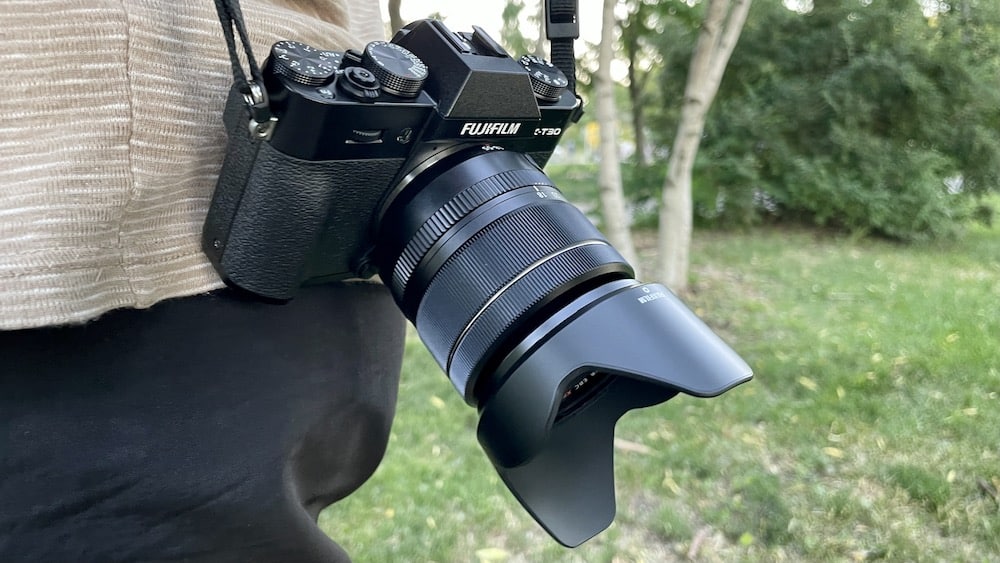
However, the benefit of a DSLR camera is that it can be more affordable than a mirrorless camera. Plus, I was grateful to be able to borrow a high-quality camera for my safari in Kenya.
Therefore, if you can choose what camera to bring on safari, I would suggest bringing a mirrorless camera with a decent lens. Aim for a lens with a 300mm focal length. This option will give you good enough zoom to capture pictures of animals slightly further away.
If you are looking to purchase a camera, I would recommend buying the Fujifilm X-T30 II . It is a light and portable camera and still takes incredible pictures.
- Check reviews for Fujifilm X-T30 II on Amazon US
- Check reviews for Fujifilm X-T30 II on Amazon UK
Electronics: Safari Packing List Kenya

- Memory cards with sufficient space for anticipated photos – I brought memory cards with me with 32 GB and 16 GB of space and took around 1,000 photos on my camera and 1,000 photos and videos on my phone
- Back-up camera batteries (always keep one fully charged)
- AirTags (peace of mind for your luggage)
- UK 3-prong adapters for plugs (the hotels and lodges I visited had USB plugs, but do not count on that) – so you may need a US to UK adapter
- Mirrorless or DSLR camera
- Camera lens cleaning solution (the lens will get dusty while out on game drives)
- Microfiber cloth (to wipe the camera lens)
- Portable charger (helpful for travel days when your phone battery gets low)
- Hard drive – you may want to make sure you have a hard drive at home so that when you return from your trip you can save a copy of your photos
Travel Essentials for Flights
- Surgical face masks (not fabric – some domestic airlines still require this)
- Book for entertainment
- Pre-download some films on an iPad
- Noise-cancelling headphones
- Portable phone charger
- Travel insurance – UK residents, check out Travel Supermarket , a comparison site to help you get the best deal
Documents for Travel to Kenya
When packing for Kenya safaris, you must stay on top of several admin tasks, including applying for visas, getting travel vaccinations, and purchasing some foreign currency.
You must also check that your passport has at least six months remaining before expiration following the date you arrive in Kenya.
Vaccinations for Kenya

Make sure you visit a travel clinic around eight weeks before your travels.
You may need to have enough time to get several doses of a vaccine or to make sure there is enough availability for appointment slots. There was a shortage of yellow fever vaccinations in England before my trip.
It is up to your medical professional which vaccines are suitable for your needs and the type of trip you are going on. Although I received Hep A & B, Typhoid, Yellow Fever, Polio, and the Tetanus, Diphtheria, and Pertussis vaccine.
Keep checking the regulations when visiting Kenya. My family and I needed to have our covid-19 vaccinations validated before boarding on the Global Haven website .

Be aware of what visa you need for Kenya and other African countries you will be visiting. The following information is purely what I arranged and experienced.
Please check your requirements before travelling.
If you are entering Kenya once, you will need a single-entry visa.
However, if you will be entering Kenya twice on the same trip, like we did, you will need two single-entry visas – not a multiple-entry visa . We booked round-trip flights to Nairobi and during the trip, we left Kenya to go to Zambia.
Pay very close attention when applying for your e-visa. Your e-visa should be approved online within a few days. If you have not had an email showing your approval, or you cannot see your approval status on the online portal, there is likely a problem with your application.
The immigration website will not tell you if your application has been rejected, it will say that the application is still in process.
One of my family members applied for a single-entry visa but noticed the visa had still not been approved three weeks later. She was unable to get hold of anyone from the immigration office by phone or email.
Luckily, our safari company had a contact at the airport who could tell us why the application was not approved. Otherwise, we would have had to buy a new visa for an additional USD 50.
Try your best to get your application approved first-time because they may ask for a monetary favour instead of you buying a new visa, which is what we experienced.
The first reason the application was not approved was that the photo on the application was unsuitable. The image should be passport-style, meaning you are not allowed to smile in the picture and you must be facing straight at the camera.
Secondly, she had not put her middle name in the application even though the passport shows a middle name.
Once your application has been approved, make sure you print off a copy of the visa and have it handy when you pass through immigration in Kenya.

You can use USD or Kenyan Shillings (the local currency) in Kenya.
You must ensure the USD notes you bring to Kenya are dated after 2000 . Some countries, such as Zambia require USD notes minted after 2007. Check the notes while you are at the desk receiving your money.
I wrongly assumed that the cash we exchanged back home would be dated correctly, and we did not realise we had several notes that were minted in the 1990s until we were in Kenya. They are very strict about accepting USD notes from after 2000.
If you are from the UK or somewhere with an unfavourable USD exchange rate, I would suggest getting plenty of Kenyan Shillings. If you purchase souvenirs or other retail items in Shillings, it may be a cheaper rate than buying souvenirs in USD.
Keep the receipt of your currency conversion because customs in Kenya may want to see it.
It is important to have many smaller USD notes, such as $5 notes.
Gratuities for Safaris

Kenya is a tipping-based country – most services expect a tip. Therefore, you will need to bring enough cash to cover this.
There are usually guidelines on how much to tip for safari lodges. For example, you should tip your driver-guide and your spotter individually, and you can give them the tip money at the end of your stay at that camp.
You can tip the rest of the staff from the lodge at the end, separately to your driver-guide and spotter. There is usually an envelope that you can leave in a box in the main area of the camp.
The suggested tipping amount for my safari lodges was:
- USD 15 per driver-guide per day
- USD 10 per spotter per day
- USD 25 per room per day for general staff
- USD 5 per spa treatment
In addition to cash for tipping, you should also bring some money for souvenirs.
Try to estimate the amount of cash you will need for tips, any cash payments, plus some souvenirs – then bring more than you calculated . You may experience that there are always extra people to tip than expected and plenty of opportunities for buying souvenirs.
Sometimes you can pay for items with a Visa credit card; however, many establishments will not accept a Mastercard or American Express.
What Not to Pack for Safari in Kenya

Do not bring too much makeup because it is dark at night, and you do not have much time to get ready in the mornings or evenings.
For those who usually wear make-up, I suggest getting eyelashes tinted and eyebrows laminated if you want a natural look while on safari.
Additionally, you do not need to bring formal evening outfits for dinner, even on a luxury safari. A clean change of clothes will suffice. Also, do not bring precious jewellery.
Leave your clothing with a camouflage pattern at home – it is illegal to wear this pattern in parts of East Africa.
Read this article for more information on what to wear on safari in Kenya . It covers all the clothes for safari in Kenya required, plus it discussed things to take on safari in Kenya while physically on game drives.
Some luxury safari camps provide amenities to use during your stay, which means you can cut down on some of your items to pack.
While on my Masai Mara safari, my accommodation provided hairdryers, torches/flashlights, fleece ponchos, and a reusable water bottle; therefore, I did not need to bring these items.
You should remember that plastic bags are forbidden in Kenya. So, bring reusable bags for dirty laundry and shoes.
Unless having your laptop is essential, I would advise you to leave it at home. You do not want to worry about it being stolen. Bring an iPad or tablet that you can watch films or episodes on when on planes or without a good Wi-Fi connection.
It may be better to bring a manual toothbrush and razor because you may not be able to charge your electric bathroom devices while on safari or in other hotels.
Advice for a Packing List for Kenya Safari

Do not leave packing for Kenya until the last minute because you may forget something essential.
I found that the best luggage for African safaris was a combination of my Osprey Daylite Duffle for the safari portion of the trip, combined with my Herschel Supply Co. hard-shell suitcase for the remainder of the items kept in storage.
Here is a summary of must-have items to help you remember what to pack for a safari in Kenya.

- Documents (visa, passport, vaccination records)
- Anti-diarrhoea tablets
- Cash in USD and/or Kenyan Shillings
- Long-sleeved clothing
- Plenty of underwear (the camp laundry service will not wash women’s underwear)
- Hat (baseball cap or wide-brimmed)
- Clothing in beige, khaki, grey or green (including a jacket to stay warm)
- Sports bra (ladies will appreciate this)
- Flip flops (they will come in handy to throw on after your morning game drive to go to lunch)
- Bandana (to prevent dust on the face)
FAQ – Kenya Packing List
What can you not bring into kenya.
Kenya has implemented a strict ban on single-use plastic bags. The ban is part of the government’s efforts to reduce plastic pollution and promote environmental sustainability. As a result, anyone traveling to Kenya is prohibited from bringing any plastic bags into the country, such as duty-free shopping bags.
What luggage to take on safari?
When packing for a safari, go for duffel bags or soft-sided suitcases because they’re light and fit easily in safari vehicles. Leave your hard-sided suitcases with wheels in storage in your city of arrival or departure.
A water-resistant bag is essential for protecting your belongings during unpredictable weather and terrain. Remember to bring a lightweight daypack to carry important items such as cameras, binoculars, sunscreen, and insect repellent during game drives.
What is the Safarilink luggage allowance?
Safarilink allows each passenger a maximum of 15 kilograms of baggage, including carry-on bags, on their domestic flights.
It is recommended to pack using soft bags rather than hard-sided suitcases as they are easier to store in the plane’s limited luggage compartments.
Additional bags or overweight luggage will incur an extra fee.
What is the best duffel for safari travel?
The best duffel for safari travel should be lightweight, durable, and spacious enough to hold your belongings. Look for one made of sturdy materials that can withstand the harsh conditions of a safari.
The North Face Base Camp Duffel is a popular choice. It’s made of waterproof material, has ample storage space, and multiple compartments to organise your items. It also comes with padded shoulder straps for easy carrying.
What to pack for safari in Kenya?
Opt for soft-sided luggage like duffel bags, as they are easier to manipulate into smaller safari planes and vehicles.
Remember to pack necessary toiletries, clothing in neutral colors like beige, khaki, grey, or green. Avoid bringing plastic bags, camouflage clothing, precious jewellery, and unnecessary makeup.
What are some travel essentials in Kenya for safaris?
Binoculars, camera equipment, insect repellent, and cash in USD or Kenyan Shillings for tipping and souvenirs are essential items for an enjoyable safari in Kenya.
Samantha is the founder of Continuous Roamer, a travel website focusing on adventure and the outdoors.
With a love for adventure and the great outdoors, Samantha shares tips on skiing, luxury safaris, camping, and finding hidden food gems in different destinations.
With over 20 years of skiing experience across Europe, North America, and beyond, she's also an expert in luxury accommodations and experiences.
Whether camping in Canada or dining in a Michelin-starred restaurant, Samantha always seeks out the best experiences and accommodations, and her blog highlights the best of them for her readers.
Samantha is currently living in London.
Similar Posts

Where to Stay in Nairobi Kenya? 5 Best Hotels You Need to Consider
Nairobi, the vibrant capital of Kenya, is an excellent pre-safari destination because it boasts convenient connections to many national parks…

What to Expect When Visiting Sheldrick Elephant Orphanage Kenya?
If you are visiting Kenya for a safari, you will likely be flying in or out of one of the…

What Happens on a Typical Day on Safari in Kenya?
Before your first safari in Africa, it is hard to imagine what to expect. You may have some ideas about…

Nairobi Airport Services: Meet and Assist – Is it Worth it?
Arriving at an airport for the first time in a foreign country can be daunting. Therefore, sometimes you need a…

What to Wear in Kenya Safari Destinations? (12 + Essential Items)
If you have never been on safari before, it can be difficult to know what clothes to wear on safari…

Is a Nairobi National Park Tour Worth it?
You may not have heard of Nairobi National Park and be surprised to learn that it is possible to go…

What to wear on safari – full guide on what to pack for safari in Kenya
Safari trips are amazing adventures! And so was our Masai Mara safari in Kenya . However, in order to fully enjoy your African holidays, it’s important to know what to wear on safari to feel comfortable. Below you can find the necessary safari packing list, that will help you decide on what to pack for safari in Kenya (or any other African country).

Items that you pack for safari in Kenya can greatly help on your trip. Good safari clothes will protect you from the sun, red African dust and the coldness of the mornings/afternoons, at the same time helping you to blend in with nature. Safari accessories let you capture all the amazing African safari animals , that you can see and not worry about anything else.
What to pack for safari in Kenya?
What to wear on safari – clothes to pack for the safari in kenya.
The best clothes to wear on a safari should be light, breathable and in neutral colours. They also need to be adjustable for both cold and hot temperatures, as those can change quite rapidly in Africa.
The temperatures on the safari in Kenya can be hot during the day and then quite chilly and even cold during the night/early morning/evening. During our hot air balloon safari in Masai Mara , we needed to wake up very early around 3 am and drive to the starting point. Man, it was chilly. I was wearing a jumper, a Gore-tex jacket, a scarf, and a hat and gloves and I was so glad I had them all. Layers are a great way to keep your luggage light but allow you to stay warm.
The colours of the African safari clothes would preferably need to be neutral. The best way to get close to wildlife is to blend in as much as possible. Go for the earthy colours like brown, khaki, beige. Do not wear too light coloured clothes like white, as they can quickly get dirty due to the red African dust. Avoid also very bright red colours and dark blue, which can attract the Tsetse fly. For the evening clothes, if you stay inside of your camp or resort, focus on the light-coloured fabrics to not to attract the mosquitoes.
This post contains affiliate links, which means that I may receive a small commission, at no cost to you, if you make a purchase through a link. More details here .
#1 long-sleeved shirt.
Long-sleeved shirt Available on Amazon here
#2 Long airy pants
For the same reason as for a long-sleeved shirt, long, loose and comfortable pants are great to have in Africa. I loved my thin jumpsuit and some loose pants that I got from my previous trips to Asia .

#3 A fleece and a light jacket

A fleece: Check on Amazon here Gore-tex Marmot jacket: Check on Amazon here
#4 A few safari shirts or t-shirts
The best are short-sleeved T-shirts, so you have your shoulders covered from the sun. If you like vests (I do!), you can always cover your shoulders and neck with a scarf. The button-down tops made from breathable material (try microfibre or linen) are good too.
#5 Safari pants – shorts or convertible trousers

Convertible pants Find them on Amazon here
#6 Safari shoes – comfortable trainers or sport sandals

Sport sandals Find the safari sport sandals on Amazon here

#7 Wide-brim hat

Wide-brim safari hat Find safari hat on Amazon here
#8 Sunglasses
Sun in Africa can be very strong, so protect your eyes and get proper sunglasses! A good idea is to take two pairs, in case one of them breaks. Polarized sunglasses like those ones with leopard pattern will help you to protect your eyes more and stay in the animal fashion theme. Check the safari sunglasses on Amazon .
Always useful – for protection from cold, for covering shoulders from the sun or from mosquitoes.

Other items to pack for safari in Kenya (or any other African country)
#1 camera with a zoom lens.

Safari photography gear Mirrorless Fuji X-E1 camera: Check it on Amazon here Fuji zoom lens 50-230 mm: Check it on Amazon here Samyang landscape 12 mm lens: Check it on Amazon here More of my photography gear here.
#2 Good sunscreen

I usually take a separate suncream for my face and another one for the body. My face suncream has been always been Anthelios from La Roche Posay, I really like Anthelios Dermo Kids , but I also wanted to try Anthelios Ultra Light Sunscreen Fluid . They are both very light, easily applicable and they don’t make my mixed skin any more problematic – rather otherwise.
For the body, I like to use minimum SPF 30, for example, Anthelios Cooling Water-Lotion Sunscreen 30 , but even 50 is good for Africa if you have delicate skin.
Sunscreen Anthelios Dermo Kids 50+: Find it on Amazon here Anthelios Ultra Light 50+: Find it on Amazon here Anthelios Cooling Water-Lotion 30: Find it on Amazon here
#3 Mosquito spray

Mosquito spray 100% DEET: Find it on Amazon here 40% DEET: Find it on Amazon here Gear and clothes insect treatment Find insect treatment for clothes on Amazon here
#4 Camera accessories

Camera accessories SanDisk Extreme memory cards : Available on Amazon here SD card reader : Available on Amazon here Manfrotto compact tripod : Available on Amazon here
#5 Travel adapter

Universal travel adapter (180 countries) Find the travel adapter on Amazon here
#6 Powerbank

Light Powerbank with a flashlight Find it on Amazon here
#7 First aid kit

First aid kit Find the first aid kit on Amazon here

Take and drink plenty of water during the safari in Africa. It’s very easy to forget about it when you are busy admiring the animals, but it’s very important. You can bring one of the environmentally friendly insulated water bottles with you that keep the water nice and cool for a long time. Check for the best-insulated water bottles here.
I also really like the filter bottles – they filter out bacteria, viruses, and metals, so you can drink water almost from anywhere (depending on the type of bottle). They save you money on buying water and are also environmentally friendly. I use bottle Water-to-Go, but LifeStraw is also very popular (it doesn’t filter out the viruses though)
Insulated water bottle Available on Amazon here
What else would you pack for safari in Kenya? Do you have any recommendations on what to wear on safari? Let me know in the comments!
Like it? Pin it!

Sharing is caring!
Related posts:
- 40+ Photos Of African Safari Animals during Great Migration – Masai Mara safari, Kenya
- Niesamowite Afrykańskie zwierzęta – Safari Masai Mara w Kenii [GALERIA]
- Kenya charity visit in local village and how to sponsor a child in Africa
- Best way to hike Kawah Ijen in Indonesia (with or without a tour) – Full Guide
Leave a Reply Cancel reply
Your email address will not be published. Required fields are marked *
- Email: [email protected]
- Call: +254 722 444 445

- Camps & Lodges
- Airport Transfers

Packing List for Kenya Safaris
You’re about to embark on an adventure of a lifetime—a safari in Kenya! From the stunning landscapes of Maasai Mara to the vibrant wildlife that calls it home, a Kenyan safari is an experience like no other. You’re likely already dreaming of getting up close and personal with some of Earth’s most magnificent creatures.
But before you jump on that plane, there are a few things you need to consider when packing on preparing for a Kenya safari. A safari in Kenya is unlike any other holiday—you’ll be spending the majority of your time outdoors, exposed to the elements, and you need to make sure you have all the right gear.
Whether you’re planning a camping trip out in the wild or a luxurious stay at one of Kenya’s world-famous game lodges, it pays to be prepared. To help ensure everything runs smoothly during your travels, we’ve put together a comprehensive packing list for exploring Kenyan safaris. Read on for our ultimate guide!
What to pack for your Kenya Safari
Are you ready to explore the wilds of Kenya? If so, you will want to make sure that you pack the right items to make your safari as enjoyable and memorable as possible. What should you include in your packing list? Let’s take a look.
First, when it comes to clothing, make sure to bring along light and breathable fabrics that are comfortable against the skin. Shirts, shorts, and pants made from quick-drying materials like nylon or polyester are best. Additionally, hats and sunglasses are a must-have for protection against the sun’s strong rays, while a light raincoat or poncho will come in handy during the rainy season.
In terms of footwear, sturdy hiking boots with good grip are essential for keeping your feet protected during long treks. You may also want to pack a water-shoe–to keep your toes out of harm’s way when crossing rivers or streams.
Finally, don’t forget important items like insect repellent (to keep away pesky insects), water bottles (staying hydrated is key!), binoculars (for bird watching or spotting wildlife from afar) and a camera (for capturing unforgettable memories).
What to Wear on a Kenyan Safari
When it comes to what to wear for a Kenyan safari, comfort and practicality is key. You’ll be spending a lot of time outdoors, so you want clothes that are lightweight and breathable. You’ll also need to think about covering yourself up from the sun and the dust. Here’s what you should include:
- Lightweight Tops : Loose, long-sleeved shirts are best, as they will protect your skin from the sun while still being breathable. A couple of lightweight sweaters or cardigans may also come in handy in case of cooler weather.
- Pants and Shorts : Khakis or cargo pants are great for safaris as they are durable enough to withstand plenty of outdoor activities. Some shorts should also be packed if you expect warmer temperatures.
- Footwear : The key here is to bring shoes that you can easily slip on and off but that gives you enough support when walking around outdoors. Closed-toe shoes are recommended as they will protect your feet from any bugs or reptiles out in nature. Spare laces may also come in handy if needed.
Gadgets and Tech Accessories for a Safari travel
Gadgets and tech accessories are essential for any Kenyan safari . You’ll need items such as a camera, phone, power bank, binoculars, and more to stay connected and capture all the amazing sights and experiences you encounter on your journey.
Here is a comprehensive checklist of must-have gadgets and tech accessories for your Kenyan safari:
- Camera: A good camera is essential for documenting your safari journey. Make sure you bring extra lenses, battery packs, tripods, and lens cleaners.
- Phone: Cell phones can be an indispensable tool when exploring Kenya’s wonders. Make sure to bring the necessary chargers and adaptors for staying connected while on the go.
- Power Bank: Power banks are a great way to stay charged up while exploring remote areas of Kenya. Look for compact models that provide plenty of juice but still fit in your bag or pocket.
- Binoculars: Binoculars are essential for spotting wildlife from afar, so make sure to bring a pair along on your safari. Look for lightweight models with good magnification power so you don’t miss out on the beautiful sights of Kenya’s wildlife!
- GPS device: A GPS device can help you navigate safely through unfamiliar terrain while keeping track of landmarks and other points of interest.
Health and Safety Items to Pack for a Kenyan Safari
When exploring Kenya safaris, you may think about what clothes to bring, but health and safety items should be at the top of your packing list as well. It’s always a good idea to be prepared in case of any medical emergency or other unexpected situation. So here are some health and safety items to consider bringing on a Kenyan safari:
First aid kit
Pack a compact but comprehensive first aid kit containing bandages, gauze, antiseptic wipes and ointments, painkillers like aspirin and ibuprofen, insect repellent, anti-malarial tablets, sunscreen and more.
Bring along any prescription medication you need for your trip. It’s also a good idea to have over-the-counter medications for common ailments such as allergies, headaches,s or nausea on hand just in case.
Personal safety items
You should also pack personal safety items such as a whistle (for drawing attention in case of an emergency), a flashlight or headlamp with extra batteries, a pocket knife and a multitool for those small fixes or sudden situations.
Medical insurance
It’s essential that you get medical insurance for your Kenyan safari trip. You don’t want to get stuck with extremely high bills if you have an accident or need emergency medical care while away from home. So make sure that your policy covers medical treatment abroad before you leave!
Accessories and Miscellaneous Items to Pack for a Kenyan Safari
No adventure is complete without the right accessories and miscellaneous items. Here are some of the must-haves you will want to bring along with you on your Kenyan safari:
First Aid Kit
No matter where you go in the world, a first aid kit should always be a part of your packing list. Make sure to include things like bandages, disinfectants, painkillers, insect bite remedies, and any other medications you may need.
Bring along binoculars so you can get a better view of some of Kenya’s amazing wildlife from afar.
Camera Gear
Of course, an essential for any adventure is a good camera. If you plan on taking high-quality photos or videos, remember to pack your extra lenses and memory card as well.
A flashlight can come in handy when exploring Kenya’s many national parks after dark or if you find yourself in an unanticipated situation when visibility is low. A headlamp is a great option as it not only keeps your hands free while navigating but can make finding small items much easier.
Sun & Rain Gear
A wide-brimmed hat and sunglasses are a must when exploring any outdoor environment – especially one as diverse as Kenya! Bringing along rain gear is also recommended for sudden downpours that occur during the wet season.
What to Expect on a Game Drive in Kenya
Are you ready to explore the wilderness of Kenya? Before you go, you should put together your packing list. Game drives in Kenya offer amazing opportunities to see wildlife in its natural habitat. But you’ll need to have the right items with you if you’re going to make the most of your experience.
Besides the basics like light clothing and comfortable shoes, here are a few things you’ll want to bring:
- Sunblock and insect repellant: Even if it’s cool, the sun can be intense on a game drive and insect bites can ruin any fun.
- Binoculars: A good pair of binoculars will allow you to spot animals from a distance.
- Camera and extra lenses: You won’t want to miss capturing all those moments so be sure to bring something good with plenty of memory cards or film rolls.
- Sunglasses: Protect your eyes with some shades so you can really enjoy the sights without discomfort from the sun’s glare.
- Hat or scarf: Keep your head covered while driving in an open-top vehicle so it doesn’t get too hot or too cold
- Water bottle: Make sure you stay hydrated and have something handy to refill whenever possible!
- Snacks: Useful when long drives take longer than expected, they will be lifesavers!
Remember that while venturing into nature can be breathtaking, comfort should always come first when packing for a game drive in Kenya!
What Should You Not Bring to Kenya
When packing for your Kenya safari, there are a few things you should definitely leave at home. Firstly, don’t bring any valuables that you’re not comfortable losing – there’s always a risk of losing your belongings when traveling.
Secondly, avoid bringing anything that could potentially offend or upset local cultures and customs – be respectful of Kenya’s traditions and customs.
Lastly, make sure you’re not packing anything that could potentially harm the environment – leave your single-use plastics at home, and don’t bring anything that could potentially disturb the delicate ecosystems you’ll be encountering on your safari.
Travel Papers
No matter where you’re going in the world, it’s always important to have your travel papers in order. That’s especially true when you’re planning to explore Kenya safaris. Before you set off on your adventure, make sure you have your passport, visa, and other required documents in hand.
Having your travel papers in order is the first step in ensuring a smooth and enjoyable trip. So take the time to do some research and make sure you have everything you need before you head to Kenya. With the right preparation, you’re sure to have an amazing safari experience.
No one wants to be caught off guard when going on a safari in Kenya, so here are the answers to some of the most commonly asked questions about what to pack for your trip.
What kind of clothing should I bring?
It’s important to dress comfortably and practically, while also thinking about the climate of Kenya. Layers work best—lightweight tops, breathable shirts or blouses and long pants will be the most useful. For footwear, you’ll need something that’s comfortable and sturdy, like sneakers, hiking boots or sandals.
Do I need insect repellent?
Yes! Especially if you plan on visiting during a wet season or in areas with high humidity levels. You’ll want an effective insect repellent like [Featured Product], which is specifically designed to repel mosquitos and other pesky bugs. Additionally, you may want to bring along a few insect-fighting essentials like DEET wipes, mosquito coils, citronella candles and mosquito nets for extra protection against mosquitoes.
Do I need to bring a hat?
Absolutely! A wide-brimmed hat is essential for keeping your head cool when you’re out walking in direct sunlight and under scorching temperatures. It also helps keep sun out of your face so you can better enjoy your safari experience!
What colors to wear on safari in Kenya?
When you’re packing for a Kenya safari, you’ll want to make sure you have the right clothing to blend in with your surroundings. Depending on the time of year you’re visiting, you’ll want to pack light-colored clothing that won’t absorb too much heat, like khaki, beige, or white. You’ll also want to avoid wearing anything too bright or flashy, as this can scare away the wildlife. In terms of footwear, closed-toe shoes are a must, as you’ll be doing a lot of walking. And if you’re planning on going on any bush walks, you’ll need to pack a good pair of walking boots.
Packing for a Kenyan safari is all part of the adventure, and there’s really no right or wrong way to go about it. The key is to think ahead, prepare and be flexible. The ultimate goal is to make sure you have everything you need to make the most out of your safari and have a safe and enjoyable experience.
Though packing for a safari in Kenya may seem overwhelming, the time and effort spent before your trip will make a world of difference during your game drives. Prepare and pack accordingly and you’ll be ready for whatever the Wild brings your way.
Quick links
- Nairobi Excursions
- Tours & Safaris
- Mombasa SGR Transfers
- Safari Destinations
- Airport Meet & Greet
- Mombasa Airport Taxi
- +254722444445
- [email protected]
- Krishna center, woodvale groove, Westlands, Nairobi
Terms & Conditions | Privacy policy
Copyright© 2023 Denki Travel | Powered by Ikera Consult
Plan your tour

Sabrina Carpenter Channels Retro Style i...

Courrèges Spring 2024 Campaign: Floating...

Strawberry Blonde Hair Color: From Class...
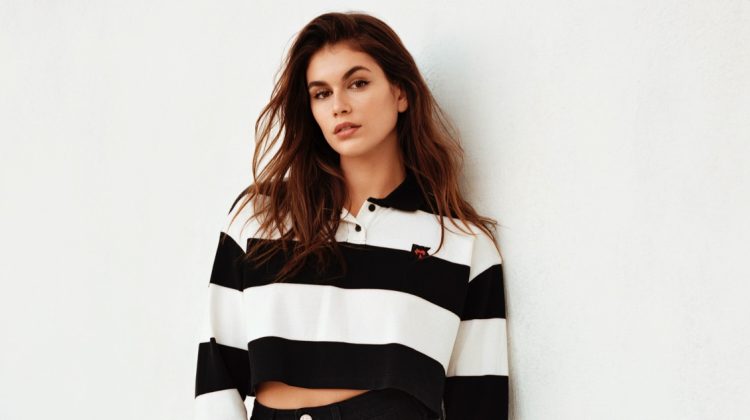
Kaia Gerber Exudes Cool in DKNY’s Heart ...
African safari fashion: what to pack & wear in kenya.
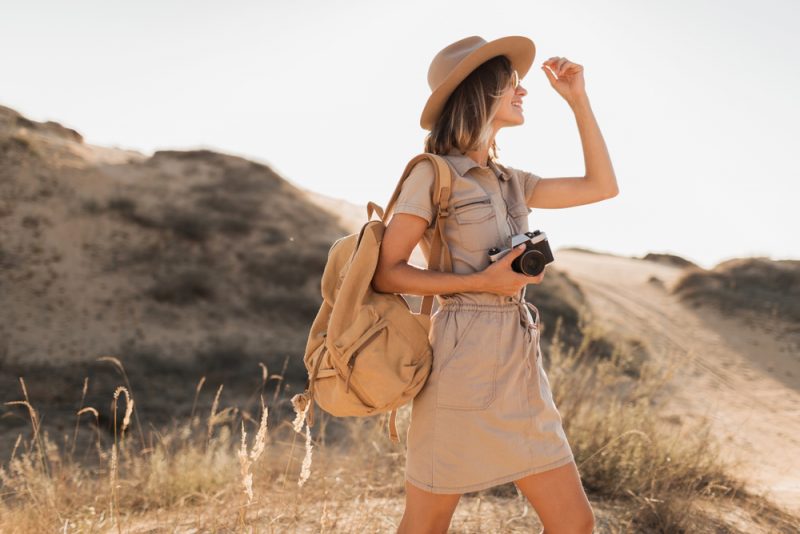
Over the years, Kenya has frequently ranked among the best safari destinations in Africa. Indeed, the country teems with everything there is to see and do for any adventure seeker out there. From the towering peaks of Mount Kenya to the rolling plains of the Masai Mara National Park , there’s no getting enough of an African safari in Kenya.
But as is the case with any travel destination, how you experience the best of Kenya heavily depends on adequate preparation. When planning to explore Kenya’s enchanting destinations, one of the critical things you’ll want to consider is the items to pack for a successful safari vacation in the country. And that especially applies to clothing.
While Kenya lies along the equatorial belt, the country isn’t hot all-year-round. So, while planning your vacation, you should understand the hottest, coldest, wettest, and driest months in the country. Doing so will go a long way in helping you determine the best clothing to pack.
Read on for more insights on how to pack right for a vacation in Kenya .
The Best Clothing for Wildlife Sightseeing Tours
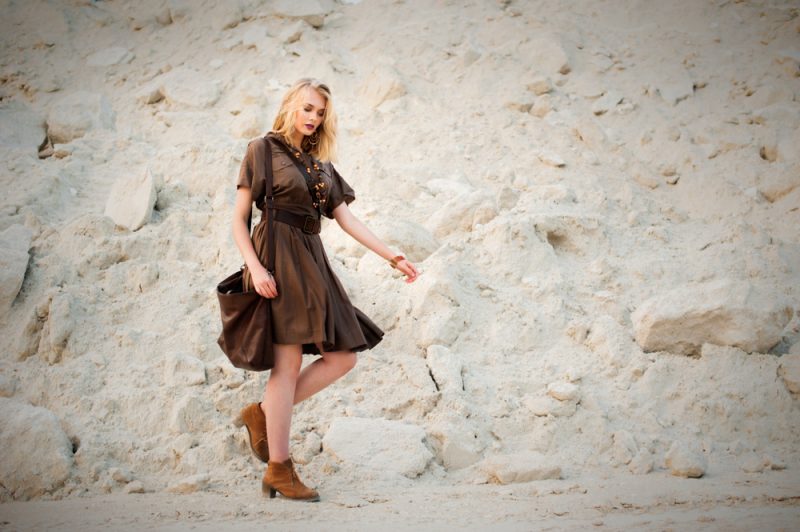
It’s almost impossible to imagine a Kenya vacation that doesn’t include excursions to some of the country’s major game parks. So, it’s likely that your itinerary is centered around game drives and wildlife sightseeing tours. And that brings us to the question – what’s the right clothing to wear for your bush safaris?
Travel experts recommend packing clothes of earth-toned or neutral colors. Bright-colored clothes are infamous for scaring wild animals, which is the last thing you want to do on your wildlife sightseeing tours.
Remember that while the Kenyan plains teem with numerous wildlife, the most iconic ones also happen to be the most difficult to sight. An example is the African leopard and cheetahs that will often hide during daylight.
James Gatheru, the Masai Mara tour director for Ajkenyasafaris.com , adds that earth-toned clothing offers excellent camouflage. This allows you to get remarkably close to animals that would have otherwise been easily spooked by bright-colored clothes.
However, there’s an exception. Black and dark blue colors tend to attract tsetse flies. So, as you shun bright clothes, also avoid dark blue and black.
A month-by-month Breakdown of The Best Clothes to Pack for a Kenyan Safari
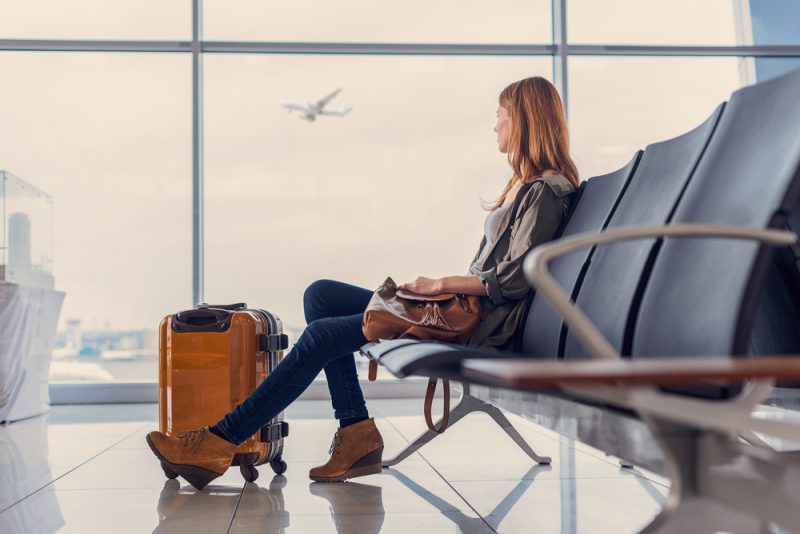
As we already mentioned, the weather patterns in Kenya can be somewhat unpredictable. Ordinarily, the country’s location along the equator should mean that conditions are warmer throughout the year. But that’s not always the case. Like most countries in Africa, Kenya experiences its highs and lows.
The following is a breakdown of Kenya’s weather patterns at different months of the year, and the best clothing to pack if your vacation falls within those periods;
- January to mid-March – Kenya is mostly hot and dry so that you would do with light clothing. However, the nights can get pretty cold, so factor in moderately warm clothing for that.
- Mid-march to late-June – It’s the season for the long rains, although the weather remains relatively warm throughout this duration. So, pack warm clothing and boots.
- Late-June to mid-October – The conditions are a bit hot, but the plains remain green and lush, making it the ideal time to go on wildlife sightseeing tours. It’s during this time that most tourists troop to the Mara to catch a glimpse of the Great Migration in Africa . However, temperatures tend to fluctuate a lot, especially in the evenings and at night. So, pack warm and light clothing.
- October to December – It’s the short rain season, and most parts of Kenya are reasonably cold and wet. Pack light and warm clothing if your trip falls within these months.

Best Clothing for Rainforest Tours
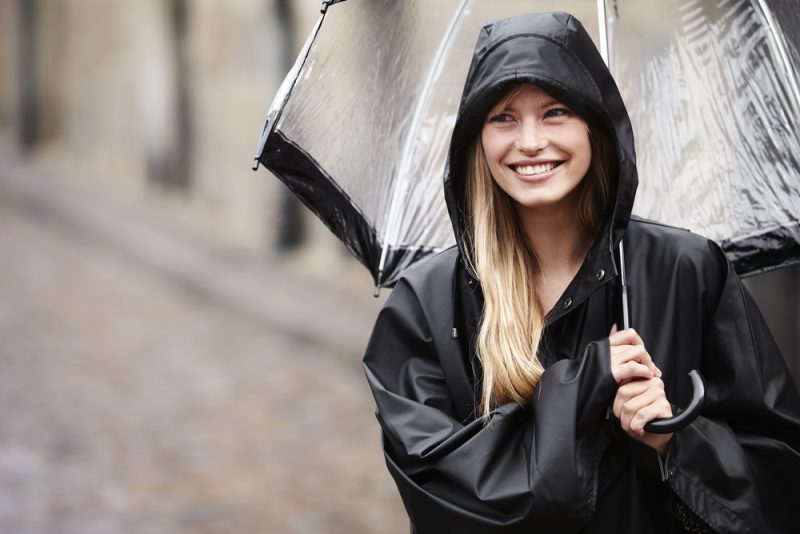
Most of the top tourist hotspots in Kenya lie in the country’s southern and southwestern plains, the Rift Valley floor, and along the coastline. That’s mostly due to the abundance of wildlife and the warmer conditions around these regions.
However, Kenya’s rainforests, such as the Kaka mega Rainforest, also abound with wildlife and lots of other adventure opportunities. As you may already know, rainforests are highly impenetrable, and the terrain can be quite unforgiving. Besides the frequent rainfalls, there are also poisonous serpents and pesky stingers to contend with.
The following are some of the best clothes to pack for a trip to Kenya’s rain forests;
- A pair of waterproof hiking boots;
- Long-sleeved shirts to keep the bugs and stingers away;
- Cotton pants;
- A pair of long-length socks;
- A rain jacket; and
Other essential items to pack for a rainforest hike include:
- Mosquito and bug repellants;
- Anti-itch and antihistamine creams; and
- A first-aid kit.
More Clothing and Other Items to Pack

Besides packing the right clothing for your game drives and forest hikes, there are plenty of other clothing and items you should add to your packing list. For instance, you should consider packing swimsuit and a pair of sunglasses if you’re planning trips to the country’s beaches. Lightweight shoes and sandals will be handy for use around the camp. You also won’t go wrong with semi-formal clothing, such as polo shirts and dresses, mainly when your tour includes romantic dinners at beachside resorts.
Most importantly, you must remember to adhere to the local dress customs. Avoid topless bathing at the beach or clothing that exposes your thighs and shoulders, especially if you’re visiting the villages.
And once you’ve taken care of your clothing needs, remember other crucial items to include in your packing list. A visa and passport are a must, as are vaccination documents. Also, you’ll need your travel itinerary, credit cards, travel insurance documents, and a camera to immortalize those rare moments.
And there goes our comprehensive guide on the best clothing to pack for your Kenya safari vacation. If you’re ever in doubt, consult your local tour agency for more insights on what to pack depending on the period you’ve scheduled your trip.
Recent Updates

Louis Vuitton Flight Mode Summer 2024: Travel in Luxury

Civil War Star Kirsten Dunst Takes the Spotlight for Flaunt

Mavi Spring 2024 Campaign: Denim with Coastal Vibes

Bantu Knot Hairstyles: The Top Ideas for 2024

Sabrina Carpenter Channels Retro Style in SKIMS Ad

Courrèges Spring 2024 Campaign: Floating into the Season
Leave a comment cancel reply.

Packing for Kenya Safari. The utmost Guide
What should i pack for kenya safari.
Packing for Kenya Safari checklist? Well, can I be honest with you; the first time I went on a safari to Masai Mara National Reserve . I wore official Leather Shoes, a blue T-shirt and Black jeans. It was disaster Management, to say the least. This brings us to, what should you exactly pack for a Kenya Safari to avoid such disasters in near future?
I wouldn’t want anyone else to repeat these silly simple mistakes. This is why I`m writing this to start with.
I will also highlight what you should never pack to a Safari in Kenya. The Dos and Don’ts.
Without much ado, shall will?
Clothing- Packing for Kenya Safari.
Obviously, you will need some clad to pack for your Kenya Safari. That is why you`re here and I am going to give you the ultimate guide Keep it locked until the end.
First off, let’s start with the Don’ts.
You should never wear official shoes while going on a Kenyan Safari as I did on my first time because by the time. I was returning to my camp my feet were aching and had blisters.
It was not only uncomfortable but also mortifying. The first thing after arriving in Nairobi I got myself this Reef Voyage Boots .
They have a super-soft foam footed, expertly crafted arch support, and heel cupping which make them not your average mules. They are obviously waterproof and have a sock liner which makes them breathable. Here is a list of all Favourable Safari Shoes .
I had mentioned I wore a blue T-shirt; you should never try dark colours especially and specifically blue.
This colour attracts Tsetse fly and you will be a target for the day. As you are aware. Tsetse fly causes Trypanosomiasis or Sleeping Sickness.
The disease may have declined over the years but it is fatal if left unattended.
Please Note: You should never rock those camouflage army garments as much as you may be tempted since it is forbidden in not only Kenya but also East Africa at large.
The authorities use this kind of clothing and we have to differentiate you and them.
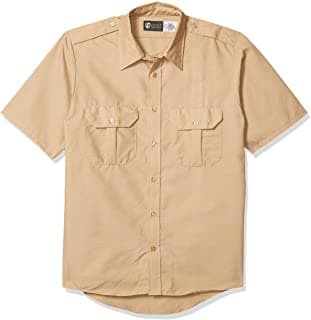
Well, instead wear these Khaki Shirts they complement well with the environment. Keep it beige, Grey.
Don’t pack bright colours for Kenya Safari or those flowery shirts. You can pack but keep such for the beach and not on a Safari.
Shorts/Trouser.
You can pack your jeans to Kenyan Safari only to wear at night after your game drive in the camp or when going to urban but keep it off the radar for Kenyan Safari.
For Game drives, you can do khaki shorts or trousers. Depending on Weather confirm with your Tour Agent the current weather before departure from your country.
Bags- Packing for Kenya Safari.
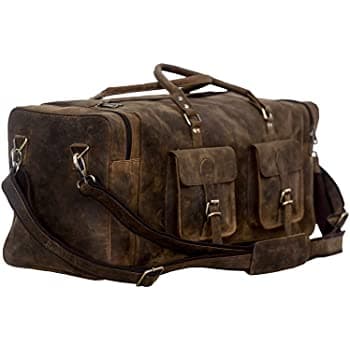
Is it possible to avoid Suite cases? Any bag which is not foldable or rigid square drains me no matter how many clothes am going to pack.
But since it seems impossible to stay away from them. Try to make sure your luggage doesn`t exceed 15kgs while packing for Kenya Safari.
The local craft has a maximum of 15kgs including your carry-on bags per person. Probably you’re asking what happens if you exceed the recommended weight?
Well, this will be up to the captain but again this is putting people in situations they shouldn`t be. Just pack Light.
A Backpack on your back and a duffel should be enough to take through your stay clothing. To avoid those square rigid Suit Cases this is the Best Option it is even more spacious and trendy.
Scorching sun Protections.
Africa, precisely Kenya is a sunny country and if you’re not used. You could go back home with nasty sunburns. You don`t want that right? Check out how to prevent the sun below.
Hat-Packing for Kenya Safari.

Incredible Kenya Adventures will give you a free branded Hat when you book with them. However, you can always get yours depending on your taste and liking.
Check them here . They come in handy and please don’t be lied to baseball caps will be of much help.
Sun Glasses.
When packing for Kenya Safari. Don’t forget your Sun Glasses even though you may not use them as much since you need to see clearly but they come in handy when the sun is having those reflective sunset rays. For the Sunglasses, you can try Carrera Sun Glasses .
Sun Screen Lotion .
You will need to pack a sunscreen lotion on your Kenya Safari. If you have sensitive skin you can check for SPF 50 . I use P.O Care Aloe Sun Lotion SPF 30. Face & Body and it is scentless.
Water Bottle .
Let me not lie to you, you will be thirsty here and probably you will need water all around. Please note that plastic was burned in Kenya and you`re not allowed to have those plastic water bottles inside the parks. Get yourself a recyclable Water Bottle. Only leave footprints.
Camera – Packing for Kenya Safari.

Packing for Kenya Safari? You can never afford to miss a camera. Actually, the term Safari go hand in hand with Photos.
The camera is for capturing those lasting forever memories. Imagine sitting on that verandah with your great-grandchildren showing them those kickass clicks you took while on a Safari? Wouldn’t that be incredible?
You can forget anything but not a camera. Remember it doesn`t have to be complicated you can use a simple Nikon D3500
Binoculars .
Zoom in until you can touch it. When packing for a Kenya Safari you should remember that, as much as you will be doing those game drives.
You`re not allowed to go out of the track. Meaning you will have to use a good lens and binoculars to aid you in bringing those desired images near you.
Binoculars will come in handy especially during wildebeest migration in Masai Mara.
Flash Light .
When you`re packing for Kenya Safari don`t forget this useful tool since some of the pathways in Camps are not well lit and it will be of help especially at night.
I use the USB rechargeable with magnetic battery and zoomable Super Bright LED Tactical Flashlight with Cob Sidelight, Waterproof.
You don’t need to worry about the battery problem. It only needs 3 hours to get it fully charged with Any USB port, providing up to 10 hours in low mode.
Power Bank .
Some of the camps do not have power all day and night. They will have it from 4:00 AM to around 8:00 AM then evening.
You may need to charge your phone, maybe you were streaming and the battery was drained.
A Solar Power bank will come in handy. This Solar Power Bank 30000 mAh is a wireless Portable Charger Solar Panel with External Battery which comes with a LED Flashlight. It is (Waterproof, Dustproof, Shockproof) and Compatible with iOS & Android.
Travel Adapter – Packing for Kenya Safari.
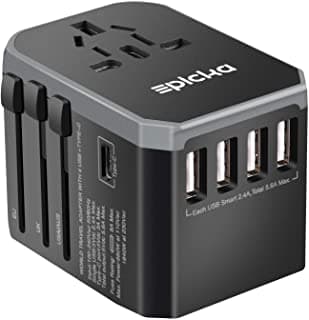
When packing for a Kenya Safari please note we use Type G Plugs in Kenya. The standard voltage is 240 V and the standard frequency is 50 Hz.
To be on the safe side, buy a travel Adapter to fit in not only in Kenya but also around the globe.
Do you need a Covid 19 Test to Enter Kenya?
All passengers arriving and exiting Kenya must have a PCR Covid-19 negative certificate for a test done 96 hours prior to travel.
If you don’t have such a test you will be refused to board or denied entry to Kenya.
Do you have any compelling questions or clarification regards to Packing for Kenya Safari? Hit me up in the comment section.
Disclaimer: This post contains affiliate links, any successful purchase will earn me a small commission at no extra cost to you.
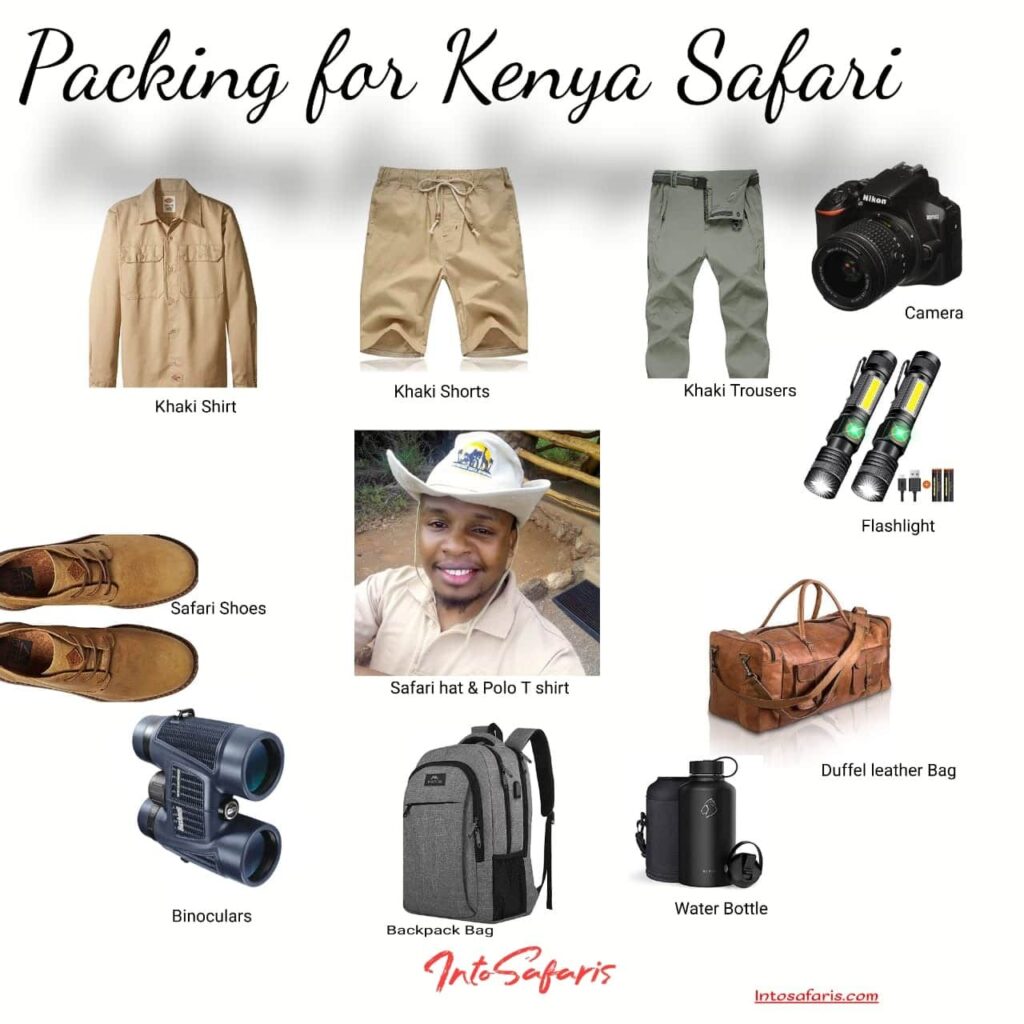
Also, Read-:
- How Much should you tip in Kenya? The Ultimate Guide (2021).
- 21 Days East Africa Safari Itinerary (2021)
- Walking Safari in Zambia. How to do it like an Expert.

Where is the Maasai Market Location in Nairobi?
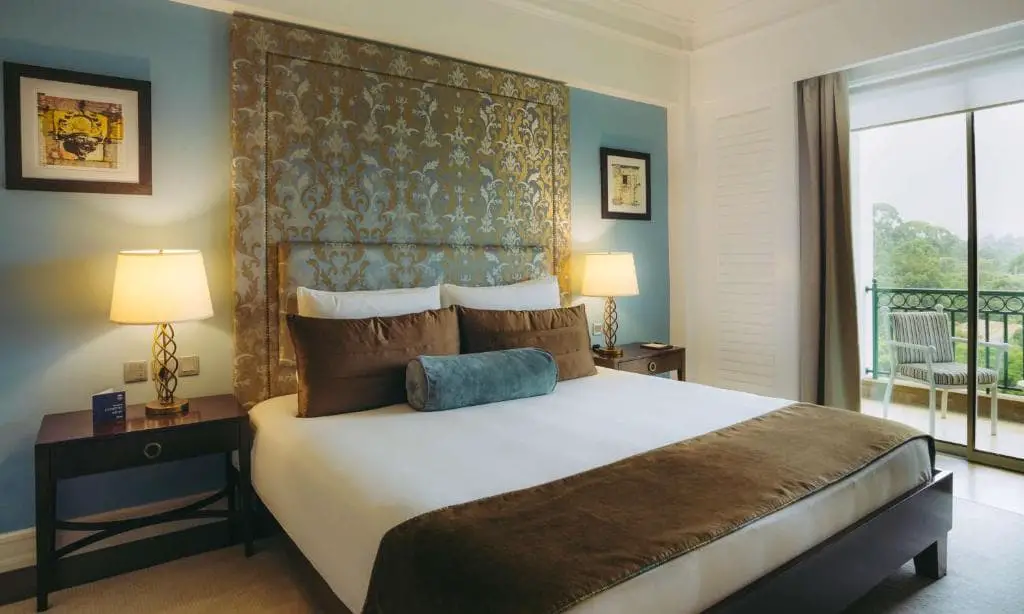
14 Hotels in Nairobi Westlands rating from luxury to Budget
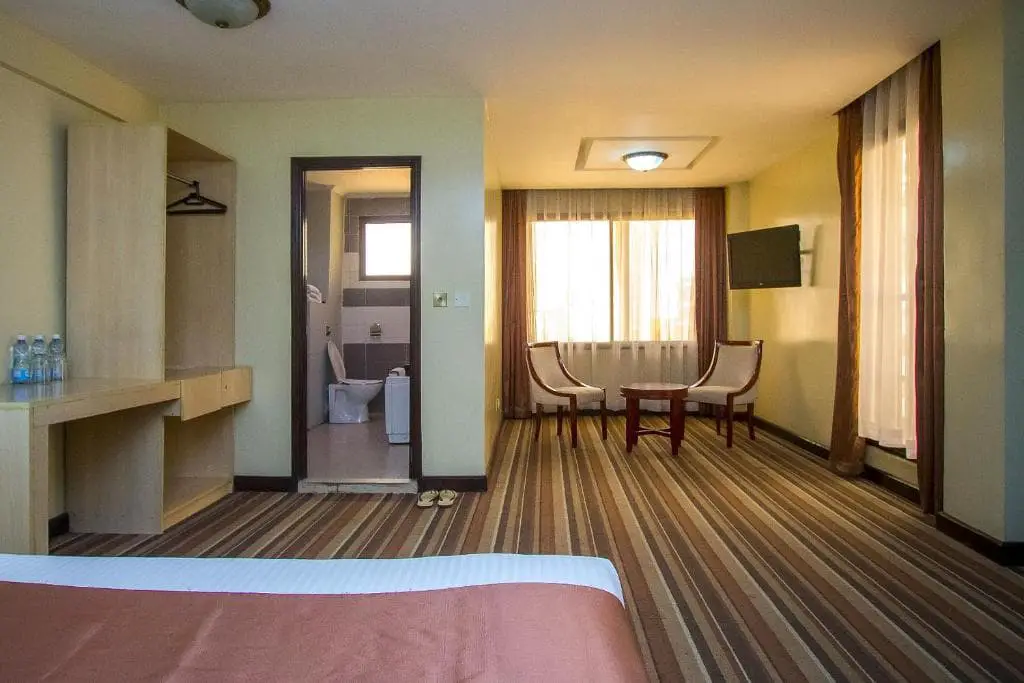
13 Budget Hotels in Nairobi CBD for only $50 B&B

How to use 48 Laws of Power when Travelling
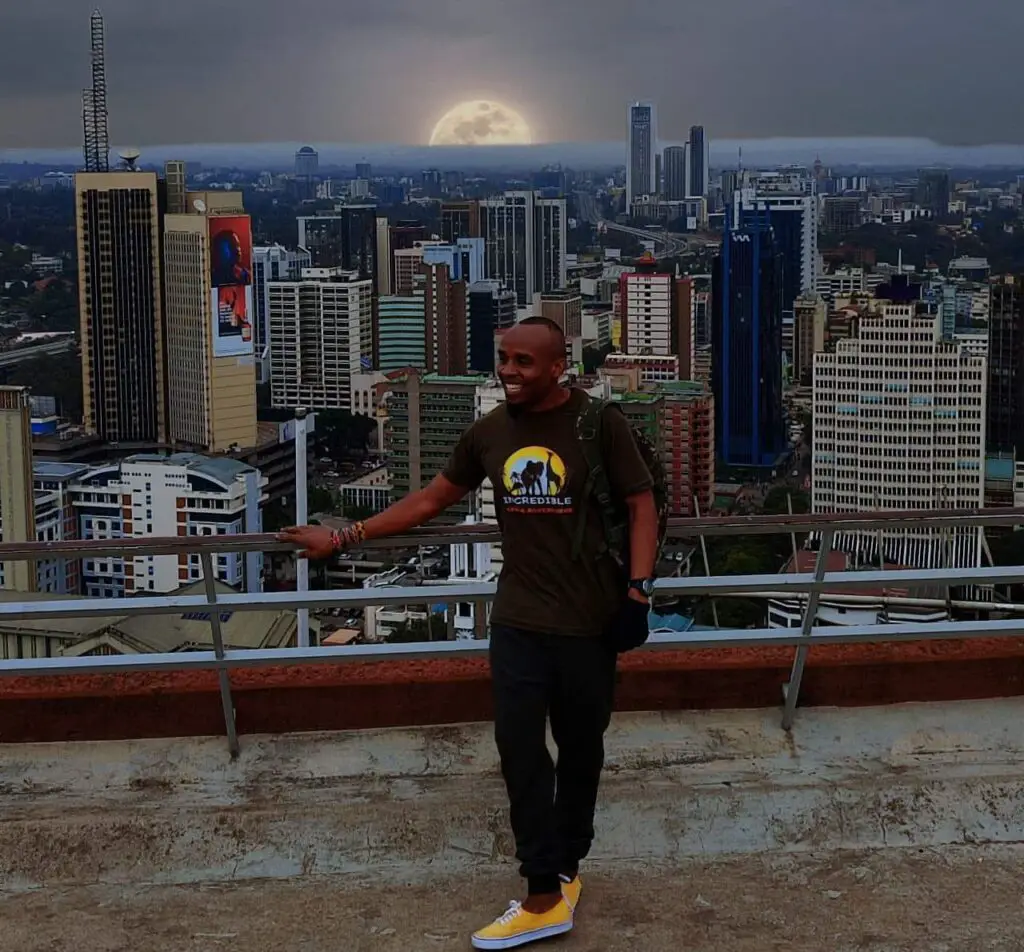
Nairobi City walk Tour with a certified Expert

How to lose weight fast naturally and permanently
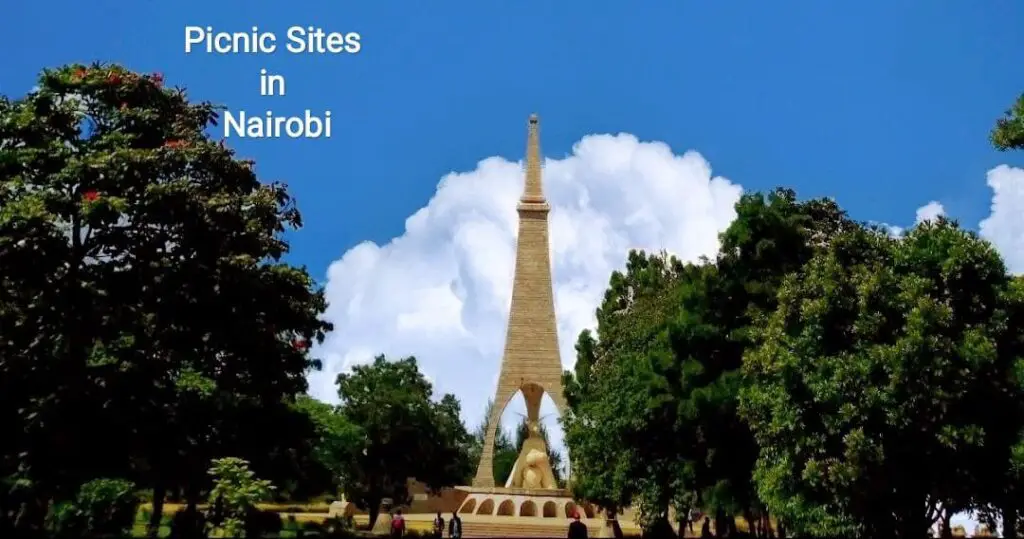
13 Epic Picnic sites in Nairobi you should visit
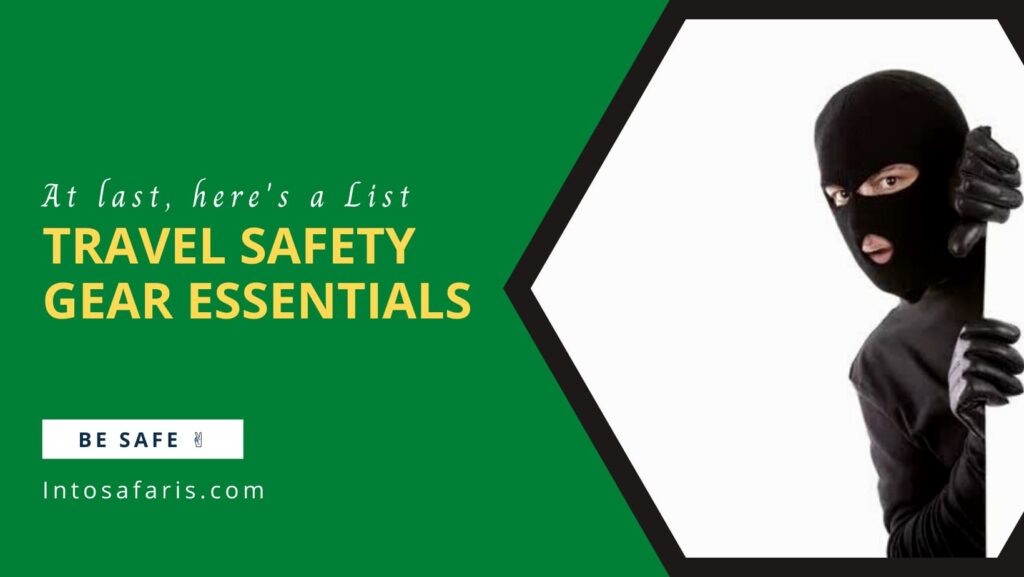
Travel safety gear Essentials that you need
Leave a comment cancel reply.
Your email address will not be published. Required fields are marked *
Save my name, email, and website in this browser for the next time I comment.
THREE WAYS TO PLAN AND BOOK YOUR SAFARI WITH AFRICANMECCA
TRAVEL & OPERATIONS OFFICES
- United States
- United Kingdom
- Travel Guide
- Country Info
- What To Pack And Wear
Learn More On AfricanMecca Safari Tier Ratings & Experiences
Clothing for men and women during your kenya safari, toiletries and basic medical kit recommendation for kenya, gadgets for your kenya travels, travel documents & money guidance for kenya, beachwear for kenya, kenya moral dress emphasis, laundry in kenya, safari luggage guidance for kenya, read more on baggage guidance & restrictions on flying safaris in africa, general packing suggestions for kenya, contact and talk to our safari experts today to kick-start your tour planning process.
Request Kenya Custom Or Tailor-Made Safari Pricing Based On Your Specific Travel Dates At Your Preferred Safari Tier Camp Or Lodge
Read More +
Safari prices for kenya.
Review individual itineraries and prices of our suggested Kenya safaris with the option of customizing your Africa tour based on your needs and preferences.
AFRICA TRIP IDEAS FOR KENYA
Review experiences available in Kenya from photo wildlife safari, horse and camel riding, walking, family to honeymoon beach vacation, dive, snorkel & fish etc.
PARKS & RESERVES IN KENYA
Review information on wildlife parks and reserves in Kenya i.e. Masai Mara, Amboseli, Samburu, Laikipia, Lewa, Tsavo, Chyulu, Nakuru, Meru and more.
ACCOMMODATIONS IN KENYA
Review information on safari lodges, camps, city hotels, coastal resorts in Kenya's pristine wilderness, cities, Swahili beach shores and idyllic islands.
BEST TIME TO VISIT KENYA
Review details on the best time to go to Kenya to visit its various wildlife outback, forests, rivers, islands, lakes, beaches, mountains and other wildernesses.
BEACHES & ISLANDS OF KENYA
Review Kenya's stunning Indian Ocean coast where the deep cobalt blue and turquoise waters gently wash up white sand beaches that create a tranquil setting.
KENYA COUNTRY PROFILE
Review country information and travel tips on Kenya i.e. geography, culture, history, climate, tipping guide, what to pack and wear, entry requirements and more.
CITY DAY TOURS FOR KENYA
Review city tour suggestions on full or half day options in Nairobi, Mombasa, Watamu, Lamu. Experiences can be customized around your vacation travels.
AFRICAN SAFARI PRICES
Check out safari prices and itineraries for parks and reserves in other African countries e.g. Tanzania, Uganda, Rwanda, Botswana, South Africa, Zambia etc. Namibia, Mozambique, Malawi and Zimbabwe are available on request.
AFRICANMECCA REVIEWS
On behalf of myself, my wife and my two adult daughters, I want to sincerely thank you and AfricanMecca Safaris for our fabulous recent safari to Amboseli National Park and Masai Mara National Reserve in Kenya.
Robert Schenkein - prVision Photography Studio - Colorado, United States
Dear Raza, The accommodations you recommended were superb. We loved them all -- Giraffe Manor, Wilderness Trails, Governor's Il Moran, Ngorongoro Crater Lodge and Mnemba Island Lodge.
Pat Bernard, Vice President, Global Channel Sales, Novell Corp - New Hampshire United States
Jambo Altaf and Raza! We are back on earth now after our fabulous honeymoon. This is to say THANK YOU so much for organising a week in Kenya that we will never forget.....!
Dr Krina Zondervan, Oxford University - United Kingdom
Jambo Raza!!! The safari trip was spectacular! Everything went off without a hitch. We loved the Masai Mara. The migration was awesome. You listened to what I wanted and delivered it perfectly.
Judi & Chaim Platt - Toronto, Canada
I cannot say enough about the quality of AfricanMecca. Their teams in Kenya and Tanzania were top notch. Raza, again thanks to you and your entire organization! We will be repeat customers.
Dan Kobick - Managing Director, PricewaterhouseCoopers - New York, United States
Jambo Raza, The Lake Nakuru outing was great! We saw lots of pelicans, some flamingos, both black and white rhino... We've already recommended a Kenya safari to friends and relatives. Thanks again
Scott Aaronson - Associate Professor, M.I.T - Boston, United States
This is to let you know my guests, The Bryant's, had a wonderful time on the trip Samburu, Masai Mara/Kenya, Chobe/Botswana & Victoria Falls/Zambia. Everything was perfect! Thank you..
Christine Milan - MT Carmel Travel - Connecticut, United States
East africa safari booking & tour holiday idea kenya, best safari planning ideas & trip experiences for kenya, 1. how to plan kenya safari trips (summary), 2. wildlife safari trip planning guide for kenya, 3. private & tailor-made safaris trip planning guide for kenya, 4. honeymoon safaris trip planning guide for kenya, 5. family safaris trip planning guide for kenya, 6. luxury safaris trip planning guide for kenya, 7. photo safaris trip planning guide for kenya, 8. cultural safaris trip planning guide for kenya, 9. primate safaris trip planning guide for kenya, 10. hike, trek & bush walk safaris trip planning guide for kenya, 11. birding safaris trip planning guide for kenya, 12. horseback riding safaris trip planning guide for kenya, 13. balloon safaris trip planning guide for kenya, 14. wedding safaris trip planning guide for kenya, 15. bush & beach safaris trip planning guide for kenya.
Kickstart Your Safari Planning
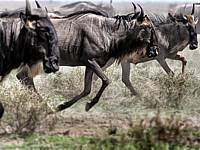
SAFARI PRICES
Find Kenya Safaris & Costs By Safari Tier Experiences
Safari Room Rate & Hotel Price Guide For Kenya
Kenya Reviews For Camps, Lodges, Beach & City Hotels
Park, Cities, Beach & Island Map Locations In Kenya
PHOTO GALLERY
Images & Pictures For Travel Destinations In Kenya
VIDEO GALLERY
Kenya Accommodation & Tour Destination Videos
ARE YOU PLANNING TO BOOK AN AFRICAN SAFARI TO KENYA?
Do You Need Knowledgeable, Experienced & Specialist Guidance For Your Travels In Kenya? Let Us Help Plan Your Trip Itinerary Correctly
EXPLORE MORE ON NATIONAL PARKS, CAMPS, LODGES, BEACHES & RESORTS IN KENYA
Safari tier ratings.
Understand Beach Tier Ratings & Experiences
KENYA PARKS & RESERVES
Kenya Beach & Island Planning Guide
KENYA LODGES & CAMPS
Beachfront Hotels & Resorts In Kenya
Top 10 Trip Reasons For Kenya Vacations & Holidays
HAVE YOU VISITED EASTERN AFRICA FOR A SAFARI IN KENYA?
Write A Travel Or Tourist Trip Review To Share Your Experiences
KENYA TRIP IDEAS
Safari Trip Ideas For Kenya
AFRICA SAFARI PRICES
Check Our Africa Travel Guide
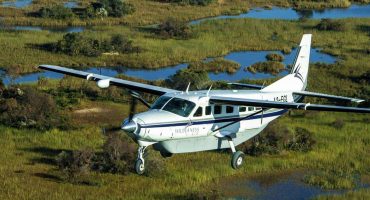
Baggage Guidance & Restrictions On Flying Safaris In Africa
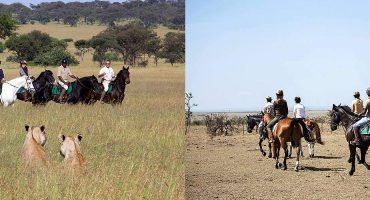
Masai Mara Horseback Riding Safari In Kenya With AfricanMecca

Times Square New York Hosts Kenya Tourism Board & Wilderness Safaris Meet Up
- Company Profile
- Why Travel With Us
- Our Safari & Tour Team
- Tier Ratings
- Awards & Press
- Customer Reviews
- SEARCH For Africa - Sustain & Conserve
- Travel Agent Support
- Jobs & Careers At AMS
- Newsletter Signup
- Contact Details
- Tanzania Travel Guide
- Kenya Travel Guide
- Uganda Travel Guide
- Rwanda Travel Guide
- Botswana Travel Guide
- South Africa Travel Guide
- Zambia Travel Guide
- Zanzibar Travel Guide
- Safari Trip Ideas
- Beach Trip Ideas
- Mountain Climb Trip Ideas
- Itinerary Trip Ideas
- Explore Park & Reserves
- Accommodations In Africa
- Read Trip Reviews
- View Photo Gallery
- View Video Gallery
- Read Our Blog
- Safari Prices & Itineraries
- Beach Prices & Itineraries
- Trek Prices & Itineraries
- City & Day Tours Prices
- Room Rate Guide
HOW TO CONTACT US
What to Wear in Kenya
Top style tips for kenya.
- Casual, comfortable clothes are the key when travelling in Kenya.
- During the day it is hot so our advice is to pack loose lightweight layers in natural fabrics such as linen, bamboo and cotton that will keep you cool and are easier to wash and dry.
- We suggest keeping to light, neutral colours, but not white – it will get dirty and dusty very quickly.
- Avoid blue or black clothing – the tsetse flies are drawn to these colours, and their bite can give you African Sleeping Sickness.
- It is very important to note that camouflage/ military clothing or print is not permitted .
- Remember your sunglasses and lots of sunscreen (we love the Riemann P20 range for 10 hour protection), and of course insect/mosquito repellent is really important.
- And don't forget a wide-brimmed safari hat to protect your face and neck.
- When you are on safari , the idea is to relax and enjoy your time under the African sky, and listen to the calls of the wild all around you! Dinner dress is therefore casual and comfortable.
- Long trousers and long-sleeved tops are best, to protect you from the harsh sun by day and mosquitoes at night .
- Nighttime and early morning game drives can be cold, so pack a warm hat, scarf, gloves and a fleece or jacket. You could try the SCOTTeVEST travel jacket because it has removable sleeves for warmer weather and allows you to carry your valuables with 23 secure internal pockets.
- If you are visiting the beaches pack your swimwear, but keep it strictly to the beach or pool area and cover up with a t-shirt or kaftan when walking around. You'll cause offence otherwise.
Shoes to pack for Kenya
- Take comfy practical footwear for daytime – the roads are dusty and uneven – and for trekking in the bush make sure you have sturdy, closed-in walking shoes or trainers. Try Hotter shoes , they are amazingly light and comfortable.
- We love Thorlos hiking socks too, they keep your feet dry and comfortable in all climates.
- Avoid going barefoot on beaches in Kenya; chigoe fleas can dig into your feet and cause boils and sores. You may like to wear dive shoes to protect your feet, and from the sea urchins too.
Clothing tips for women
- In Muslim areas including the coast , shorts and t-shirts can be frowned upon. Away from the tourist hotels and beaches, our advice is to wear trousers, or a knee length or longer skirt, and tops which cover your shoulders.
- Leave your valuables and expensive jewellery at home, you really won't need them.
- If you're dressing for dinner in the beach resorts, a few simple pieces of costume jewellery will dress up an outfit.
- A pashmina or sarong is a versatile item that you can use for sun protection or to ‘glam' up the simplest of outfits if you feel like a change.
Clothing tips for men
- When exploring Muslim areas including the coast, long trousers are a good idea.
- Evening dress codes in the beach hotels are likely to be ‘smart casual' – so long trousers with a shirt. On safari you'll want long trousers too, to protect from mosquitoes.
- If you're looking for versatile and stylish beachwear , try the Madda Fella range of shirts, shorts, polos and swimwear.
Pack for the weather
- If you plan to visit between March, April and May or October, November and December, prepare for afternoon rainstorms by taking a light raincoat.
- We love the Weather+ app – it gives an accurate 6 day forecast for day and night, which when you're planning from home is really helpful. You can keep all the places you've been to too – a nice way to remember your trip 🙂 Download for iPad/iPhone or Android
Regions of Kenya
- It does cool off at night – especially in Nairobi and the Highlands in July and August – so pack a pashmina , fleece or jumper.
- The mountains will be cooler because of the altitude so pack warmer layers and a waterproof jacket for this terrain. light wool is a good choice to wear against your skin as it naturally helps to regulate your body temperature . It keeps you warm in the cold, wicks away moisture when it's hot, and doesn't retain odours – even after prolonged wear.
Other things to pack
- A soft-sided rucksack is more practical than a hard suitcase for safari holidays – it's easier to fit into the small planes or transfer vehicles. Using packing cubes can help to keep your belongings tidy whilst compressing the volume too.
- Internal flights often have much lower baggage limits than your international carrier. Use an accurate luggage scale to ensure you keep within the weight allowance.
- Combine your rucksack with a sling bag or lightweight day sack for sightseeing trips and game drives.
- You may like to carry a solar powered charger too, to boost your battery when out and about – you don't want to miss that great photo opportunity!
- To use electrical gadgets you may need a travel adapter plug , and also a step down voltage converter if your devices are not designed for the local voltage (240V) .
- Don’t drink or even brush your teeth in tap water . Consider taking a LifeStraw Filtration Water Bottle .
- And don't forget to leave room for souvenirs on the way home! Look out for carvings , Maasai beaded jewellery or Kenyan coffee , to name a few.
Community photos from Kenya
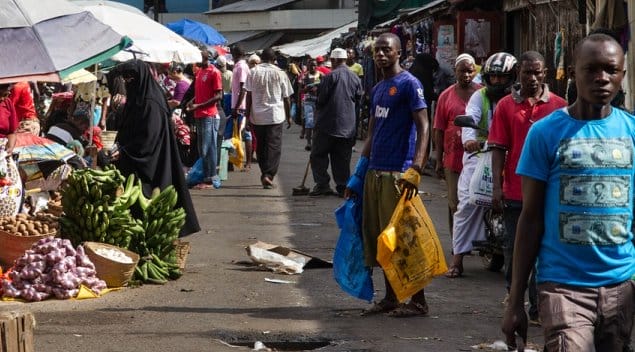
© Copyright 2019 | What To Wear On Vacation | All Rights Reserved

27 Top Kenya Packing List Items for 2024 + What to Wear & NOT to Bring

Kenya is a spectacular country with some of the best wildlife-watching in the world – where wild animals like elephants, lions, and giraffes roam free. Whether you are looking to go on a safari, hike Mount Kenya, learn about the culture from local tribes, or relax on a beach – Kenya has a lot to offer.
Keep on reading to find out what you need to pack for your Kenyan adventure! We have a section on what to wear in Kenya , what NOT to bring, and we answer many important FAQs. Have a great trip!
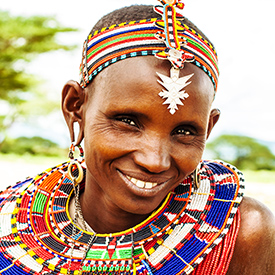
What to Pack for Kenya – 27 Essentials
1. universal power adapter.
In Kenya, the standard voltage is 240 volts. If you’re coming from North America, you will need to use a reliable universal power adapter. This one is awesome because it works in nearly every country and includes USB ports so you can charge multiple devices at once. It works in 100+ popular countries and even comes with a lifetime replacement guarantee so you can trust the quality.
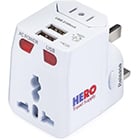
View on Amazon.com ➜
2. Hiking Boots
Kenya is full of hiking and adventure activities, so you won’t want to visit without a good pair of hiking boots. You’ll need a closed-toe option when you’re hiking or walking through the bush to protect your toes from scorpions, snakes, or anything else you wouldn’t want to expose your feet to!
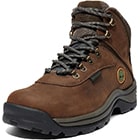
3. Virtual Private Network (VPN)
There is a censorship of freedom in Kenya, with many of your favorite websites being blocked or restricted. Not to mention, cybercrime in Africa has increased significantly in recent years and you should never take a risk with your private information. To stop hackers in their tracks, connect to a reliable VPN like NordVPN . This will also be a layer of defense when connecting to WiFi in public places like airports, restaurants, and hotels. It will protect your passwords, credit card numbers, and sensitive information, while also helping you to bypass censored servers.

View NordVPN.com Options ➜
4. Neck Wallet
Pickpocketing and petty theft are pretty common in major cities like Nairobi and Mombasa. It’s best to keep your essentials out of sight and well-organized. Protect your cash, credit cards, passport, and smartphone by securing them in a neck wallet like this one which can be worn underneath your clothes. We love this one because it’s big enough to hold your essentials, but small enough to be inconspicuous. It even has RFID-blocking material to stop tech-savvy thieves from scanning your cards.

5. Binoculars
Binoculars are a brilliant item to bring if you plan on going on safari. Many animals, like leopards and lions, tend to keep their distance which makes them difficult to spot without a good lens. This is part of the reason you came to Africa, right?! Don’t miss out on the fantastic wildlife that Kenya is known for by forgetting to bring binoculars.
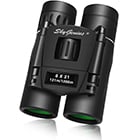
6. Travel Insurance for Kenya
Though Kenya does not mandate travel insurance, it is strongly recommended to avoid paying out-of-pocket for delays, theft, cancellations, medivacs, and hospital bills. We always hope for the best, but you should prepare for the worst when exploring a foreign place.
Faye is our go-to provider because they’re modernizing insurance with quick reimbursements through their mobile app. They even have plans for extreme sports and ‘trip cancellation for any reason!’

Get a quote in less than 60 seconds with Faye ➜
7. Jet Lag Relief
A flight to Kenya is far, no matter where you’re coming from! Instead of dragging your feet with layovers and drastic time changes, use these natural jet lag relief supplements to prevent exhaustion. They’re made using botanicals like chamomile to keep you feeling rested, rather than intense stimulants like caffeine that other products use. We love them!
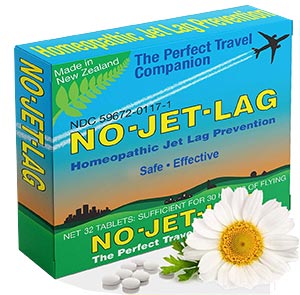
8. Packing Cubes
To help yourself stay organized and avoid overpacking, be sure to use packing cubes. These can easily fit in your hand luggage and help keep your clothing wrinkle-free and in order. This set comes in a variety of fun colors and includes separate bags for your shoes and dirty clothes. Get a different color for each family member and things will never go missing again!
Available on HeroTravelSupply.com with an exclusive 15% discount using the coupon code “HERO”.

Or view on Amazon.com ➜
9. Water Bottle with Built-in Filter
Under the hot African sun, you’ll need to stay hydrated by always carrying a water bottle with you. Unfortunately, tap water in Kenya is not safe to drink and water-borne illness is a common thing. So instead of buying endless plastic water bottles, opt for a handy Grayl reusable water bottle that comes with a filter to prevent you from ingesting germs. It filters out harmful bacteria, viruses like Hepatitis A, sediment, pesticides, microplastics, and more. It’s not worth risking your health and this one is a literal lifesaver.
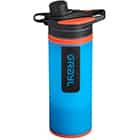
10. Quick-Dry Travel Towel
Useful in endless scenarios, you won’t want to travel without a microfiber travel towel. This one dries incredibly quickly, which is perfect if you need to toss it back in your daypack after a day at the beach, hiking, or on safari. This is also useful if your accommodation doesn’t provide a towel or provides one that isn’t up to your cleanliness standards.
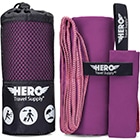
11. Insect-Repellent Wristbands
Malaria is prevalent in Kenya, so it is very important that you always wear mosquito repellent and take the proper precautions. In addition to wearing bug spray, these insect-repellent bracelets offer a great and easy layer of added protection and last up to 300 hours. They’re safe for kids and way better than respraying toxic fumes all day!
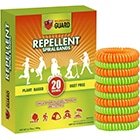
12. Cooling Towel
This item is a magical treat! Perfect for a safari or any outdoor adventure, a cooling towel is easy to bring along and will help keep you cool. They’re almost too good to be true. All you do is wet the towel, wring out any excess water, and it instantly becomes 20-30 degrees cooler than the air temperature. They’re chemical-free and we never visit warm destinations without them!
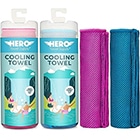
13. Discounted Tickets on Kenyan Tours
The wildlife in Kenya is unmatched! We use Get Your Guide to book the best excursions around the world since they have flexible cancelation and provide the most authentic experiences.
While in Kenya, be sure to visit the Elephant Orphanage in Nairobi and take a legit African safari . One of our favorite things to do was to snorkel in crystal clear water and spot dolphins near Wasini Island . We also recommend venturing out for day trips and enjoying the legendary nightlife of Kenya; it is something to behold!

See all Kenya attractions at GetYourGuide.com ➜
14. Travel Flashlight
In Kenya, the power supply is unreliable and often goes out without notice. Unless your accommodation has a generator, it is a good idea to bring a flashlight for unexpected power outages. This will also come in handy when you’re on safari and need a light to guide the way in the evenings. You may also want a headlamp for finding the bathroom at night and being hands-free!
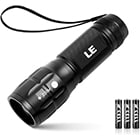
15. Lipstick-Sized Portable Charger
In Kenya, you’re likely to use your phone and camera throughout the day, whether for photos, navigation, music, or anything else. You won’t want to worry about your devices running out of battery at an inconvenient time, and many of your excursions could be out in the middle of nowhere (with no outlets in sight!) So toss this small portable charger in your backpack and use your electronics all day long.

16. Windproof Travel Umbrella
As an obvious but important one – you’ll want to pack a travel umbrella, especially if you’re visiting Kenya during the wet season. A travel umbrella that’s compact yet durable is essential. This is the best travel umbrella I’ve come across. I love how well-made it feels and the zippable travel case it comes in.
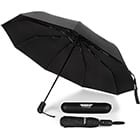
17. Electrolytes
Depending on when you visit, Kenya can get HOT. You’re sure to be spending a lot of time under the sun, whether you’re hiking, exploring the cities, or on safari. Be sure to remain properly hydrated by bringing electrolyte packets to add to your drinking water. These will particularly come in handy if you get sick while traveling. In emergency situations, they are also legitimate lifesavers.

18. Daypack
For all your safaris and excursions, it’s very wise to have a daypack. This one is very popular among travelers because it’s compact, lightweight, and durable. Perfect for carrying anything you might need throughout the day (phones, wallets, snacks, an umbrella, binoculars, etc). You won’t want to visit Kenya without one!
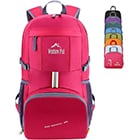
19. TSA-Approved Luggage Locks
After having an item stolen out of our checked luggage, we always secure our bags with luggage locks. These are TSA-approved so you won’t have to worry about causing delays at security, but we also use these for crowded places on our backpacks, on purses on public transit in big cities, and even lockers.
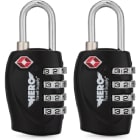
20. Universal Waterproof Phone Pouch
Kenya has dozens of gorgeous islands, beaches, and pristine coastline. As you swim with dolphins, snorkel, boat, and swim – this waterproof phone case will be the ideal companion to your water sports adventures. It ensures your lifeline is protected from moisture, sand, debris, and scratches. You can even film beautiful underwater videos (with sound!) and not have to purchase a separate camera or GoPro. Don’t forget to attach the flotation strap so it doesn’t sink or become hard to retrieve!
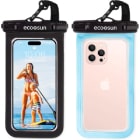
21. Packable “Just in Case” Bag
We all succumb to the inevitable shopping as we travel the world. Since there is never enough room in your suitcase, bring this “just in case” bag for those unforeseen purchases, gifts, and authentic Kenyan goods you’ll want to snag! Like Maasai Beads, Kitengela Glass, bowls, blankets, handmade art, spices, and more. This duffel is light as a feather and counts as your personal item for the flight home, which means no carry-on fees – yahoo!
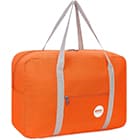
22. Activated Charcoal
With plenty of local and regional delicacies to try in Kenya, there’s no doubt you’ll enjoy experiencing a variety of new cuisines. Prevent getting food poisoning or having an upset stomach from eating unfamiliar foods by taking activated charcoal caps, which will quickly absorb and expel the unwelcome toxins in your system.

23. Sturdy Sandals
Whether you’re exploring Mombasa or chilling at the beach, you’re likely to live in a sturdy pair of sandals during your time in Kenya. The hot weather means sandals are in order, and a lot of time spent on your feet means you’ll need something durable and reliable. These are the perfect pair for any trip to Africa.
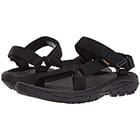
24. Deodorant Wipes
You can never go wrong tossing a pack of deodorant wipes in your purse or daypack while you explore all that Kenya has to offer. Don’t try to do a sink-shower where you’re spritzing your pits with water (been there!) Lots of time spent traveling around under the hot sun can leave you in desperate need of a quick refresh, and these wipes will do the trick!
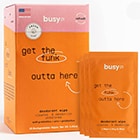
25. Hanging Toiletry Bag
You never know what kind of storage you’ll get in Africa. It could be a luxury resort but if you’re camping or staying in a smaller hotel, the lack of countertop space can be difficult. We use a hanging toiletry bag that hooks on any door or shower pole to create a shelf-like system in your bathroom. Vertically optimize your life and maintain your sanity since it has 4 giant pockets that hold all of your skincare, haircare, makeup, face towels, and hygiene products.
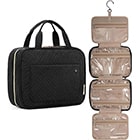
26. Travel Toilet Paper
Bathroom situations in Africa are unpredictable. It may not be what you’re used to since public areas can range from a Western toilet to a hole in the ground (sometimes known as a squat toilet). These disposable wipes are perfect for handling your business on-the-go. If you’re camping or need to make an emergency run to a bush, you don’t have to worry about the TP being harmful to mama nature.
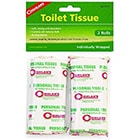
27. Female Urination Device
Along the same lines, women should consider bringing a female urination device. While this may sound a little… eh hem, unique… it’s really useful for being able to pee while standing up (the liberty that men enjoy every day!) You may not need to worry about your hotel where you’ll have a reliable bathroom, but it’s exploring towns, beach days, hiking, safari excursions, and everything in between that you’ll need to be prepared for.
Other Kenya Packing List Items to Bring
- Luggage Lock
- Travel Backpack
- Compression Socks
- Waterproof Shoe Bags
- Toiletry Bag
- Travel Bottles
- Flotation Straps
- Contact Solution
- Nail Clippers
- Laundry Bag
- First Aid Kit
- Clothesline
- Bug Repellent Wipes
- Mosquito Net
- Hand Sanitizer Wipes
- Facial Wipes
- Cold & Flu Caplets
- Travel Scarf
- Microfiber Towel
- Cooling Towel
- Pain Killers
- Motion Sickness Patches
- Memory Cards
- Headphone Splitter
- Menstrual Cup
- Travel Solar Panel
- Swiss Army Knife
- Diarrhea Relief
What NOT to Take to Kenya
1. don’t bring valuables.
There is a lot of poverty in Kenya and theft crimes are common. Be smart by keeping your valuables at home.
2. DON’T CARRY a lot of cash
Cities like Nairobi and Mombasa will have ATMs available and hotels and restaurants will take Visa or Master Card. Remember to protect your cash in a money belt.
3. DON’T TAKE an expensive cellphone
Tourists are strongly recommended to bring a simple burner phone.
4. DON’T PACK bright-colored clothing
If you are going on safari. Bright colors will attract insects and wild animals. Stick with neutrals.
5. DON’T WEAR camouflage
It is illegal to wear.
6. DONT’T BRING heels
Roads are unpaved and there are few places where you would ever need to wear them while visiting.
Packing for the Seasons in Kenya
Dry season – june, july, august, september, and october.
These months are much cooler where the temperature is around 73°F. There is very little rain and humidity during these months which makes it a great time to visit the beaches. Things to pack while visiting during the dry season include sandals, shorts, capris, teeshirts, and tanks. Don’t pack too much warm clothing, you will be fine with just 1-2 pairs of pants and long-sleeved shirts or light sweaters. Also, don’t forget a hat, sunglasses, and sunscreen. Temperatures average between 73°F to 82°F (23°C to 28°C)
WET SEASON – November, December, January, February, March, April, and May
During these months the rain will vary. November and December will receive short periods of rainfall and usually occurs in the late afternoon or evening. January and February will actually receive less rain but March-May are the rainiest months and downpours can be expected. During these months the average temperature ranges between 75°F-86°F. Make sure to pack light, breathable clothing. Shorts and dry fit teeshirts work best. Also, bring a travel-sized umbrella and a light rain jacket or a rain poncho. Waterproof shoes or plastic sandals work well for footwear. Temperatures average between 75°F to 81°F (24°C to 27°C)
FAQs About Travel in Kenya
1. is it safe to visit kenya.
Compared to other African countries, Kenya is relatively safe. However, you should check with your government’s national travel advisory before planning a trip. Exercise street smarts in the day and avoid going out at night.
2. Do I need a visa?
While there are some countries whose nationals don’t require a visa to enter Kenya, if you are coming from the US, Canada, Europe, Australia, and many non-African countries, you will need a visa. Check with the Kenya High Commission for the complete list of countries that are visa exempt.
3. Do I need vaccinations?
Common vaccinations required for a trip to Kenya are hepatitis A, hepatitis B, rabies and typhoid, diphtheria, polio, measles, and yellow fever. It is best to consult with a doctor for vaccinations that you will need specific to your trip.
4. Can I drink tap water?
No, you can only drink boiled or bottled water.
5. Is English spoken in Kenya?
Yes, Kenya’s two official languages are English and Swahili.
6. What currency is used in Kenya?
The Kenyan shilling is used as currency although, on safari, many national parks will also take USD.
7. How much money should I bring?
Kenya is a fairly expensive country. On a low budget, expect to pay around $100/day. For Midrange to high budgets, $100-$250 a day is the norm.
8. Where are the best places to see wildlife?
In Kenya, there is an abundance of wildlife. Some of the best places include Amboseli, Lake Nakuru, Tsavo West, Maasai Mara, and Nairobi National Park.
9. What is the Big Five?
The Big Five refers to the most popular as well as some of the most challenging animals to spot on safari. These animals include elephants, lions, buffalo, rhinos, and leopards.
10. What else is there to do in Kenya besides safari?
Hike Mount Kenya, have breakfast with giraffes at Giraffe Manor, relax on Kenya’s beautiful coastal sandy beaches, scuba dive or snorkel with abundant sea life, visit coffee and tea plantations, and try out the local cuisine!

Asher Fergusson
What to pack and how to dress appropriately in Kenya
Recently updated on August 14th, 2023 at 03:32 pm
From the savannah to the sea to the mountains, Kenya is an incredible country with all kinds of landscapes, weather and colourful cultures. With everything from the local customs to the climate and your trip activities to consider, it can be tough to know what to pack and how to dress in Kenya. To help you prepare for your trip, we’ve put together a guide on what to pack for Kenya and how to dress appropriately to respect the local culture and get the most out of your dream trip to Kenya .
What to wear in Kenya
When visiting Kenya, it’s important to respect the culture and follow the local customs and dress codes. The general rule on how to dress in Kenya is to wear conservative clothing. That means long, loose-fitting clothing that covers your shoulders, knees, midriff, chest and back. This dress code should be followed everywhere including cities like Nairobi, however, you should aim to dress more modestly and wear longer clothing in more conservative rural areas.
While long clothing might sound extra hot, it’s actually more comfortable as it protects you from the sun and insects like mosquitoes. You’ll also feel more comfortable when you blend in with the locals and they’ll appreciate your efforts to respect their culture.
RELATED CONTENT: How to dress appropriately when travelling to Africa and the Middle East

You also need to consider the weather and your activities when thinking about what to wear in Kenya. It’ll likely be hot, although it can get quite chilly in the early mornings and evenings on safari game drives and in the mountains, so bring versatile layers that you can peel on and off. Go for t-shirts, long-sleeved tops, long skirts and dresses, light trousers, sweaters and jackets.
A scarf is a handy item, as you can use it to stay warm or for extra modesty. You can also dip it in water and wrap around your neck to cool down in the heat. A rain poncho or a waterproof jacket is also an essential item.
What shoes to pack for Kenya
You’ll need a comfortable pair of walking shoes or runners. If you plan to go hiking in Kenya’s beautiful mountains, bring a sturdy pair of hiking boots and thick socks. You should also pack some sandals or flip-flops for days by the pool or beach.
RELATED CONTENT: The 7 best experiences you can enjoy in Kenya with Trafalgar

Women – How to dress in Kenya
Women should wear long, loose shirts that cover the shoulders, chest, midriff and back, and long-loose skirts, dresses or trousers that cover the knees. Avoid wearing tank tops, shorts, crop tops, short skirts or anything too form-fitting. You should also dress even more modestly if you want to visit religious sites like churches, mosques and temples.
GET INSPIRED BY: Wonders of Kenya
Men – How to dress in Kenya
Men should wear long trousers and t-shirts or button-down shirts with long sleeves that cover at least your shoulders. You should also aim to dress more modestly at religious sites, including long trousers and shirts. Shorts aren’t commonly worn by men, but if you do want to bring a pair of shorts for long coach rides or game drives, make sure they cover the knee.

What to pack for a Kenya safari
If you’re going on safari in Kenya, forget the clichés like safari helmets and full-on khaki. it’s recommended to wear lightweight layers in neutral colours to blend in with the bush and improve your chances of wildlife sightings.
Avoid bright colours like white and red and dark colours like black and blue as this can attract Tsetse flies . Keep it simple with layered clothing that you don’t mind getting dirty and bring a woolly hat and gloves for those chilly morning game drives.
RELATED CONTENT: In conversation with: Dedan, a Maasai safari guide for Trafalgar

What to wear at the beach in Kenya
Kenya has some gorgeous beaches that are perfect for swimming, snorkelling or simply lounging on the sand. While it’s fine to wear your swimsuit at the beach, you should always cover up before you leave the beach and never walk around in swimwear. Remember, topless bathing is not allowed anywhere.
You might also like to bring a nicer outfit for dinners at your beachside resorts or nights out in Nairobi, such as long dresses and trousers and polo shirts.
GET INSPIRED BY: African Safari Adventure with Zanzibar Island Escape

Other essentials to pack for Kenya
- Waterproof day bag – with lots of secure pockets.
- Sun protection – hat, sunglasses and lots of high SPF sunscreen.
- Reusable water bottle – you can refill it with filtered water at most hotels and lodges.
- Toiletries – at your discretion, but aim to use reusable travel bottles or solid toiletries like bar shampoos and soaps. Remember to bring lip balm and moisturiser to protect against that dry Kenyan heat.
- Small medical kit – strong insect repellent, hand sanitiser, painkillers, electrolytes, antiseptic ointment and bandaids, travel sickness tablets, eye drops, personal medications. Be sure to consult your doctor before your trip for Kenya health advice on vaccinations and taking malaria prophylaxis.
RELATED CONTENT: Kenyan food: 9 dishes that are are a journey into the country’s soul
- Head torch – handy for getting around camps at night.
- Binoculars – for better wildlife viewing.
- Eye mask and ear plugs – for the light sleepers.
- Electronics – smartphone, camera, extra memory cards, batteries and chargers. You might also like to bring an e-reader or headphones, portable charger and a power strip. You’ll also need waterproof cases for all your valuables.
- Travel adaptor – for Kenya, you’ll need plug type G, which has three rectangular pins in a triangular pattern.
- Swahili phrasebook – learn a few local phrases and enrich your Kenyan adventure.
- Cash and cards – it’s handy to have some local cash (Kenyan shilling) , along with US dollars or UK pounds. You can also bring debit and credit cards to use at ATMs and some hotels and restaurants.
RELATED CONTENT: Useful Swahili words and phrases to learn before your trip to Kenya

What not to pack for Kenya
Plastic bags.
All kinds of plastic bags are banned in Kenya . Do not bring them into Kenya or purchase them while in the country as there are heavy fines. These include plastic grocery bags, plastic packaging and plastic ziploc bags. When going through the airport, you can put your toiletries in any clear bag (like a clear, waterproof toiletry bag).
Military-style clothes
You should avoid wearing camo or military-style clothing anywhere in Africa, as you may be questioned about your intentions and why you look like you’re posing as a military officer. The police may go as far as arresting anyone dressed in this type of clothing, so it’s best to leave it at home.
RELATED CONTENT: 7 books to read to get you inspired for your trip to Kenya

Expensive items
Don’t bring anything you couldn’t bear to lose! It’s also not advisable to wear flashy jewellery or branded clothing, as this makes you stand out to pickpockets.
Large amounts of cash
While it’s handy to bring some local cash, you don’t need to bring enough for your whole trip and risk losing it. There are plenty of ATMs around the country where you can withdraw the local currency using Visa and Mastercard.
Are you dreaming of a trip to Kenya? What will you pack for your Kenya trip? Let us know in the comments below!
Want to hear more from us?
Sign up to receive inspiring travel articles, offers & news
" * " indicates required fields
Privacy Overview
Sign up for our emails.

What to Pack for a Masai Mara or Kenya Safari
Packing for a trip to Africa can be a daunting experience even for an experienced traveler, let alone a first time Safari tourist. Packing for a Kenya Safari or for that matter packing for a Masai Mara trip is rightly so more than a simple affair, with careful consideration required for the weather, comfort, local culture and alot more. See our Kenya Safari packing check list below
What to Pack
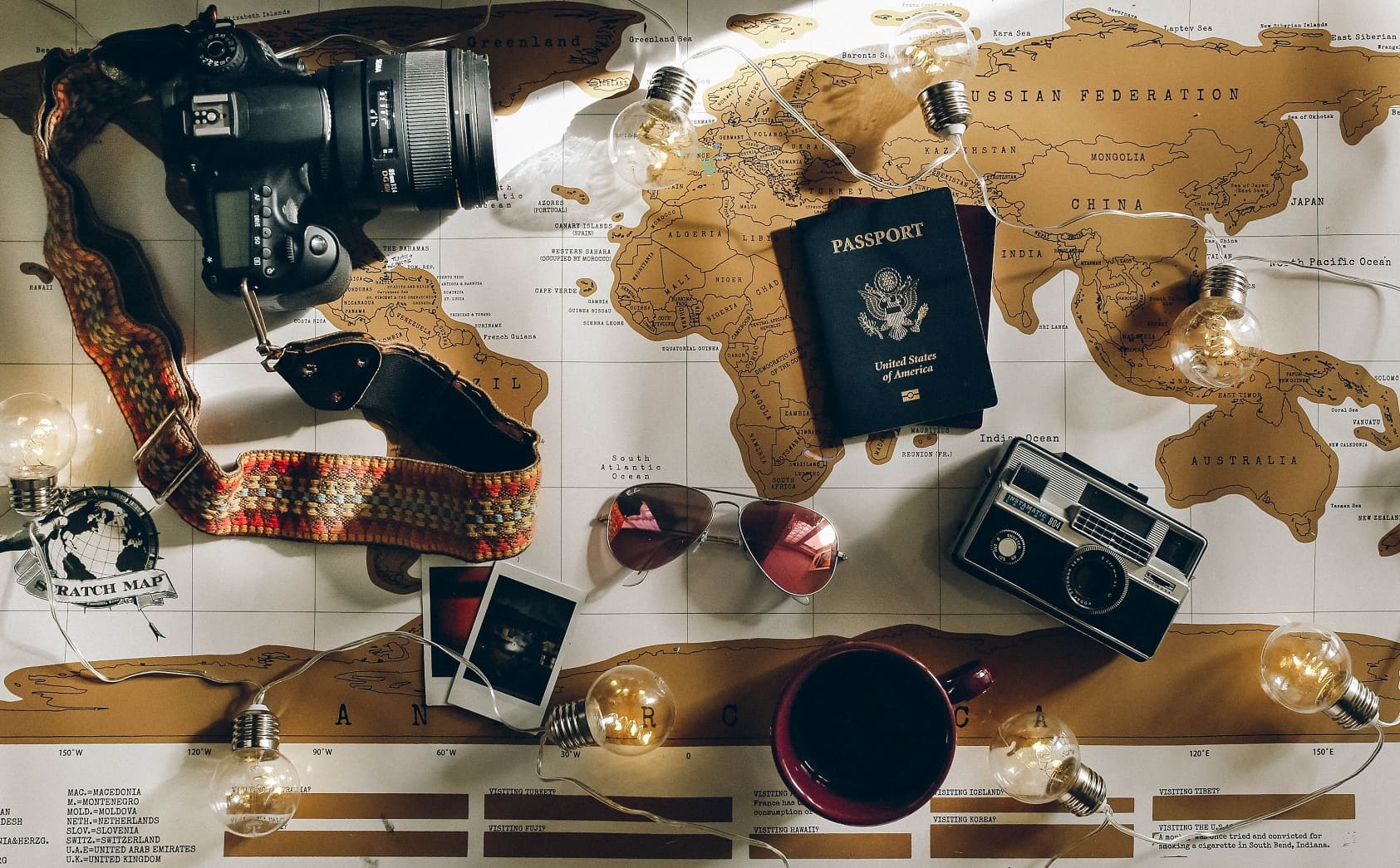
This packing check list is a general guide on what to take on your Kenya safari. Please ensure you pack minimally and use layers, as local airlines flying to various parks within the country have a typical luggage restriction of 15 kilos allowance per person (including carry-on bags). Soft sided bags or folding duffel bags are recommended. While we list everything down below with descriptions, your packing list ought to include the following essentials: Clothing suitable for Safaris, Shoes, Hat, Sun Protection, Insect repellant, vital Medication and Cameras or Photography equipment among other items. Not to forget Travel Documents, prior to start of your safari check for your Passport, Health cards (vaccination certificates as required), Airline tickets, Credit cards and Insurance papers. Ensure all the documents are inorder and up-to-date. Your passport must have at least 2 blank pages and six months of validity from the proposed date of exit from Kenya. Note: Kenya aims to eliminate plastic bag usage for environmental reasons and these have been banned and their use is illegal.
The ideal clothes to pack for your safari are casual in nature, loose fitting and lightweight, so as to keep you cool and dry. For colours, pick neutral Pastel shades over brighter colours for optimum suitability for the wilderness. Khaki and Forest Green colours are an all time safari favourite and most recommended. Please note that camouflaged, military~pattern clothes may be considered unlawful in East Africa as they are worn by the local forces so best to avoid. Make sure to pack a fleece, cardigan or light jacket for the cool early mornings during game drives. When packing, keep in mind that most lodges and camps provide laundry services. Below is a basic packing list of the essential clothing you may want to bring: 01 short sleeve casual shirt, 02 khaki long sleeve shirts, 01 Wind cheater or light jacket or Fleece jacket, 01 Safari Multi Pocket Saafri Vest (especially useful for Photographers), 02 pairs khaki smart casual trousers or Chinos, 02 pairs safari shorts 03 pairs sport socks, 02 T-shirts, 01 pair Nightwear, 01 pair Swimwear, Sports bra. If staying at 5 star camps or lodges, carry along a single set of smart but basic dinner wear, useful also for nights in Nairobi city or along the coast in Mombasa.
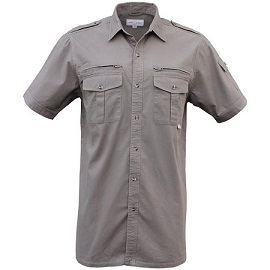
For most safaris which do not involve trekking or "bush walking", fully closed lightweight and comfortable walking shoes such as sneakers with good grip do just fine. The classic Safari boots [ pictured] are always a great all round choice. These are also known as Chukka boots. Hiking boots are also useful but you may find these unnecessarily heavy unless you actually plan on hiking during your trip. Flip flops or sandals for around the swimming pool or in-room use are ever useful and are cheap to buy in Nairobi as well.
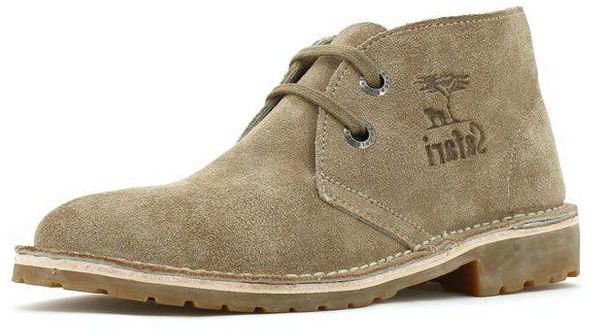
Hats and Sun Protection
For Sun protection we recommend you pack sunscreen lotion ( a high enough SPF) as well as a wide brim Safari hat (pictured) which will help keep the sun off your face and neck. A pair of Sunglasses and prescription glasses for those that wear contact lenses (it can be rather dusty to wear these comfortably).
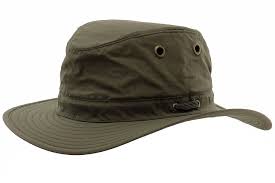
Insect Repellant
Some of the lodges and camps provides insect repellent but we still encourage you to pack your own preferred brand. Repellants containing Deet are said to be more effective against most insects and bugs. All-natural citronella repellant can also get the job done if you are concerned about the deet effects. Please consult your Doctor or Pharmacist.

Remember you will be in the "bush" so to say while on Safari and the nearest town or city may be hours away. Be sure to pack your most essential personal medications especially brands or medicines that may not be available locally in Kenya. Pharmacies in Nairobi stock a wide variety of medicines so for basic requirements such as pain relief, anti malaria pills or antacids and the like one can purchase once in Nairobi. Keep in mind to carry along any prescriptions when you bring along medication into Kenya in case you are required to show this at the airport.
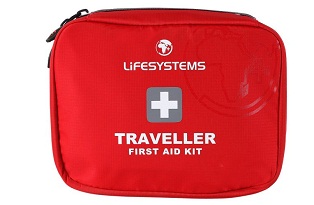
Cameras, Binoculars, Travel Adaptors & Laptop
As for Cameras and Photography equipment we recommend packing thse into your carry on luggage rather than check in for enhanced safety. East Africa offers amazing photo opportunities so bring along a decent camera to make the most of your trip. Binoculars are very useful and though some Safari operators provide a pair in their vehicles, these may be basic in specs so if you can bring a set you are prefer. For serious photographers, you may want to carry your laptop which is so useful for downloading and processing your images after a day on Safari. Also helps you make the most of your camera storage cards as you can keep moving images to your laptop or hard disk at the end of each day. Spare AA and AAA batteries arae available for sale at certain lodges in Masai Mara as well and this includes standard and rechargeable batteries. Regarding Electrical sockets, bring a couple of Travel socket adaptors. In Kenya we use the associated plug type G, which is the plug that has three rectangular pins in a triangular pattern. Kenya operates on a 240V supply voltage and 50Hz.
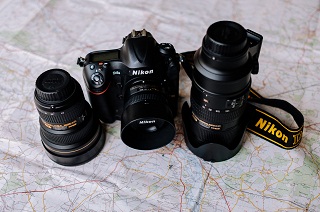
Other stuff
Other important items that you must include in your packing list includes personal toiletries (such as travel size shampoo, conditioner,soap, deodorant, moisturizer, hair brush, tooothpaste and toothbrush), sanitary products for ladies, wet wipes and hand sanitizers, small sewing kit, small scissors and pocket knife (not in carry on bag) alarm clock, money pouch or money belt, reading materials, pen and a notebook.

Pro & Cons of Flying to Masai Mara
Since we mentioned above that flights from Nairobi to Masai Mara and back carry a luggage limitation of 15 kilos per passengers, combined for check in and carry on, we often get asked if driving down would be a viable option as some tourists such as photographers have camera equipment that weighs more than the 15 kilos. So the main advantage of flying to Masai Mara is that it is quick and comfortable as you can get to your destination in an hour compared to a 5 or 6 hour drive. Keep in mind the the planes are small light aircraft, designed for use on the bush airstrips. Some planes may have upto 38 seats, but most have 4-16 seaters with your pilot sitting with you, typically the dependable Cessna planes.
Cheap Kenya Safari Clothing
If you are looking for Kenya safari clothing information, then this page is here for you. The clothing that you should pack for a Kenya safari will depend on a few things like what time of year it is and what type of Kenya safari you are going on, but there are some general rules that you should follow.
Kenya Safari Clothing Colours
Try not to have too bright clothing, this is fine for wearing around the lodge and to dinner in the evenings, but in general when you are going out on safari you want to blend in as much with nature as possible. So think of greens, browns and khaki coloured clothing.
It may be dusty where you are going, so also try and stay away from pale colours, and it is said that blue and black coloured clothing can attract tsetse flies, which have a painful bite. Black can also be way too hot to wear in the summer months.
No Camouflage Clothing for Safaris!Do not wear camouflage clothing, I know that it is popular urban wear in the west, but here in Africa only the military wear it and in some African countries Kenya being one of them, you can be arrested for it especially if it looks like the Kenyan military one.
Since you are not familiar with the Kenyan military uniform the best option would be to avoid military or camouflage clothing.
Kenya Safari Clothing Materials
Your clothing for safari should all be made from lightweight fabrics, that will not only keep the weight of your luggage down, but be comfortable as well.
Many camping shops sell lightweight, neutral coloured clothing, but it is made from material is waterproof and that makes a noise as you rub against it.
This is perfectly fine for camping in a wet environment, but if you are trying to sneak up to an antelope, the noise made by this clothing can often frighten them and other animals away. Cotton works the best for shirts and trousers and woolen jerseys if you are traveling in winter.
Kenya Safari Clothing Shirts
I would pack short and long sleeve shirts all year round not so much for fashion, but styles for practicality. Long sleeves can be used for warmth if needed, but also to protect from the sun and from biting insects, especially in the evenings.
A shirt like the one pictured on the right is perfect as you can roll up the long sleeves if it get a little hot. It also has plenty of pockets, perfect for storing your compact binoculars or camera.
A colour is also advisable as it will protect your neck from the harsh African sun.
The color is also ideal, but any similar neutral colour like green or brown will do.
Kenya Safari Clothing Trousers & Shorts
Again long cotton trousers can really help protect you from the harsh African sun as well as prevent insects like mosquitoes from biting your legs in the evenings and early mornings.
The Cargo type trousers pictured to the right are ideal, pockets for storing your compact camera or safari binoculars or even a compact field or african mammals guide book.
Kenya Safari Clothing Jackets
A warm jacket is important to take on safari, and not only in winter. It is more than lightly, you will go on a game drive at or before sunrise, it can get pretty chilly at this time, so pack a jacket.
Just remember to try and make it neutral coloured and if possible made from a material that is warm and does not make too much noise during movement.
Something like the jacket pictured on the right would be perfect, neutral coloured, warm and made from a cotton material which will not make to much noise during movement. It also has plenty of pockets, perfect for storing those binoculars or digital camera that you will have with you.
Kenya Safari Clothing Footwear
For general safari holidays where you will go on game drives, or walking safaris, the most important thing is to be sensible, you really don't need to go out and buy specialised footwear.
Remember you will be climbing in and out of safari vehicles and walking around on what is normally grassland around the lodge or in the park, so high heels are not needed.
If you are going to be going on a walking safari, or atleast going on a guided walk on your safari, it is advisable to have some sort of hiking boots or specialised safari boots that are both comfortable to walk in, but also covers your ankles.
This is mainly for protection from small thorny bushes, but also is advisable to help protect you in the highly unlikely senario of a snake or scorpion bite.
Great boots include the like of caterpillars, and in Kenya you can buy safari boots. These are comfortable boots that are popular with tourists.
Because they are handmade from leather to the highest standards, they can be a little expensive, but if you are going to be walking alot in the bush and perhaps when you get back home, I would highly recommend them. Other than that look for a good quality pair of hiking boots which will also do the job.
Kenya Clothing Safari Hats
A wide brimmed hat to protect you from the sun is ideal, but any hat, including a cap is better than nothing. The peak of the cap or the brim of a hat will shield your eyes from glare, but even so on bright sunny days, you will probably want to also have a good pair of sunglasses.
Kenya safari clothing Back to Cheap Kenya Vacation Tips Home Page
Go Back to Our Site Map / Index
New! Comments
- Figures and Facts
ANIMALS AND PARKS
- Wildlife and Parks
SAFARIS AND TOURS
- Kenya Safari Guide
DESTINATIONS
- Tourist Attractions
PEOPLE AND CULTURE
- Kenya tribes
DO BUSINESS
- BUSINESS POTENTIALS
HOW TO TRAVEL
- Kenya Travel Tips
CITIES AND TOWNS
- Kenya towns
COOKING POT
- Food and Cuisines
- Kenya Restaurants
- Universities and Colleges
- All Kenya Hotels
- Nairobi City Hotels
- Mombasa City Hotels
- Masai Mara Hotels
- Malindi Town Hotels
- Lamu Island Hotels
- Bamburi Hotels
- Diani Hotels
- Kikambala Hotels
- Kikifi Hotels
- Naivasha Hotels
- Kisumu Hotels
- Nakuru Hotels
- Nanyuki Town Hotels
- Elementaita Hotels
- Nyeri Hotels
- Kitale Hotels
- Privacy Policy
- Tell your story

Recent Articles
Garam Masala Appetizers ,How to Make Garam Masala,Kenya Cuisines
Sep 21, 14 03:38 PM
The Details of the Baruuli-Banyara People and their Culture in Uganda
Sep 03, 14 12:32 AM
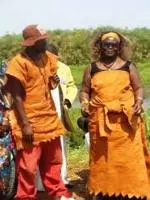
Guide to Nubi People and their Culture in Kenya and Uganda
Sep 03, 14 12:24 AM

- ADVERTISE WITH US
- WHAT’S NEW!
- FREE SPACE!
- MAKE MONEY!
- PRIVACY POLICY
- TRAVEL LINKS
- ADVERTISE FREE
- HOTELS FORUM
- RECIPES FORUM
- FLIGHTS FORUM
Would you prefer to share this page with others by linking to it?
- Click on the HTML link code below.
- Copy and paste it, adding a note of your own, into your blog, a Web page, forums, a blog comment, your Facebook account, or anywhere that someone would find this page valuable.
What to Wear in Kenya
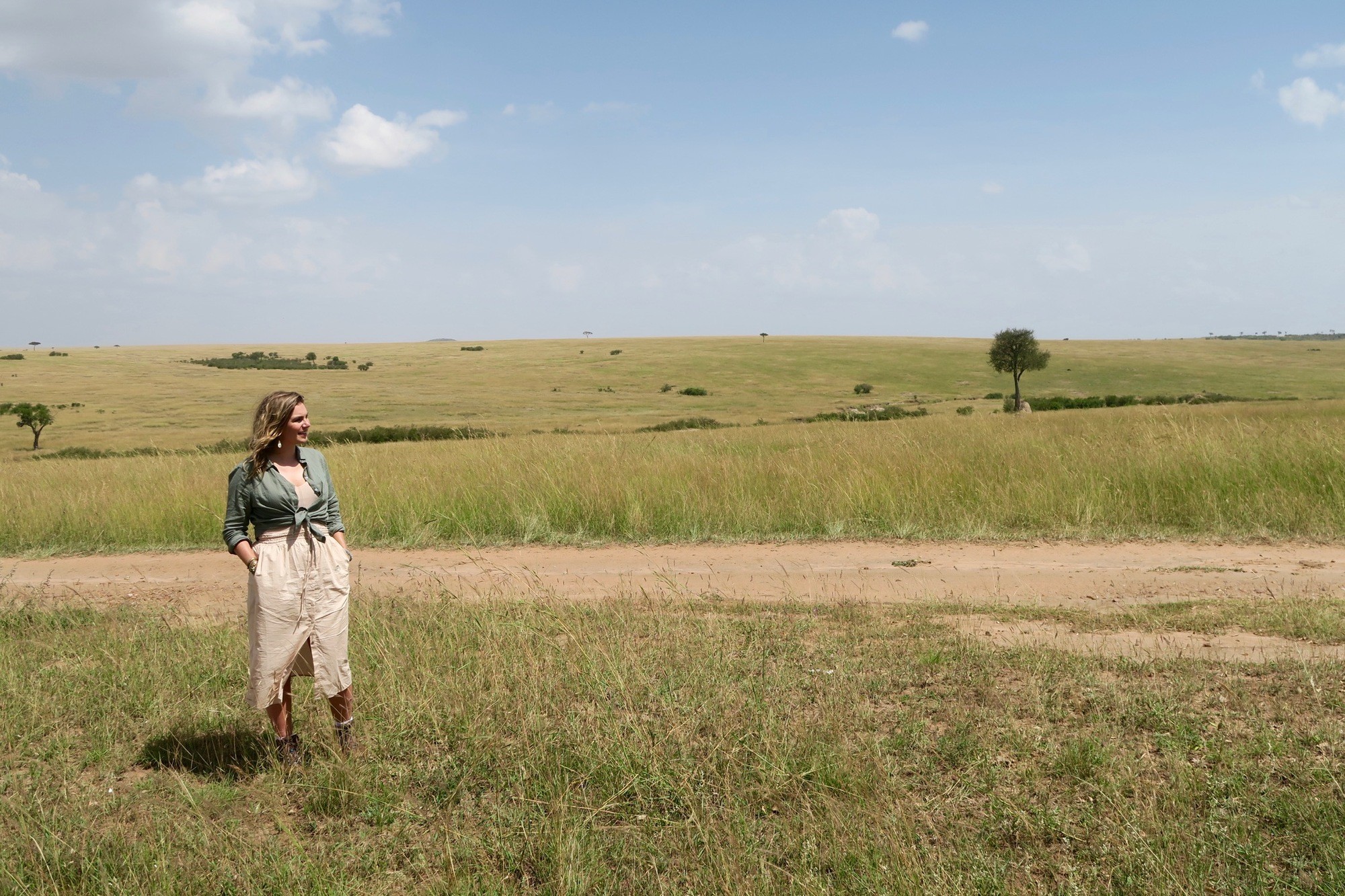
Kenya is by far one of the most beautiful countries I’ve ever been to, even though I barely scratched its surface. While travelling around Kenya I was struck by its geographical diversity; from cities to the sea, mountains to the plains, Kenya is a country where you can experience all kinds of landscapes and all kinds of weather. And when we think of Kenya, we very often think of going on safari. Add the fact that there are notable Muslim areas where, in order to be respectful, we should cover up, it means that packing for Kenya may seem daunting. Never fear! I have you covered.
From Nairobi to the Maasai Mara, here’s what to wear in Kenya on safari and beyond.
Please note that this post includes affiliate links, though none of the products are sponsored (i.e. I purchased everything myself). I’ve had a lot of people tell me they like my what to wear posts but would appreciate links to clothing I’d recommend, so I’ll try to do that from now on. As always, though, I would encourage you to try to shop locally whenever possible; my favourite travel wardrobes are always those that include a lot of the local clothing and jewellery!
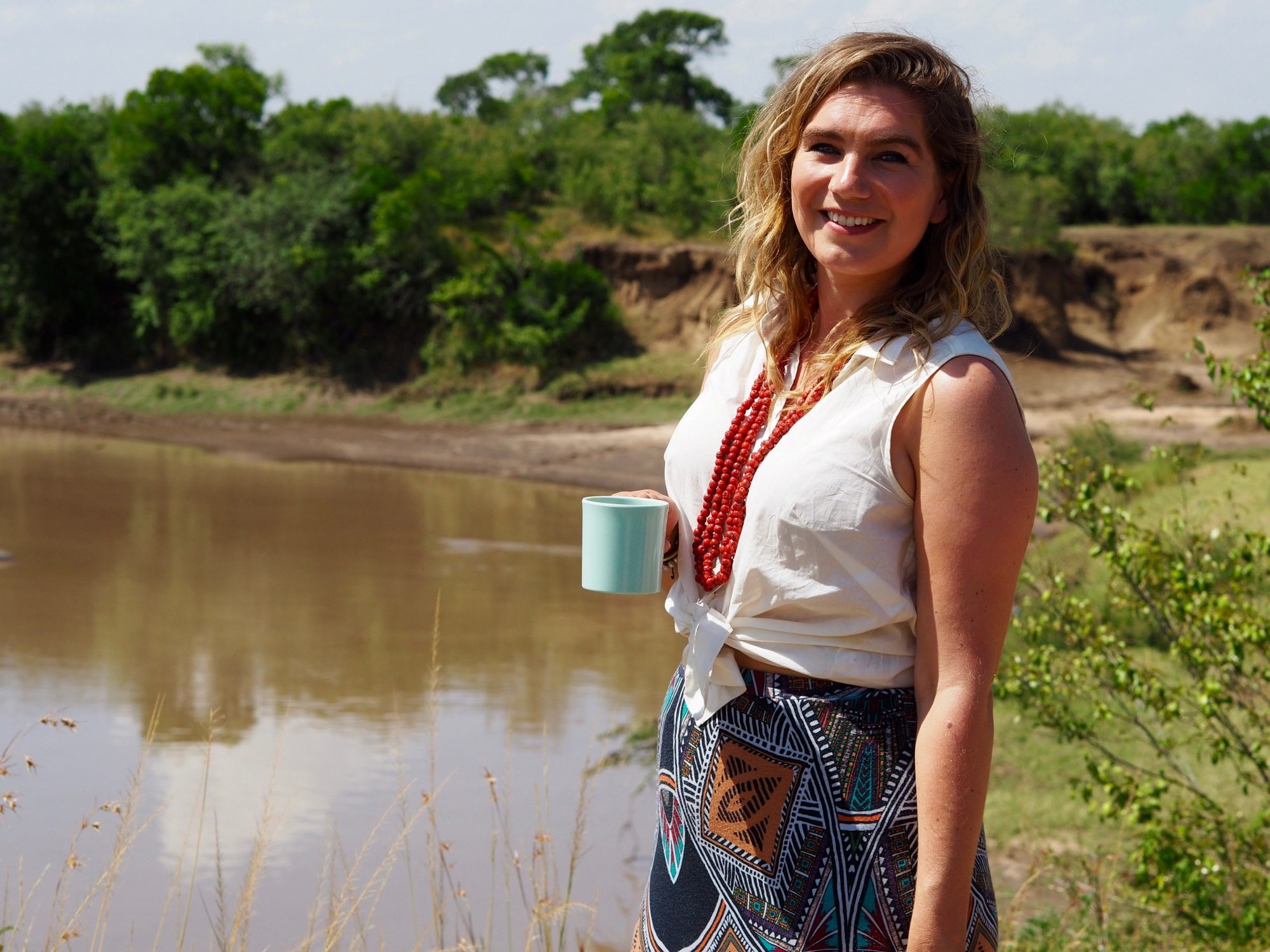
Before we dive into specifics, I wanted to first talk about packing for Kenya in general. C’mon now, admit it, when you think of what to wear on safari in Kenya, you probably think of this . Unflattering khaki outfits, a hat you’ll never wear again, and a whole bunch of expensive, brand-name adventure wear you buy because that’s what people wear on safari, right?
No. You really don’t have to wear anything special on safari, despite what many other websites may tell you. Unless you are camping for days in the brush and do in fact need that special clothing, the average safari-goer is going to be sitting inside a vehicle for the majority of their time.
This means you should always focus on comfort above anything else, because you’re going to be sitting in a cramped vehicle for six to twelve hours with the baking sun overhead. Oh and did I mention the tsetse flies?
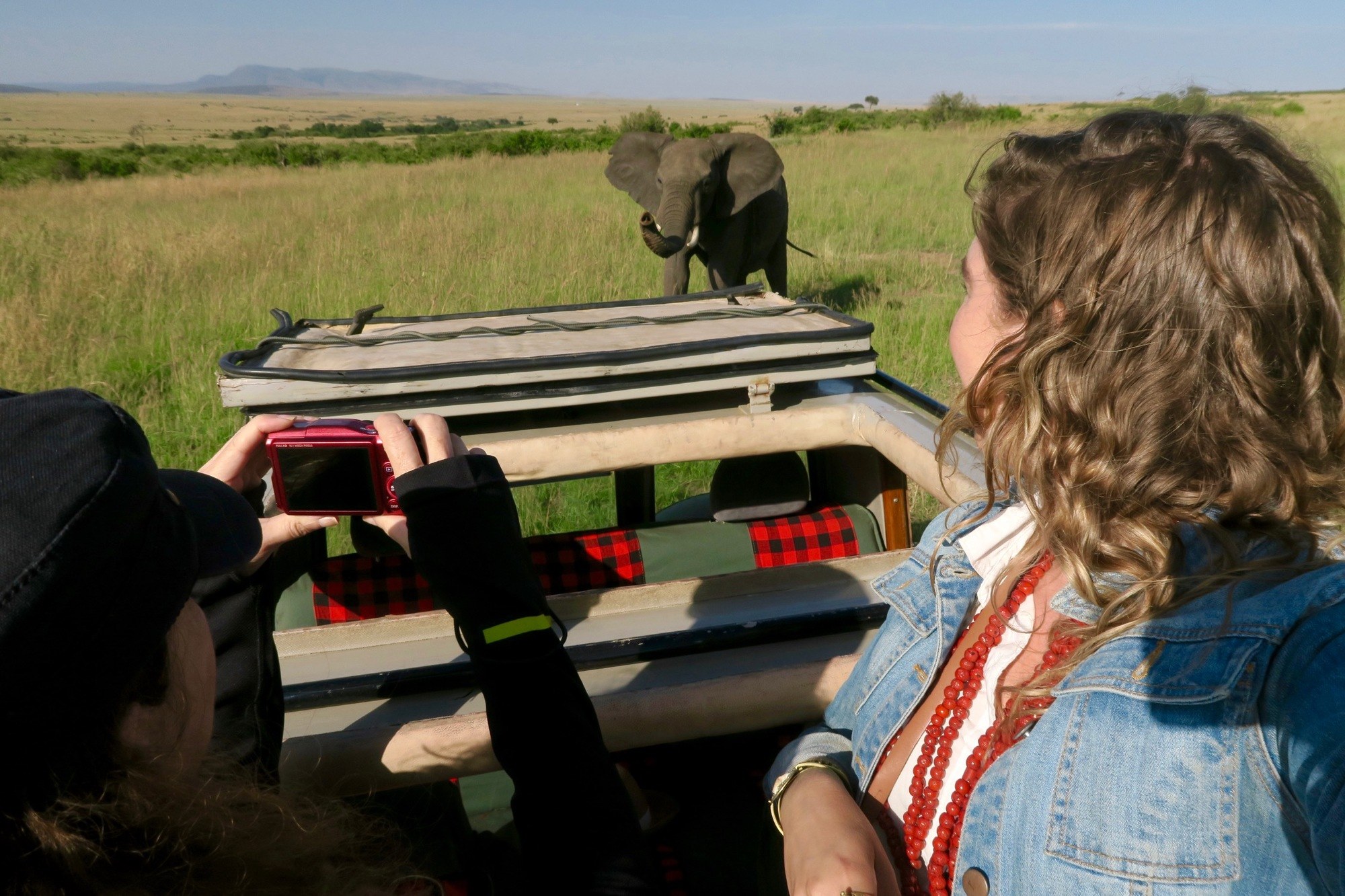
I would also like to dispel two rumours that seem to prevail on every single packing list for Kenya I’ve ever read.
Rumour number one: Black clothing will attract the aforementioned tsetse flies, which are extremely annoying and hurt like hell if they bite you. OK, so the second half of the rumour is true – tsetse flies are indeed annoying and can hurt like hell. But in my experience, it didn’t matter what colour clothing we were wearing… they attacked anyway. We luckily only experienced them badly once (and in Tanzania at that) but I wouldn’t automatically avoid bringing black clothing on safari just for this purpose. If anything I’d avoid wearing black clothing on safari because it gets extremely hot while in the sun.
Rumour number two: Avoid wearing bright colours on safari because you will scare away the animals (hence the fact that safari clothing is often khaki) . OK… no. If you are doing nature walks, then sure, I understand wanting to blend in with the background. But if you are going to spend the majority of your time sitting in a vehicle while on safari… wear whatever damn colour you want. Seriously. I saw dozens of people wearing bright pinks and oranges and greens and guess what? They were all watching the animals, too. Trust me, your pink t-shirt isn’t going to be the distracting factor if you roll up in a giant safari truck.
Need just a little bit more assurance you can wear your favourite bright clothing while on safari?
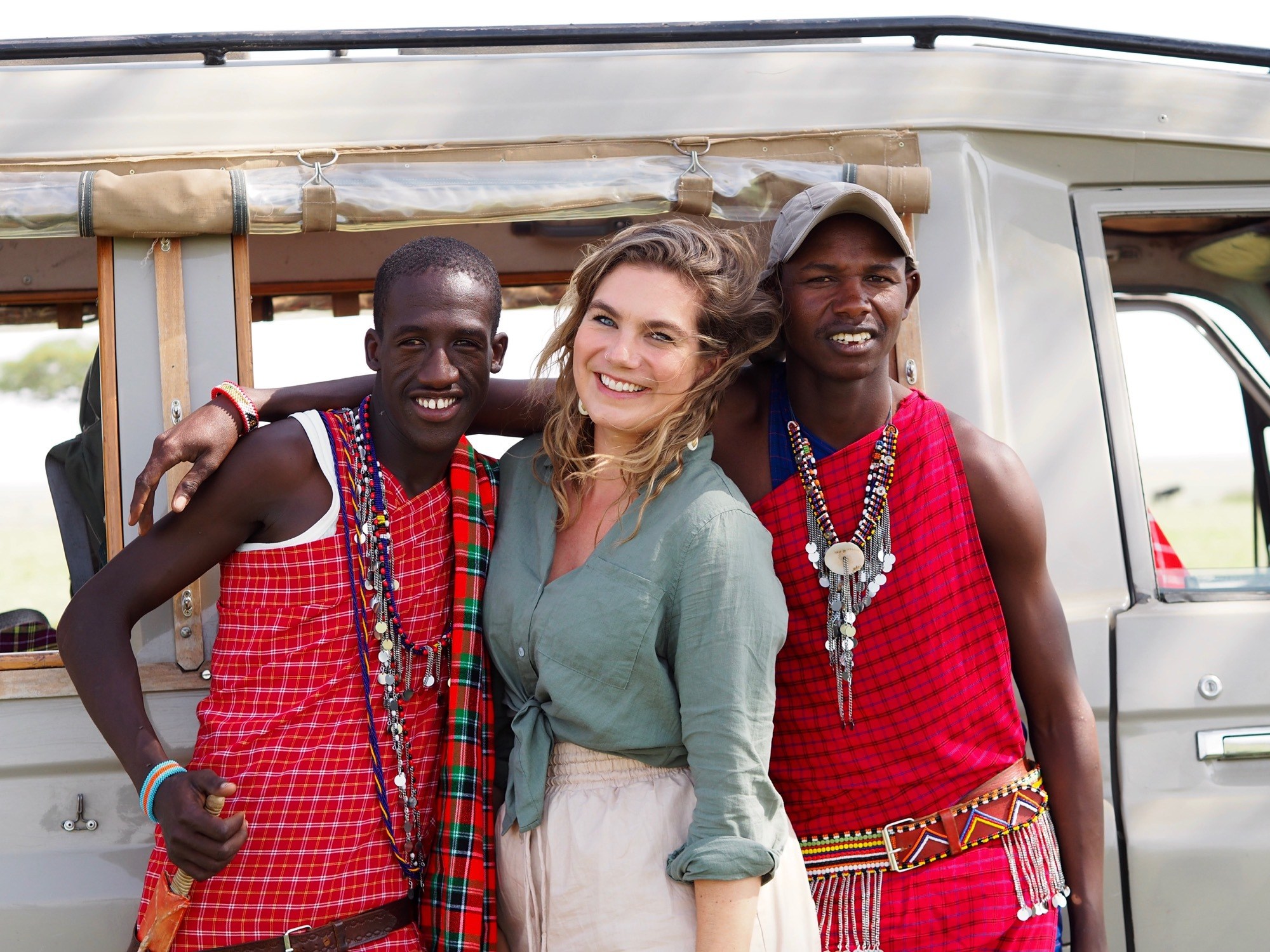
If the local Maasai men can wear this bright red, I’m sure it won’t be the end of the world if you wear your favourite turquoise t-shirt. Traditionally Maasai people wear red to scare away lions, but again, you’re going to be in a big truck . Lions aren’t going to be like, “Oh look, there’s a huge truck coming my way, but PHEW, I’m not scared because they’re all wearing khaki.”
Bottom line: wear whatever colour you’d like while on a safari vehicle tour.
So now let’s talk specifics of what to wear in Kenya…
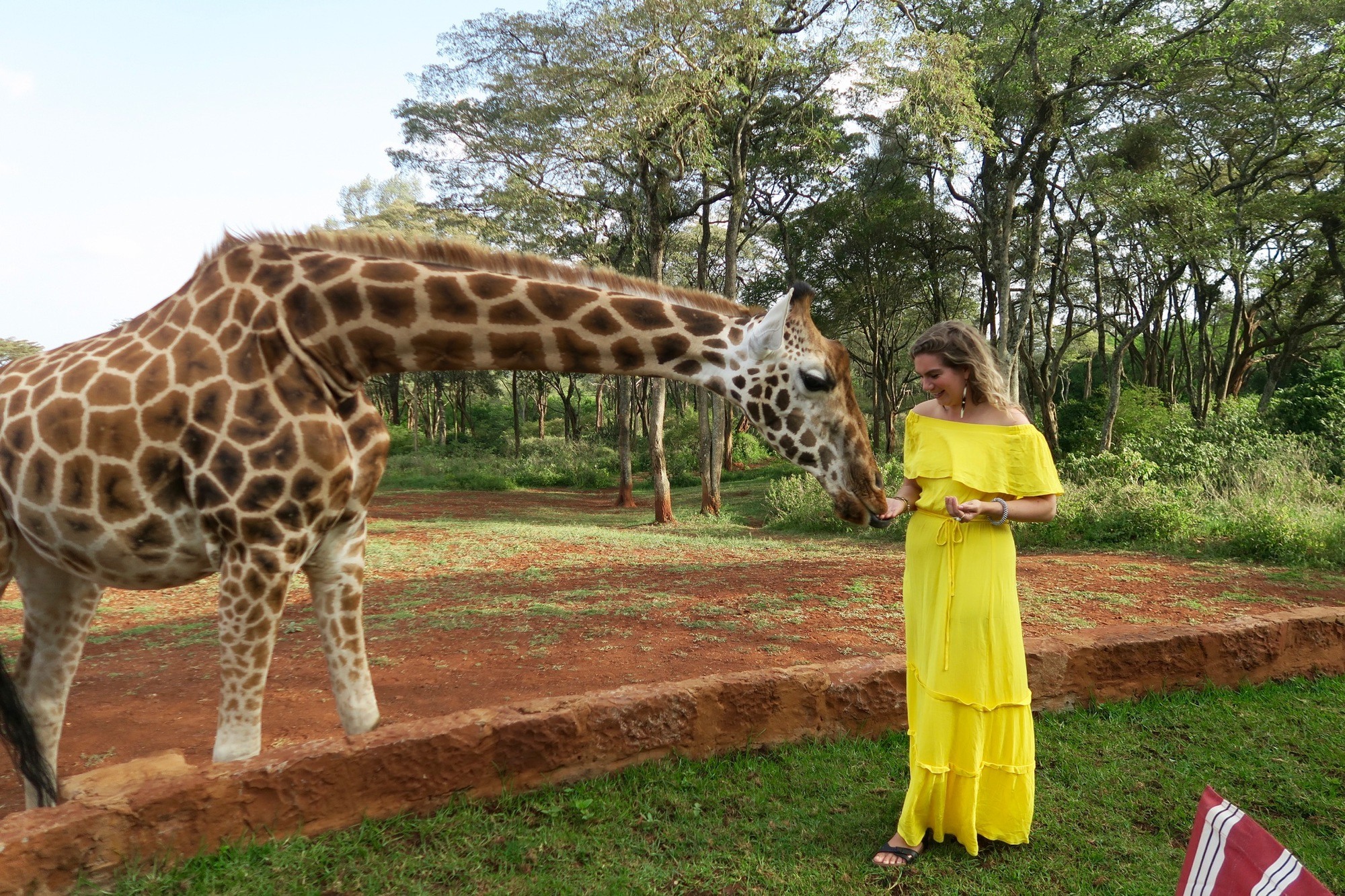
1. Dresses.
I am a big, big, big fan of dresses, both when at home and while travelling. They’re comfortable, stylish, versatile, and you automatically have an outfit to go. I believe that dresses can be both casual and dressed up, and I love having a few in my bag whenever I travel, wherever I go.
For Kenya, I brought lots of long, colourful, flowy dresses that covered me up but were still stylish. I almost always travel with maxi dresses as I find them more comfortable… and I’d argue it’s always better to err on the side of conservative when travelling to a country you don’t know very well.
This dress is probably my favourite travel dress online right now, because you can easily dress it up or down, it comes in a bunch of colours, and it covers your shoulders. I also like the simple, easy style of this dress , although in a more conservative setting you’d have to cover your shoulders with a cardigan or jacket. I’m also pretty obsessed with this simple maxi dress , especially once you throw on a belt and a long necklace. Finally, this maxi dress is just incredibly pretty – I love that shape – and while I tend to stick to solid colours when I’m travelling for a long time, it’s also fun to have a few prints to mix it up!
If you’re after the dress I’m wearing at Giraffe Manor above, it is sadly no longer available from ASOS (I get almost all of my travel clothing from ASOS, Amazon, and H&M). This dress is pretty similar (and way cheaper than the one I bought!).
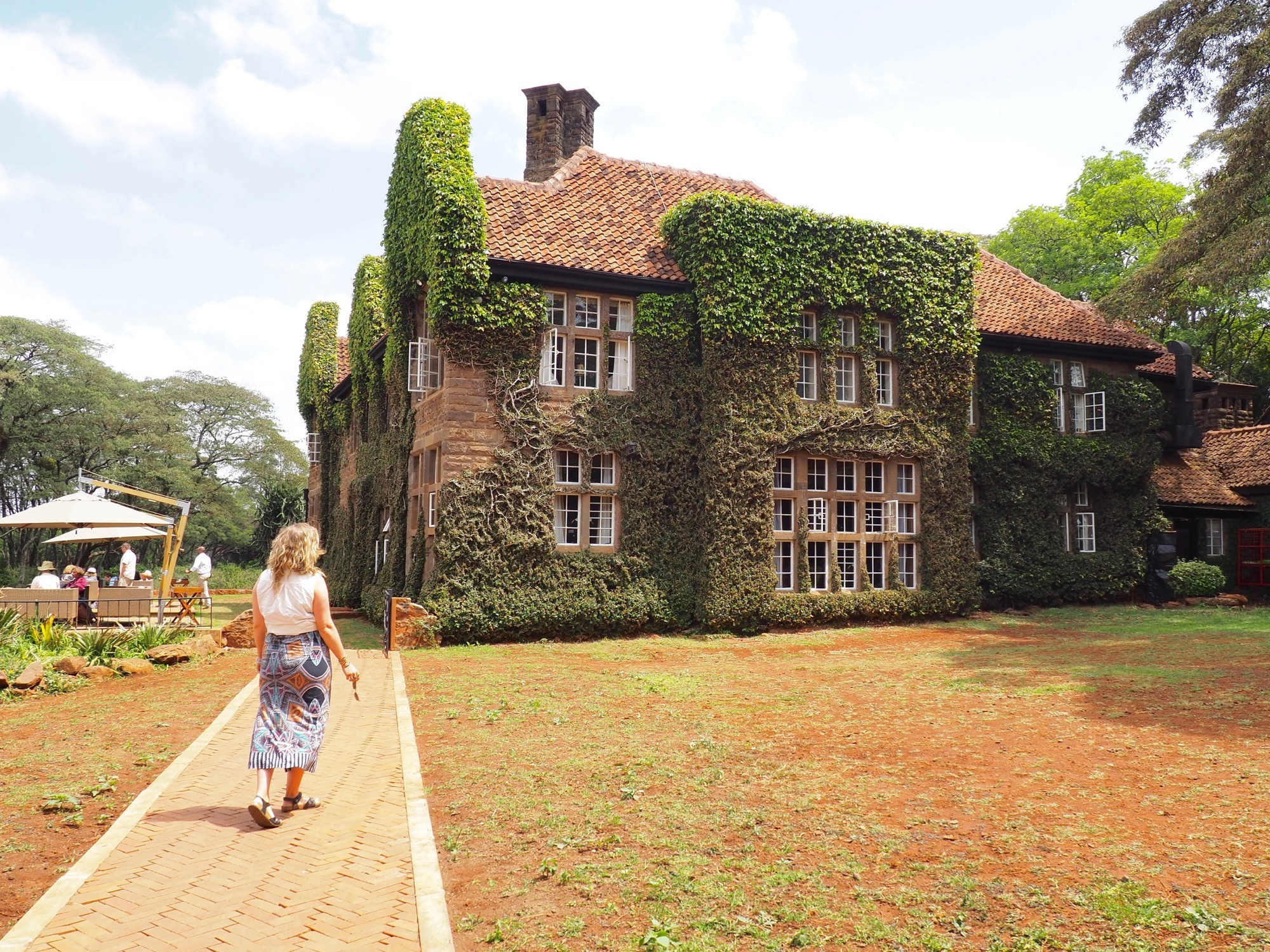
Alongside dresses, I always bring skirts when I travel, for similar reasons to above. They’re super comfortable (I always go for elastic waists), really diverse, and make me feel stylish no matter where I am. Again, I typically go for longer skirts so that I can remain a bit more covered up; t his one is perfect for travelling , and it comes in a variety of colours.
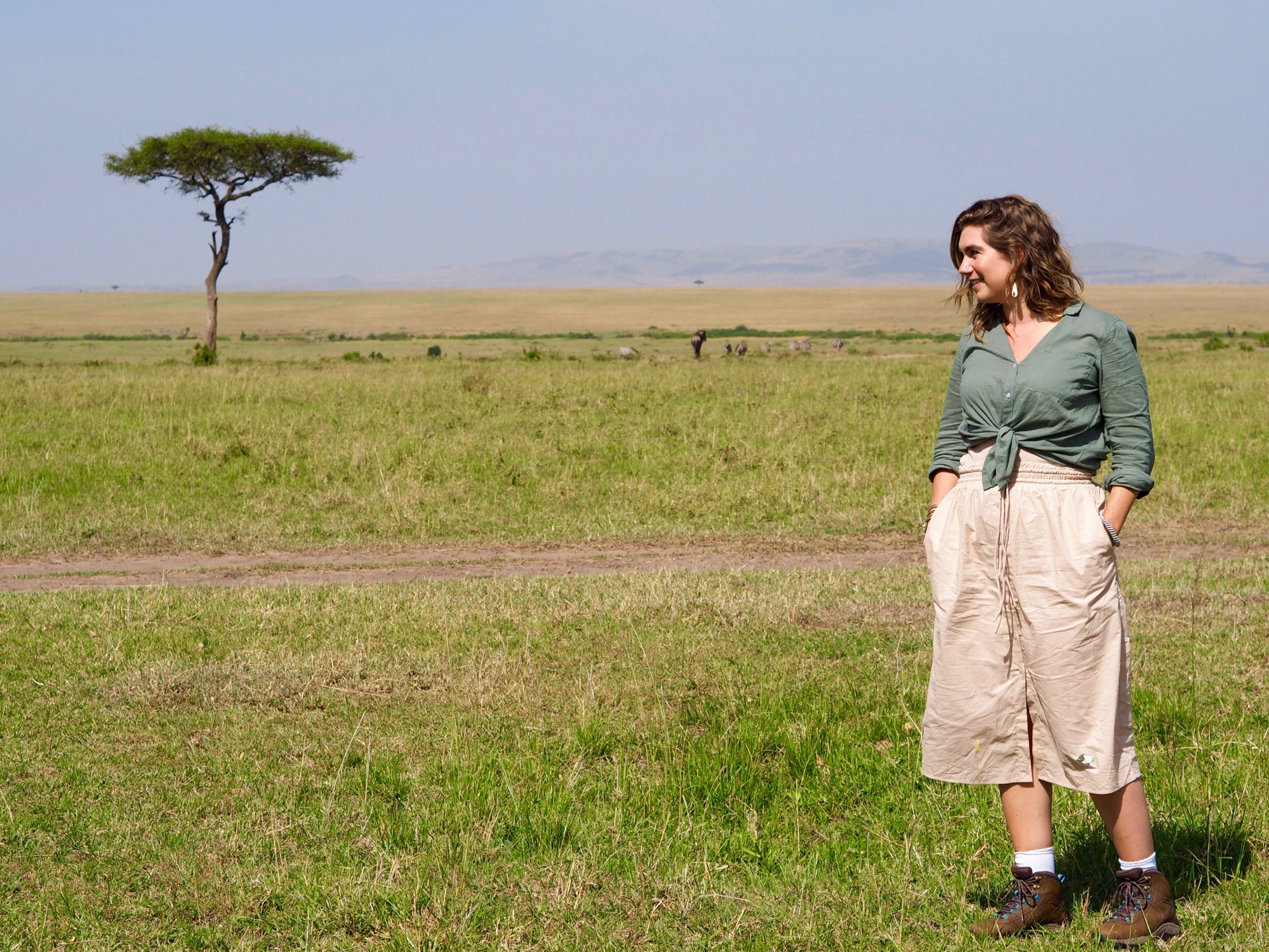
And yes, I even wore skirts on safari! I mean, really, if you’re comfortable in skirts, I don’t see why it’s a problem. I felt comfortable, cool, and stylish, so it really was a win. This skirt is still available on ASOS and it comes in multiple colours ! I may or may not own three of them…
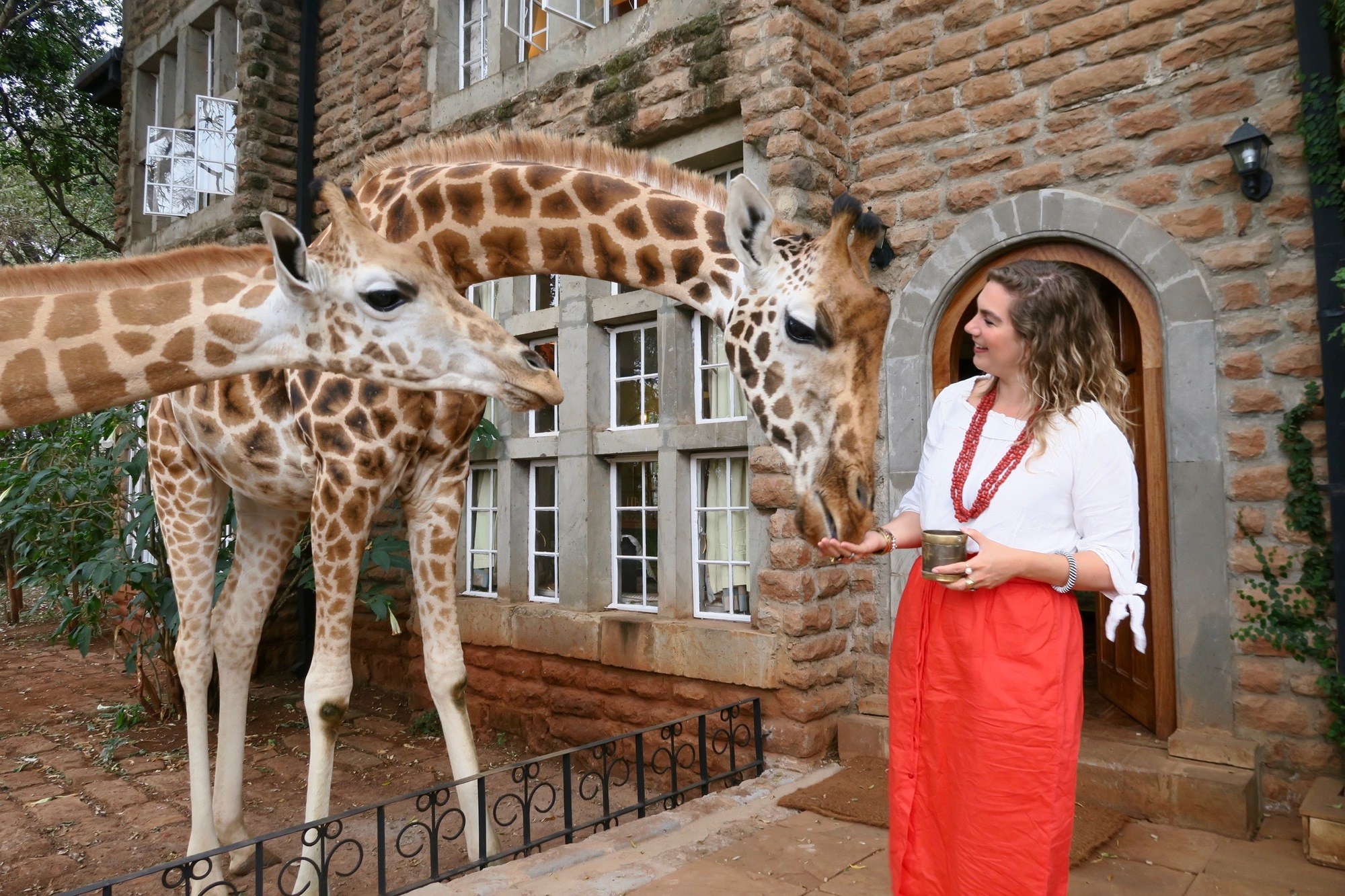
The same skirt in a different colour
One piece of advice… wear a pair of spandex shorts under your skirts. Sounds weird, but I actually wear a pair under every single skirt I wear (unless I’m wearing tights). Firstly, I don’t have to worry about any awkward angles (think mid-2000s Lindsay Lohan) and secondly, I can combat the dreaded chub rub. Oh yeah. You know what I’m talking about… when your inner thighs chafe due to heat. Not pleasant to think about, I know, but trust me, a little pair of spandex shorts will be your best friend. I personally like these ones .
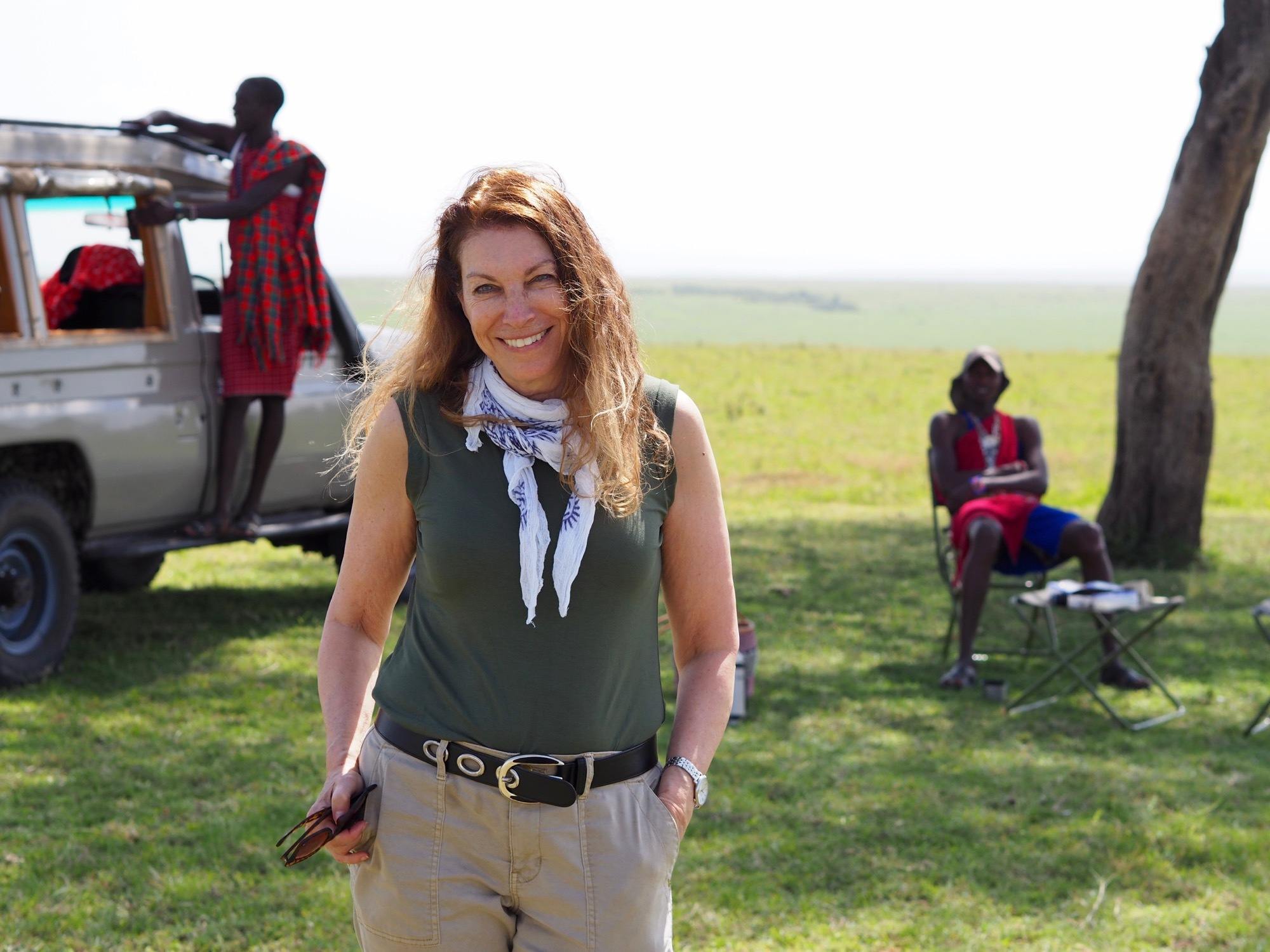
3. Trousers.
As my mum is modelling in the photo above, I would highly recommend bringing at least one pair of comfortable, durable trousers while in Kenya, especially if you’re going to be doing any bush walking or hiking. I personally brought a pair of black leggings as well as a few looser cotton trousers from H&M, but that’s because I knew I wasn’t doing any serious outdoorsy stuff in Kenya.
I’d like to spend a lot more time on the African continent in the next few years, and a lot of that includes camping and bush walks, so I am looking to purchase these trousers as I’m a big fan of the Craghoppers brand.
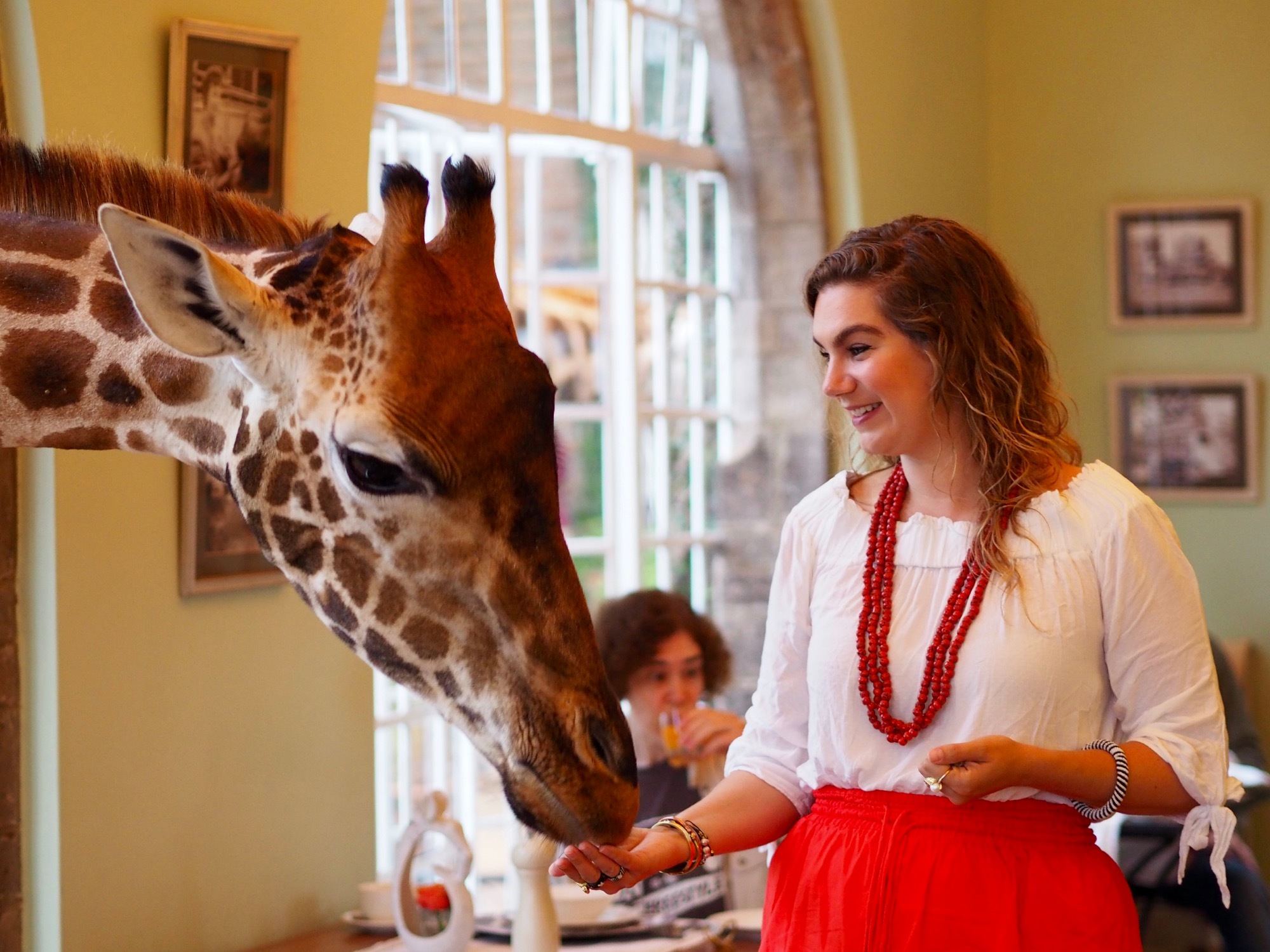
I brought a variety of shirts and blouses with me to Kenya, and I was thankful for all of them. I think it’s important to have a few different styles so that you can rotate them depending on the weather and humidity. You’ll most likely be sweaty at some point on your time in Kenya (temperatures can get very hot, especially when you’re on a lengthy safari) and so it’s good to have lots of cool, breezy options. I always prefer cotton when I’m travelling.
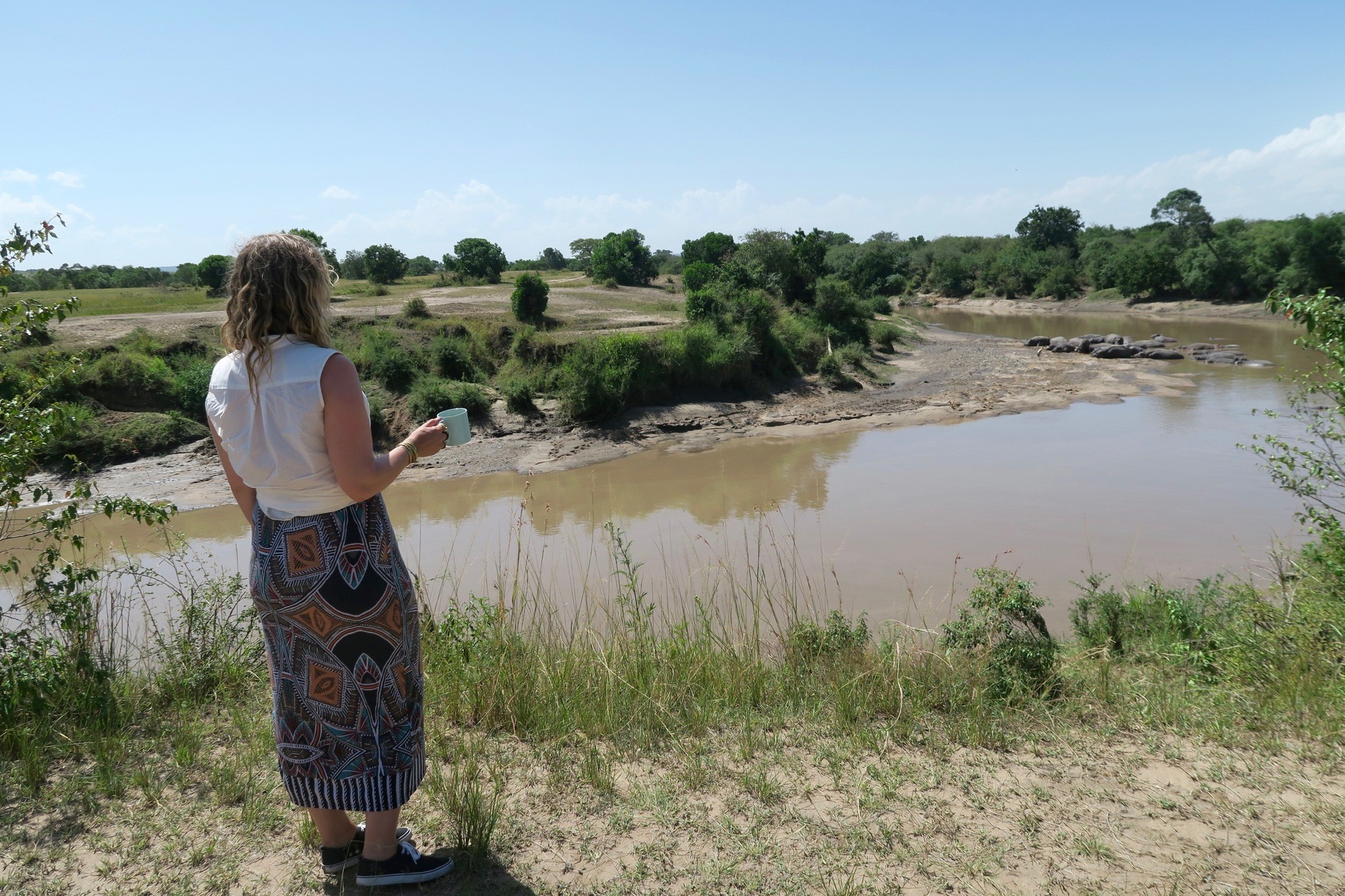
As you can see in the photos above, I preferred white, although they do indeed get very, very dirty on safari (lots and lots of dust in the air). They were easy enough to wash in the evening and were usually dry in a few hours because of the heat.
I brought the following shirts to Kenya:
-a sleeveless blouse, similar to this one
-two tank tops to wear on safari, although I wouldn’t wear these in more conservative areas
-an off-the-shoulder top to wear in Nairobi and in the evenings, similar to this one
-a button-up cotton blouse from H&M which was a lifesaver on safari… it kept me protected from the sun but was still cool and comfortable!
I also had a long-sleeve t-shirt with me that I didn’t wear.
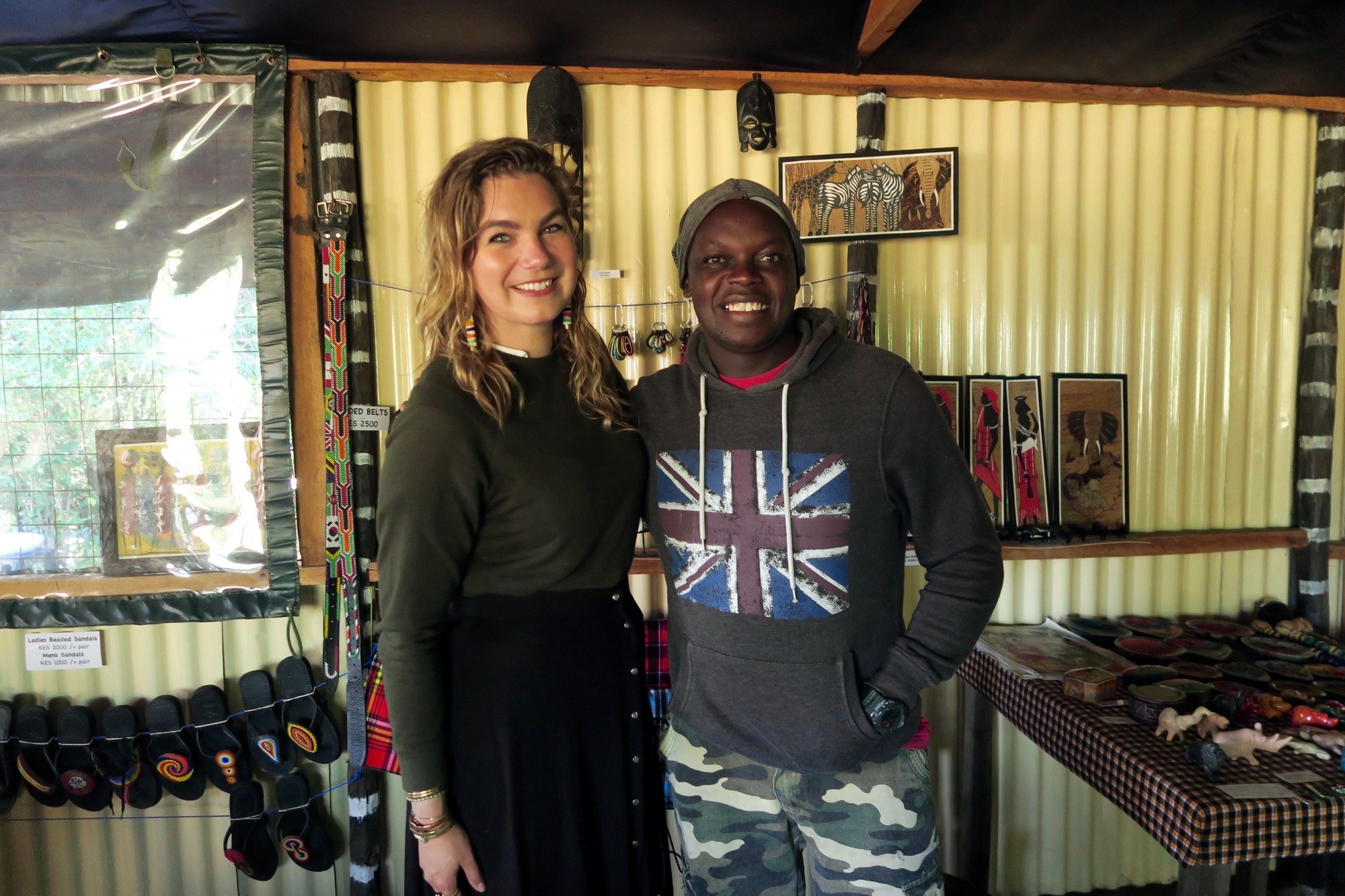
5. A sweater or sweatshirt
It can get quite chilly in in the evenings and early mornings in Kenya, so I found my hoodless sweatshirt to be invaluable (I have about six of these in a variety of colours; I love them for travelling as they’re both warm and durable). Both ASOS and H&M frequently carry these styles.
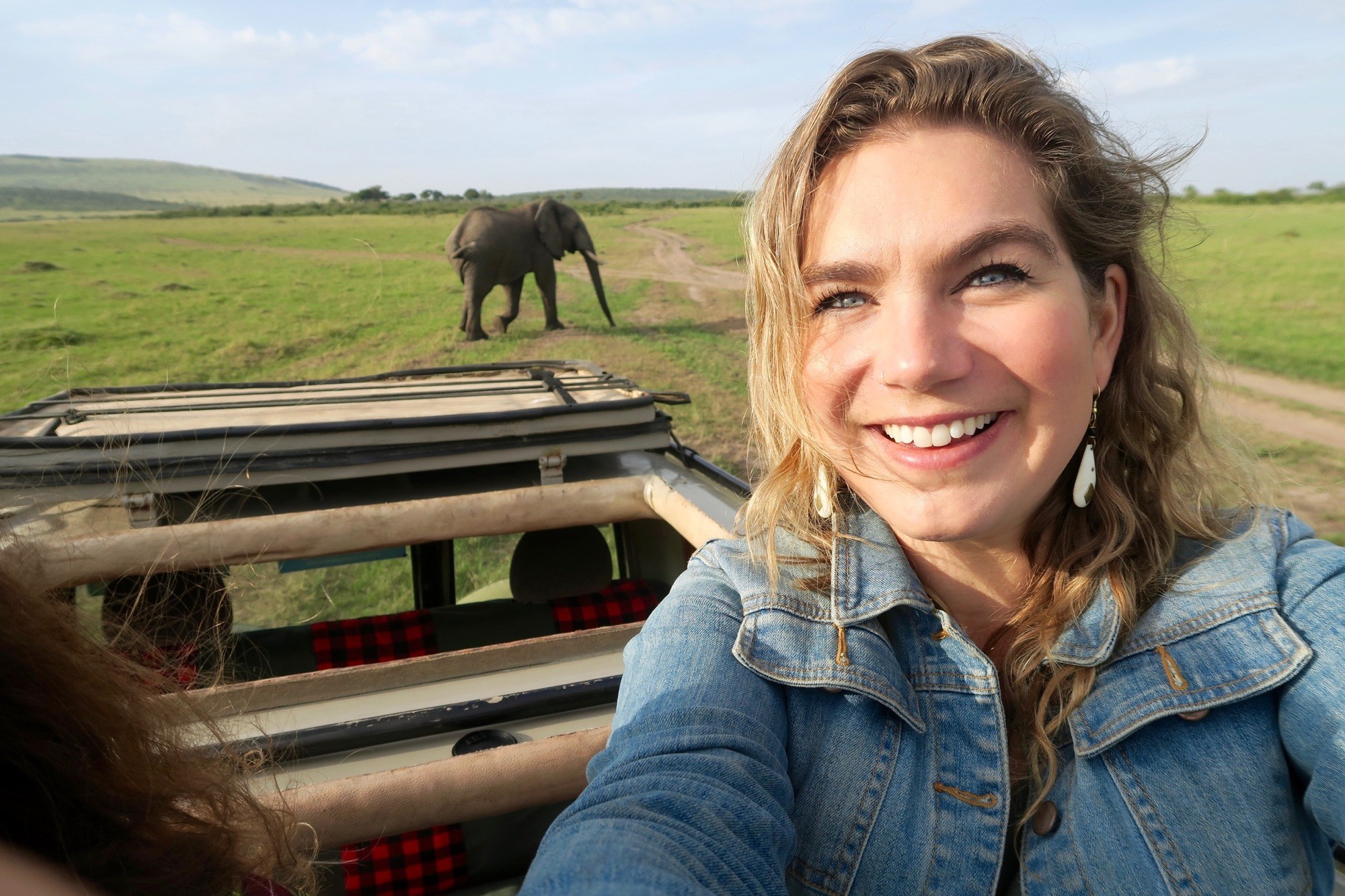
6. A jacket
As I knew I wasn’t going to be doing too much outdoorsy stuff, I stuck to my faithful denim jacket (I have taken a denim jacket with me on every single trip for the past 11 years). I like a cropped look like this one . I also carried a rain jacket that could fold up easily ; I didn’t need it for Kenya but used it in Rwanda and Uganda. Again – it gets chilly in Kenya at times, so it’s good to have a few layers!
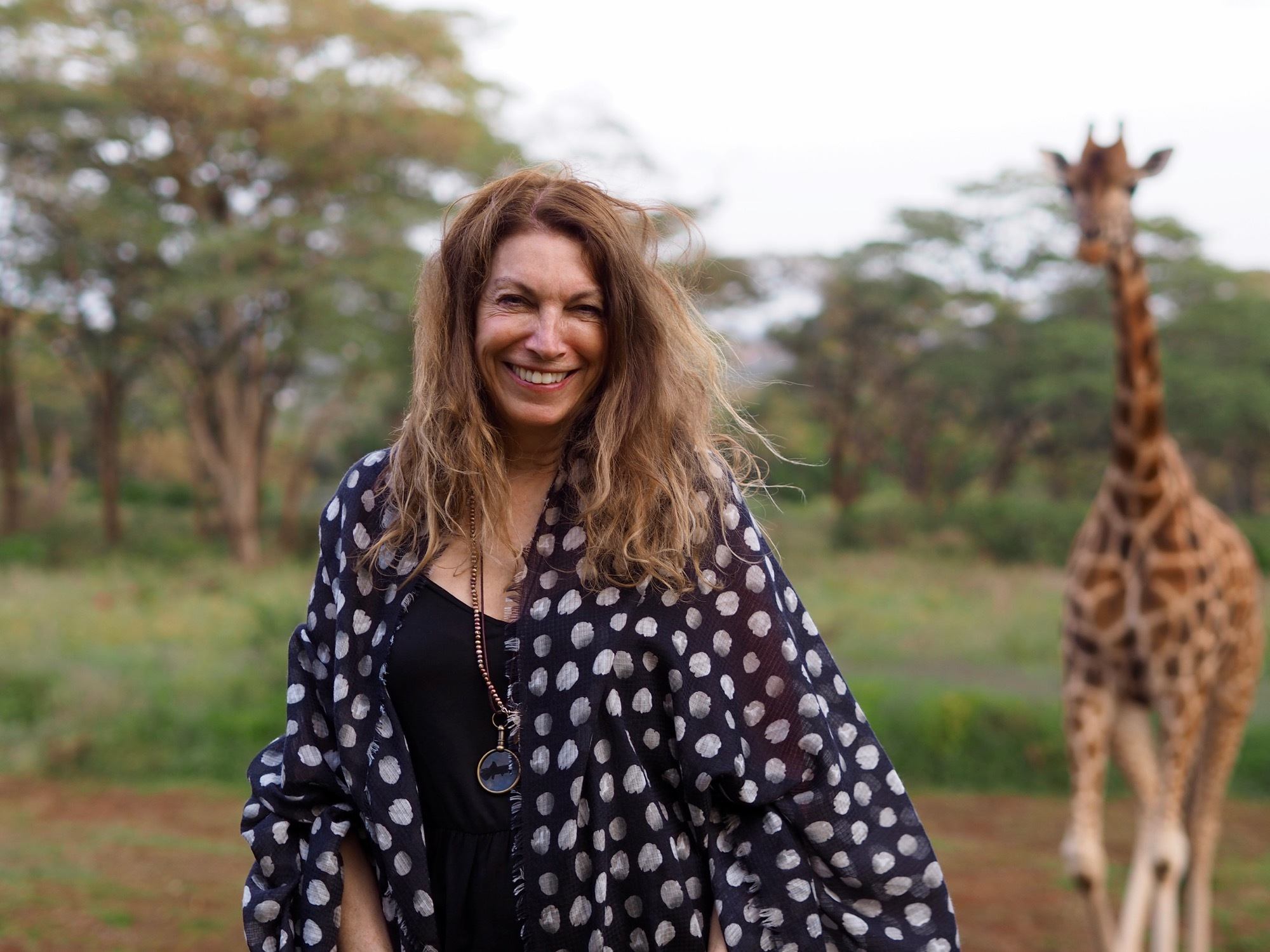
Favourite photo I took of my mum in Kenya
What is a packing list on this blog without a scarf recommendation?! Scarves are so useful while travelling – they can not only be used as actual scarves, they can be used as shawls (as seen above), sarongs/beach coverups, blankets, towels, pillowcases, and can even be fashioned into skirts and dresses if big enough. There are some scarves for sale in Kenya – you’ll see the Maasai blankets in just about every tourist shop or market – but I brought a few lightweight ones with me knowing I wouldn’t necessarily need them for warmth. Ones like this are super pretty and can add a pop of colour, and I always recommend a pashmina .
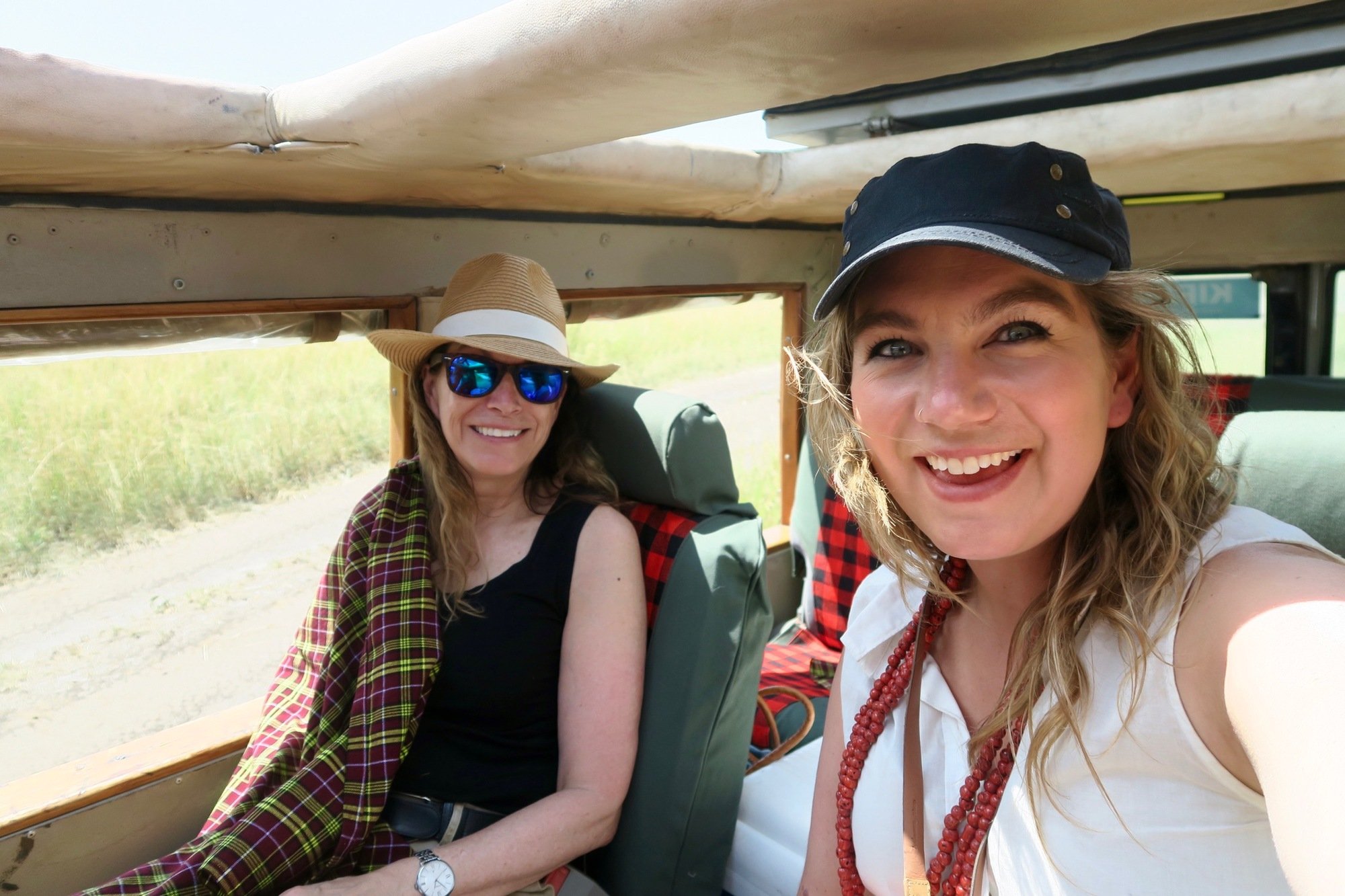
If you are going to spend any time outdoors in Kenya, I strongly recommend a hat. If you are going to be on safari in Kenya, you definitely need a hat. I am not a hat person but having something to keep my head cool and keep the sun out of my eyes was incredibly useful – especially when we were sometimes on safari from 6am to 6pm!
Again, you do you not need any type of special safari hat… a beach hat or baseball hat will do. Just make sure it keeps your face sheltered from the blazing sun!
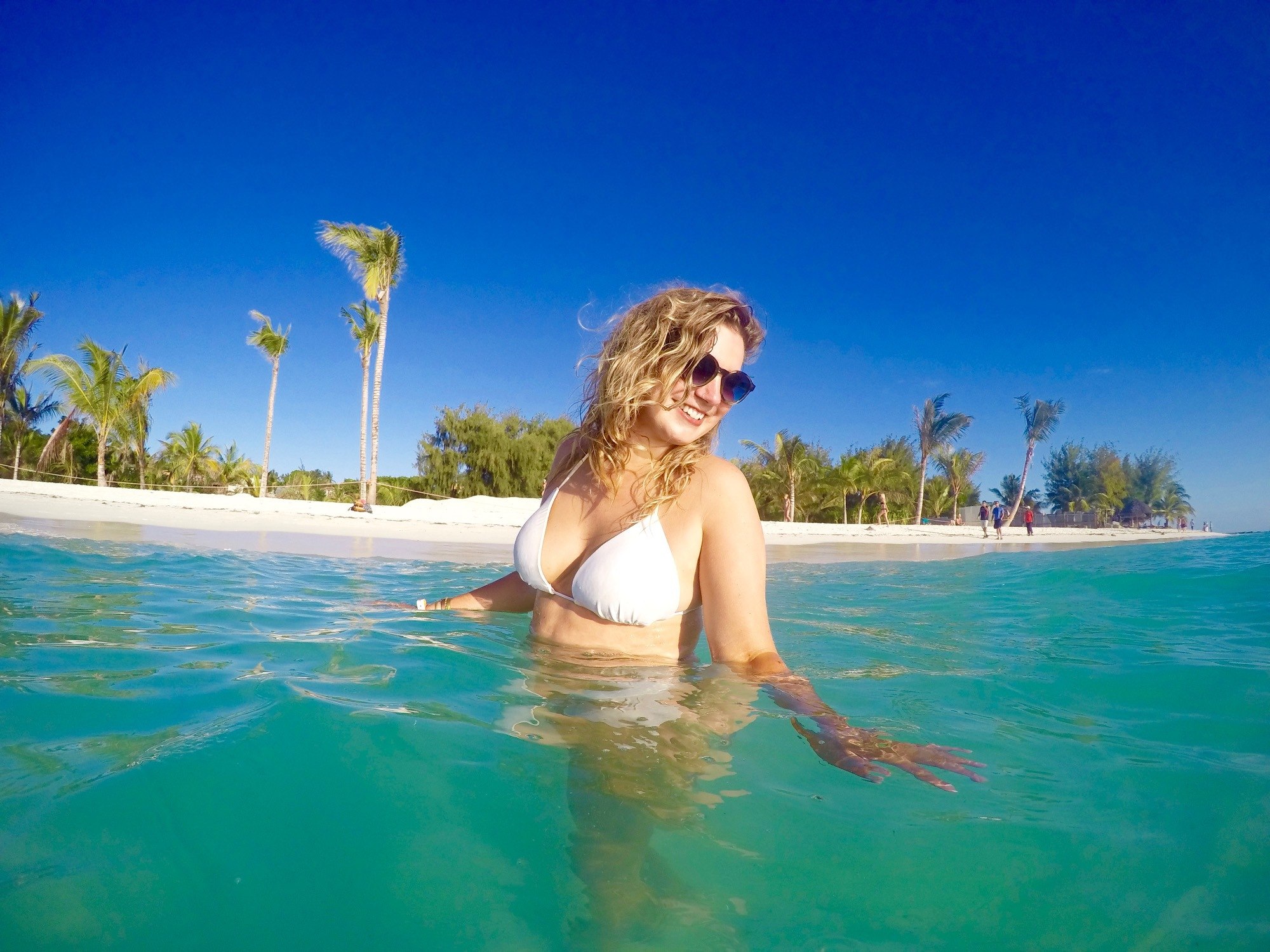
9. A bathing suit
So the photo I used above was taken in Zanzibar, but I did need a bathing suit for Kenya as some of the hotels and lodges I stayed in had pools. If you are going to be spending time on the Kenyan coast, you’ll obviously need both a bathing suit and a beach cover up, though your scarf or pashmina can double for this.
As you can see in the photos above, I had a variety of shoes with me in Kenya. I was actually very pleased with the selection I brought – I often overpack – and this time went for comfort above everything else. In my suitcase I brought the following shoes:
– Merrells hiking boots , which I wore while on safari. These later proved invaluable on treks in East Africa, so I definitely recommend bring a pair of sturdy, durable, water-resistant hiking boots.
– Birkenstock sandals . I had never owned Birkenstocks before and I was hesitant to buy them, but they turned out to be incredibly comfortable and worth the price. I went for a slightly different look to the regular style and felt I could even wear them out at night with dresses!
– Avarca sandals . I have totally fallen in love with these after purchasing them in Menorca earlier this year! They are so comfortable and I get so many compliments on them. I actually brought two pairs as they fold down so easily, and wore them with dresses and skirts.
-Flip flops – I’m always a fan of Havaianas ! Easy to slip on for by the pool, in outdoor showers, etc.
– A pair of Keds . I have been recommending these for years as travel shoes – I’ve worn them all over the world. They’re cute, comfortable, and classic.
Finally, don’t forget to bring at least four pairs of durable, breathable socks.
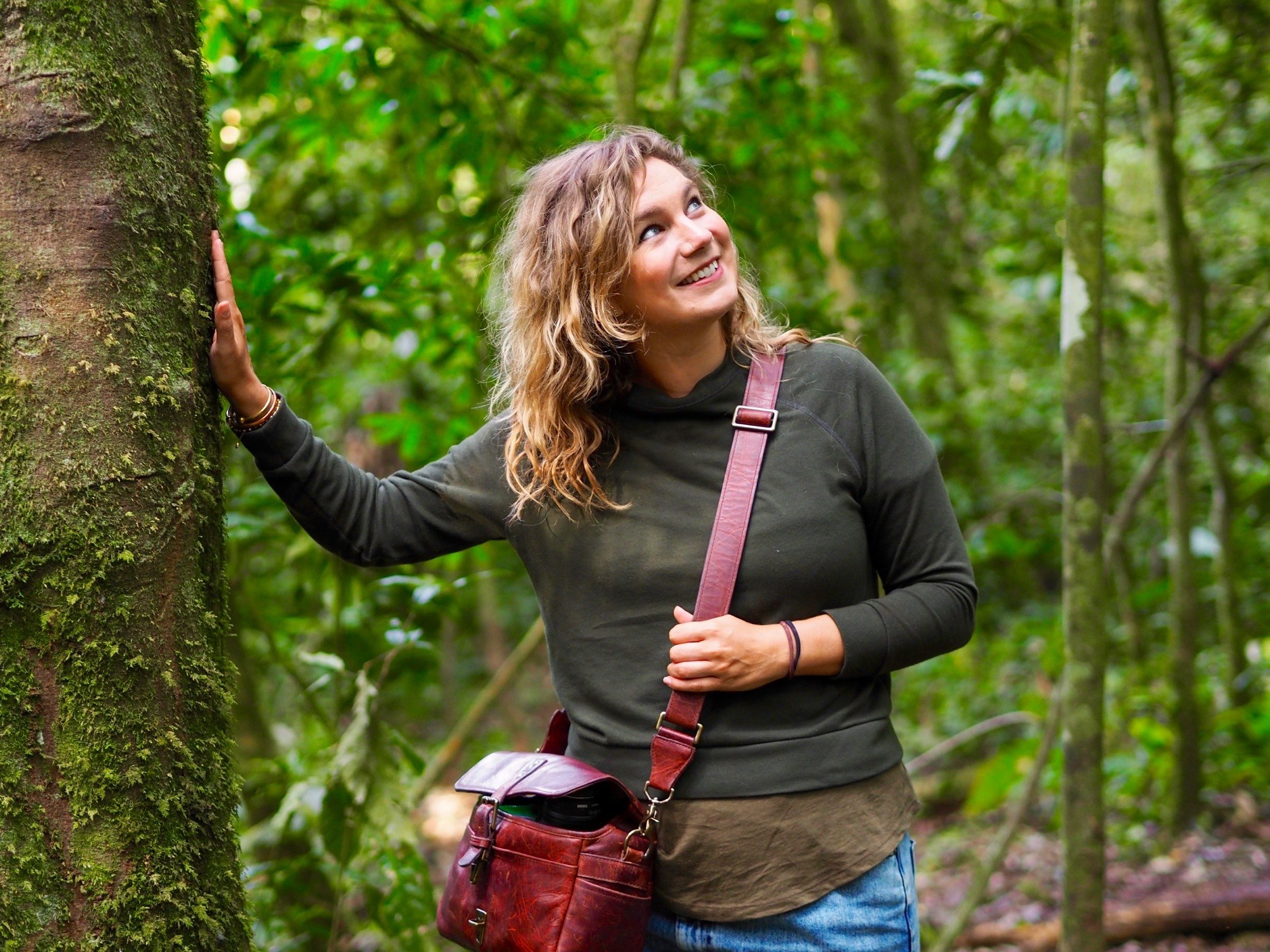
This photo was actually taken in Rwanda, but you can see my ONA camera bag here. I am OBSESSED. It’s so beautiful – I get so many compliments on it – and it was great to hold all of my camera gear while out on safari.
I also had a small black purse with me – many travel bloggers recommend Pacsafe purses , and I’m a fan of their portable safes – as well as a Herschel backpack as my day pack. I feel like everyone and their mother owns this backpack in London but I can totally see why… it’s not only stylish, it’s durable as hell. I bought the brown one and felt it looked very safari-esque.
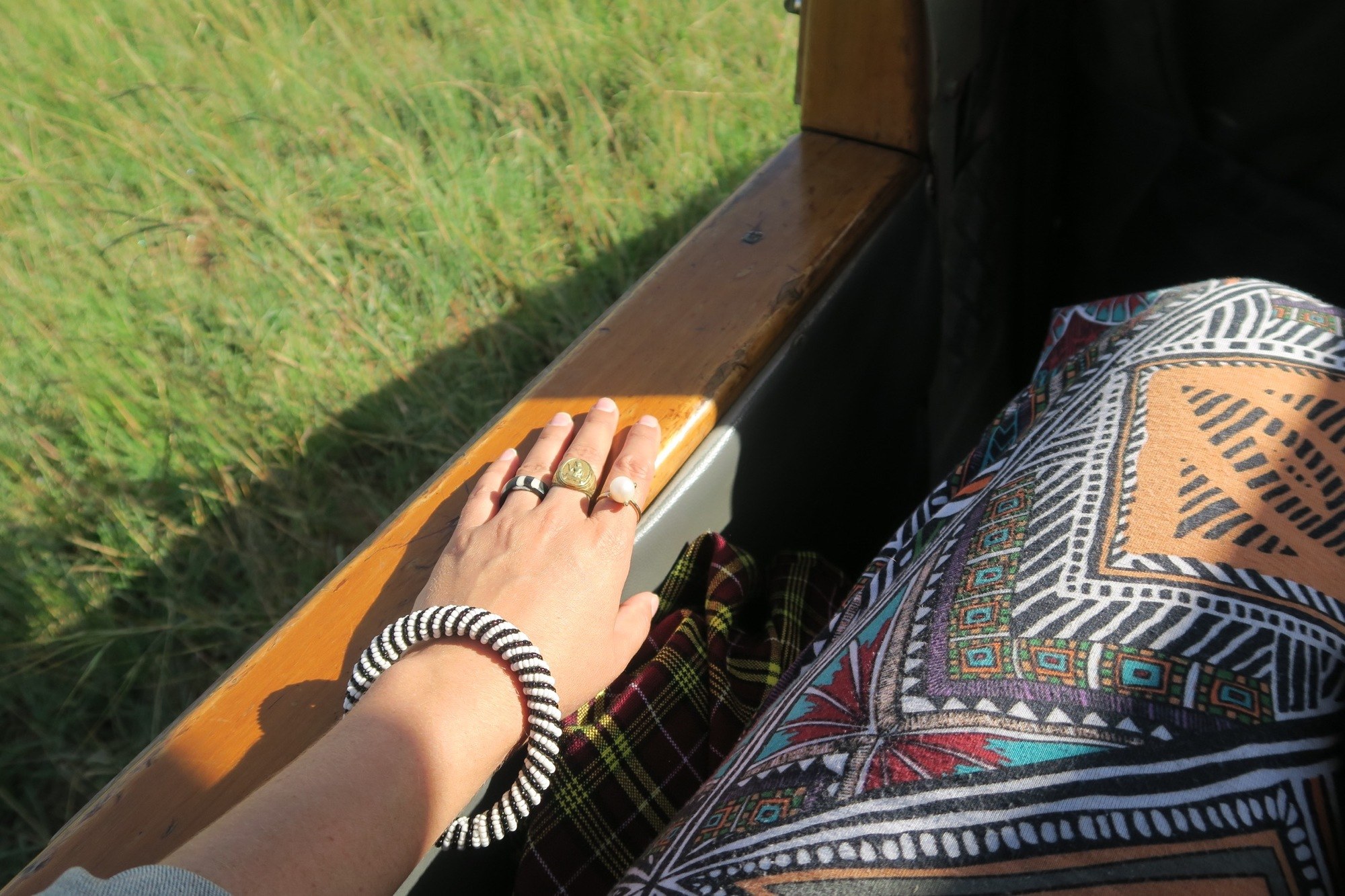
12. Jewellery
As you can see in the photos, I wore jewellery the whole time I was in Kenya. I never understand articles that tell you not to wear any jewellery when travelling because it might attract attention and make you a prime target for robbery. Um, I hate to break it to you, but just being a tourist is usually going to be attention enough! While I certainly wouldn’t bring anything too valuable or sentimental with me (I met a few women on honeymoons who had left their engagement rings behind, and I totally get that), wearing a few bangles or beaded necklaces is completely fine.
I purchased a lot of jewellery, including bangles, rings, necklaces, and earrings, in Kenya, and I absolutely loved wearing them.
Bottom line – if you wear jewellery at home, don’t be afraid to wear it while travelling!
The absolute same theory goes for makeup – if you wear it at home, you can certainly wear it while on holiday in Kenya! I applied my usual makeup every day, even on safari. I’d just avoid anything too heavy – you’ll most likely be sweating a lot – and, as always, I can’t recommend this product enough . It totally changed my makeup routine as it ensures my eye makeup stays put all day, even in hot weather.
Other things to bring to Kenya:
-A great camera. I took the plunge and bought this Olympus mirrorless camera and noticed a huge difference in my photos. I also purchased a zoom lens to go with it; trust me, you will want a zoom lens while on safari!
– Mosquito spray . Absolutely essential in Kenya, as malaria is a threat.
-On that note, malaria tablets. In North America these are prescription, although in the UK you can buy them over the counter from a pharmacy. Expensive, but worth the extra protection against malaria!
-A first aid kit with all of your favourite/trusted medicines.
– Sunscreen with a high SPF . Also essential, as you’ll most likely spend a lot of time in the sun.
– Travel sink packets for washing your clothes . I did see laundry services available at my hotels and lodges but sometimes you just need to wash something quickly, especially after a long day in the dust and the sun.
– A Pacsafe portable safe . I felt totally safe in Kenya but I liked the extra assurance that my belongings were safe in my room or tent. I had been meaning to purchase one of these for a long time and I really valued it while in East Africa for six weeks. It holds a lot, including two laptops.
-Finally, I brought a Samsonite hardshell suitcase with me to Kenya, and I have to say it was AMAZING. I was worried I would need a backpack (and if you are planning on doing a lot of camping I recommend bringing one) but for my trip – one that involved mostly hotels and lodges, this suitcase was great. I loved the built in lock, and despite being hardshell, I could fit SO much stuff in it! Don’t forget packing cubes – I am such a fan of these, as it’s so easy to keep all of your stuff organised.
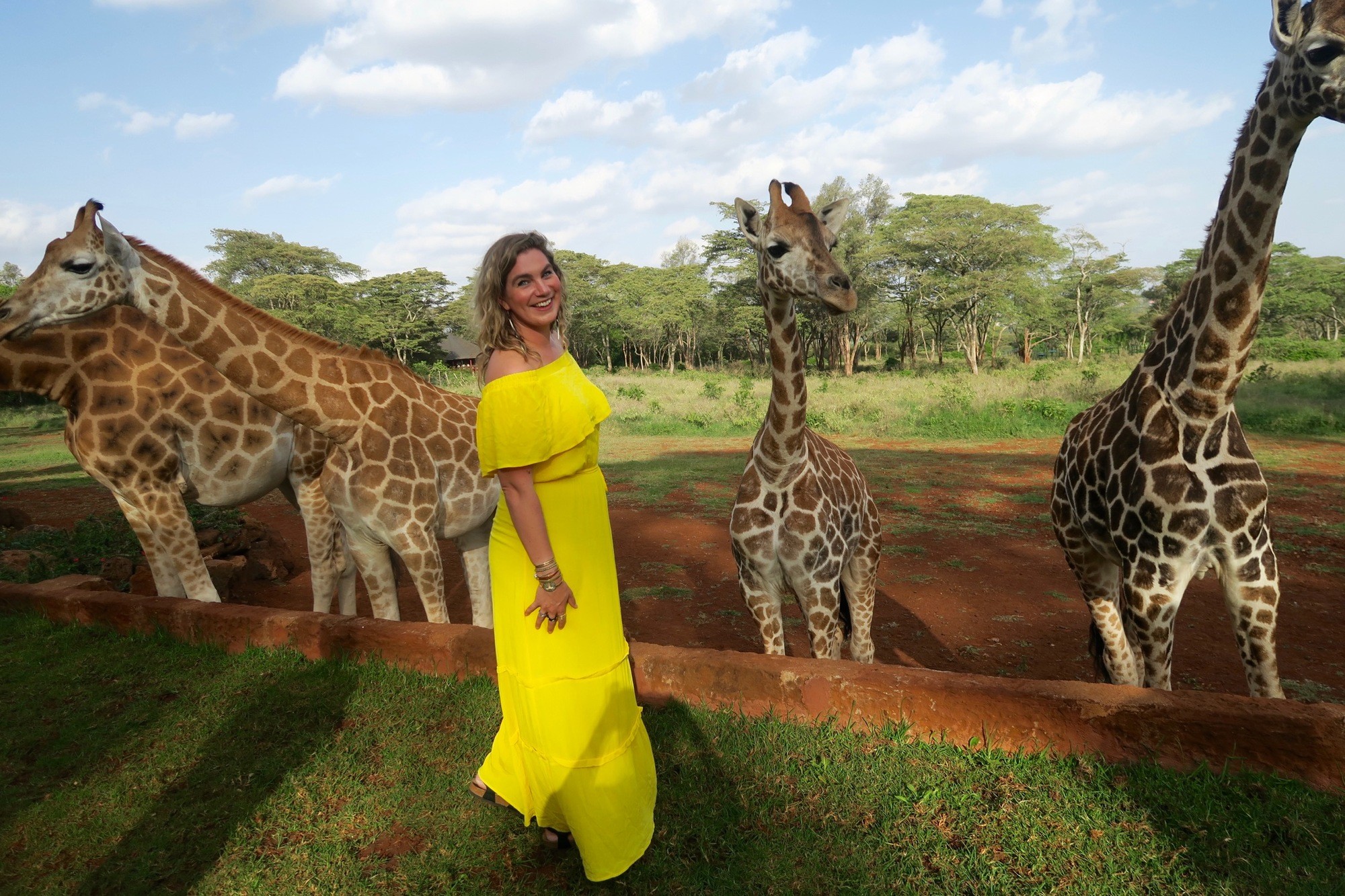
Make sure to check out the other What to Wear posts , including packing lists for Thailand, Cuba, India, Colombia, and more!
So there you have it… what to wear in Kenya. Have you been to Kenya? What would you recommend bringing?
Brenna Holeman
Brenna Holeman has travelled to over 100 countries in the past 17 years, many of them on her own. She's now a solo mom living in Winnipeg, Canada. She's also a big fan of whisky and window seats.
The Last Time I Saw You (Part Seven)
On hitting “publish”: everything that goes through my brain before publishing a blog post, you may also like, the 18 best mom groups in winnipeg, what is grey rocking how to deal with..., how to get over a tough breakup, this is why you can’t stop thinking about..., visiting the canadian museum for human rights: a..., things to do in morden-winkler, manitoba, how to see beluga whales in churchill, manitoba, the best independent bookstores in winnipeg, the best audiobooks on spotify, how to read more books, 31 comments.
I always love these posts of yours, Brenna! Thank you for sharing. You are not only super stylish but I love that you encourage people to wear what makes them feel good. So many sites are so focused on recommending the practical (read: boring). In fact, some of your past What to Wear posts inspired me to wear more vibrant patterns & colors on my own travels! Honestly, I have found myself enjoying my destinations even more when I’m wearing something fun. Also, isn’t local jewelry the best kind of souvenir? I can’t get enough!
Aw, that’s awesome! Thanks for letting me know, Sav. 😀
Your Mum has awesome style too! I think it would be worth going to Kenya just for the jewellery – I was eyeing off your bracelets and earrings throughout this post. Also, I reckon anyone who doesn’t own a Herschel bag in London, has a Fjallraven one instead – never seen so many in my life. I own that particular ONA bag as well (I may have two of theirs) and I adore, I adore, I adore. Thank you for the abundance of giraffe photos, too! They’re such cutie-faces.
Ha ha, TOTALLY re: the Fjallraven bags. And yes, the jewellery in East Africa was beautiful, I bought so much of it! Thanks, LC 🙂
I absolutely love your what to wear series. I too wear a pair of spandex shorts under skirt or dress, for same reason. 😀
Thank you so much! And yes… I always do 😀
Another great what to wear post. I love these!
Thank you so much, Nina!
I love these posts! My lord, you and your mama are so stylish and gorgeous! I love the picture of you hiking with your hand on the tree and all your dresses! Can’t wait to get to Kenya one day
Aw, thank you so much, Cate! I hope you get there soon 🙂
I gave in and bought birkenstocks too! Total lifesaver for walking around without causing me any foot pain.
I know! I’m surprised I didn’t give in before…
Despite not being much of a fashionista myself, I love these what to wear posts! There are definitely some good ideas here. I personally loved wearing colorful, long, light pants in Kenya… they looked nice, were more modest but I was also kept cool and comfortable. Although in the Maasai Mara I just wore plain knee length shorts… something comfortable that I didn’t care if thy got dirty and dusty. And malaria tablets & mosquito repellent are a must in Kenya! Can’t wait to read more about your East African adventure! I very much want to return to that region.
Thank you so much, Ella! I want to return, too…
Count me as another fan of your “What to Wear” posts. You have such a happy bright style.
I’ll let you in on a secret – despite obsessing about packing for months before our first overseas trip, when we arrived in Paris I discovered that I had forgotten to bring sleepwear, so I borrowed a pair of my husband’s Saxx underwear to wear with a T-shirt. The Saxx were so comfy. When we got home, I purchased a couple of pairs of my own to wear under dresses. They come in many fun colours and patterns, are moisture wicking and quick drying and solve the “chub rub” issue. I don’t know why someone hasn’t brought out a line of these especially for women.
Thank you so much! And that’s a great tip, thank you 😀
travel with fashion
Your mum looks lovely and you’re spot on. Wear what you usually wear.
I wear bright lipstick and usually wear dresses at home or jeans for long (train/bus/flight) journeys, and when I went to the Philippines and Taiwan (last year), that’s exactly what I wore!
In fact, all the time that I was in Asia last year, I didn’t wear a single pair of trousers once!
‘Nice one!
Thank you so much, Victoria! Sounds like you’re a very stylish traveller 😀
What glorious memories these photos bring back, Brenna! As you well know, I am a fan and admirer of your ability to throw on clothes – even at 5 am, in partial darkness in a tent – and still look amazing! It’s wonderful how you have the vision to adapt your wardrobe to busy London streets or the dusty savannah! Great post, as always – informative, helpful, and beautiful to look at.
Ha ha, thank you!! You know I always love your fashion 😉 xoxo
As always with this series, great post! Informative and fun 🙂
Love this list! You looked totally stylish, comfortable and appropriate on your trip.
Seriously… you ALWAYS look so amazing while travelling( and not travelling of course)!! Xoxo
Aw, thank you sister!!
Great post Brenna. We have the portable pacsafe and despite only using it on one trip it’s reassuring to have it. Great to use poolside also! Chuck your phone and iPad in there before you dive into the pool. No fear that I’ll vanish while you’re swimming!
[…] written an entire post about what to wear in Kenya, but my suggestion would be smart casual; think a sundress for women or a short-sleeve collared […]
I like the breakdown Brenna. Plus I see why wearing a hat can help a bunch; lots of direct sun beaming down on you. Gotta protect the skin.
Have u anymore photos of you wearing that tan skirt?
Hi I love this post! Can you tell me where you got the printed skirt that your wearing in the second photo, I love it!! I know this post is from 2 years ago so it won’t be available anymore but maybe they have something similar. Thanks!
Leave a Comment Cancel Reply
Save my name, email, and website in this browser for the next time I comment.
Notify me of follow-up comments by email.
Notify me of new posts by email.
This site uses Akismet to reduce spam. Learn how your comment data is processed .
Africa Tour Operators

Kenya Safari Clothing
What to wear on safari in kenya.
Kenya is one of Africa’s busiest tourist hubs; at least it was until terrorist attacks made it a security risk to visit this beautiful of Africa. Like Tanzania, Kenya has it all from wildlife in several game parks, mountain ranges, historical sites, and coastal towns to sandy beaches and resorts. There is something for everyone to enjoy. Whether you are visiting Tsavo game reserve, the Aberdare mountain ranges, Mount Kenya, the white sandy beaches, Nairobi, Mombasa, Kenya is magical everywhere you go. And what do you do in a magical place, you have fun!
Well you are guaranteed to have fun in Kenya, thing is you want to look right doing it. So you need to have the right clothes and accessories for whatever activity you embark on.
Here’s what to wear on your Kenya safari;
Safari dress code in Kenya varies with place and activity. If you are visiting the coastal town and hoping to enjoy the sun and the beaches you will of course need you swim wear. But you need cover ups for when you get out of the water. Most of the coastal communities are Muslim and quite conservative, you do not want to offend their sensibilities. So keep it as decent as you possibly can. Walking through the towns you can wear a pair of shorts ( preferably not very short), dresses, trousers-these can be comfortable linen, or jeans. Dress for comfort on the coast, because it can be quite hot, but still try to be as decent as you can.
If you are going mountain climbing, or hiking in the Aberdare ranges or Mount Kenya, you need warm comfortable clothes. Even away from the highlands, Kenya can get very cold; especially at night and in the early mornings. The best way to cope is to layer your clothing. And layering is what you should do on the mountain climbing adventures as well. Shirts, fleeces, jackets, trousers, thermal socks, gloves, balaclavas, you name it. But the items listed above should make it to your suitcase. The thing about layering is that you can peel off or add the layers as and when the temperatures change. So as you climb up and as you come down, you will be comfortable with every change in altitude.
Wildlife safaris: Kenya is good for these kinds of safaris. If you are going game viewing in Tsavo national park or any of the other parks in Kenya you want to dress comfortably. Safari clothes-trousers and shirts are good. Cargo pants are comfortable. For game drives get these clothes in neutral colors so you can blend in with the wilderness. Avoid white shirts they get dirty and dusty, black clothing should be avoided too. It absorbs heat, and attracts insects such as tsetse flies. Try and get clothes in natural fabrics or synthetic fabrics with moisture wicking properties. You can wear light jeans.
Leave the bright colored shirts and blouses at home. Bright colors startle the wild animals away, which defeats the purpose of a game drive.
Kenya weather changes a lot. Yes the country sits right on the equator, and gets really hot, but when it gets cold, it freezes, so regardless of what time you travel, carry a warm sweater or a fleece. You will be glad you did.
Safari hiking boots are good, but they are nt all you need. For the most part good comfortable boots and walking shoes will do. For game drives, you will be in the vehicle most of the time so your shoes will not do much work.
However if you plan to go on long nature walks, hike or mountain climb, good hiking boots are necessary. Be sure to get yourself a pair way before your trip and break them in so that your feet are comfortable by the time the hiking trip comes around.
For touring the towns and enjoying the beaches, easy comfortable sandals will keep your feet happy.
Just think simplicity and comfort for both your foot wear and clothing while on safari in Kenya.
Accessories
Accessories include hats, sunglasses, scarves, socks, and a few other small things. Hats and sunglasses come in handy when the sun in out and determined to show you how hot it can get. Shield your face, neck and your eyes. Sunburn is not a pretty sight.
Scarves are good too, for tying down your hat, wrapping around your neck when there is a mild chill, and they are generally a stylish accessory.
Sweaters and jackets, don’t forget these, warmth is good.
Your Kenya safari wardrobe should look something what has been mentioned above. Fancy clothes are good, and you can carry a couple for when you visit some high end hotels with particular dress code, but for the most part, just keep it simple and comfortable.
A complete guide to all the destinations and attractions in Africa, featuring the tour operators or safari companies to take you there. All special interest activities you can ever think of, wildlife safaris , gorilla trekking , chimpanzee , water rafting , scuba diving , balloon safaris , island beach holidays , canoeing , cruises , fishing , mountain climbing , wildebeest migration , canopy tours , African safaris for the disabled , safaris for single travelers , African photo safari , horse riding tours , camping safaris , golf tours , bungee jumping , walking safaris and african family safaris.
WhatsApp us

Kenya Tour Safari: Explore Wildlife and Adventure in East Africa
April 17, 2024.
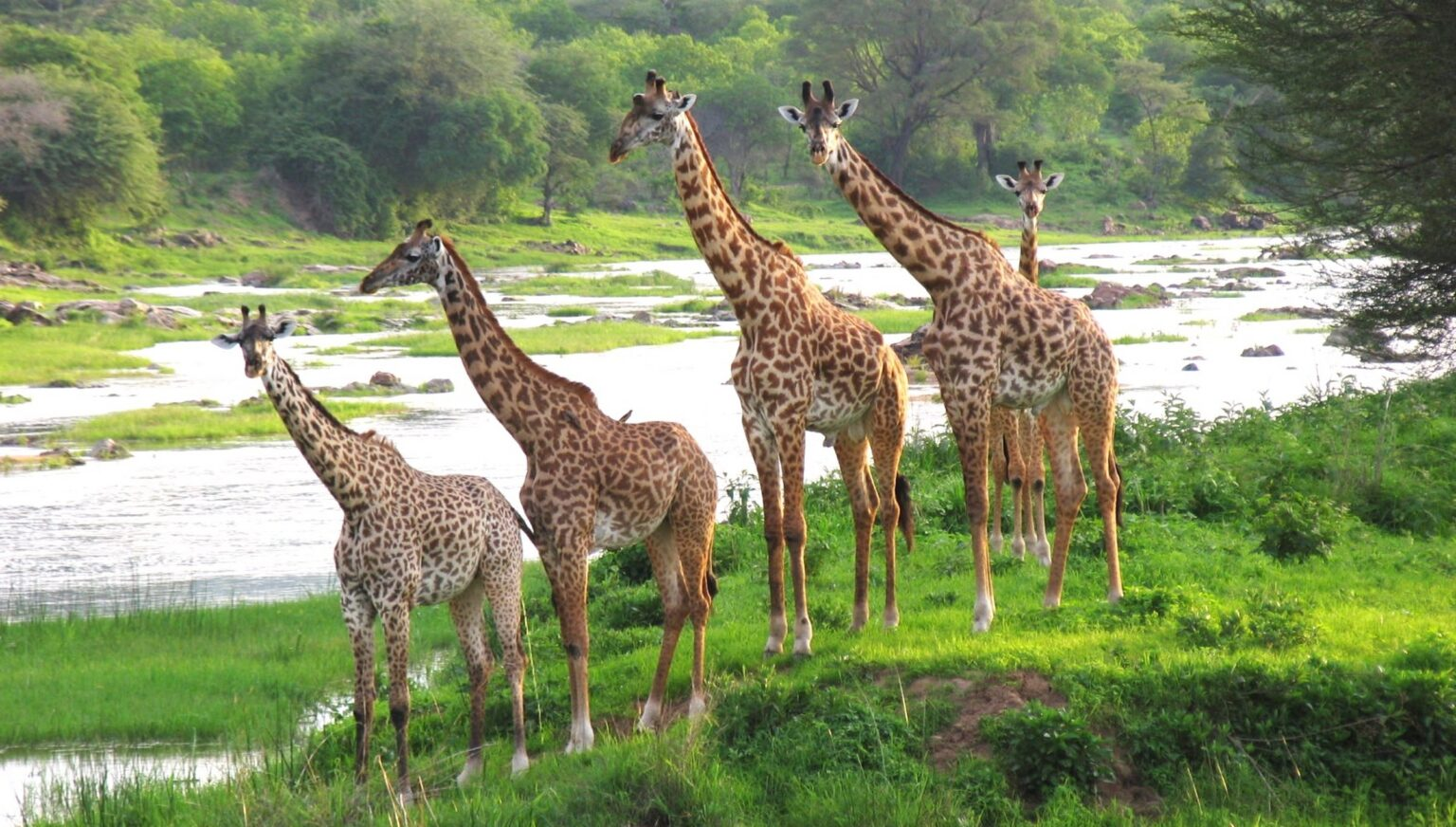
Introduction to Kenya and its Rich Wildlife
Welcome to the land of breathtaking landscapes, majestic wildlife, and vibrant cultures - Kenya! Embark on a journey filled with thrilling safari adventures in East Africa's gem. Get ready to witness nature unfold before your eyes as you explore the rich biodiversity that Kenya has to offer. From the iconic Maasai Mara to the snow-capped peaks of Mount Kenya, this is where dreams of an unforgettable safari experience come true. Let's dive into the world of Kenya Tour Safari and discover all it has in store for you!
Popular Destinations for a Safari Tour
Kenya is a paradise for wildlife enthusiasts, offering an array of popular destinations for a safari tour that will leave you in awe. One such destination is the Maasai Mara National Reserve, famous for its vast savannahs and abundant wildlife including the Big Five - lions, elephants, leopards, rhinos, and buffaloes.
Amboseli National Park is another must-visit spot known for its stunning views of Mount Kilimanjaro as a backdrop to herds of elephants roaming the plains. For bird lovers, Lake Nakuru National Park is a haven with thousands of flamingos coloring the lake pink during certain times of the year.
Samburu National Reserve in Northern Kenya offers a unique landscape dotted with acacia trees where you can spot rare species such as Grevy's zebras and reticulated giraffes. Tsavo East and West National Parks are also top choices due to their diverse habitats ranging from open plains to volcanic landscapes.
Types of Safari Tours Available
Embarking on a safari tour in Kenya offers a range of options to suit every traveler's preferences. From classic game drives in iconic national parks like Maasai Mara and Amboseli to adventurous walking safaris, the choices are diverse and exciting.
For those seeking a more intimate wildlife experience, consider a luxury tented camp safari where you can immerse yourself in nature while enjoying top-notch amenities. Alternatively, fly-in safaris provide an aerial perspective of Kenya's stunning landscapes and wildlife from the sky.
Photography enthusiasts will appreciate specialized photography safaris led by expert guides who know how to capture that perfect shot. If you're looking for something off the beaten path, cultural safaris offer a unique opportunity to interact with local communities and learn about their traditions.
No matter what type of safari tour you choose, each promises unforgettable moments and encounters with Africa's magnificent wildlife.
What to Expect on a Kenya Tour Safari
Embarking on a Kenya Tour Safari is an unforgettable adventure filled with wildlife encounters and breathtaking landscapes. Get ready to witness the iconic Big Five - lions, elephants, buffaloes, leopards, and rhinos in their natural habitats. Each day brings new surprises as you explore the vast Savannah grasslands and lush forests.
Expect early mornings for game drives when animals are most active, offering optimal viewing opportunities. The thrill of spotting a majestic lion prowling or a graceful giraffe grazing against the backdrop of Mount Kilimanjaro is unparalleled. Your experienced guide will share fascinating insights about the flora and fauna you encounter along the way.
Immerse yourself in nature's symphony with sounds of roaring lions, trumpeting elephants, and chirping birds filling your days. Witness stunning sunsets painting the sky in hues of orange and pink as you unwind after exhilarating safaris. Be prepared for rustic luxury accommodations blending seamlessly with the wilderness surroundings for a truly immersive experience.
Indulge in delicious traditional Kenyan cuisine under starlit skies while sharing stories around campfires with fellow travelers. Capture unforgettable moments on camera but remember to also cherish them firsthand without any barriers between you and nature's wonders. A Kenya Tour Safari promises not just sightings but soul-stirring connections with East Africa's wild beauty.
Best Time to Visit and Climate
When planning your Kenya tour safari, it's essential to consider the best time to visit and the climate you'll encounter during your adventure.
Kenya experiences two main seasons: dry season and wet season. The best time for a safari tour is during the dry season, which typically falls between June and October. During this period, wildlife congregates around water sources, making it easier to spot them against the parched landscape.
If you prefer lush greenery and newborn animals, then visiting during the wet season from November to May might be more suitable for you. However, be prepared for occasional rain showers that can make some roads impassable.
The climate in Kenya varies depending on the region you're visiting. Coastal areas like Mombasa are hot and humid throughout the year, while higher altitude regions like Nairobi have milder temperatures but can get chilly at night.
No matter when you choose to visit Kenya for your safari tour, remember to pack light layers, sunscreen, a hat, and insect repellent to ensure a comfortable experience amidst nature's wonders!
Cultural Experiences in Kenya
Immerse yourself in the vibrant cultural tapestry of Kenya during your safari tour. From the Maasai people's rich traditions to the Swahili coastal influences, there is a diverse array of cultural experiences to explore.
Visit local villages and interact with indigenous communities to gain insight into their way of life. Engage in traditional dances, taste authentic cuisine, and witness intricate beadwork craftsmanship firsthand.
Discover ancient tribal rituals that have been passed down through generations, offering a glimpse into Kenya's fascinating history and heritage. Take part in ceremonies and celebrations that showcase the country's deep-rooted cultural roots.
Explore bustling markets filled with colorful textiles, handcrafted souvenirs, and aromatic spices. Engage with local artisans as they demonstrate their craftmanship skills honed over centuries.
Embark on a journey of discovery as you connect with the people and cultures that make Kenya truly unique. Experience moments of genuine hospitality and warmth that will leave a lasting impression on your safari adventure.
Adventure Activities to Try on Your Safari Tour
Embark on a thrilling Kenya Tour Safari and immerse yourself in a world of adventure activities that will get your heart racing and adrenaline pumping.
Experience the rush of hot air ballooning over the vast savannah, witnessing breathtaking views of wildlife below as the sun rises. Feel like a true explorer as you trek through lush forests, tracking chimpanzees or gorillas in their natural habitat.
For water enthusiasts, try your hand at snorkeling or diving in the crystal-clear waters of Kenya's coastline, discovering vibrant coral reefs teeming with marine life. Or how about testing your fishing skills with deep-sea fishing excursions for a chance to reel in some impressive catches?
Get up close and personal with nature by going on guided walking safaris, where you can spot wildlife on foot under the guidance of experienced rangers. For those seeking an extra dose of excitement, quad biking across rugged terrains or zip-lining through treetops offer unforgettable experiences.
Embrace the spirit of adventure during your Kenya Tour Safari by participating in these thrilling activities that will create lasting memories of your East African escapade.
Tips for an Unforgettable Safari Experience
Embarking on a Kenya tour safari is an exciting adventure that promises unforgettable memories. To make the most of your safari experience, here are some essential tips to keep in mind:
Pack light and smart – comfortable clothing, sturdy shoes, sunscreen, insect repellent, and a good camera are must-haves. Be prepared for varying weather conditions by bringing layers.
Listen to your guide – they have invaluable knowledge about the wildlife and terrain. Respect their instructions for your safety and to enhance your viewing opportunities.
Next, be patient and observant – wildlife sightings can be unpredictable. Take time to appreciate the beauty of nature around you; it's not just about ticking off a checklist.
Additionally, embrace early mornings and late afternoons for game drives when animals are most active. The golden hour provides stunning lighting for photography too.
Sustainable Tourism in Kenya
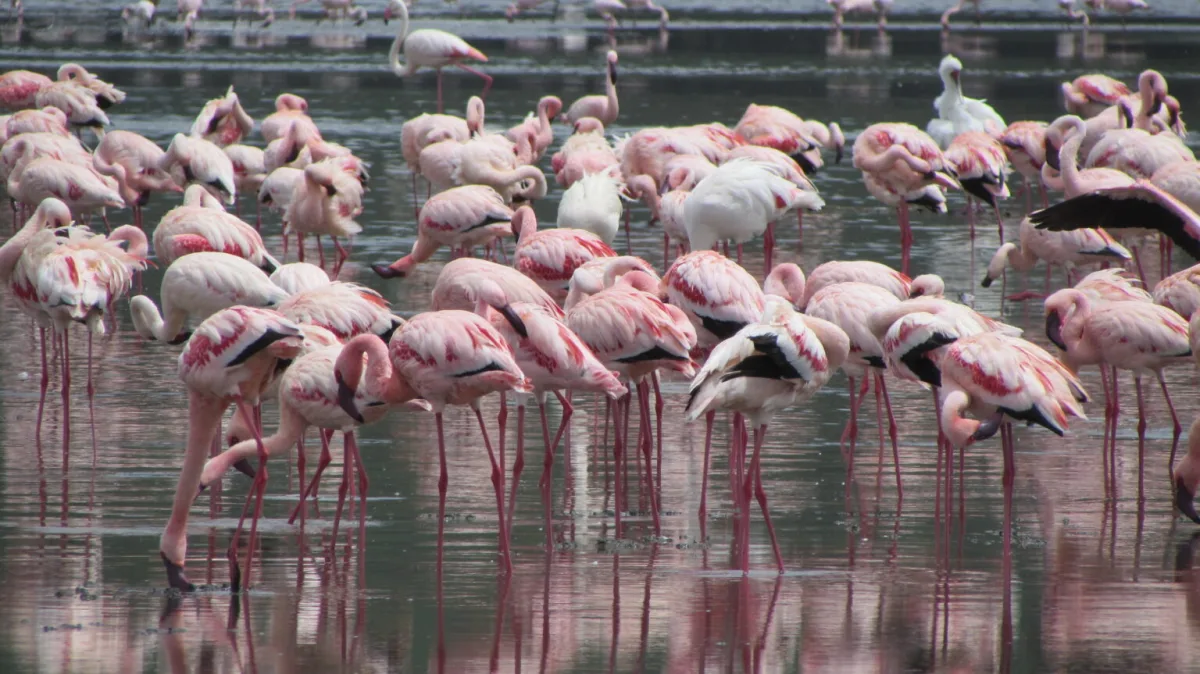
Sustainable tourism in Kenya is not just a trend; it's a way of life. By promoting responsible travel practices, the country aims to preserve its rich biodiversity and cultural heritage for future generations to enjoy.
From eco-friendly lodges that minimize their environmental footprint to community-based tourism initiatives that empower local communities, Kenya is leading the way in sustainable tourism efforts in East Africa.
Visitors can contribute to conservation efforts by choosing tour operators and accommodations that prioritize sustainability. Participating in wildlife conservancies and supporting local artisans through ethical shopping are also ways travelers can make a positive impact during their safari experience.
By fostering a deeper connection with nature and culture, sustainable tourism in Kenya offers visitors a more meaningful and authentic travel experience while ensuring the preservation of this beautiful destination for years to come.
Embarking on a Kenya tour safari is an experience like no other, where you can witness the majestic wildlife in their natural habitat, immerse yourself in diverse cultures, and partake in thrilling adventures. From the vast savannahs of Maasai Mara to the stunning landscapes of Amboseli National Park and the pristine beaches of Diani, Kenya offers something for every type of traveler.
By choosing sustainable tourism practices and respecting the environment and local communities, you can contribute to the preservation of Kenya's natural beauty for future generations to enjoy. So pack your bags, put on your safari hat, and get ready for an unforgettable adventure in East Africa with Kenya Easy Safaris !
Share this:
Leave a reply.
Your email address will not be published. Required fields are marked *
When planning a machinery production plant, the design phase holds the key to future operational efficiency, safety, and productivity. The complex nature of machinery manufacturing demands careful consideration of several critical design elements that can significantly impact the functionality and flow of the entire operation. This article will delve into the essential factors that must […]
Introduction to Kenya and its Rich Wildlife Welcome to the land of breathtaking landscapes, majestic wildlife, and vibrant cultures - Kenya! Embark on a journey filled with thrilling safari adventures in East Africa's gem. Get ready to witness nature unfold before your eyes as you explore the rich biodiversity that Kenya has to offer. From […]
Web development is a bumpy and unpredictable process that requires persistently expanded and modified knowledge and skills. Web developers are expected to keep sharpening their skills with the advancing trends and technologies that will determine the future of the web. Currently, one of the web development technologies is AngularJS, which is powerful and leading. AngularJS […]
- Latest Posts
- Privacy Policy
- Terms of Service
- Billing Terms
- Kenya Tourism
- Kenya Hotels
- Kenya Bed and Breakfast
- Kenya Vacation Rentals
- Flights to Kenya
- Kenya Restaurants
- Things to Do in Kenya
- Kenya Travel Forum
- Kenya Photos
- All Kenya Hotels
- Kenya Hotel Deals
- Last Minute Hotels in Kenya
- Things to Do
- Restaurants
- Vacation Rentals
- Travel Stories
- Rental Cars
- Add a Place
- Travel Forum
- Travelers' Choice
- Help Center
Advice on a 2025 Itinerary for the Great Migration - Kenya Forum
- Africa
- Kenya
Advice on a 2025 Itinerary for the Great Migration
- United States Forums
- Europe Forums
- Canada Forums
- Asia Forums
- Central America Forums
- Africa Forums
- Caribbean Forums
- Mexico Forums
- South Pacific Forums
- South America Forums
- Middle East Forums
- Honeymoons and Romance
- Business Travel
- Train Travel
- Traveling With Disabilities
- Tripadvisor Support
- Solo Travel
- Bargain Travel
- Timeshares / Vacation Rentals
- Africa forums
- Kenya forum

I would like to stay at 3 or 4 different spots for 2 to 4 days each for a total of 12 - 15 days. If distances are long, flying from site to site might be preferable. Our primary goal is wildlife viewing. (Not just the big 5, Not just land animals) Birds, insects, plants are all interesting. The only animals we’d go out of our way to see are African Dogs and Hippos. I realize the Selous might be better for these two. The one request from the wife would be a hot air balloon ride. We want a comfy bed, decent food and a room that’s stays cool in midday. No need for glitz and glam. The main requirement is a good guide. Our budget would max out at 1000/p/day + airfare .
Questions and Recommendations
Can I combine the Serengeti in Tanzania + the Mara in Kenya or should I just stick to one country? Why?
I believe the migration is in September, is that correct? Are any other months good for the migration?
Recommendation for an itinerary and Camps / Lodges.
Should I drive or fly between locations?
Recommendation for a reliable tour operator.
Thanks in advance for your practical advice. Since I’m not sure where we’ll go, I’ve posted this in both the Kenya and Tanzania forums.
10 replies to this topic

Hi, yes you are correct September is a good time to witness the migration which will have entered the Mara reserve at that time. It can be very busy with the amount of vehicles in the reserve during that period so it's a good idea to split your time between different parks and adding one of the Mara conservancies to your itinerary will give you a more intimate experience.
I have sent you a private message with some more information and a tour operator recommendation.
Hi Chuck19,
Sounds like an amazing trip you’ve got ahead of you! My two cents.
First, the migration is occurring year around. Depending upon the time of year, they are in different areas, but you simply “google” Great Migration Map, I am sure you can find no shortage of great info. In short, the Migration is in the northern part of the Serengeti + Masai Mara in September timeframe. Note that this is the time of year for the famed River Crossings along the Mara and Talek Rivers. One thing to note is that there’s lots of carnage this time of year along the river front so just be prepared. My favorite time for the migration is around February in the Ndutu area of the Ngorongoro Conservation Area. Lots of greenery, massive herds, lots of babies (calving season) and the Ndutu area affords you the flexibility to do some off-roading to see the more high profile species up close.
If you are keenly focused on the migration’s River Crossings, I think it’s worth entertaining the idea of visiting both the Serengeti and the Mara. The herds move between the two countries back and forth and large herds will likely be seen from both sides around Sep. If you do both Serengeti + Mara, you are effectively buying yourself insurance to increase your chances of seeing the River Crossings. Northern Serengeti is all National Parks and the river front can get moderately busy. The Mara National Reserve is public area as well and can be very congested with tourists. You can avoid the crowds by heading to the surrounding Private Conservancies, but you will have to enter the Reserve to catch the River Crossings. Mara Reserve is approx. 300,000 acres. Surrounding Private Conservancies add an additional approx. 300,000 acres (areas between the Reserve and Conservancies are unfenced so you get great wildlife density in the private areas).
Driving v. flying: depends on the areas you are looking to combine. Generally speaking, lots of northern Tanzania is driven. But northern Serengeti’s Mara Sector is quite remote so you should definitely fly there (Kogatende or Lamai airstrips). A good TO can advise you on the benefits of flying v. driving dependent upon lodges chosen. I’m a proponent of flying when possible.
I recommend you start your trip in Tanzania as you won’t be required to show proof of Yellow Fever vaccination if you do Tanzania first (you will have to show proof if you enter Tanzania from Kenya). Tanzania is mostly National Parks and can get quite busy this time of year so I suggest you start there for the Migration only and do the rest of your safari in Kenya where access to private land is more abundant and economical.
1 night Arusha upon arrival (lots of options here, but I like Villa Maua for a more economical option)
3 nights northern Serengeti (Nasikia Mobile Migration Camp will work well for your budget)
3 nights Mara North Conservancy (I think Offbeat Mara will work well for you or Elephant Pepper)
3 nights Sosian (also owned by Offbeat) and has good consistent Wild Dog viewing
3 nights Ol Pejeta for northern species and rhinos (Ol Pejeta Safari Cottages will work well here)
I hope this is a good starting point.
Kota Tabuchi – Managing Director: Africa – Travel Beyond
I’m an unabashed and vocal fan of the Mara conservancies, but I think for the OP who is going to the Mara specifically for the migration, I’m not sure I’d recommend staying only there. First, it’s an additional drive to/from wherever in the Reserve the migration activity is, like river crossings, and second with the proposed $200 pppd Reserve fees going into effect, that’s a substantial extra fee on top of a conservancy fee they’d already be paying. I’d recommend time in the Reserve proper for the purposes of easier access to the migration herds and river crossings, and then time in a conservancy to enjoy more “slow safari” with the rest of what the Mara has to offer without the maddening crowds and exorbitant extra costs.
It goes without saying that Mother Nature has no schedule or rule book. The herds may not be where your are and they may not do what you’re hoping to see. The best you can do is plan and hope for the best.
Good call, Amybatt! What do you think about my suggestion of combining the public area/Serengeti NP with a Mara Conservancy? Most camps will include the Mara Reserve fee based on a 3+ night stay and some camps, like Offbeat Mara, are quite close to the Reserve. I think the combination of Serengeti National Park and southern Mara North Conservancy (MNC) will work well, especially with the sequencing of Serengeti -->MNC.
Kota Tabuchi - Managing Director: Africa - Travel Beyond.
What about the Masai Mara Triangle as an option? Quieter than the main reserve I understand.
Could be combined with Tanzania and other places that have been suggested.
Kota, I’ve found that over the last few years camps are moving away from the “one trip into the Reserve for everything 3 nights” to the point where it’s not even suggested. It seems they feel that generally there is more than enough wildlife in the conservancies that there’s no need to go to the Reserve. Kicheche is one, Offbeat is another that charge extra now for that (at least according to their published rates, I haven’t bothered to ask to go when I’m there). I believe even Porini charge extra for that now too.
I personally wouldn’t consider going to Tanzania just for a few days. I shared a vehicle with a couple who did the transfer from the Serengeti to the Mara and I would not bother based on the hassle and length of time it took them. Maybe you have a more efficient way of doing it, but as they described it, it was not something I’d want to do.
You are 100% right about the additional fees for the Mara Reserve with Kicheche and Offbeat. Thanks for keeping me honest!
Kota Tabuchi - Managing Director: Africa - Travel Beyond
Thanks for all the helpful answers. I’m glad I posted in both forums as I got some nicely varied responses in each.
I’m not locked in to September, but it would be special for my spouse. Ideally, I’d like to see river crossings, but I realize nature follows its own schedule.
One question based on answers. Conservancy vs Reserve: Beyond the extra fees are there differences in wildlife viewing.
Some answers to specific questions.
National Parks or Game Reserves are protected areas in Africa, often for wildlife protection/resource management, that are operated by the country’s national government or local council. Generally speaking, National Parks and Game Reserves are more laxed on the number of tourists entering said park with relatively inexpensive fees and relies on higher volume tourism to generate revenue. Meaning, some areas of National Parks and Game Reserves can get quite busy with general tourists and one must be quite selective in the chosen camps/lodges to avoid their exposure to mass tourism. Furthermore, most National Parks and Game Reserves impose fairly strict regulations on do’s and don’ts. In most cases, you will be restricted to the designated road networks and not permitted to off-road or night drive. Walking safaris areas are limited.
Private Conservancies/Concessions on the other hand are often land leased or bought by private entities (such as lodge holding companies, conservation organizations etc.) from the local communities or government to set up safari operations. As these safaris are conducted on private land, the conservancies can control and restrict the number of people in their concession and manage the number of vehicles per sighting (usually max 3) to allow for a more exclusive experience. In most cases, one can off-road, night drive in search for nocturnal species, and depending upon the camp, participate in an array of active safari options such as walking, biking, canoeing, boating, horseback riding, quad biking etc. In short, there’s more exclusivity and flexibility in terms of activities. In many cases, private land is adjacent or bordering National Parks or Game Reserves without fence lines delineating the two areas. This allows many private concessions/conservancies to enjoy the abundant wildlife viewing often synonymous with National Parks/Game Reserves without the crowds and restrictions.

The conservancies on the other hand, only allow the vehicles from the conservancy to game drive so there is much less vehicle/human traffic in the conservancies. The conservancies also have limits to the number of vehicles at sightings. Because there is less vehicle traffic in the conservancies they can allow off-roading to view sightings and also night drives. Off-roading is not allowed in the national parks. The experience in the conservancies will likely be more like the experience at a place like Mala Mala.
I read that seeing river crossings is one of your desires. If you go to Kenya I suggest you spend part of your time in the Mara Triangle. Technically part of the Maasai Mara National Reserve it operates with rules similar to the conservancies. It has great game viewing in the base case, great access to the river crossings of the Mara River and is far less crowded than the main part of the Mara Reserve (or the Serengeti for that matter.) People often combine time in the Triangle with time in one of the conservancies.
Note- during actual river crossings of the Mara river, whether in the northern Serengeti or the Mara Reserve there will likely be lots of vehicles on the river banks...30-40 on each river bank is common. Some people are offput by this circus.
- Visiting Maasai Mara for the 1st time 3:27 pm
- E-sim for communication 3:17 pm
- Hot air Balloon ride booking 6:13 am
- 3 days in Nairobi. 5/24 recommendations for car rental? 5:57 am
- Elsa's Kopje Layout today
- Walkable distance in city today
- Lake Nakuru vs Ark or change sleep location or change nothin today
- Advice on a 2025 Itinerary for the Great Migration yesterday
- Hotel near Wilson or NBO yesterday
- Citizenship change question yesterday
- Waterlovers or Monkey Suites Apr 15, 2024
- Visa question Apr 15, 2024
- eTA on iPhone Wallet Apr 15, 2024
- Taxi transfer Apr 15, 2024
- do i really need yellow fever vaccination? 5 replies
- Is Transit Visa required if NOT leaving Nairobi airport 21 replies
- Visa on Arrival for Indian Nationals 7 replies
- Elephant orphanage 10 replies
- Safari clothing colours 8 replies
- Is there a better time of day to take malarone 5 replies
- Kenya's electrical plug socket type? 4 replies
- what to wear on safari 2 replies
- Kenya Airlines good or bad? 40 replies
- Intrepid Travel - Miselading Pricing re Trip Kitty 18 replies
Kenya Hotels and Places to Stay
- A guide to some of the most popular tented camps and safari lodges
- What will the weather be like?

I went on a budget and a luxury safari in Africa. Here's how they compare — and the one thing you really need to look for when booking.
Posted: March 14, 2024 | Last updated: March 14, 2024
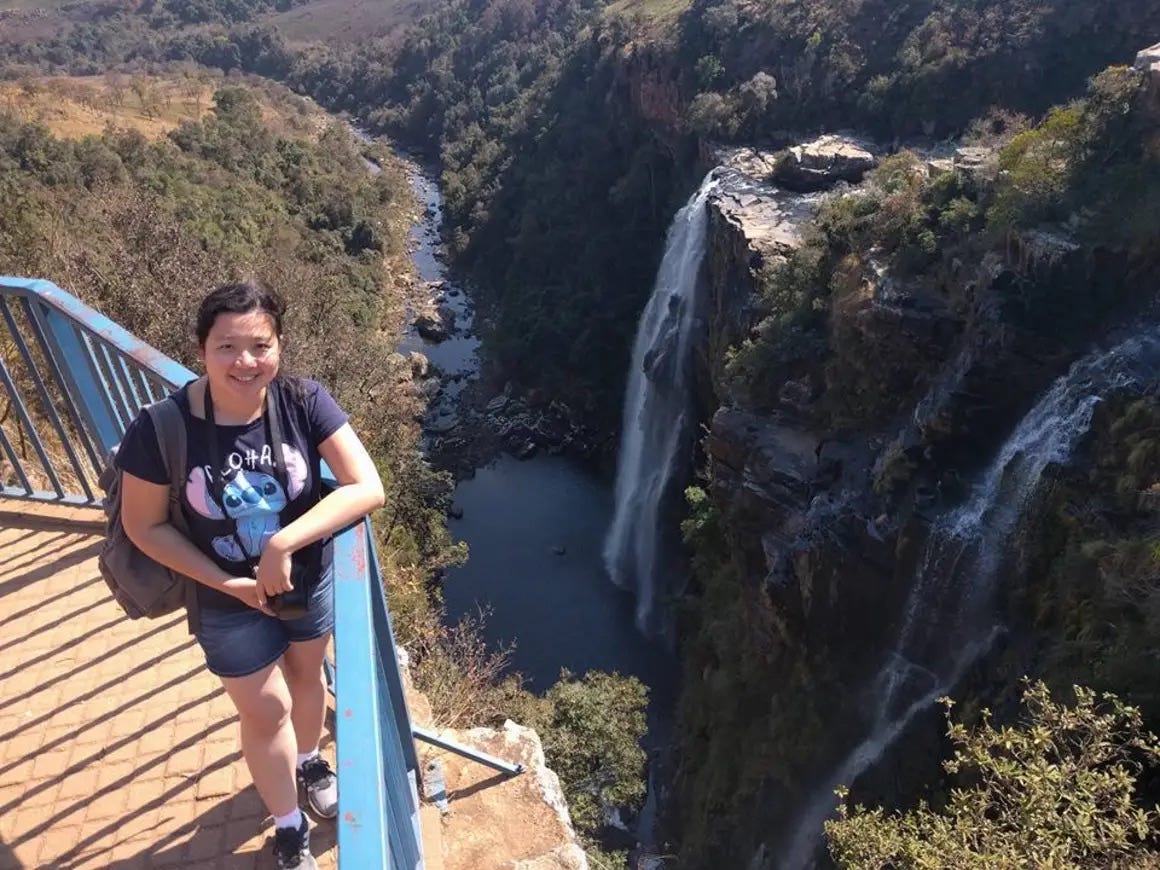
- I have been on two glamping safari trips in Africa on two very different budgets.
- My all-inclusive stay was great but my cheaper glamping experience was fine, too.
- Private game reserves are actually the most important thing to splurge on, not accommodations.
I've been on two African safari trips . Both involved glamping but on completely different budgets.
My first more affordable trip, a lodge in South Africa with separate safari excursions, cost me about $1,100. My second, an all-inclusive lodge in Tanzania, cost me about $4,000 after a 50% off deal.
Here's how the two compare and what I think you should look for before you plan an African safari .
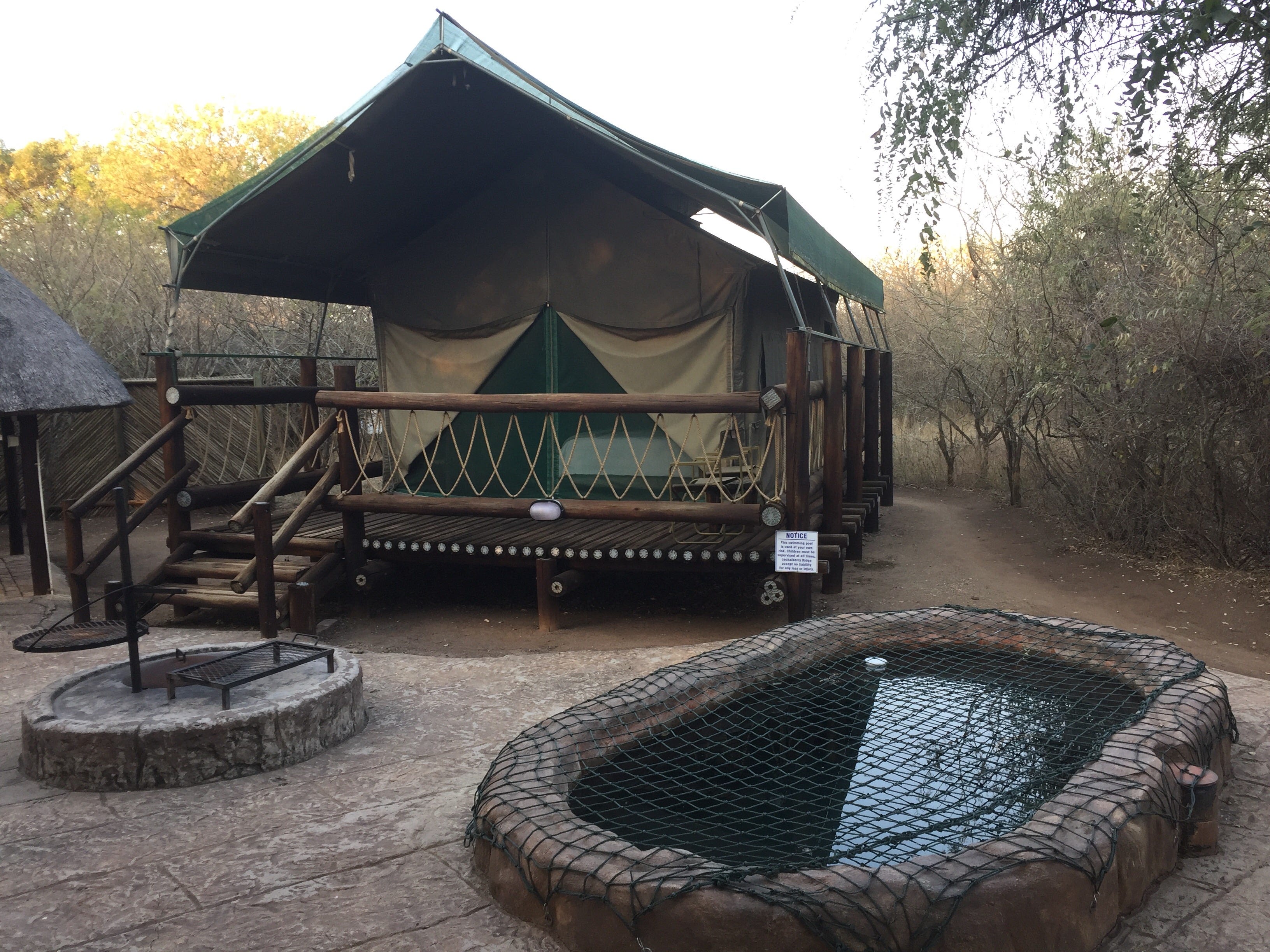
My affordable safari experience was at Jackalberry Ridge, where some tents cost $80 a night.
The first time I went on a safari, I went to Kruger National Park in South Africa. I didn't book a tour package, instead opting to stay at affordable lodging and book safari day trips to the park.
I stayed five nights near Kruger and one night in Johannesburg before my flight home. I spent around $1,100 for lodging, safari tours, a rental car, and food (not including flights).
After landing in Johannesburg, I rented a car ($130 for five days) to drive to my lodging in Marloth Park, a town bordering the edge of Kruger National Park.
I was staying at Jackalberry Ridge , a self-catering accommodation with no on-site restaurant, no room service, and limited housekeeping.
The one-bedroom tents at Jackalberry Ridge go for as low as $80 a night, and two-bedroom tents go for $135.
When I checked in late, there was no one at the reception desk — just an envelope with my name on it containing my keys and a map.
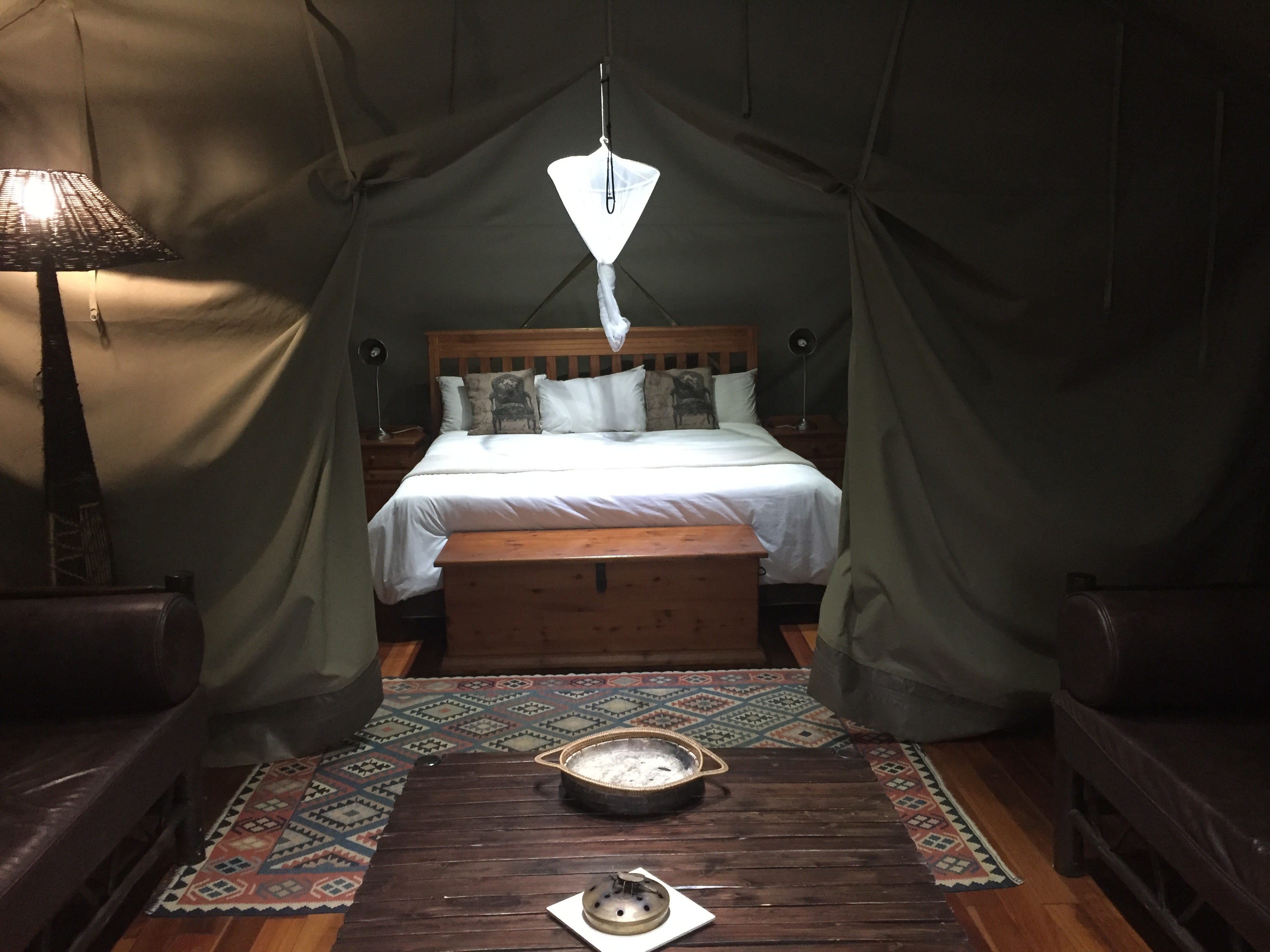
My main tent felt pretty spacious, with a king bed and a living-room area.
I had booked a two-bedroom unit (two tents), but my friend couldn't come at the last minute. Since I couldn't change the reservation, I still stayed in the two-bedroom unit and my friend paid her share.
The campsite came with a small pool to dip in, but it was covered as the weather was pretty cold.
Each unit had a private bathroom and kitchen in a building separate from the tents, so I needed to leave my tent to use the bathroom at night.
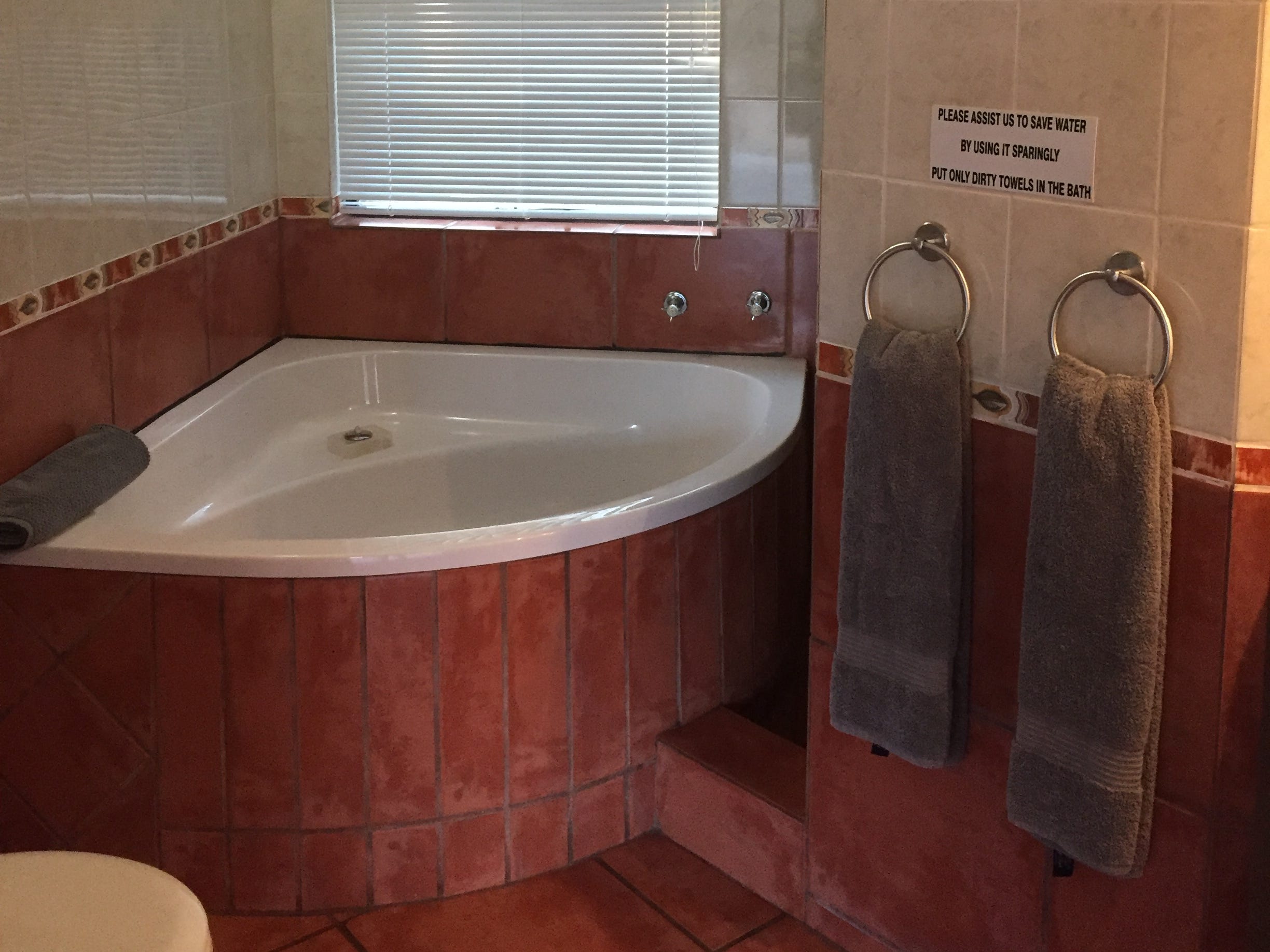
The bathroom was standard, with a tub, shower, and toilet.
This is glamping, so I had access to running water and a flushing toilet. I had hot water, but I found it went from scalding hot to cold in a few seconds.
I ended up taking quick showers and just washing my hair with cold water, which wasn't ideal since it was a little chilly in the morning.
It's also worth noting that Jackalberry Ridge was renovated recently, so the issue I had with hot water may have been fixed now.
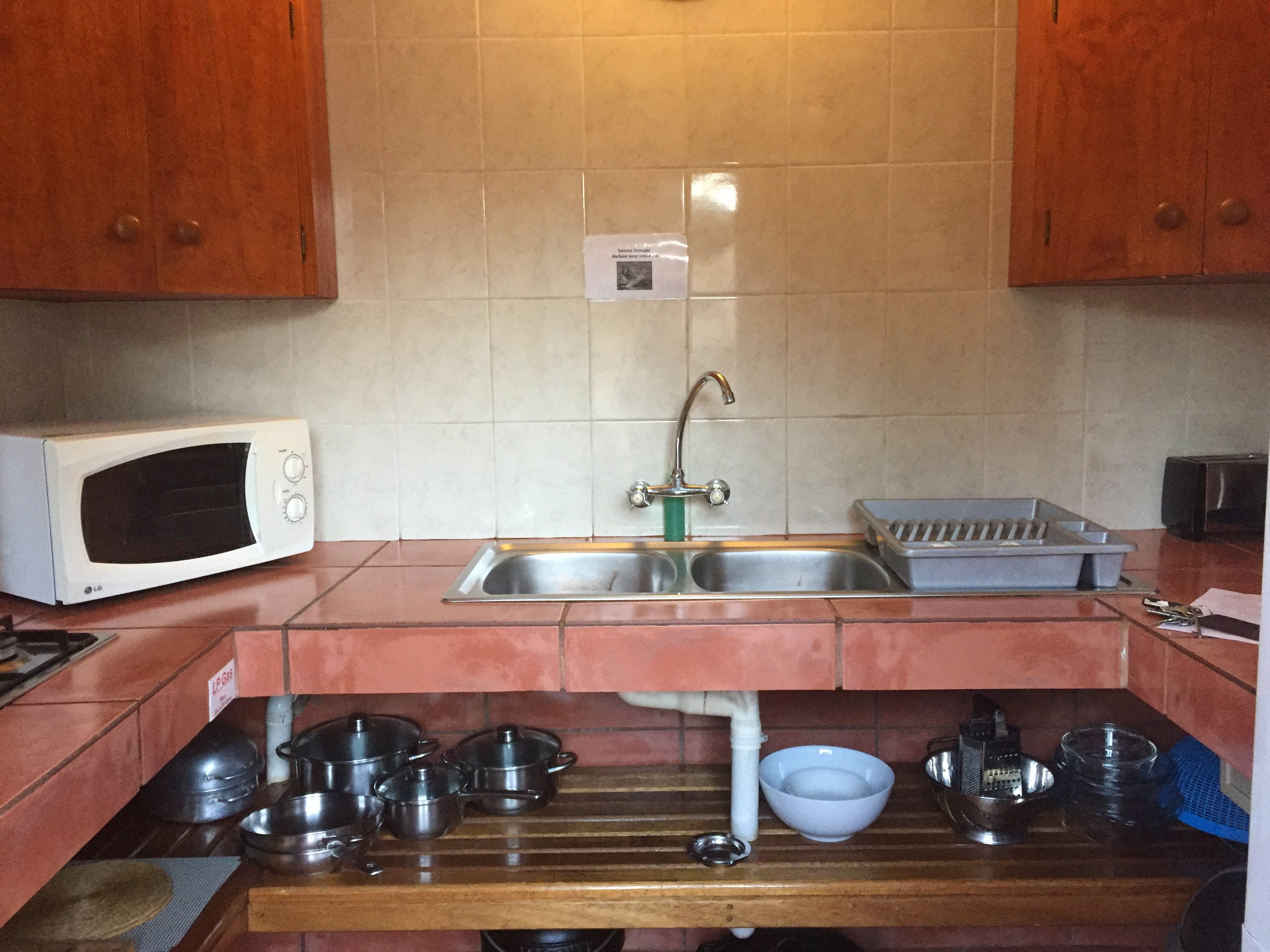
I also had access to a kitchen in the same building as the bathroom.
The kitchen was well-equipped with things like pots, a microwave, and a sink, so I could cook meals or heat up leftovers.

I signed up for a couple of day safaris and did one at night.
Although I had a rental car and could've done a self-drive safari around Kruger, I didn't trust myself to spot animals while focusing on the roads.
Instead, I signed up for a couple of day safaris and one night safari. The safari tour prices often don't include the park entrance fee (about $25 per person per day), which I paid when I got to the entrance.
My three safari trips and park fees came to around $280.
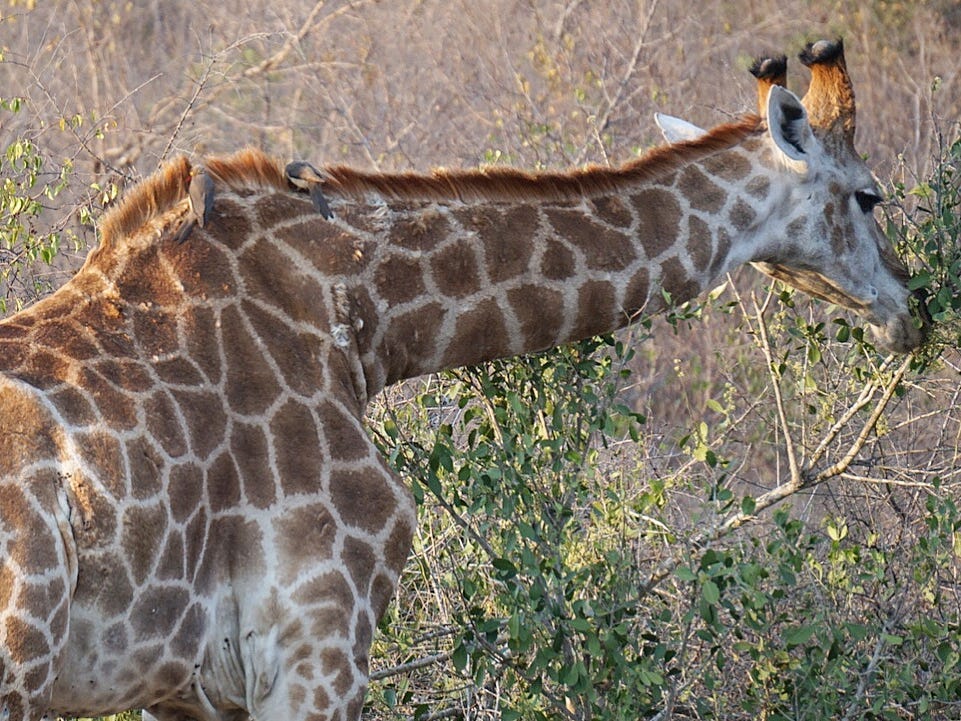
I got to see zebras, giraffes, and more.
I saw a lot on the safari, including zebras, impalas, kudus, and giraffes. I saw lions and a leopard, although only from afar with binoculars. I even got a glimpse of the elusive rhinoceros.
I also spent one day taking another popular day trip in the area, the Panorama Route. This scenic road goes past Lisbon Falls and the beautiful Blyde River Canyon. The guided tour was $110.
As far as my very first safari trip goes, it was great. I got to see the Big Five , even though some of them were pretty far away.
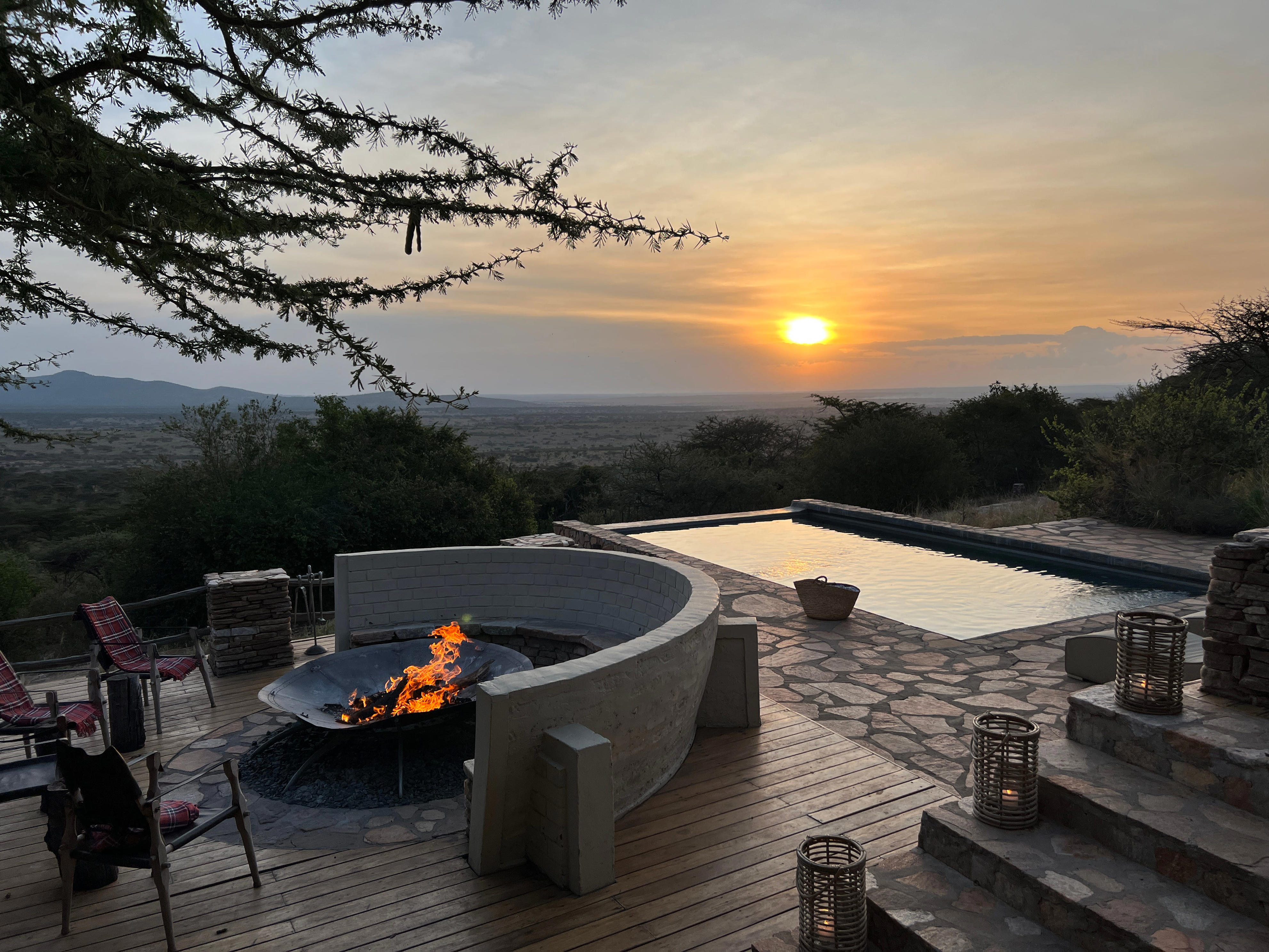
For my next safari trip, I leveled up.
I saw a Travelzoo deal for an all-inclusive safari at Taasa Lodge , a five-star luxury safari in Tanzania.
The deal was $6,000 for two people for a whole week — the lodge is usually $12,950 for two for seven nights. It was still a splurge, but I'd be saving more than 50% on a bucket-list experience.
The package came with seven nights of lodging, two safari activities a day, three daily meals, and drinks.
Still, we spent more than the original advertised price. There are obligatory "daily government park fees" and "daily concession fees" that added about $893 per person to our bill.
We also had to take a regional flight to get to Taasa, which was more expensive than my rental car in South Africa.
To redeem the Travelzoo deal, we had to complete our booking through a specific travel agency.
We ended up opting for an all-inclusive add-on package which includes the $893 fees above, domestic airfares from Arusha to Taasa (which would already cost around $600), and our agency arranging our Tanzanian tourist visa and airport transfers. The add-on also included extra activities at the resort (more on that later).
Overall, we paid $1,715 per person on top of the $3,000 each for the lodge stay.
I hadn't anticipated paying so many extras, but it was nice to have someone take care of the logistics of getting to the resort.
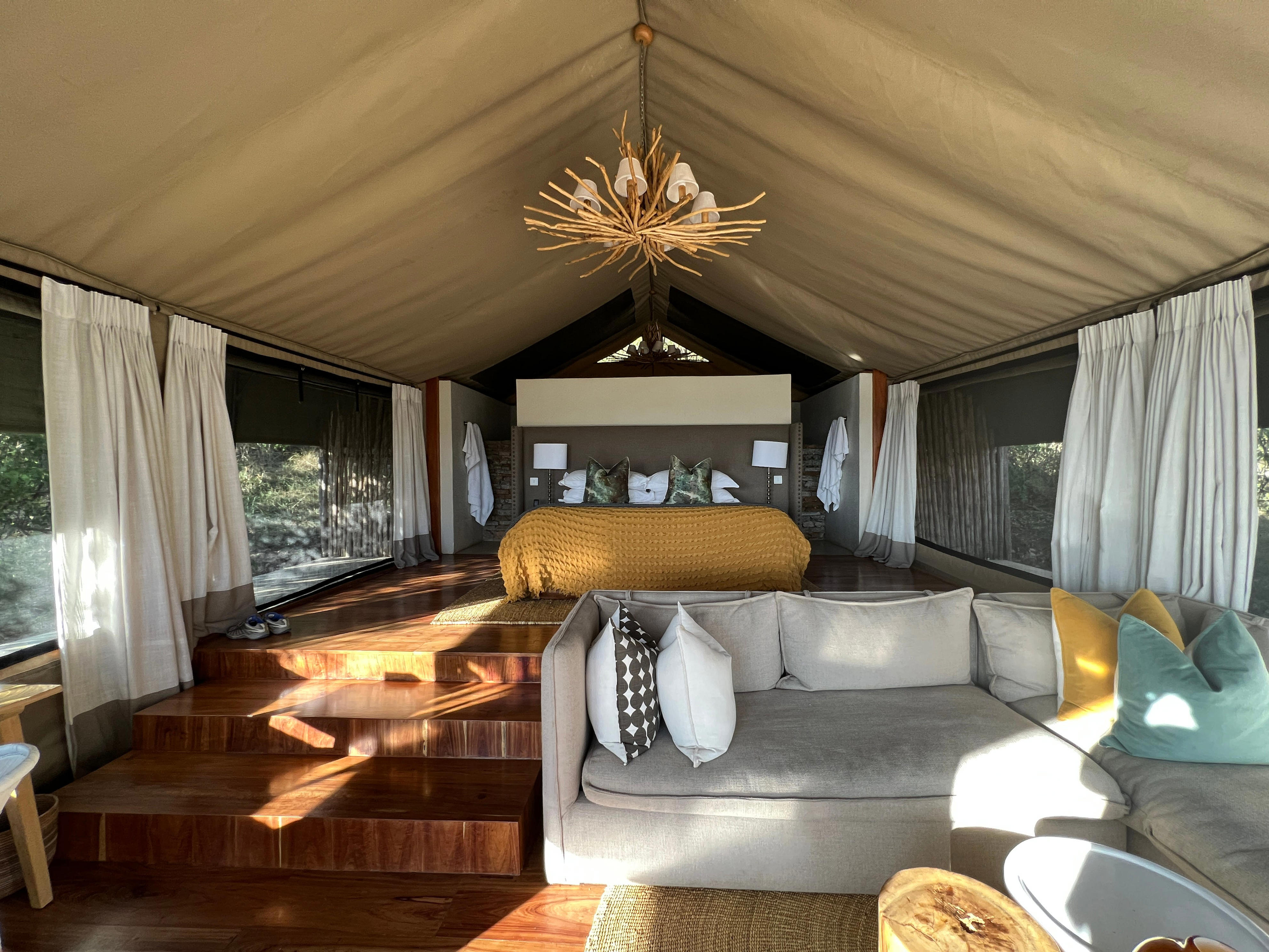
My tent was luxurious and equipped with a comfortable king bed and a large living room.
When I arrived at the lodge, the staff greeted me with a glass of juice and a wet towel to refresh myself.
My tent was quite spacious. I especially liked that it had a desk and plenty of outlets I could use to charge my electronics. Our bathroom was behind our bed, and I was glad it was inside the tent this time.
We also got a butler who kept track of our schedules and made sure we had what we needed.
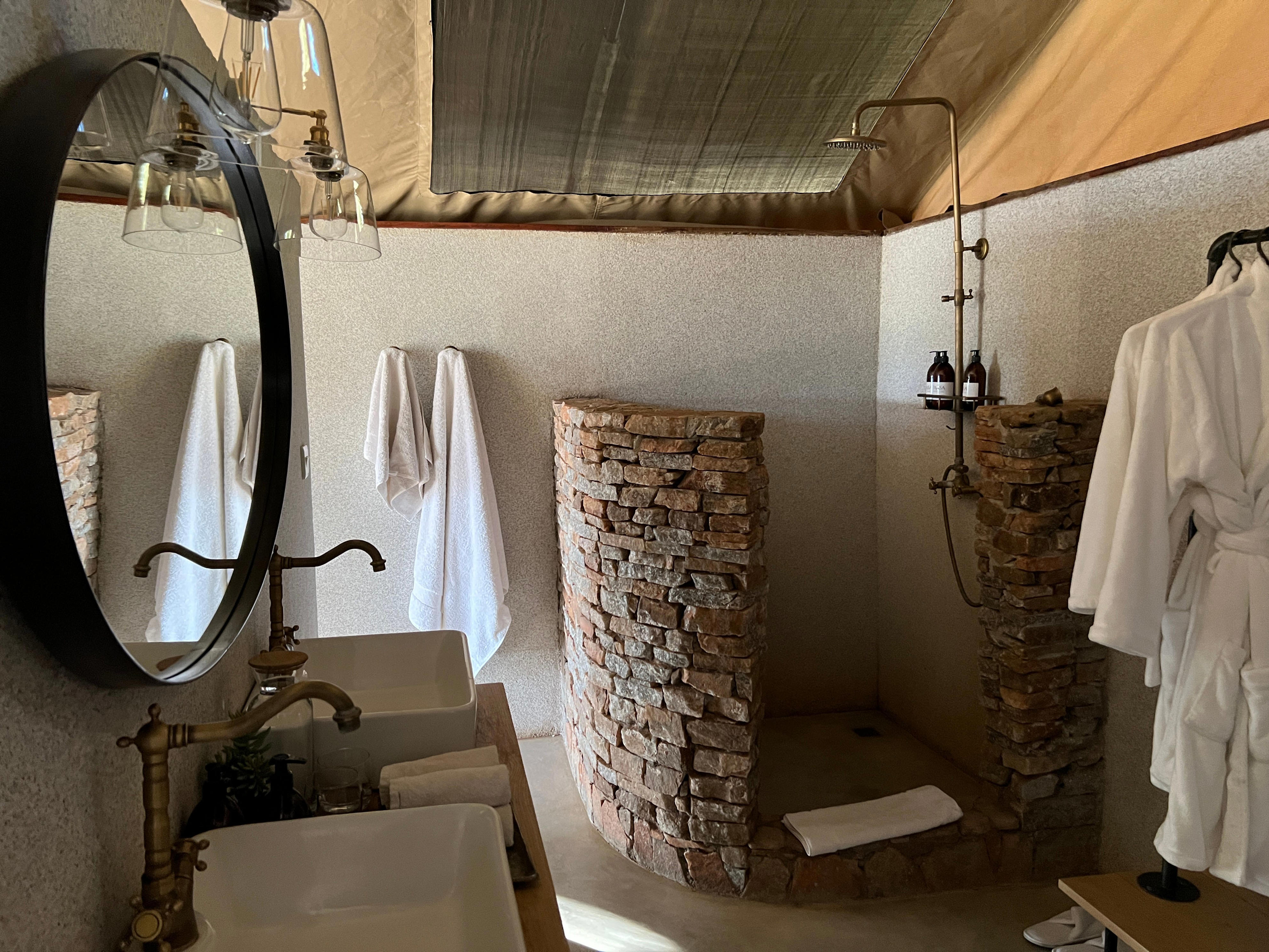
The bathroom felt spacious, with two sinks and a shower.
The shower's hot water was great and we had double sinks we could get ready at.
Another perk of the lodge is that we could have staff do our laundry every day, which meant we could pack less clothing.
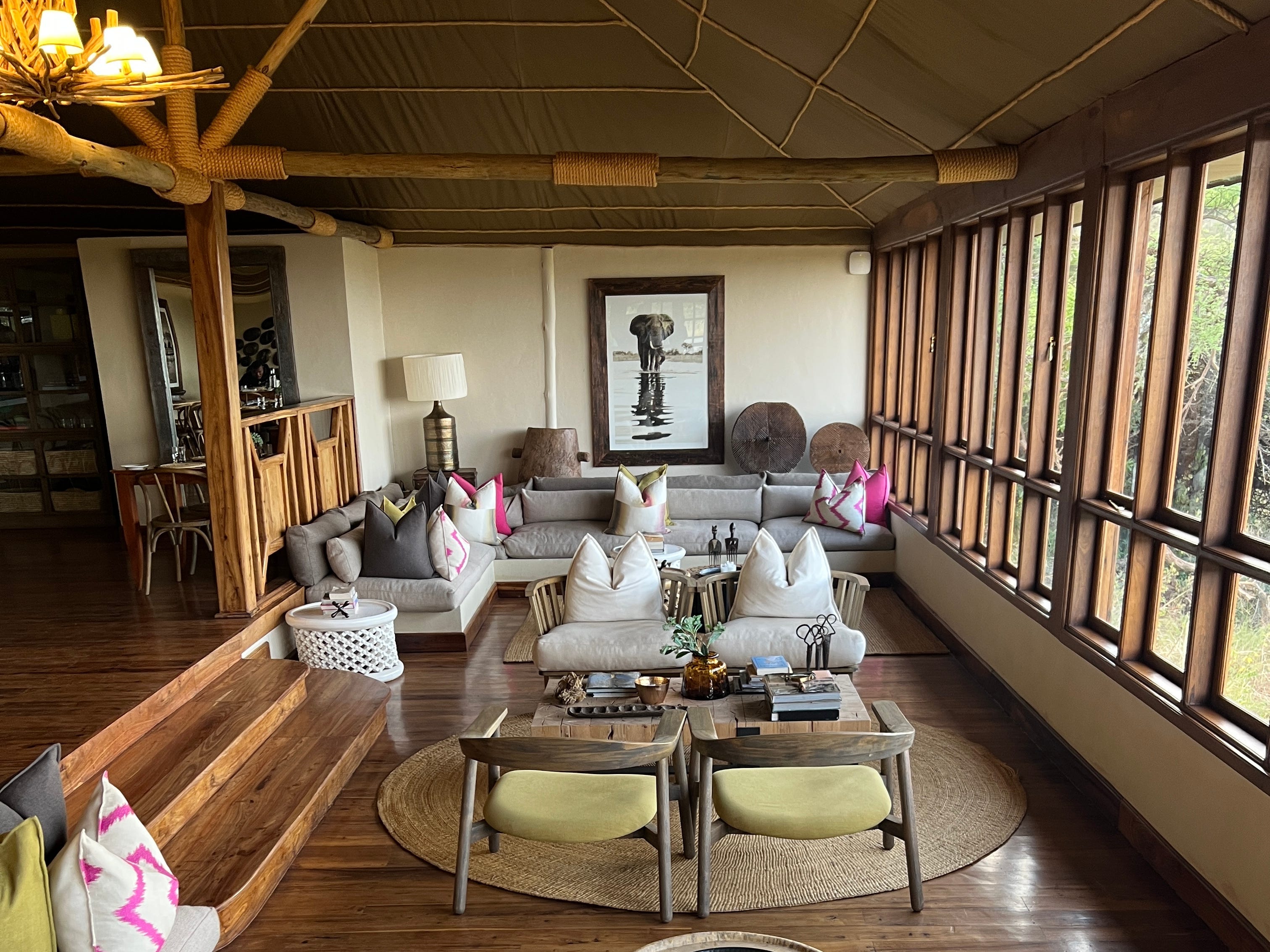
There's a main lodge with a communal living room, dining area, and bar.
We got breakfast at the buffet in the main lodge unless we were going on a morning safari.
Most people ate dinner in the dining room, but we could've requested to have food brought to our tent.
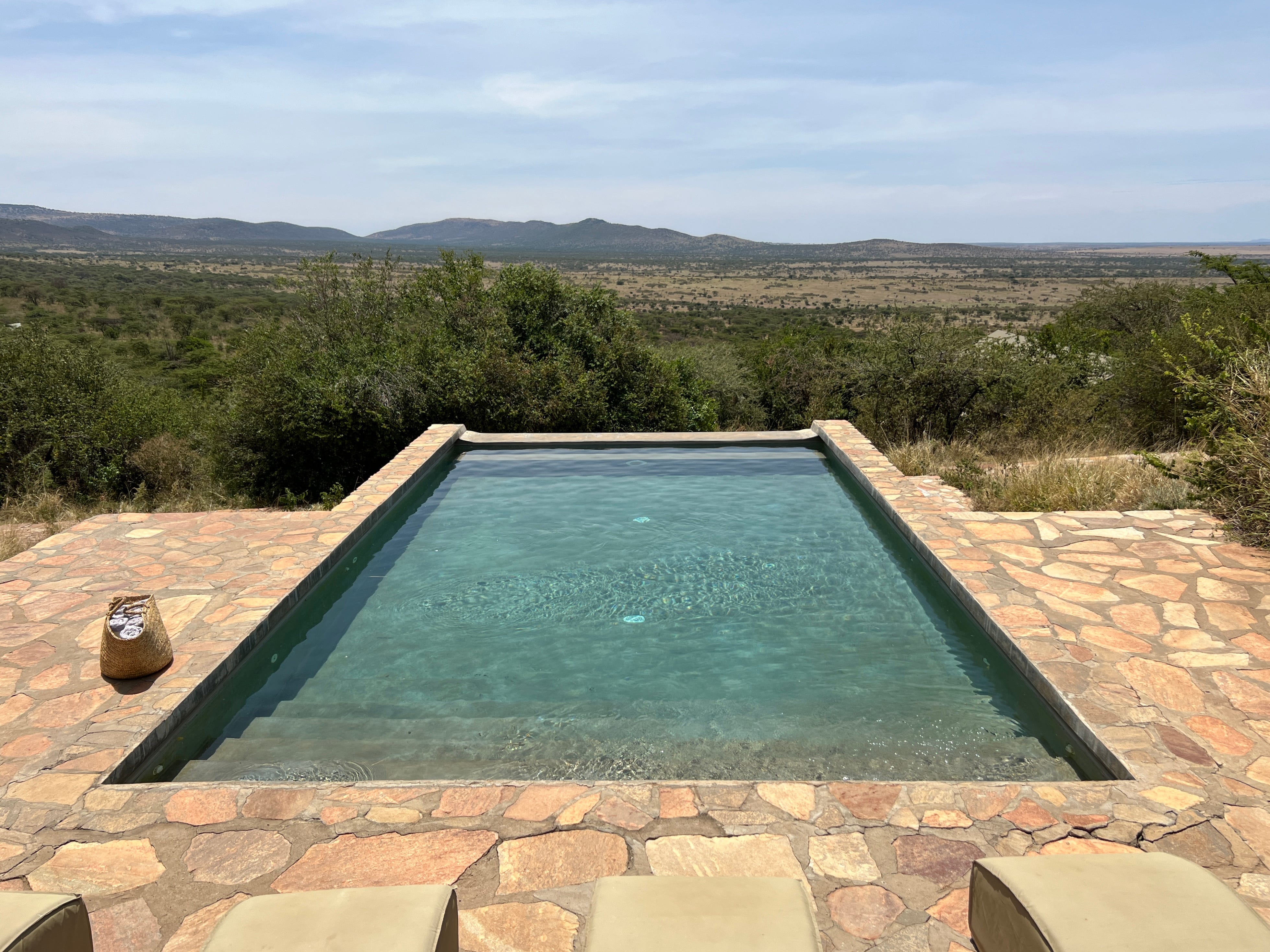
We also passed a small pool next to the main lodge.
The pool was on the small side, but certainly had great views.
I didn't end up using it as my afternoons were filled with safari, and the mornings and evenings were chilly.
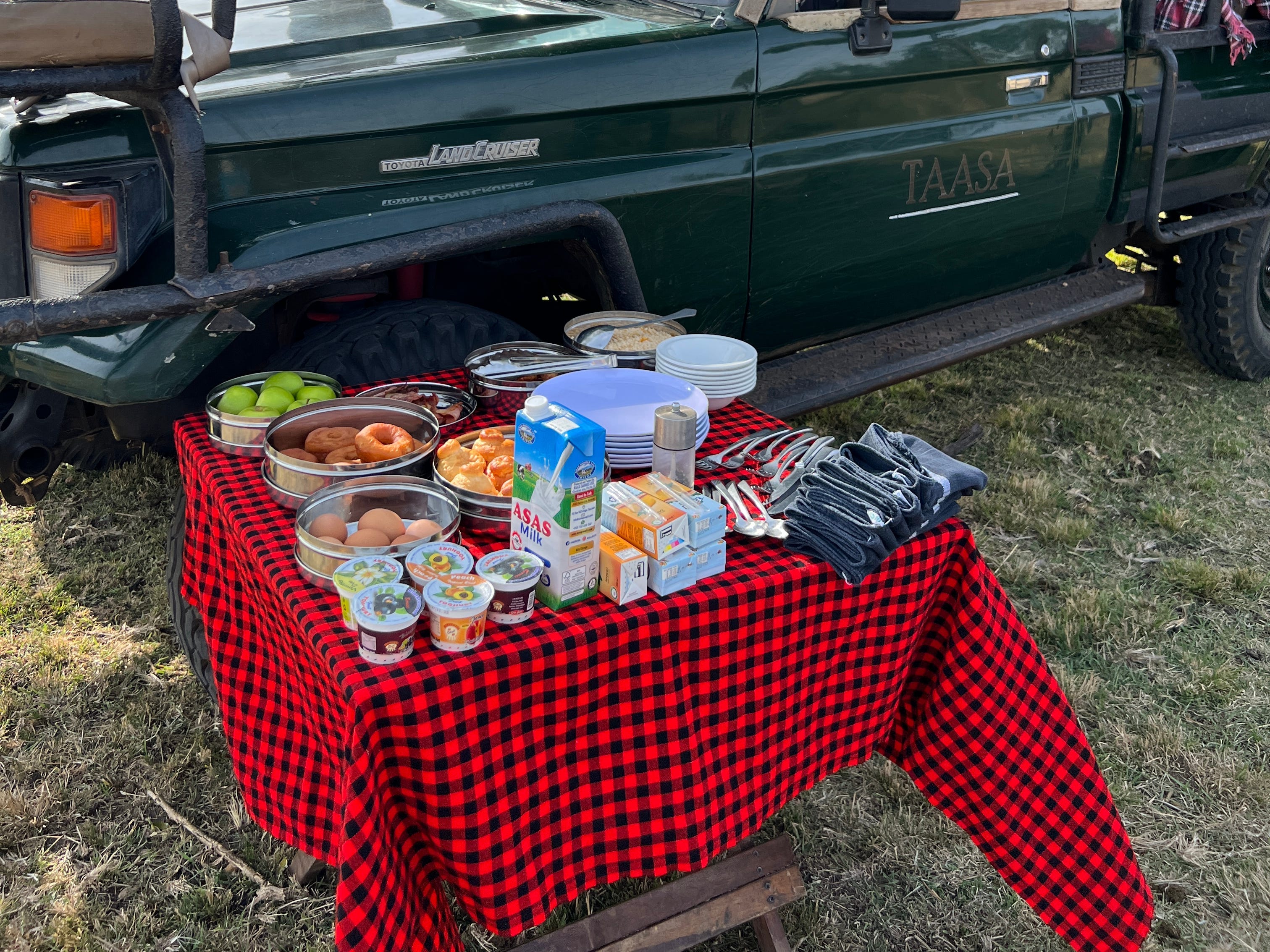
On the mornings with an early safari, we had a simple breakfast next to our Land Cruiser.
Safari breakfasts consisted of hard-boiled eggs, yogurt, doughnuts, bacon and sausage, fruits, and orange juice. Staff also made French-press coffee, which we could spike with cream liqueur.
Our Land Cruiser had a cooler of beers and sodas in the back, too.
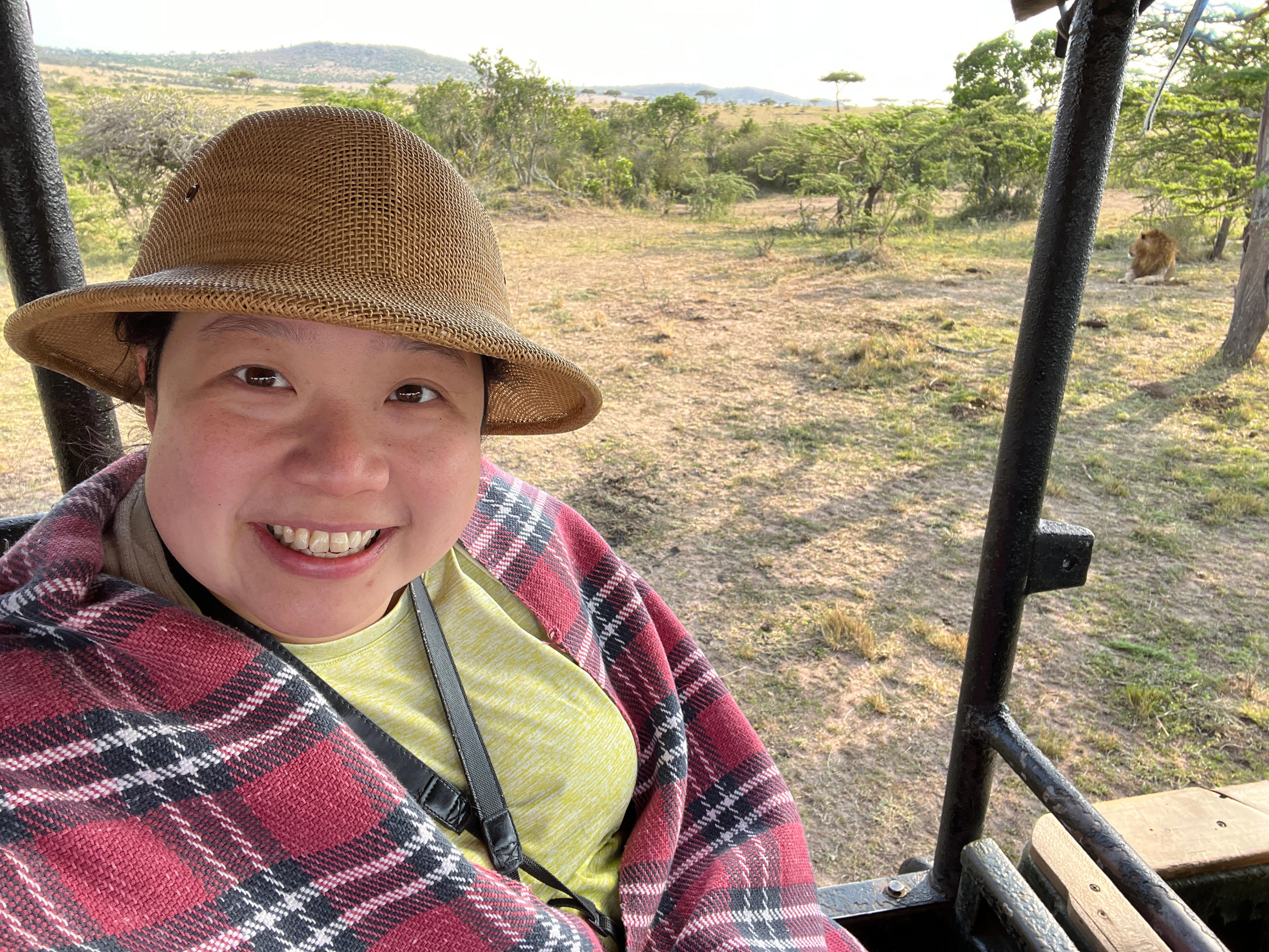
At the private game reserve, we got pretty close to wildlife.
Taasa is located inside a private game reserve, which means staff can pretty much drive anywhere within it. This was a huge leg up from my day trips in Kruger National Park on my last safari.
Inside national parks like Kruger or Serengeti, you're only allowed to drive on designated roads for safety reasons (both for the tourists and the animals).
But in a private reserve, guides can drive offroad. Plus, the guides communicate with each other when they find something special.

We saw a bunch of animals in the private reserve and Serengeti.
We also left the reserve to spend a couple of days going into Serengeti National Park, as there were things you could only find there instead of within the private reserve.
For example, I'd planned my trip to take place during the Great Migration, and I wanted to see wildebeests crossing the Mara River.
We also went to Serengeti to find rhinoceros and hippopotamus.
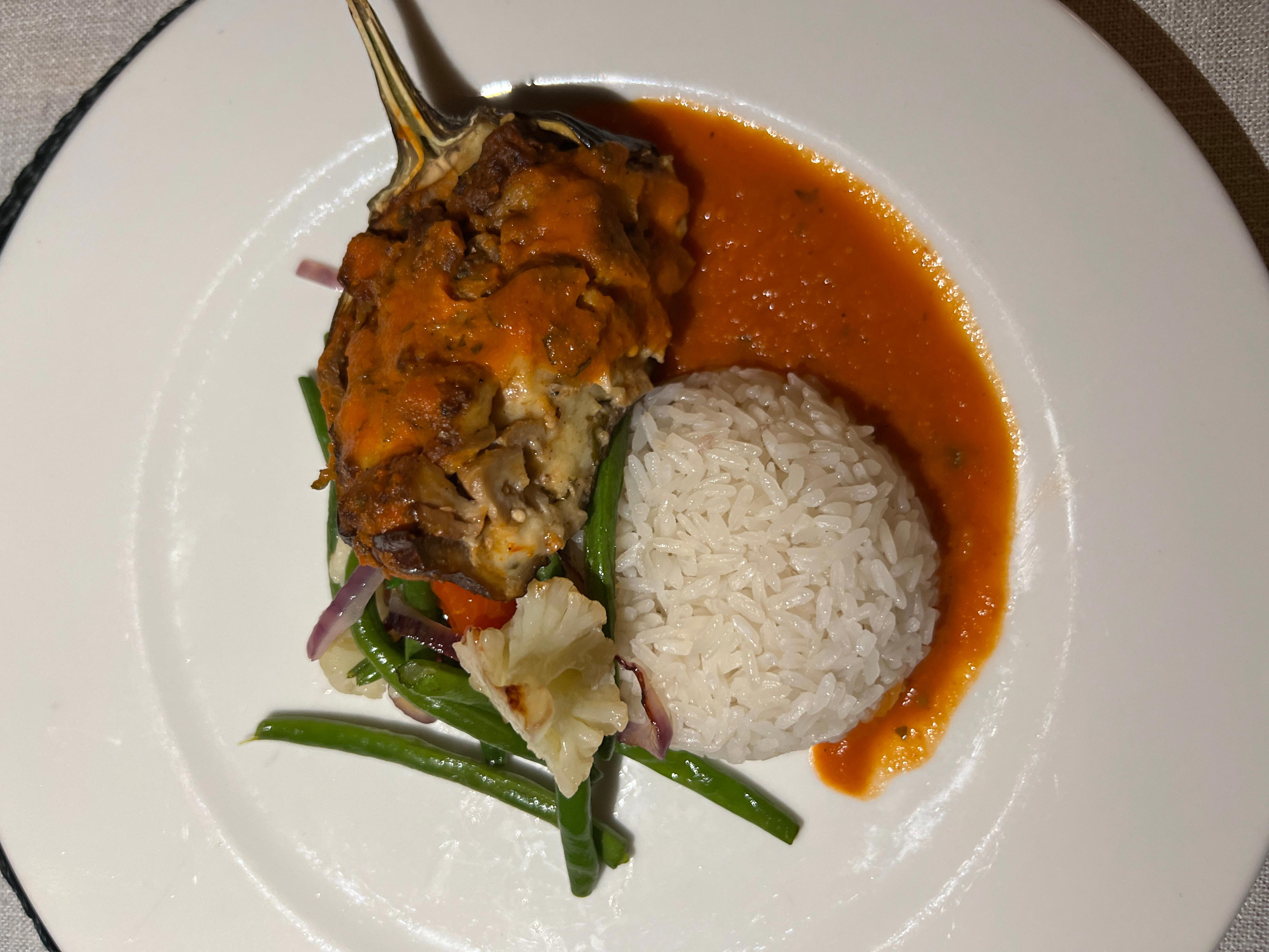
Every dinner at the resort consisted of three courses: soup, an entrée, and a dessert.
The main course was usually some type of Western food, and there was always a vegetarian option.
It would've been nice to be offered more typical Tanzanian dishes, though. For me, part of the fun of traveling is learning about different countries' cuisines.
I also had access to an open bar in the main lodge. Staff could make simple cocktails, and there was lots of beer and wine. The drinks were all included with the price of the stay (except for fancy Champagnes and select wines).
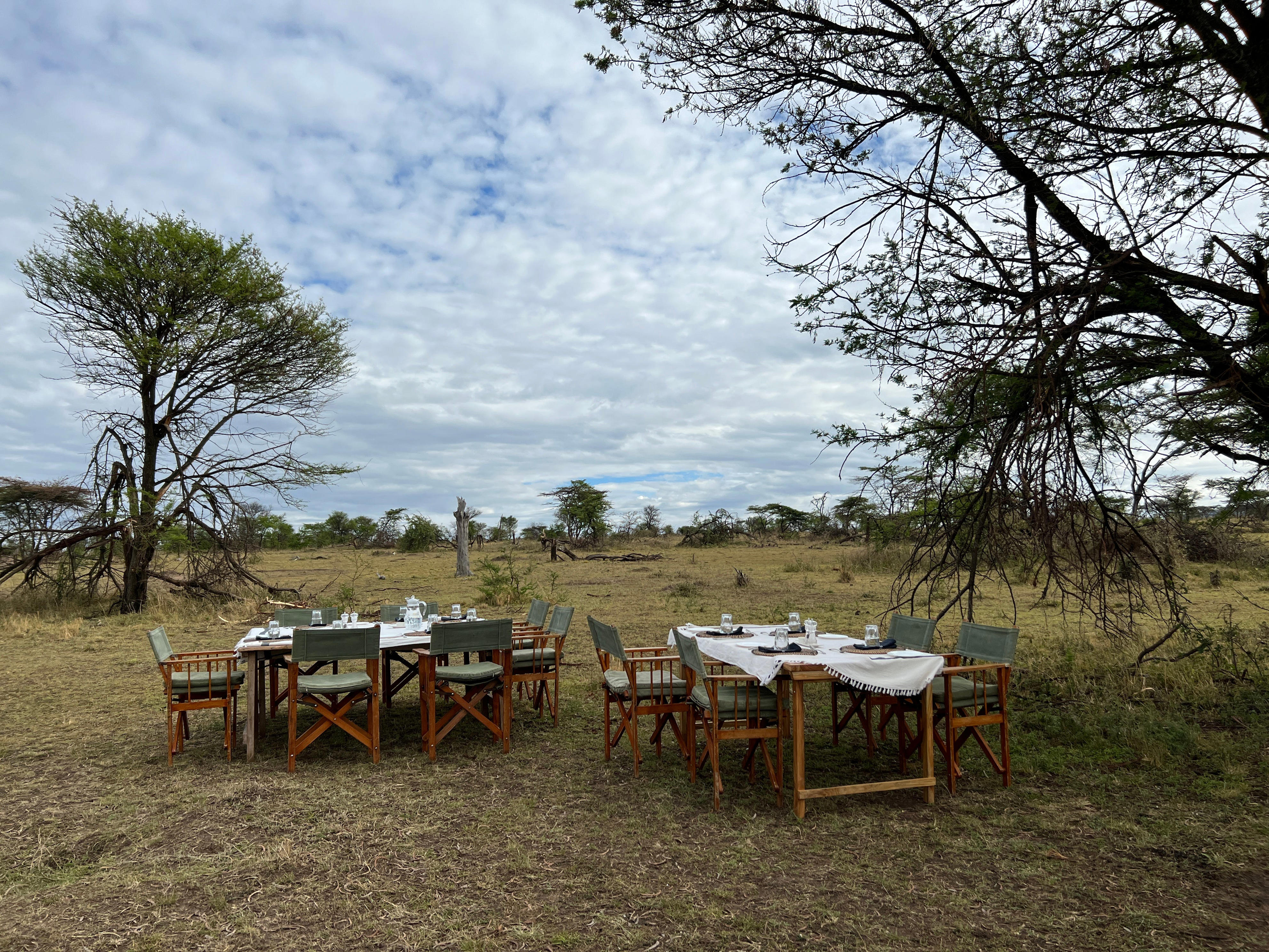
One morning, we had a special breakfast on the plains.
On one day of the trip, we had a special bush breakfast. It was one of the extra activities we got with that special add-on package.
Instead of our usual safari breakfast, we had freshly prepared omelets in the wild.
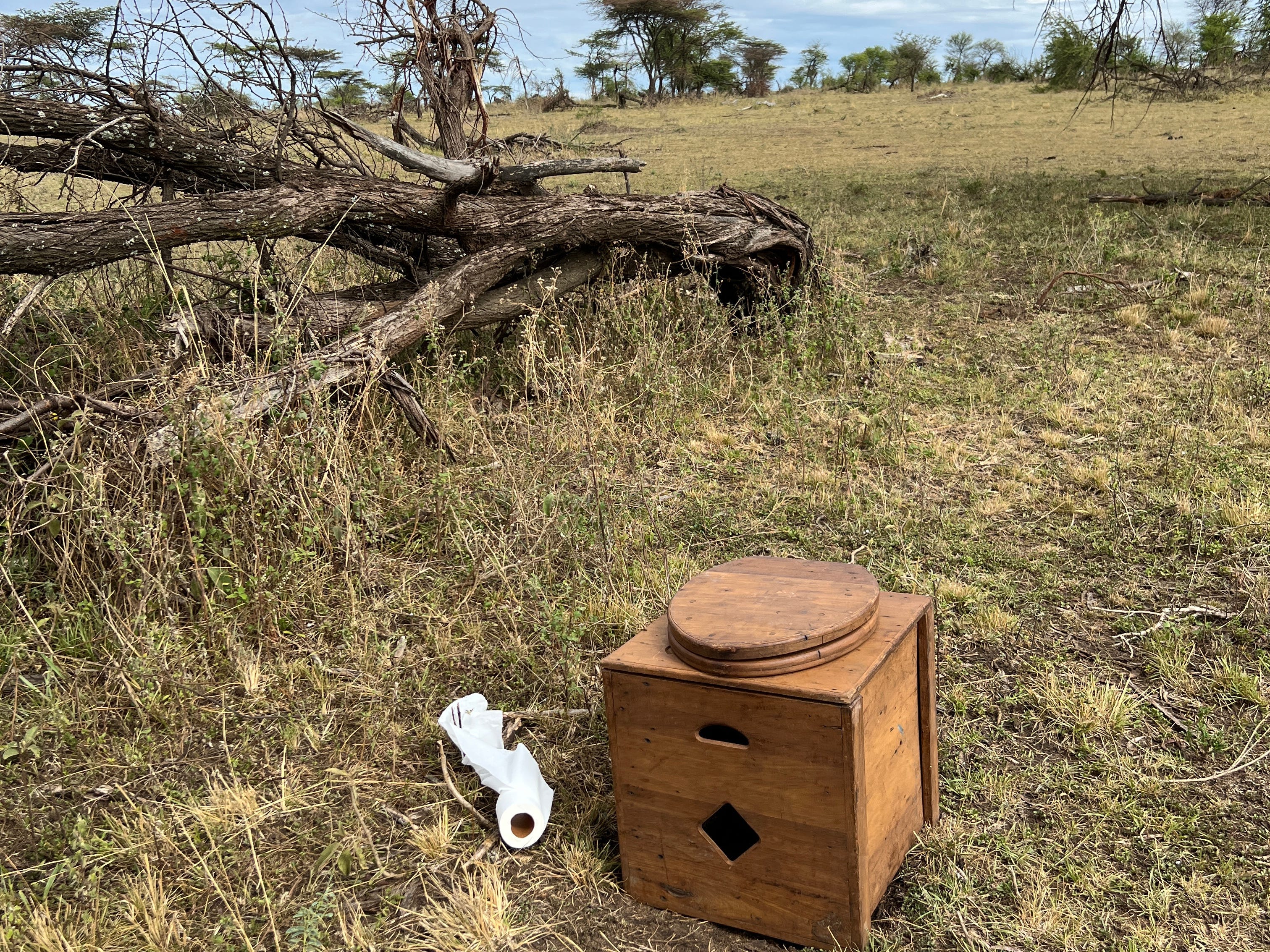
We also got another special treat in the bush that morning — a toilet!
When you're offroading looking for wild animals, you can end up pretty far from a proper toilet.
On most safari days, the car stops (when guides think it's safe), and people go behind the car to do their business.
This was the only time we had this portable toilet while out on a safari. On my budget safari day trips at Kruger, we'd have to wait until we reached a rest-stop facility.
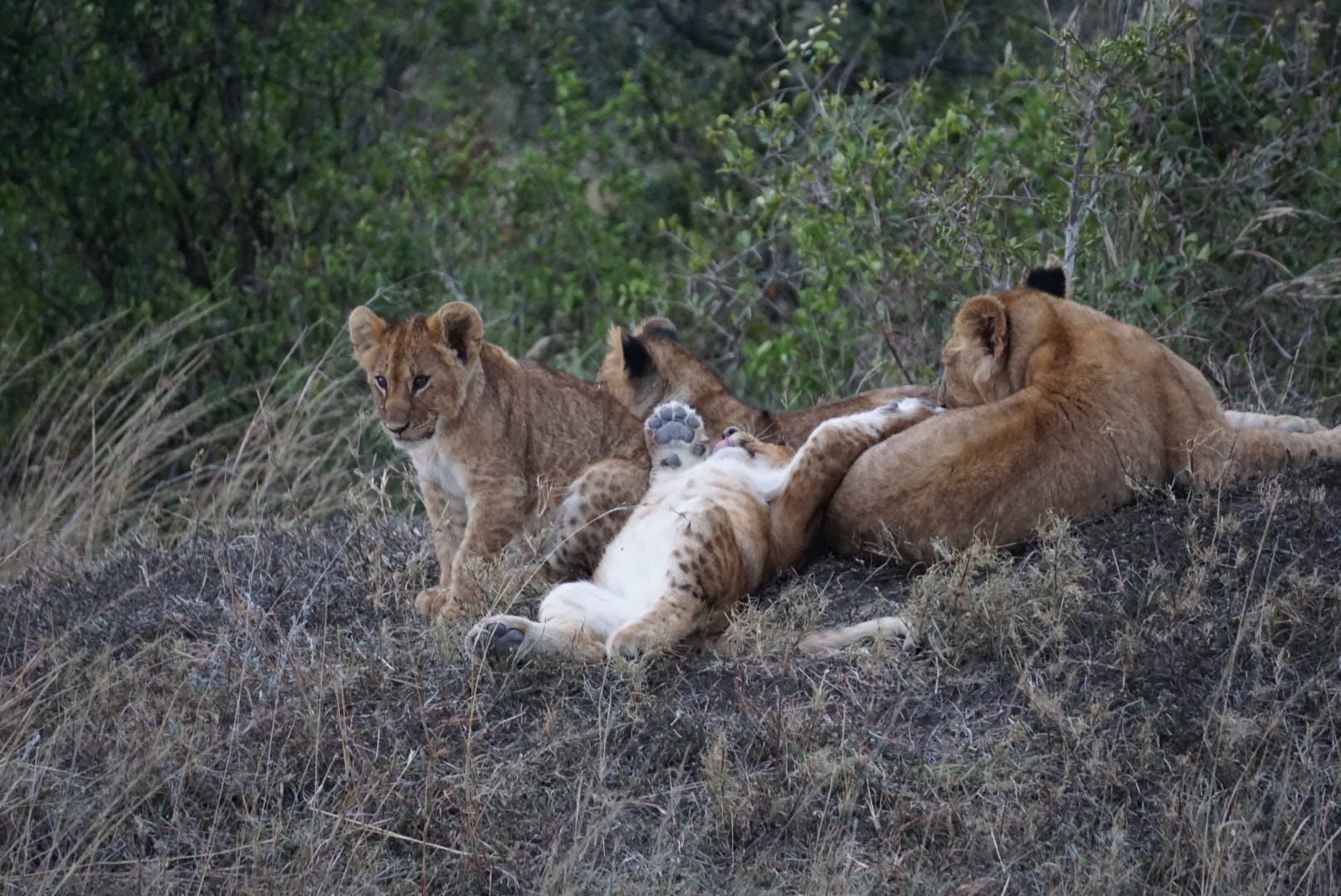
Again, we spent a lot of time watching lions.
After breakfast, we were back in safari mode.
We found a family of lions, and as we were in the private reserve, we were able to stay and watch the cubs play for quite a while.
At Kruger, when lions are spotted, traffic starts backing up on the road as all the safari cruisers stop to look, so you can't stay too long.
Here, we knew no one else would be coming.
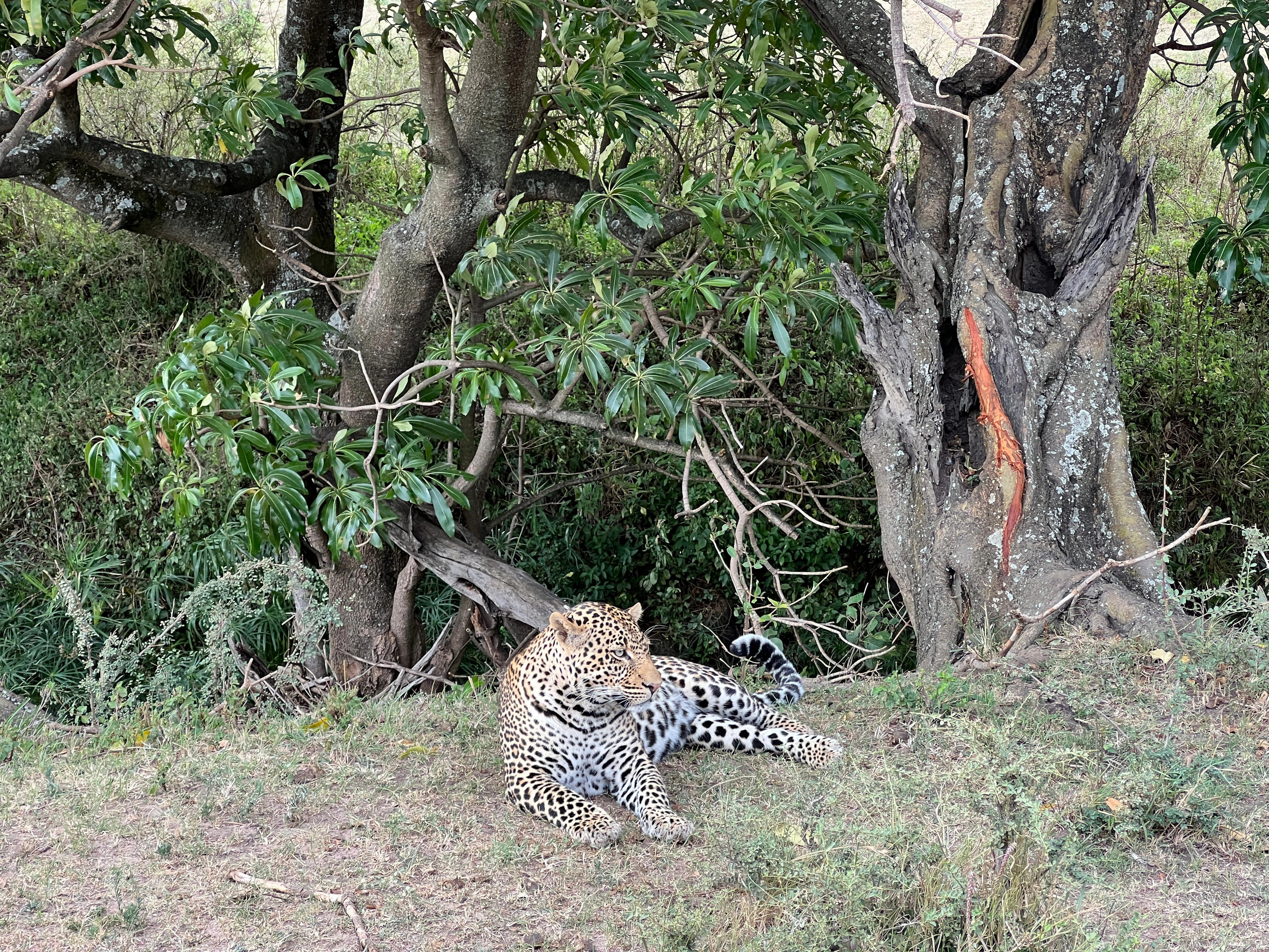
On a different morning, our guide got a tip that another car had found a leopard sleeping.
The communication between guides in the private reserve paid off when one spotted a sleeping leopard.
When our group arrived, the leopard was napping on the tree next to his catch. Eventually, it came down, and we got a better look.
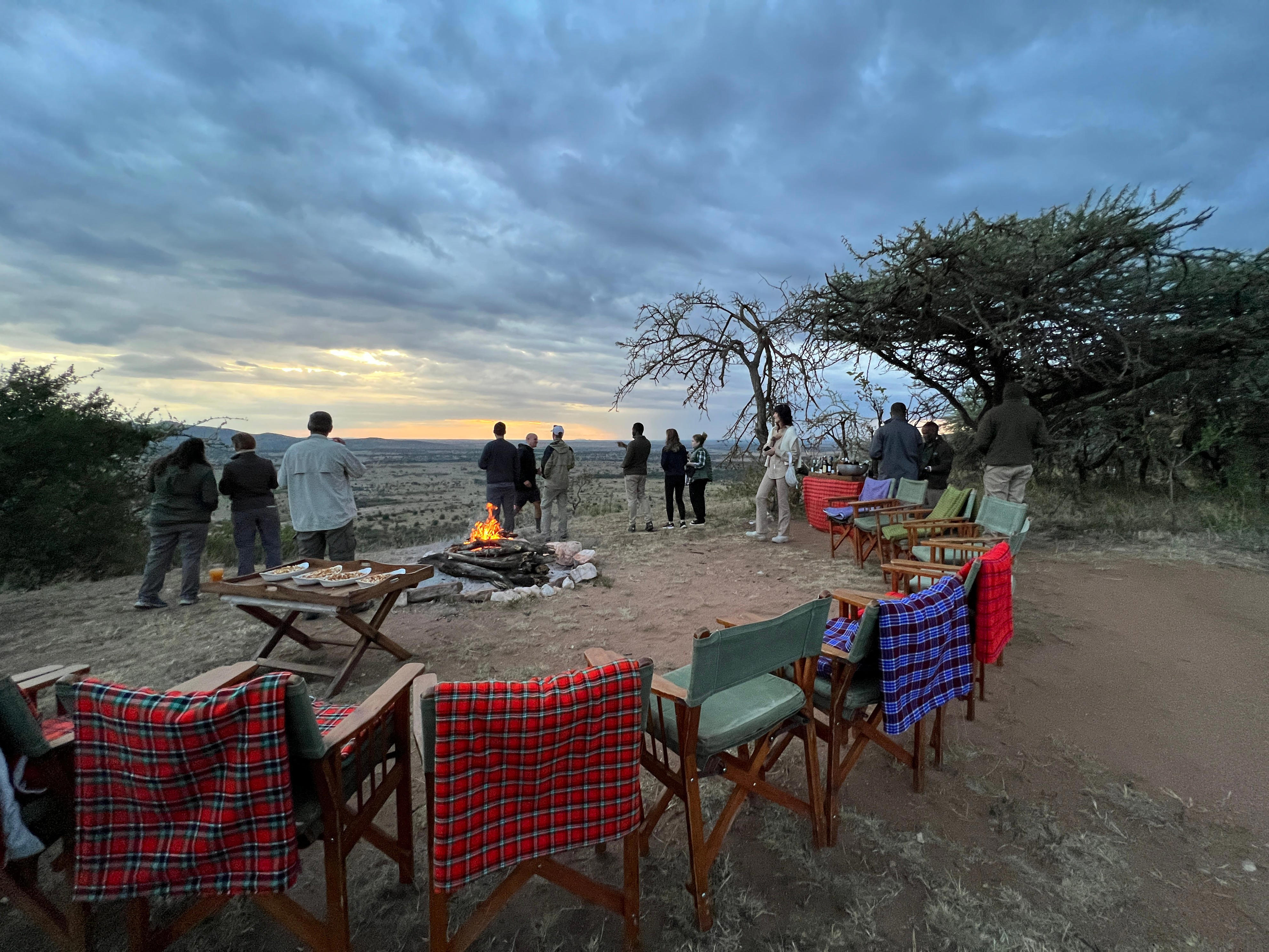
Our trip ended with a great happy hour and outdoor dinner.
Other activities that were part of our add-on package included a visit to a Maasai village in Kenya and a special happy hour and barbecue dinner.
And, for our journey home, the travel agency took care of everything, including transfers, until we boarded our international flight.
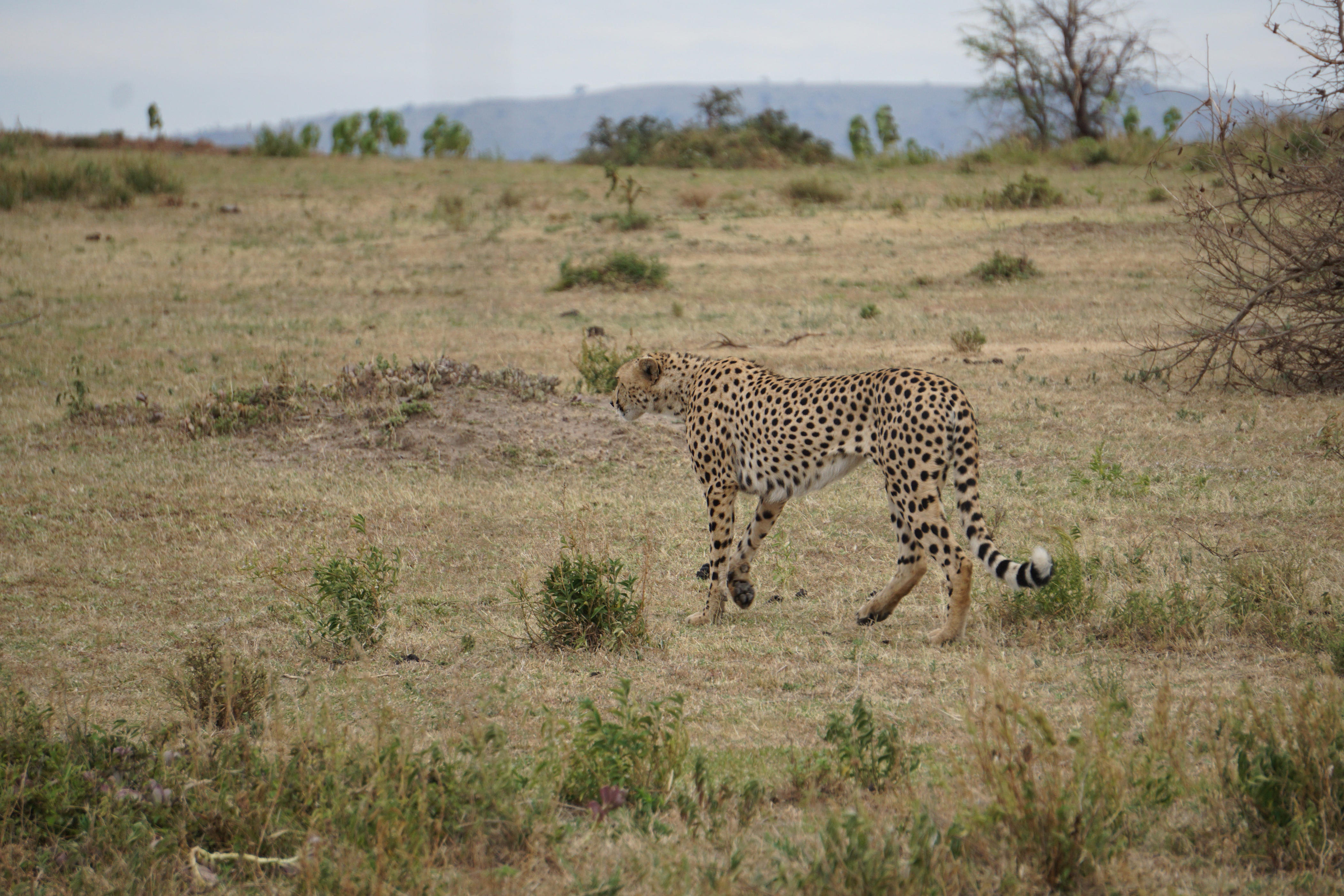
My big takeaway is that it's really worth paying to be inside a private reserve.
In my opinion, the difference between these two safari trips that's the most worth paying for is being in a private reserve.
After all, the main reason I fly to Africa is for the safari, not the glamping.
I much preferred my lodging at Taasa, mostly because of the bathroom. But if I hadn't had the 50% off deal, I'm not sure the full price would've been worth it.
Still, it was a wonderful experience, and if I had more money, I may feel differently. Even so, the budget glamping was pretty comfortable and just fine for a week.
But again, as far as the safari experience goes, the private reserve is hard to beat. Being able to go offroading and get closer to the animals is quite the experience.
And if luxurious lodges are out of the question, private reserves can also be visited more affordably. Some lodges inside private reserves, like Shindzela or Rhino River Lodge, can cost around $250 per person per night.
More for You
Brett Kavanaugh's Questioning of January 6 Charges Sparks Fury
TikTok star Kyle Marisa Roth dies at 36
16 Compliments You Didn’t Realize Are Actually Pretty Insulting
Jujutsu Kaisen: The Legacy Of Gojo Satoru, Explained
They got pregnant with 'Ozempic babies' and quit the drug cold turkey. Then came the side effects.
These Are 10 Smells That Cats Absolutely Hate
I Lost White Friends When I Finally Spoke Out
Unplug These 29 Items That Hike Up Your Electricity Bill
One of the best British spy dramas of all time is finally streaming on Netflix
CBS issues statement over chaotic Billy Joel broadcast
Is It Safe To Grill Frozen Hamburger Patties Straight From The Freezer?
People With Low Emotional Intelligence Are Known to Use These 4 Phrases
New doc uncovers racism and inappropriate behavior at popular retailer
Your senses will shut down in a specific order when you’re about to die
U.S. women’s track Olympians say photo was shocking but uniform isn’t
How to Clear Cookies from Your iPhone and Android (and Why You Should)
Pamela Anderson Joins Liam Neeson In Paramount's New ‘Naked Gun' Movie
Coast Guard evacuates U.S. passenger from Disney cruise ship 180 miles northwest of Puerto Rico
The Pool Noodle Hack That Makes Spray Painting Cabinet Doors A Breeze
10 crazy yet useful PC accessories you can actually buy

TechBullion
Best of kenya safari: discover wildlife, culture, and adventure 2024.

Introduction to Kenya
Welcome to the heart of wild Africa, where breathtaking landscapes and incredible wildlife encounters await you. Kenya, a land of untamed beauty and rich cultural heritage, is a top safari destination that promises the adventure of a lifetime. From majestic lions roaming the savannah to vibrant Maasai tribes preserving ancient traditions, Kenya offers an unforgettable blend of nature, culture, and excitement. Get ready to embark on the perfect safari trip as we explore the best of Kenya Safari , culture, and adventures in 2024!
The Top National Parks for Safari Adventures
Kenya is a dream destination for safari enthusiasts, boasting an array of national parks that offer unparalleled wildlife experiences. One of the most iconic parks is Maasai Mara, famous for its vast savannahs and annual wildebeest migration. Here, you can witness the Big Five in their natural habitat. Amboseli National Park is renowned for its stunning views of Mount Kilimanjaro as a backdrop to herds of elephants roaming peacefully across the plains. Samburu National Reserve provides a unique safari experience with species not easily found elsewhere such as reticulated giraffes and Grevy’s zebras. For bird lovers, Lake Nakuru National Park offers spectacular flamingo-filled lakeshores and abundant birdlife. Tsavo East and West National Parks are perfect for those seeking off-the-beaten-path adventures with diverse landscapes ranging from arid plains to volcanic hills. Exploring these national parks guarantees an unforgettable safari adventure filled with awe-inspiring encounters with Africa’s incredible wildlife.
Cultural Experiences in Kenya
Immerse yourself in the vibrant tapestry of Kenyan culture during your safari adventure. Experience the rich traditions and customs of diverse ethnic groups that call this beautiful country home. Visit Maasai villages and witness their traditional dances, intricate beadwork, and unique way of life. Engage with Samburu communities to learn about their nomadic lifestyle and close connection to nature. Explore bustling markets in cities like Nairobi or Mombasa, where you can sample local delicacies, buy handcrafted souvenirs, and interact with friendly locals. Delve into Kenya’s colonial history by visiting historical sites such as Fort Jesus in Mombasa or Karen Blixen’s former home in Nairobi. Participate in cultural ceremonies like the Kikuyu wedding rituals or Turkana bull jumping ceremonies for a truly authentic experience. Discover the beauty of Swahili architecture along the coast and learn about the blend of Arab, Indian, and African influences that shape it. From traditional music performances to art galleries showcasing contemporary African artwork, Kenya offers a myriad of cultural experiences waiting to be explored.
Adventure Activities in Kenya
Embark on thrilling adventures in Kenya beyond traditional safaris. Strap on your hiking boots and conquer Mount Kenya, Africa’s second-highest peak. Feel the rush as you whitewater raft down the Tana River, navigating exhilarating rapids amidst stunning landscapes. For those seeking a unique experience, soar above the Masai Mara in a hot air balloon at sunrise. Witness wildlife from a different perspective as the savannah awakens below you. Dive into the turquoise waters of Diani Beach for some world-class snorkeling and diving opportunities. Explore vibrant coral reefs teeming with marine life, including colorful fish and majestic sea turtles. Experience adrenaline-pumping moments by ziplining through the treetops of Kereita Forest or quad biking across rugged terrains in Hell’s Gate National Park. The options for adventure seekers are endless in Kenya!
Best Time to Visit Kenya for Safari
Kenya’s best time for a safari adventure depends on what you want to experience. The dry seasons from June to October and January to February are ideal for wildlife viewing as animals gather around water sources. During these months, the vegetation is less dense, making it easier to spot the Big Five – lions, elephants, buffalos, leopards, and rhinos. If witnessing the Great Migration in Masai Mara is your goal, plan your visit between July and September when millions of wildebeest and zebras cross from Tanzania’s Serengeti National Park. However, if you prefer fewer crowds and lower prices while still enjoying good wildlife sightings, consider visiting during the shoulder seasons of November to December or March to May. Keep in mind that Kenya’s climate varies across regions due to its diverse landscapes. Coastal areas like Mombasa have different weather patterns compared to inland national parks like Amboseli or Tsavo East. Researching specific destinations before booking can help ensure an unforgettable safari experience.
Tips for Planning a Safari Trip to Kenya

Planning a safari trip to Kenya can be an exciting and unforgettable experience. It is essential to research the best time of year to visit, considering factors like weather and wildlife migrations. Make sure to book your accommodations and safaris in advance as they tend to fill up quickly, especially during peak seasons. When packing for your trip, remember essentials like lightweight clothing, sturdy walking shoes, a hat, sunscreen, insect repellent, and binoculars for wildlife spotting. Don’t forget your camera or smartphone to capture those breathtaking moments on safari. Consider hiring a local guide who knows the area well and can enhance your safari experience with their knowledge of the wildlife and culture. It’s also important to respect nature and wildlife by following park rules and regulations at all times. Immerse yourself in the local culture by trying traditional foods, interacting with locals, and participating in cultural activities offered in various regions of Kenya. This will not only enrich your safari experience but also support local communities.
Conclusion: Why Kenya Should Be Your Next Safari Destination
Kenya truly offers the perfect safari trip, combining wildlife, culture, and adventure seamlessly. With its diverse landscapes and incredible biodiversity, Kenya’s national parks provide unforgettable safari experiences. From witnessing the Great Migration in Maasai Mara to encountering endangered species in Samburu National Reserve, every moment is filled with awe-inspiring encounters. Immersing yourself in Kenyan culture adds a unique dimension to your safari experience. Interacting with local communities like the Maasai people or learning about traditional crafts and dances enriches your understanding of this vibrant country. For thrill-seekers, Kenya offers a plethora of adrenaline-pumping activities such as hot air balloon safaris over vast plains, hiking majestic mountains like Mount Kenya or Mount Longonot, and diving into crystal-clear waters along the coast for some underwater exploration. The best time to visit Kenya for a safari largely depends on what you want to see and do. Understanding the seasons can help you plan your trip effectively – whether it’s witnessing the wildebeest migration from July to September or enjoying quieter parks during the shoulder seasons. When planning your dream safari trip to Kenya, consider factors like accommodation options ranging from luxury lodges to budget-friendly campsites, transportation within the country which may include domestic flights or road transfers between parks, and packing essentials such as lightweight clothing for warm days and layers for cool evenings on game drives. In conclusion: Why wait any longer? Embark on an unforgettable journey through one of Africa’s most iconic destinations – where wildlife roams freely against breathtaking backdrops, cultures blend harmoniously creating a colorful tapestry of traditions, and adventures beckon at every turn. Make Kenya your next safari destination; it’s an experience that will stay etched in your memory forever.

Recommended for you

Trending Stories

DogLibre’s Meme-Powered Approach to Revolutionizing Dog Care
DogLibre, a project dedicated to transforming the global dog care industry, will commence its...

A New Level of Gaming Monetization: Evolution of Gaming Unveils a $3 Billion GameFi Disruption
Delaware, USA – April 11, 2024 – Evolution of Gaming (EOG) is going to...

Semaglutide in the Treatment of Type 2 Diabetes: Current Status and Future Directions
If you or someone you know is among the 37 million Americans living with...

The Impact of HR Software and Analytics on India’s Workforce
As the digital era continues to reshape the business landscape, organizations in India are...

Revolutionizing Food and Dining: 10 Tech Trends Shaping the Future
In recent years, technology has been revolutionizing every aspect of our lives, and the...

ChangeNOW Ushers in a New Era of Creativity with the #HalvingNOW Twitter Contest – A Chance to Win 100 USDT!
Mahe, Seychelles – As the Bitcoin Halving event approaches, signaling a pivotal moment for...

From Farm to Fork: How Technology is Revolutionizing the Food Industry
In today’s fast-paced world, the food industry is experiencing a transformation like never before....

The Role of SEO in Strengthening Your Online Visibility
In the bustling digital landscape, where competition is fierce and attention spans are fleeting,...

Top Trader Who Sold All His Cardano (ADA) Before an 80% Crash From All-Time High Buys New Solana Meme Token—Price Jumps 10,000% In Just a Week
Within the highly volatile domain of cryptocurrency trading, the choices made by elite traders...

Bridging the World with Live Streams: Hanan Naeem’s Vision as CEO of OneStream Live
My journey from the classrooms of Aalto University to the founder of OneStream Live...

LBBW And Bitpanda Collaborate On Crypto Services
The biggest banks in Germany adopt cryptocurrency; LBBW and Bitpanda collaborate on custody services;...

Advanced Techniques for Security Awareness Training
Cybersecurity threats are becoming increasingly sophisticated, posing significant risks to businesses of all sizes....

Next-Level Quantum Encryption in Oil Trading
The oil trading industry has always been at the forefront of technological advancements, and...

A Showdown of Creativity: A Comparative Analysis of Proprietary Generative AI Image Models
The realm of creative expression is undergoing a seismic shift, propelled by the relentless...

AI Face Generators Revolutionizing Visual Content Creation
The seamless integration of technology in the creative sector continues to expand horizons, with...

How Mental Health Practitioners Can Market Their Business
In today’s world, talking about mental health is more common than ever before. Many...

Advancements in General Technology: Shaping the Future of Innovation
Technology has always been the catalyst that propels us forward. According to a report...

Synthetic Data Can Bring Real Change to Graphic Design
The graphic design software segment is lately in the midst of a small revolution,...

Best AI Girlfriend Apps 2024: Top 5 Sites for Virtual Relationships
The notion of AI girlfriends blurs the line between digital and personal connections in...

60+ Best Side Hustles to Make Money
Looking to boost your income but not sure where to start? Figuring out the...
Like Us On Facebook
Latest interview.

Technology White-label Solution for Programmatic Advertising; Interview With Anastasia-Nikita Bansal, CEO of Teqblaze
Hey there! I’m Niki. More than six years ago, I started my journey in AdTech, initially as a project manager at Smarty...
Latest Press Release

NTT DATA and Reiz Tech Announce New Venture to Target DACH
The joint venture – LITIT — built on previous collaborative successes of its parent companies, aims to transform the IT landscape of...
Pin It on Pinterest

‘This Will Finish Us’
How Gulf princes, the safari industry, and conservation groups are displacing the Maasai from the last of their Serengeti homeland

Listen to this article
Listen to more stories on curio
This article was featured in the One Story to Read Today newsletter. Sign up for it here .
I t was high safari season in Tanzania, the long rains over, the grasses yellowing and dry. Land Cruisers were speeding toward the Serengeti Plain. Billionaires were flying into private hunting concessions. And at a crowded and dusty livestock market far away from all that, a man named Songoyo had decided not to hang himself, not today, and was instead pinching the skin of a sheep.
“Please!” he was saying to a potential buyer with thousands of animals to choose from on this morning. “You can see, he is so fat!”

Explore the May 2024 Issue
Check out more from this issue and find your next story to read.
The buyer moved on. Songoyo rubbed his eyes. He was tired. He’d spent the whole night walking, herding another man’s sheep across miles of grass and scrub and pitted roads to reach this market by opening time. He hadn’t slept. He hadn’t eaten. He’d somehow fended off an elephant with a stick. What he needed to do was sell the sheep so their owner would pay him, so he could try to start a new life now that the old one was finished.
The old life: He’d had all the things that made a person such as him rich and respected. Three wives, 14 children, a large compound with 75 cows and enough land to graze them—“such sweet land,” he would say when he could bear to think of it—and that was how things had been going until recently.
The new life: no cows, because the Tanzanian government had seized every single one of them . No compound, because the government had bulldozed it, along with hundreds of others. No land, because more and more of the finest, lushest land in northern Tanzania was being set aside for conservation, which turned out to mean for trophy hunters, and tourists on “bespoke expeditions,” and cappuccino trucks in proximity to buffalo viewing—anything and anyone except the people who had lived there since the 17th century, the pastoralists known as the Maasai.
They were the ones tourists saw through their windshields selling beaded key chains at the gates of Serengeti National Park, or performing dances after dinner at safari lodges. They were famous for their red shawls and recycled-tire sandals. They grazed their cattle with zebras and giraffes, and built mud-and-dung houses encircled by stick fences barely distinguishable from the wild landscape. They were among the lightest-living people on the planet, and yet it was the Maasai who were being told that the biggest threat to conservation and national progress was them. Their whole way of life had to go.
From the April 2020 issue: Ed Yong on the last giraffes on Earth
And so Songoyo, after considering his alternatives, had devised a last-ditch plan for his own survival, one that had brought him to a town in Kenya called Aitong, where a cool wind was slapping sand and dung into his face as he scanned the market for buyers. He was far from home, roughly 65 miles north of the village in Tanzania where he had been tear-gassed and shot at for the first time in his life. He had seen elderly men beaten and guns fired at old women, and now it was down to this: He was a herder for hire, working for a distant relative, trying to make enough money to buy one single cow.
“Come!” he called to the buyers who kept passing his herd and weaving through the bleating mass. “You will not find any better!”
This was his plan: one cow, because that was the starting point of what it meant to be a Maasai man, which was what he still wanted to be.
The forces arrayed against Songoyo, whom I met in the course of two long trips to Tanzania late last year, include some of the world’s most powerful people and interests. (I have not used Songoyo’s last name out of concern for his safety.) What these people and interests want is what the Maasai are trying to keep: the land they live on.
Global leaders are seeking what they consider to be undeveloped land to meet a stated goal of conserving 30 percent of the planet’s surface by 2030 . Corporations want undisturbed forests in order to offset pollution. Western conservation groups, which refer to the Maasai as “stakeholders” on their own land, exert great influence, as does a booming safari industry that sells an old and destructive myth—casting the Serengeti as some primordial wilderness, with the Maasai as cultural relics obstructing a perfect view.
The reality is that the Maasai have been stewards, integral to creating that very ecosystem. The same can be said of Indigenous groups around the world, to whom conservation often feels like a land grab. In the past two decades, more than a quarter million Indigenous people have been evicted to make way for ecotourism, carbon-offset schemes, and other activities that fall under the banner of conservation. That figure is expected to soar.
For all its accomplishments, the cause of saving the planet has become a trillion-dollar business, a global scramble in which wealthy nations are looking to the developing world not just for natural resources, but for nature itself. The wealthy players include not only Europeans and Americans but Arabs and Chinese and others. On the African continent, political leaders are enthusiastic about what so-called green foreign investment might mean for their own economies (and, maybe, their bank accounts).
Such are the pressures being brought to bear on northern Tanzania, where the Maasai migrated with their cattle 400 years ago, settling in an area encompassing hundreds of thousands of square miles of grassy plains, acacia woodlands, rivers, lakes, snowcapped mountains, salt flats, forests, and some of the most spectacular wildlife on the planet. They called it Siringet, which in the Maa language means “the place where the land runs on forever.” The Maasai see their recent history as a struggle to save that land from those who claimed it needed saving.
First came the British colonial authorities, who established the 5,700-square-mile Serengeti National Park, pushing the Maasai to an adjacent zone called the Ngorongoro Conservation Area, with its famous crater, where they were promised they could live. Then came UNESCO. It declared both Serengeti and Ngorongoro to be World Heritage Sites, which came with new restrictions. Western tourists began arriving, seeking an experience of Africa that a thousand movies promised—one of pristine beauty and big game, not people grazing cattle. Tanzanian authorities began leasing blocks of land to foreign hunting and safari companies, many of which promoted themselves as conservationists—a word the Maasai have come to associate with their own doom. Spread among the villages that dot the northern tourist zone, the Maasai have meanwhile been growing in number—their population has doubled in recent decades, to about 200,000. Inevitably, the clash of interests has led to bitter and occasionally violent conflict.
Still, the threat unfolding now is of greater magnitude. It emerged soon after President Samia Suluhu Hassan took office, in 2021. “Tourism in Ngorongoro is disappearing,” she declared during one of her first major speeches. “We agreed that people and wildlife could cohabitate, but now people are overtaking the wildlife.” The Maasai listened with alarm, realizing that the people she was referring to were them.
Not long after Hassan’s speech, officials announced plans to resettle the roughly 100,000 Maasai who were living in and around Ngorongoro to “modern houses” in another part of the country. Meanwhile, in a region north of Ngorongoro, bordering Serengeti National Park, government security forces began rolling into Maasai villages. They were carrying out another part of the plan: annexing 580 square miles of prime grazing land to create an exclusive game reserve for the Dubai royal family, which had long hunted in the area. The government characterized the move as necessary for conservation. Traditional Maasai compounds, known as bomas , were burned. Park rangers began seizing cattle by the tens of thousands.

And more was coming: a $7.5 billion package with the United Arab Emirates , of which Dubai is a part, that included new plans for tourism and conservation. A $9.5 million deal with the Chinese for a geological park that overlapped with additional Maasai villages. An offer from Tanzania to make Donald Trump Jr.—an avid trophy hunter—an official “tourism ambassador.” New maps and proposals from the government indicated that further tracts could soon be placed off-limits, including a sacred site that the Maasai call the Mountain of God.
Read: What trophy hunting does to the elephants it leaves behind
“This is 80 percent of our land,” a Maasai elder told me one evening during a meeting with other leaders in northern Tanzania. “This will finish us.” They had tried protesting. They had filed lawsuits. They had appealed to the United Nations , the European Union , the East African Court of Justice, and Vice President Kamala Harris when she visited Tanzania in 2023. They’d unearthed old maps and village titles to prove that the land was theirs by law, not just by custom. They’d written a letter to John and Patrick McEnroe after hearing that the tennis stars were hosting a $25,000-a-person safari-and-tennis expedition in the Serengeti. People made supportive statements, but no one was coming to help.
This is what Songoyo understood as he paced the market in Aitong. It was closing soon. Buyers were filtering out through the wire fence, and he still had 12 sheep left to sell, one of which was lame. A man tapped it with a stick.
“A cow stepped on his leg; that’s why he walks like that,” Songoyo said, bracing the animal with his knees.
The man walked away. Another came and tapped his stick on the lame sheep, and then on the rest of them. They agreed on a price, and the buyer pulled out a roll of bills.
“Please, can you add 500?” Songoyo said, asking for the equivalent of an extra $3.60 in Kenyan shillings. “I need 500. Please.”
The man added 200, and Songoyo brought the day’s earnings to the relative who had hired him. They sat under a tree, and he counted out Songoyo’s share for a week of work, roughly $10. One cow would cost about $200.
“See you next week,” the man said.
“May God give you favor,” Songoyo replied, putting the money in the pocket of his blue track pants. His cellphone rang, a battered plastic burner.
“I am coming,” he told one of his wives, who was waiting for him at their home in Tanzania.
He’d had options other than this. There had always been Maasai who’d given up traditional ways to reinvent themselves, shedding their red shawls for all kinds of lives. Now many more of them, having lost their cattle, were moving to cities, where the Maasai reputation for bravery and rectitude meant there was always work as a security guard—I saw them everywhere in Arusha and Dar es Salaam, in front of shops and banks. Others had taken a government offer to resettle in a town called Msomera, far to the south, only to return home with stories of loneliness and conflict with locals. Still others were falling apart. Songoyo had seen them, drunk men hobbling along the road or passed out on their red shawls under trees in the daytime. That would not be him.
“Never,” he said, and began the long walk back to his village in Tanzania, a tall man wrapped in a pink-and-purple plaid shawl passing cinder-block taverns where he would not drink, and motorbikes he would not hire, because the point was to save money for the cow. No cows, no life , he told himself, picking up the pace along an orange dirt road stretching into the late afternoon.
His earliest memories were of cows; he had never been without them. They were the huge, warm, brown beasts kept in the center of the boma. Their dung formed the walls of his home. Their milk and blood were what he drank as a child, when his father told him what Maasai children were traditionally told: that when the earth split from the sky and God left the world, he entrusted the Maasai with all the cattle, and by extension the land and the other animals that shared it. Songoyo learned how to herd with rocks, pushing them around in the dirt. He got his first calf when he was a small boy, herding it with a stick near the boma. When he was big enough, he followed his older brothers out into the wider grazing areas, including one the Maasai called Osero , a word that refers to lush grasslands—in this case, the 580 square miles of land adjacent to Serengeti National Park where Maasai had lived and kept cattle for generations.
It was in Osero that he learned about different kinds of grasses and trees: which ones had good branches for bows or good bark for tea that could ease a backache. He learned where to find natural salt and the coolest streams, and he learned certain rules: Never cut down a tree. Keep cattle away from wildebeests during calving season, because they carry a disease deadly to cows.
He listened to older boys tell stories, including one whose lesson he still lived by, about a group of Maasai heading out on a cattle raid when one of the warriors broke his sandal. The warrior turned to the man behind him and asked if he would stay and help, but the man refused. He asked another, who also refused, and so on until the very last one agreed to stay, while the rest continued on to cattle-raiding glory. The stern moral was: Be prepared. Don’t fall behind. Stay with the group. Struggle.
Songoyo had struggled. He held himself together after his father died, when he was still a boy, a moment when he might have turned delinquent but didn’t. He endured his adolescent coming-of-age ceremonies with dignity, by all accounts managing not to cry or shake during his circumcision, when people scrutinize and taunt boys for any sign of weakness, and he was rewarded with cows. He learned how to shoot arrows and use a machete, and became a moran —entering a stage of life when young Maasai men bear responsibility for protecting their village—and was given more cows, each with a name, each with a certain character he came to know. In this way, the life he wanted became possible.
He married his first wife, then a second and a third, and eventually built a boma in the village where his children went to school, and a larger compound on the edge of Osero, where the cattle were kept, and where he’d had one of the happiest moments of his life. This was just before everything began to unravel, an otherwise ordinary day when the rains were full and the cows were fat and he’d walked out into the middle of them, their bells jangling, realizing how far he’d come and thinking, “Yes, I am a real Maasai.”
Not that life was an idyll. In village after village that I visited, people described years of tensions with safari companies and conservation authorities. People who lived within the Ngorongoro Conservation Area—a vast zone that was almost like its own country—had complained about schools falling apart and poisoned salt licks and the indignity of their identity being checked as they came and went through the tourist gate. In other areas, people had accused certain safari companies of illegally acquiring leases and paying local police to beat herders off concessions. One company was notorious for using a helicopter to spray scalding water on cows.
In Osero, the problems went back to 1992, when an Emirati company called Otterlo Business Corporation (OBC) was first granted a hunting license for the Dubai royal family. They had their own private camp and a private airstrip and, for the emir himself, Sheikh Maktoum bin Rashid Al Maktoum, a compound on a hill, guarded by a special unit of the Tanzanian military police. When the rains ended each year, cargo planes full of four-wheelers and tents and pallets of food would buzz low over villages before landing, followed by private jets delivering the royal family and their guests. A few weeks later, they’d buzz out with carcasses of zebras and antelope and other trophies. For a while, OBC had its own cellphone tower, and Maasai villagers noticed that when they were near it, a message would pop up on their phone screens: “Welcome to the U.A.E.” The arrangement had been that the Maasai were supposed to keep away when the royals were in residence, but just about everyone had caught a glimpse. Songoyo had seen them speeding around, shooting animals from trucks with semiautomatic rifles. “Once, they pulled up in the middle of my cows and I saw them shooting so many antelope,” he told me. “They just kill, kill, kill!”

There had been attempts at diplomacy. Sometimes the Arabs, as the Maasai called them, would give out bags of rice. They had hired Maasai men to work as guides and drivers and had flown some of their favorite employees to Dubai, buying them clothing and cars. One driver recalled being at the camp on a day when the emir arrived. The driver lined up with other staff, and the emir greeted each one of them while an assistant followed behind with a large bag of cash, inviting each worker to reach in. The driver said he pulled out $1,060.
But a bitterness was always there. Maasai leaders had long claimed that Osero belonged to 14 adjacent villages, and that they had never consented to the OBC deal. Tanzanian officials asserted authority over not only Osero but a far larger expanse—Loliondo—citing its colonial-era designation as a game-controlled area; they often resorted to violence to enforce this view. Maasai villagers described to me how government security forces had collaborated with OBC at least twice in recent years to conduct a large-scale torching of bomas in the vicinity of the camp. Young men grazing cows had been beaten and shot at. One man described to me being shot in the face, then handcuffed to a hospital bed as he was bleeding through his ears and nose and eyes, slipping in and out of consciousness. He remembered a police officer shouting at a doctor to let him die, and the doctor refusing the order and saving his life. He lost his left eye, the socket now scarred over with skin, and had kept a thin blue hospital receipt all these years in the hope of receiving restitution that never came. Most villages have people who can tell such stories.
Read: The war on rhino poaching has human casualties
In 2017, amid rising complaints and lawsuits filed by Maasai leaders, Tanzanian authorities suspended OBC’s license and accused the company’s director of offering some $2 million in bribes to the Ministry of Natural Resources and Tourism, which led to a court case that ended in a plea deal. Requests to interview OBC executives, representatives of the Dubai royal family, and officials of the U.A.E. government about their involvement in Tanzania went unanswered.
By the time Hassan became president, in 2021, the director was back on the job and the OBC flights had resumed.
Samia Suluhu Hassan was widely embraced by West and East. Her predecessor, John Magufuli, who died in office, had been a populist with an authoritarian streak and became infamous for downplaying the dangers of COVID. He suspended media outlets, banned opposition rallies, and alienated foreign investors, even as many Maasai saw him as a hero for brushing back OBC.
Hassan eased his more repressive policies and embarked on an ambitious plan to bring foreign investment into the country, especially through tourism. She branded herself a forward-looking environmentalist.
And she found willing collaborators. The World Bank had been encouraging more tourism , arguing that it could help Tanzania achieve what official metrics define as middle-income status. One of the country’s main conservation partners, UNESCO, had been pressing Tanzanian authorities for years to implement what it called “stringent policies to control population growth” in Ngorongoro, although UNESCO also says it has never supported the displacement of people. A German conservation group called the Frankfurt Zoological Society, a major partner in managing Serengeti National Park, has expressed concern that traditional Maasai practices are becoming less tenable because of population growth. “There is a risk of overuse and overgrazing that should be addressed,” Dennis Rentsch, the deputy director of the society’s Africa department, told me. “I don’t want to vilify the Maasai. They are not enemies of conservation. But the challenge is when you reach a tipping point.”
In response to these pressures, the Ministry of Natural Resources and Tourism produced a report that blamed rising Maasai and livestock populations for “extensive habitat destruction” in conservation zones. It recommended resettling all of Ngorongoro’s Maasai. It also recommended designating the 580-square-mile Osero tract, farther away, as a more restrictive game reserve, describing the land as an important wildlife corridor and water-catchment area for the Serengeti ecosystem. The designation left the Dubai royal family with an exclusive hunting playground. But none of the Maasai who lived in the area would be allowed to graze their cattle or continue living there.
Maasai leaders countered with two reports of their own—more than 300 pages covering colonial history, constitutional law, land-use law, and international conventions, and providing copies of village titles, registration certificates, and old maps—to prove their legal right to the land as citizens. They blamed habitat destruction on sprawling lodges, roads bisecting rangeland, trucks off-roading across savannas, and “huge tourist traffic.” Overgrazing was a result of being squeezed into ever smaller domains, which kept the Maasai from rotating grazing zones as they normally would. Citing their own surveys, they said the government had inflated livestock numbers, a claim supported by Pablo Manzano, a Spanish ecologist with the Basque Centre for Climate Change, who had conducted research in the region and found that the government was perpetuating a tragic misunderstanding.
Manzano and others pointed to a growing body of scholarly research demonstrating what the Maasai had long known: that their management of the land did not degrade the Serengeti ecosystem but had actually helped sustain and even create it—the grasslands the Maasai had cultivated for hundreds of years were the same grasslands that many wild animals needed to thrive. In that sense, the land had already been conserved before the Germans, the British, and various international groups decided that they needed to save it.

In their reports, Maasai leaders concluded that the government was engaged in “a calculated process to wipe out animals” and to “devastate their livelihood and culture.” They took a bus to the capital and delivered the two reports in person to government officials.
But there would be no debate, no discussion of complexities. Hassan moved forward with her agenda. She was finalizing the $7.5 billion package with the United Arab Emirates, the fourth-largest (after China, the EU, and the U.S.) investor in Africa. One deal turned over management of roughly two-thirds of Dar es Salaam’s port to DP World, a company owned by the U.A.E. government. Another deal turned over management of some 20 million acres of forest —roughly 8 percent of the nation’s entire territory—to a company called Blue Carbon, which is run by a member of the royal family, Sheikh Ahmed Dalmook Al Maktoum, and uses conserved land to generate carbon credits that it sells to other companies. The package also included money for tourism.
Hassan invited travel agents to the country for a “tourism reboot.” She spoke of wanting more five-star hotels. She filmed a promotional documentary called The Royal Tour , which at one point involved helicoptering with a travel reporter over some Maasai villages near the Serengeti.
“All those round things down there are the Maasai bomas,” Hassan says in the film, as several villagers look up into the sky. The reporter then comments in a way that Maasai leaders found ominous: “Over the years, the Tanzanian government has tried to persuade the Maasai to become traditional farmers or ranchers, but they’ve persisted in clinging to their ancient ways. And yet, they may not have a choice now.”
Some 400 miles to the south, in the hotter, flatter farming area of Msomera, bulldozers broke ground on a new development. The military was building 5,000 cinder-block houses intended for Maasai families. Officials had been dispatched to villages in the Ngorongoro Conservation Area to present the government’s offer: a free house on 2.5 acres. Electricity. Piped water. New schools. A cash bonus of roughly $4,000 for early takers. At one such presentation, a crowd pelted the officials with rocks.
I requested an interview with Hassan to better understand her decisions. In response, a government spokesperson arranged interviews with several other officials, one of whom was Albert Msando, a district commissioner, who told me, “Whatever I am answering is whatever the president would have answered.” We met in the town of Handeni, near Msomera. Msando’s office was inside a former British-colonial building, where a portrait of Julius Nyerere, Tanzania’s founding father, hung on one wall and a portrait of Hassan hung on another.
“For the public interest,” Msando said of the Maasai, “we have to relocate them.” A lawyer by training and demeanor, Msando emphasized that any relocation is voluntary, at least for now. He also made it clear that if persuasion fails, the government maintains the legal right to remove the Maasai from conservation areas, by force if necessary. “That’s why there are guys here with their shoulders decorated,” Msando said, pointing around the room to police and military officers.
He told me that anyone in Tanzania would be lucky to get what the Maasai were getting. “We are giving them nice houses, I believe, according to modern standards.” He said that the Maasai currently live in “filthy conditions” and should be helped to “live a better life.”
He and other officials I spoke with said that they disliked even using the term Maasai . They invoked the spirit of Nyerere, saying that Tanzania was supposed to have a national identity, not tribal ones. Msando said he could understand the Maasai’s concern about losing their culture, even if he had little sympathy for it. “Culture is a fluid thing,” he said. “I am Chaga—the Chaga were on the verge of having their own nation. Today look at me. People do not even know I’m Chaga. My kids don’t even speak Chaga.” He was unapologetic: “The Maasai are not exempted from acculturation or cultural acclimatization, or cultural extinction.”
The government’s plans moved forward. In June 2022, a convoy of trucks carrying hundreds of security personnel rolled into the 14 villages bordering Osero, a show of force that the Maasai had never seen before. Soldiers, police, and park rangers set up camps on the outskirts of each village, announcing their intention to demarcate the boundary of the new game reserve. What happened next unfolded sporadically over several days. It has been documented in reports by human-rights groups and was described to me by dozens of witnesses and victims.
First, village leaders summoned to what was billed as a routine ruling-party meeting were arrested after they refused to go along with the demarcation—27 of them in all. The security forces then began planting a long line of three-foot-high rectangular cement markers called beacons along the perimeter of Osero. Villagers came behind them, kicking the markers down before the concrete foundations had set; women hacked at them with machetes. “I felt like I was fighting for myself,” one woman told me later. “I knew if this land goes away, there is nowhere for my children to be, and that forced me to lose my fear.” But the security forces kept beating the villagers back. Elders called more than 1,000 moran to take up positions with bows and arrows in forested areas along a main road where government trucks were patrolling.
“How many are ready to die?” a leader said to the group, and at some point, one of them shot an arrow at a police officer, killing him.
After that, the security forces opened fire. They shot at the legs of elderly women waving grass as a sign of peace. They shot an elderly man, who fell and then was heaped onto a truck “like a sack of maize,” his son told me. He has not been found. The security forces shot at men and women trying to destroy the beacons, wounding them in their arms and legs and backs. They shot tear gas into bomas and burst into one where a traditional ceremony was being held, firing into the crowd. The moran waited for orders to retaliate, but the elders, seeing what the government was willing to do, called them off. “It’s only because we didn’t have guns,” a Maasai elder told me. “If someone helped us with guns, they cannot even fight with us, because they are very cowardly.” Another elder said, “You cannot fight a gun with arrows.”
Dozens of people with bullet and machete wounds, blocked by police from local clinics, limped their way across the border into Kenya for treatment. Several thousand more fled there for safety. Others hid in the forest. Then the burning and bulldozing began. For several days, security forces plowed through circles of stick fences. They crushed houses and corrals and lit the debris on fire, burning more than 300 bomas, including Songoyo’s, and finishing the work before the start of high safari season. In a statement issued a few days after the violence , the Tanzanian government said the new game reserve had “no settlements as it is alleged and therefore there is no eviction” taking place. It described what had happened as “normal practice for all wildlife and forest protected areas in Tanzania”—a necessary step to keep the Serengeti ecosystem from being “disrupted and eventually erased from the face of the Earth.”
Songoyo’s boma had been by a hot spring. His father’s and grandfather’s graves were nearby. In the aftermath of the violence, he moved his family and cattle from Osero to a smaller boma nearer to his village, where he and others returned from hiding to find homes ransacked and skeletons of cows that had been eaten by wild animals.
Security forces roamed up and down the roads. Officials called people into immigration offices and accused them of being Kenyans, requiring them to show up in court for weeks on end, until judges threw out their cases for lack of evidence. Rangers patrolled Osero more heavily than ever, shooting at and beating herders who went anywhere near the new reserve, punishments that now came with a kind of psychological torture—forcing people to consent to the legitimacy of their own dispossession. One young man told me that rangers dragged him to their truck and beat him on his back with a stick for hours, calling him “rubbish” and yelling, “You don’t agree this land was taken? We will punish you until you agree!” They would feed him cornmeal, he said, and beat him some more. But he never did agree. Now he can barely walk.
The Maasai had other problems. One was grass: There was not enough. Everywhere I went, I saw bony cows picking at short clumps of weeds in dry patches of dirt. Out of desperation, some people were taking their cows to graze in Kenya, while others were sneaking into Osero at night. To avoid alerting rangers, cows went in without bells, making them harder to keep track of in the dark. Herders used cheap flashlights for safety, shining them fleetingly in the bush to detect the eyes of lions and other predators. They struggled to keep themselves awake, wearing small radios around their necks, playing tinny music at a low volume only they could hear.
Another problem was worse: Rangers were seizing cattle. Not just a few here and there, but huge herds of them, by the hundreds and then by the thousands. One day, Songoyo got a call from his brother, who had been grazing Songoyo’s 75 cows near Osero with other herders.
He said rangers had chased them down and seized more than 700 cattle, including all of Songoyo’s. He said the rangers had then crossed with the cattle into Serengeti National Park, and were holding them in a pen. Songoyo imagined them staying like that, not eating, not drinking. He imagined his favorite, Kiripa, a brown heifer he could always count on to lead the other cattle to distant grasses and home again, slowly dying, and rushed with the other owners to the park gate.
“I tried to reason with the rangers, but I totally failed—it was like they were ready to shoot us,” he recalled, and so the group contacted a Maasai lawyer, Melau Alais, whose practice had been overwhelmed by such emergency calls in the past year.
After several days, Songoyo learned that the rangers were alleging that the cattle had been illegally grazing inside Serengeti National Park, and that they would all be auctioned off unless the owners prevailed in court. The court was in a town called Mugumu, clear on the other side of the park, a two-hour drive away. The hearing was in a few days. So Songoyo and the other owners scrambled together the park fees and set off in the lawyer’s car past lush green grass and fat, grazing zebras and Land Cruisers full of tourists enjoying the scenery. When they reached the courthouse, the owner whom they had elected to represent all of the owners in the case, a man named Soloi Toroge, was formally charged with illegal grazing and jailed until the hearing.
The next day, Songoyo and the others sat in the gallery as Toroge took the stand. Both Songoyo and Alais recalled for me the day in the courtroom.
“So what happened?” Alais asked Toroge, and as the defendant began telling the story of how the rangers had beaten the herders and taken the cattle, Songoyo said he felt his anger rising.
Alais asked Toroge how he knew the cows were his, and as he described their particular colors and markings, Songoyo thought about his own cows, and became more desperate.
At another point, Alais asked Toroge how many children he had, and as Songoyo thought about his own, he began to feel physically ill.
“So what other business do you do?” Alais continued.
Toroge said he depended only on livestock.
“This livestock, or others?” Alais asked him.
This livestock, he answered. There was no other.
“So if the court decides to auction the cattle, what will happen?” Alais asked.
“All of us will die of hunger,” Toroge answered.
As he continued, Songoyo remembered thinking that this was it. That he really was about to lose everything he’d worked his whole life to achieve—not because of drought or his own foolishness, but because of his government, and the Arabs, and something called conservation. He said he began making noises, and felt himself becoming so disoriented, so altered, that he thought he could kill someone, or that someone might kill him, and soon people were surrounding him, court officers threatening to arrest him. Songoyo was saying, “Then let us die. There is no special death.”
He did not return for the other days of testimony. He was back in his village when Alais called to tell him that the judge had ruled that the cows would be auctioned off unless the owners paid a fine, and that his share—calculated per head of cattle, per day, for more than 30 days and counting—would be roughly $5,000.
He briefly considered what others had done, which was borrow money from a Somali loan shark who was doing a brisk business, but decided that was no solution.
“Let them sell them all,” he told Alais.
He did not leave his boma for days.
Normally, relatives and neighbors would give someone in his position one of their cows to help him rebuild, but nothing was normal any longer. More than 50,000 head of cattle had been taken by rangers, according to a local tally. Between the seized cattle and the fines, a huge transfer of wealth was under way from the Maasai community to the government.
People came by Songoyo’s boma to say they were sorry. They tried to encourage him. He considered what to do. He could be a security guard. He imagined standing still for hours in front of some building in Arusha. Then he began thinking that death would be preferable. Traditional Maasai cosmology includes no afterlife, no reward or punishment in the hereafter, so that would be that. Hanging or poison were the usual methods; hanging was more certain. Then he thought about his children. “And I said no,” he recalled. He told himself what others had told him since his father had died. He was a hard worker. He knew how to struggle. He thought, “Maybe something good is ahead of me.” He thought that if he just kept going, “God will bless me for that.”

He tore down a large corral where he had kept his cattle and built a smaller one for the seven goats he still had, and for the one cow he hoped to buy. He remembered a distant relative, a businessman in Kenya; they got in touch, and the plan was set: Pick up the livestock at a market near his village. Herd them across the border to a market in Kenya, and if he didn’t sell them there, go on to Aitong, a roughly 130-mile circuit every week. He had been doing this for months.
When he got home from Aitong, he would give half the money he’d earned to his wives for food. He would rest, and then start out again. He noticed himself becoming skinnier.
Songoyo headed north with his next herd of sheep, through a clearing with a seasonal stream and smooth rocks. He skirted Serengeti National Park, where he was not allowed to be, then crossed over a low mountain range that marked the Tanzania-Kenya border, his sandals splitting at the soles. At the gates of the park, some of the half a million people who visit every year were lining up in Land Cruisers, the bumpers displaying flag decals representing the United Kingdom, Germany, Italy, the United States. And as the sun rose one morning, in they went, tourists with bucket lists, anniversaries, dreams, and romanticized images in mind.
They roamed the dirt roads through grassy plains that really did seem to stretch on forever—a rolling sea of greens and yellows and flat-topped trees. They slowed for herds of gazelles and elephants. They sped to a leopard sighting in trucks bearing the wishful names of various outfitters—Sense of Africa, Lion King Adventures, Peacemakers Expeditions—and soon they began gathering along one side of the Mara River.
On the other side, great black herds of wildebeests were massing, waiting for the right moment to dive off a small cliff and swim across. What the animals saw waiting for them was a long line of trucks, a metal fortification.
“I want a picture!” said a woman hoisting her camera.
“My God, I want them to come down!” said her companion.
An hour passed. Another hour. The wildebeests were not migrating. A Maasai driver grumbled that obviously there were too many trucks. A man pressed binoculars to his face.
“See, it looks fine to us, but to them, something’s not right,” he said.
He wondered if it was crocodiles. They waited. A woman took a nap. Then some wildebeests began moving downriver, opposite some gaps in the otherwise solid wall of trucks. And then one hurled itself over the cliff in heroic fashion, and soon they were all diving.
“They’re flying!” someone said.
The animals were flailing, tumbling, and splashing down into the river, swimming for their lives, and now engines were cranking as trucks roared toward the crossing point, wedging into every open gap.
“We got ’em!” yelled a woman holding up a camera, and as far as anyone could see, the view was wildebeests, river, trees, and the grassy savanna beyond—no cows, no goats, no Maasai herders, no people at all, except the ones beholding the spectacle they’d been promised.
What they could not see was a tall man in blue track pants and a pink-and-purple plaid shawl herding sheep across a rocky path, trying not to think about how his knees hurt, his ankles hurt; trying to forget about all that had come before now.
Songoyo reached the first market, where he did not sell the sheep but picked up some more animals for another client and kept going, heading for Aitong.
It was late afternoon when he began crossing the Maasai Mara—the Kenyan national park—with only a stick for protection because bows and arrows are not allowed in the park. He hustled the sheep through the bush, past thorns, under branches, over sharp rocks and soft grass. He saw zebras. He saw giraffes . At one point, he saw a lion, which began following him, then another, coming closer and closer, and as he began to think that this would be how his life ended, a tourist truck came speeding along the road and scared the lion away, and he took off running with the sheep until he came upon elephants—“So, so many elephants,” he said—and managed to dodge those, too.
He kept walking, trying to stay alert. The night was moonless and very dark. After some hours, he reached the edge of the park and saw a boma—a cultural boma, as it turned out, the kind set up for tourists, where Maasai act out versions of the life now being extinguished—and asked if he could sleep there, but the people at the park said that was against the rules, even though welcoming him would have been the true Maasai way. So he waited outside a while and then entered anyway, lying down in a corner. It was cold, and he felt himself becoming sick.
He reached Aitong the next morning but still didn’t sell the sheep, and this meant he would have to press on another 50 miles to a town called Kilgoris. By now he was so exhausted that he decided to sleep, and this was when, as he put it, “evil came during the night,” in the form of a hyena that killed five of his sheep, two of which belonged to the new client. When Songoyo called to tell him, the man told Songoyo that he would have to repay him for the animals. Songoyo told him he didn’t have any money. The man said in that case, he would have to work without pay. Songoyo set off for Kilgoris, now in debt.

He walked along a dirt road as trucks blasted him with fumes. He walked across one farm after another. He felt so hungry. At times he knelt on the ground and said, “God, can you see this?,” then got up and kept going. Another farm. A man who gave him water. A man who yelled at him to get off his land. A tree where he took a nap. His dreams lately were of cows grazing in lush grass, and of dying. More hours crossing an area that belonged to a rival pastoralist tribe, sneaking along the edges and behind stands of trees, feeling like a thief, he said, feeling like he had no place to be in this world. He kept going like that, across more land that was not his.
The land Songoyo considered his was now part of the new Pololeti Game Reserve . That was what Osero had become. The government had constructed a gate bearing the name along the main road into the area, not far from where Songoyo’s boma had been, and when the Dubai royal family was not around, tourists could pay a fee and go inside.
“As far as you can see, all this is now Pololeti,” said a Maasai driver who had grown up on the land and been away from it for a year, ever since the violence. “I feel like crying.” The only reason he was able to go inside now was that I had hired him as a guide.
What he saw was miles and miles of a particular grass that was good for cattle, at the moment so tall and golden. “If your cows are weak and they eat this, in two days they will stand,” he said, driving ahead.
He saw the yellowing tops of grasses that zebras favored, and thick, wetter grasses that wildebeests favored. He saw some impalas in the distance and said, “I wish to see my goats there,” because they would usually graze together.
He saw wiry red oat grasses, and thick swirls of cattail grasses, and here was the kind of acacia with bark that helped with nausea and there was the tree with large, rough leaves useful for sanding down a staff. He saw lavender morning glories used for tissues, and a sacred stream whose water was used for ceremonies. He smelled the familiar scent of bush mint in the cool afternoon, and heard such a strange quiet without the bells of cows.
“In this area, in the evening, you’d see so many cows,” the driver said, and soon he reached a clearing where it was possible to see grass pressed into faint circles.
“Over here used to be houses,” he said.
“Over here, there used to be more than 20 bomas,” he said, continuing on.
“Here used to be a boma, because you can tell the difference between this grass and the other grass,” he said. “We always have soft-soft.”
He navigated by trees he remembered and small hills he knew by heart.
“Here was a very large boma—you can see the fence,” he said, pointing to some scattered branches with thorns. He continued on.
“Over here was the Pyando family,” he said, passing a certain spot in the grass.
“The Kairungs were here,” he said, but it was hard to tell.
“Here were the Saing’eus,” he said, pointing to black weeds that grew where cow dung had been.
Here lived the Purengeis and the Ngiyos. The Kutishos, the Oltinayos, the Kikanais, the Mungas. A whole world that would soon be gone with no trace.
The driver turned and headed back toward the gate, noting a road that led up to a compound on the mountain, where the emir could look down and enjoy one of the most magnificent landscapes on Earth, with no cows or bomas or red shawls obstructing the view.
“Just imagine,” the driver said, and soon he was passing a line of white beacons.
“Oh, our land,” he said, exiting through the gate, wondering what would become of all the life that had been here.
One answer was taking shape 5,000 miles to the north, in the United Arab Emirates, at a place called Sharjah Safari park. It had been open a year, a project sponsored by an Emirati royal who wished to re-create the experience of a real African safari. It was an hour’s drive from the Dubai airport, out along a smooth, straight highway lined with green palms and bright-yellow marigolds, past mirrored skyscrapers, many mosques, discount strip malls, a crematorium, camels, and miles of desert.
At the entrance was a concrete elephant. The $75 gold package entitled visitors to tour 12 distinct African landscapes with animals procured from Africa itself, and on a 70-degree December day, tourists climbed into a modified Land Cruiser that whisked them through a series of metal gates.
“Savanna,” the tour guide said as the first gate slid open to reveal some fake termite mounds, some half-dead acacia trees, and a living waterbuck. “Ngorongoro,” she said as another gate slid open, revealing a few gazelles and four white rhinos. “Serengeti,” she said, and on it went.
Soon the tour arrived at the last exhibit: “Boma.” At the end of a curved path lined with grass was a collection of round structures made of cement, not mud and dung, with wooden doors and thatched roofs. There was a corral with goats and donkeys. And here and there were signs with cartoons explaining life in this place. One of them included a drawing of a man. He was wearing a blue-plaid shawl. His features were simply drawn, and he stared blank-faced from the confines of a rectangular wood frame.
When he saw the low mountain range, Songoyo felt a burst of energy, knowing he was near home, such as it was, the place where he was trying to start over. He crossed the clearing with the smooth rocks, and soon he arrived at a grassy slope, and there were the remnants of the larger corral he’d torn down, and there was the smaller one he’d built for the goats and the cow he still could not buy, a circle of sticks with jackets and plaid shawls drying on top. There was a mud-walled house, and a child running out of it.
His wife made him some tea. He gave her money for the market. He’d made roughly $20 on this trip, but of course he was now in debt for the sheep the hyena had killed. They discussed which neighbors were still around. So many had left. Then Songoyo went outside to check on his seven goats.
He looked inside the corral. Four, he counted. Another two were running around outside, so that made six. He kept looking. He walked to where the old corral used to be, then back to the new corral. No goat. He began walking faster, looking around the house. Still no goat. He walked farther out into the grass, seeing nothing, becoming more alarmed.
“Where’s the other one?” he said. “There is one missing!”
His wife came outside and began looking too. He ran out beyond a thorn fence and into the taller grass, now frantic, scanning the landscape for all that he had left of a vanishing life he loved and still wanted.
He kept looking, and finally he spotted the goat. It was sitting in the grass. As he came nearer, he saw that it was injured. A back leg was bloody, and seemed to have gotten stuck in some thorns. Songoyo knelt down to examine the wound more closely. He was a Maasai man without a cow, in debt, getting skinnier, and now he was shaking his head.
“Who did this?” he shouted, expecting no answer.
This article appears in the May 2024 print edition with the headline “The Great Serengeti Land Grab.” Stephanie McCrummen can be reached at [email protected] .

IMAGES
VIDEO
COMMENTS
21 Top Kenya Packing List Items Clothing. The coastal part of the country offers fantastic pearly beaches, so make sure you pack smart-casual in case an opportunity for a romantic dinner date arises. ... If you are going on a safari, beware of the tsetse flies, blood-sucking insects that transmit sleeping sickness in humans. A good bug ...
What to Wear on Safari. As a general rule of thumb, it is imperative to bring comfortable and casual clothing that you can wash and wear while on safari. Good safari clothes should protect you from the sun, the dusty fields, and the bitter cold of the mornings and evenings. Your clothing must have muted colors, as this is best for game viewing.
Your Kenya safari clothes should be casual and in neutral colours like khaki, green, brown, beige, or grey to blend into the savannah. It is best to dress in layers, as the mornings and evenings can be cool, and the daytime can be warm. Closed-toed comfortable footwear is essential.
Safari clothing Kenya. Take a day pack. You'll be out in the bush for at least 4 hours on a half-day safari so you'll need to take plenty of provisions with you! Choose a day pack big enough to hold all the things you need - a bottle of water, your camera, spare lenses, cleaning equipment, binoculars, insect repellant, and a warm layer of ...
It's actually illegal to wear camo gear in Ghana, Uganda, Zimbabwe and Zambia. Another group photo to help you decide what to pack for safari. Plastic bags: Disposable plastic bags are banned in Kenya, Uganda, and Rwanda. You should be fine with the little zip-lock one for your liquids on the plane, and I've used reusable plastic packing ...
No more wondering about what to wear for a safari. We've put together this essential packing list and tips so you have the best experience on your Kenyan safari. +254 704 00 11 22 +254 788 28 71 51
Kenya Safari Packing List January. January is sometimes a rainy month. If you will be coming in this month, carry a raincoat and a few sets of warm clothing in addition to the packing list I have described above. The shawl or fleece jacket will be important as well. Especially for the cold evenings.
With two wet seasons and two dry seasons, packing the right items for a safari in Kenya is vital for a fuss-free wildlife adventure and memorable holiday experience. Int Toll Free Numbers 1-866-438-8677. 1-888-360-2392; 1-800-619-441; ... Packing the correct clothing, tech and gear, toiletries and travel documents are all essential for a fuss ...
On the Safarilink website, the maximum dimension of all bags is 70cm x 60cm x 30cm. Air Kenya restrictions: 15 kg per person including duffel bag and hand baggage (must be soft-sided bags). The maximum dimensions of checked baggage are 60cm x 45cm x 33cm. The maximum dimensions of hand luggage are 53cm x 30cm x 23cm.
The best clothes to wear on a safari should be light, breathable and in neutral colours. They also need to be adjustable for both cold and hot temperatures, as those can change quite rapidly in Africa. The temperatures on the safari in Kenya can be hot during the day and then quite chilly and even cold during the night/early morning/evening.
Here is a comprehensive checklist of must-have gadgets and tech accessories for your Kenyan safari: Camera: A good camera is essential for documenting your safari journey. Make sure you bring extra lenses, battery packs, tripods, and lens cleaners. Phone: Cell phones can be an indispensable tool when exploring Kenya's wonders.
When planning to explore Kenya's enchanting destinations, one of the critical things you'll want to consider is the items to pack for a successful safari vacation in the country. And that especially applies to clothing. While Kenya lies along the equatorial belt, the country isn't hot all-year-round.
The reason for the duffel bag is that the Safarilink flight has some limitations on what can go in the cargo space and a hard suitcase limits the amount of space it can squeeze in. Unisex. Eagle Creek No Matter What Rolling Duffel Bag L - https://amzn.to/3rywMiE. Unisex. Eddie Bauer Expedition Duffel Bag 2.0 - Made From Rugged Polycarbonate ...
Travel Adapter - Packing for Kenya Safari. Travel Adapter. When packing for a Kenya Safari please note we use Type G Plugs in Kenya. The standard voltage is 240 V and the standard frequency is 50 Hz. To be on the safe side, buy a travel Adapter to fit in not only in Kenya but also around the globe.
The Anatomie Kenya Safari Jacket is perfect - I mean it's called Kenya Safari Jacket! The jacket is stylish (slim fit), and 50+ UPF (like SPF but for clothing, and 50+ means it can block out 98% of UV Rays). It makes the perfect travel jacket! ... Brethable and Comfortable Clothing. Pack lightweight and breathable clothing for the hot ...
EAST AFRICA SAFARI BOOKING & TOUR HOLIDAY IDEA KENYA. When visiting Kenya, we recommend combining your safari to Masai Mara for the wildebeest migration, Amboseli, Samburu or Laikipia - Lewa, Nakuru, Elementaita, and Naivasha - Great Rift Valley Lakes.You can also climb the 2nd highest mountain in Africa: Mount Kenya. You may optionally extend out to other wilderness areas of Meru, Chyulu ...
Casual, comfortable clothes are the key when travelling in Kenya. During the day it is hot so our advice is to pack loose lightweight layers in natural fabrics such as linen, bamboo and cotton that will keep you cool and are easier to wash and dry. We suggest keeping to light, neutral colours, but not white - it will get dirty and dusty very ...
14. Travel Flashlight. In Kenya, the power supply is unreliable and often goes out without notice. Unless your accommodation has a generator, it is a good idea to bring a flashlight for unexpected power outages. This will also come in handy when you're on safari and need a light to guide the way in the evenings.
Women - How to dress in Kenya. Women should wear long, loose shirts that cover the shoulders, chest, midriff and back, and long-loose skirts, dresses or trousers that cover the knees. Avoid wearing tank tops, shorts, crop tops, short skirts or anything too form-fitting. You should also dress even more modestly if you want to visit religious ...
Below is a basic packing list of the essential clothing you may want to bring: 01 short sleeve casual shirt, 02 khaki long sleeve shirts, 01 Wind cheater or light jacket or Fleece jacket, 01 Safari Multi Pocket Saafri Vest (especially useful for Photographers), 02 pairs khaki smart casual trousers or Chinos, 02 pairs safari shorts.
Kenya Safari Clothing Colours. Try not to have too bright clothing, this is fine for wearing around the lodge and to dinner in the evenings, but in general when you are going out on safari you want to blend in as much with nature as possible. So think of greens, browns and khaki coloured clothing. It may be dusty where you are going, so also ...
5. A sweater or sweatshirt. It can get quite chilly in in the evenings and early mornings in Kenya, so I found my hoodless sweatshirt to be invaluable (I have about six of these in a variety of colours; I love them for travelling as they're both warm and durable). Both ASOS and H&M frequently carry these styles.
If you are going game viewing in Tsavo national park or any of the other parks in Kenya you want to dress comfortably. Safari clothes-trousers and shirts are good. Cargo pants are comfortable. For game drives get these clothes in neutral colors so you can blend in with the wilderness. Avoid white shirts they get dirty and dusty, black clothing ...
What to Expect on a Kenya Tour Safari. Embarking on a Kenya Tour Safari is an unforgettable adventure filled with wildlife encounters and breathtaking landscapes. Get ready to witness the iconic Big Five - lions, elephants, buffaloes, leopards, and rhinos in their natural habitats. ... Pack light and smart - comfortable clothing, sturdy shoes ...
24 posts. Advice on a 2025 Itinerary for the Great Migration. Apr 15, 2024, 11:00 AM. Save. My wife and I would like some input on a planned safari for 2025. We have been twice to southern Africa (South Africa, Botswana, Zimbabwe). We've not been to eastern Africa and would like to go and see the great migration.
I saw a Travelzoo deal for an all-inclusive safari at Taasa Lodge, a five-star luxury safari in Tanzania. The deal was $6,000 for two people for a whole week — the lodge is usually $12,950 for ...
Kenya's best time for a safari adventure depends on what you want to experience. The dry seasons from June to October and January to February are ideal for wildlife viewing as animals gather around water sources. During these months, the vegetation is less dense, making it easier to spot the Big Five - lions, elephants, buffalos, leopards ...
It was high safari season in Tanzania, the long rains over, the grasses yellowing and dry. Land Cruisers were speeding toward the Serengeti Plain. Billionaires were flying into private hunting ...